Inbox and Environment News: Issue 618
March 17-23, 2024: Issue 618
NSW Passes Historic Legislation To Ban Offshore Drilling And Mining
- Seabed petroleum and mineral exploration and recovery in NSW coastal waters; and
- Other development within the state for the purposes of seabed petroleum and mineral exploration and recovery anywhere.
''We have managed to get to this position of furious agreement because of the hard work, often behind the scenes, of the principled, smart and, at times, brave environmental advocacy groups who have, against the trend, gone out on a limb and proactively and comprehensively engaged with conservative politicians and voices over many years. They have brought about this outcome.These groups have had the courage to buck the trend when it comes to the archetypal environmental advocacy group. It was the gains made by those groups who were willing and able to objectively engage—or, perhaps more importantly, those who truly understood the pragmatism required to change minds, inform, influence and educate using facts—who are ultimately the ones who have effected and will continue to effect the greatest change. The passing of this bill should, rightly, have many people claiming it as their win. It has been a collaborative effort. But that effort and reward belongs to those who were willing to leave their long‑held and often incorrect perceptions and views at the door and get around the table for a discussion. ''''One of Australia's greatest economic assets is also its greatest environmental asset: the ocean. More than 85 per cent of Australians live within 50 kilometres of the sea, but Australia's ocean economy extends well beyond New South Wales coastal communities. Australia's national marine industries contribute significantly to the economy by generating more than $110 billion in output, adding $105 billion in value to the GDP, whilst supporting 462,000 full‑time‑equivalent jobs. Conservation, restoration and sustainable use and management of marine ecosystems and biodiversity is fundamental to achieving a sustainable ocean economy. In that respect, the proposal of PEP 11, in my view, never delivered highest and best use of the coastal waters of New South Wales and, indeed, does not align with fundamental policy decisions and directions regarding energy security, reliability or cost.''''The message I leave for other States and Territories of Australia is that the economic benefits of conservation of our coastline presents an overwhelming and comprehensive case. This legislation should not be misconstrued as simply a means to preserve the visual amenity of a portion of the coast, because it is so much more than that. Cheaper, more reliable and secure energy is best achieved through other means. I take this opportunity to acknowledge the many coastal communities, stakeholder groups and various members of Parliament, either historically or more recently, who have delivered this outcome. Well done to all. I commend the bill to the House.''
''There is one other matter in which I note that the Government's bill is weaker than the Coalition's bill. It is a matter of concern, but I am assured that it will be dealt with adequately in the Government's bill. I thank the Minister and his office for facilitating briefings with the relevant departmental lawyers and experts on these matters to assure us of this. But it is important to record that the Government's bill refers to relevant development being prohibited for the purposes of offshore gas mining and exploration. My concern is that it does not specify in detail what that relevant development could include but not be limited to. For a community that was led down the garden path on this matter for many years, the more certainty we have, the better.I appreciate that the Government's position is not to provide that greater certainty, but I am assured it is there, nonetheless. I will address the matter. The Coalition's bill would have specifically set out that prohibited relevant development would include the maintenance, repair, provisioning or refuelling of vessels, aircraft or equipment used for the relevant development, being offshore gas mining and exploration, handling, refining or processing petroleum or minerals obtained from that development, and the unloading or transportation, including by pipeline, of petroleum or minerals obtained from that relevant development. That was in the original bill but is not in the Government's bill. I am told that it is all good and I will take the Government at its word on that. But I feel it is important we identify the shortcomings or perceived shortcomings of the Government's bill.Those things said, I congratulate the Government for following the Coalition's lead on this matter. The Prime Minister said he is opposed to PEP 11 and offshore gas mining and exploration. Every member in this place said they are opposed to it. It is good to see they are on board with opposing it by way of legislation. The ball is now fairly and squarely in the court of the Federal Labor Government to ensure that it rejects the renewal of the licence for offshore gas mining and exploration and that it can never be renewed or reactivated in future. To that end, I call on the Federal Government to do more where it can. I commend the bill to the House.''
These amendments will fix a fundamental and obvious flaw with the bill. Clause 3 is what is known as a Henry VIII clause. This is a clause where, so to speak, the tail gets to wag the dog. The long title of the bill says that the bill is "to prohibit the carrying out of seabed petroleum and mineral exploration and recovery". The bill actually does this very well—that is, up until we get to clause 3. The clause allows for exemptions to be made to the prohibitions proposed in the bill simply on the say-so of the Minister, although they need to consult with the Minister for the Environment—not make a decision in concurrence with the Environment Minister; simply consult them.In other words, the Executive can, at its whim, completely subvert the intention of the bill and allow the very thing it is supposed to be prohibiting: no parliamentary scrutiny; just the Minister's say-so.I note that amendments were passed in the other place making it clear that such exemptions cannot be made in the case of fossil fuels, petroleum, coal and oil shale, but the field is left open for any and all other minerals. The Government will tell us that such a clause is necessary to cater for unforeseen circumstances at some point in the future, when something good and sensible that we might like to do might unfortunately and inadvertently fall under the classification of minerals extraction and/or recovery, for the purposes of the Act, and we cannot do it because of the strictures that the Act places on us.However, the Parliamentary Counsel's Office [PCO] warns about the dangers of a Henry VIII clause. That came from the PCO's submission to the Regulation Committee's inquiry into the making of delegated legislation in New South Wales. The PCO states:… almost all modern legislation involves delegations to the executive of power to make delegated legislation. A standard regulation‑making power is included in most Acts, in the following terms—
The Governor may make regulations, not inconsistent with this Act, for or with respect to any matter that by this Act is required or permitted to be prescribed or that is necessary or convenient to be prescribed for carrying out or giving effect to this Act.
…The issue is whether the power exercised in the delegated legislation is properly executive or legislative in nature, and whether it should receive the enhanced scrutiny and debate that characterises legislative enactments.The inquiry recommended the following in recommendation 4 of its report:
That, to foster greater transparency in the use of delegated legislative power, the NSW Government ensure that explanatory notes to bills:highlight the presence in the bill of any Henry VIII clauses, shell legislation or quasi legislationinclude an explanation as to why such a broad delegation of legislative power is considered necessary.
As I understand it, that was not done. In his second reading speech, the Minister said:
The bill also provides additional flexibility for exceptions in the form of a constrained regulation-making power in clause 3 of proposed schedule 10. This will accommodate other limited exceptions that offer an environmental or public benefit, and which are deemed necessary through the implementation of the bill.
Let us be clear: The clause in the bill allows for possible exemptions, again, entirely at the Executive's whim for any kind of mineral recovery or extraction—something that is completely antithetic to the purpose of the bill. Let us not forget exactly what we are talking about when we are dealing with seabed mining. As the Minister himself said in his second reading speech:
The impacts of seabed exploration and mining are significant. They are a threat to our State's sensitive marine environments, coastal areas and Indigenous heritage. Offshore mining activities can have a devastating impact on our marine fauna and their habitats, including the release of harmful or toxic materials, the removal of habitat and the creation of harmful sediment levels.
Beyond that, the Minister also said quite clearly that the bill "will give certainty to the community and industry by ensuring that any move away from the prohibition on these activities would require a future Act of Parliament". On the one hand, the Minister wants to provide certainty around prohibition, but, on the other hand—and not really being up-front about it, I have to say—provides a massive back door, a huge "get out of jail free" card for himself, the Government and future governments, for that matter. No Act of Parliament will be needed for a change in clause 3; just a bit of a chat with the environment Minister—which, hopefully, we will deal with in the next amendment—and the Minister can sign off on whatever mineral-related extraction or recovery he likes. That is simply not good enough. It is completely, again, antithetical to the purpose of the bill and what the community was promised. The clause needs to go. I commend The Greens amendment to the Committee.
That this bill be now read a third time.
On January 31 2024 Asset Energy partner in the PEP11, Bounty Oil & Gas advised via a statement to the ASX that NOPTA has made a recommendation to Joint Authority on Bounty and Asset Energy’s applications for extension of their PEP11 licence.
Asset Energy, as major holder of PEP 11, states it is still actively preparing to drill Seablue1; an exploration drilling for natural gas and greenhouse gas storage about 26km offshore and 30km from Newcastle.
Previously:
- Living Ocean - Profile of the Week - June 2017
- Seismic Testing Proposal Slated For During Whale Migration Season Off Our Coast - July 2017
- NOPSEMA Acceptance Decision for Seismic Testing off Newcastle and Central Coast Paves Way for Gas Exploration in our Waters - January 2018
- Community Rally Against Seismic Testing Off Newcastle - March 2018
- Seismic Testing Off Our Coasts Set To Blast Early Migrating Whales and Newcastle Fishermen's 'Farm' - April 2018
- Seismic Survey Underway - April 2018
- Important Community Event: 3D Seismic Testing Planned For Australia's East Coast - January 2019
- Abrahams Calls For Unified Political Opposition To Oil and Gas Rigs Off Our Coast - January 2019
- IMPORTANT COMMUNITY EVENT; 3D SEISMIC TESTING PLANNED FOR AUSTRALIA’S EAST COAST - February 2019
- Permission To Conduct Seismic Testing Off Our Beaches Sparks 'Drawing A Line In The Sand' Response At Manly - May 2019
- Seismic Testing Off Our Coasts Cancelled: Announcement Accompanied With Intention To Drill Exploration Well Statement - January 2020
- Advent Energy Says No Plans For Gas Drilling Off Sydney's Coast - December 2020
- Jason 'For The Beaches' Falinski Moves To End Uncertainty Of Oil Or Gas Rigs Off Our Beaches
- Will Gas Oil Rigs Be Over Your Horizon?: PEP 11 Proponents Announce New Board Members, Drilling Site - Debate On Mackellar MP's Marine Environment Motion Adjourned
- PEP-11 Licence Expires Without An Official Decision: State Minister Reported To Be A ‘Nay’, Federal Minister Indicates Will Give A ‘Yea’ - February 2021
- Stop PEP-11 Paddle-Out At Mona Vale Shares Community's Vision For End Of This Licence - April 2021
- Mackellar MP Jason Falinski, Warringah MP Zali Stegall OAM, Wentworth MP David Sharma All Reiterate Their Opposition To PEP-11: New Bill To Be Introduced By Ms Steggall In October - August 2021
- PEP-11 Will NOT Go Ahead - Official Announcement - December 2021
- PEP-11 Legal Challenge Given Extra Air Due To Revelations Of Former Prime Minister's Self-Appointment To Multiple Portfolios - August 2022
- PEP-11 Proponents Lawsuit Against Former Prime Minister Casts A Deep Gloom Over Local Waters - December 2022
- Agreement To End PEP-11 Litigation Revives Applicants' Licence Extension Process: Responses From Candidates For Pittwater In 2023 State Election - MP For Mackellar - February 2023
- Pittwater MP To Introduce New Stop PEP-11 Bill - June 2023
- Pittwater MP's Introduced Bill Adopts A ‘No Development In NSW Coastal Waters’ Approach To Ending PEP-11 - June/July 2023
- Pittwater MP's Minerals Legislation Amendment (Offshore Drilling And Associated Infrastructure Prohibition) Bill 2023: Committee Recommends That The Bill Not Pass - Discussion Deferred Until March 2024 (NB: the government's response has since been deferred until May 21, 2024
- NSW Government Introduces Bill To Prohibit Offshore Mining: PEP11 To Be Restricted To Commonwealth Waters If Licence Is Extended, Again - February 2024
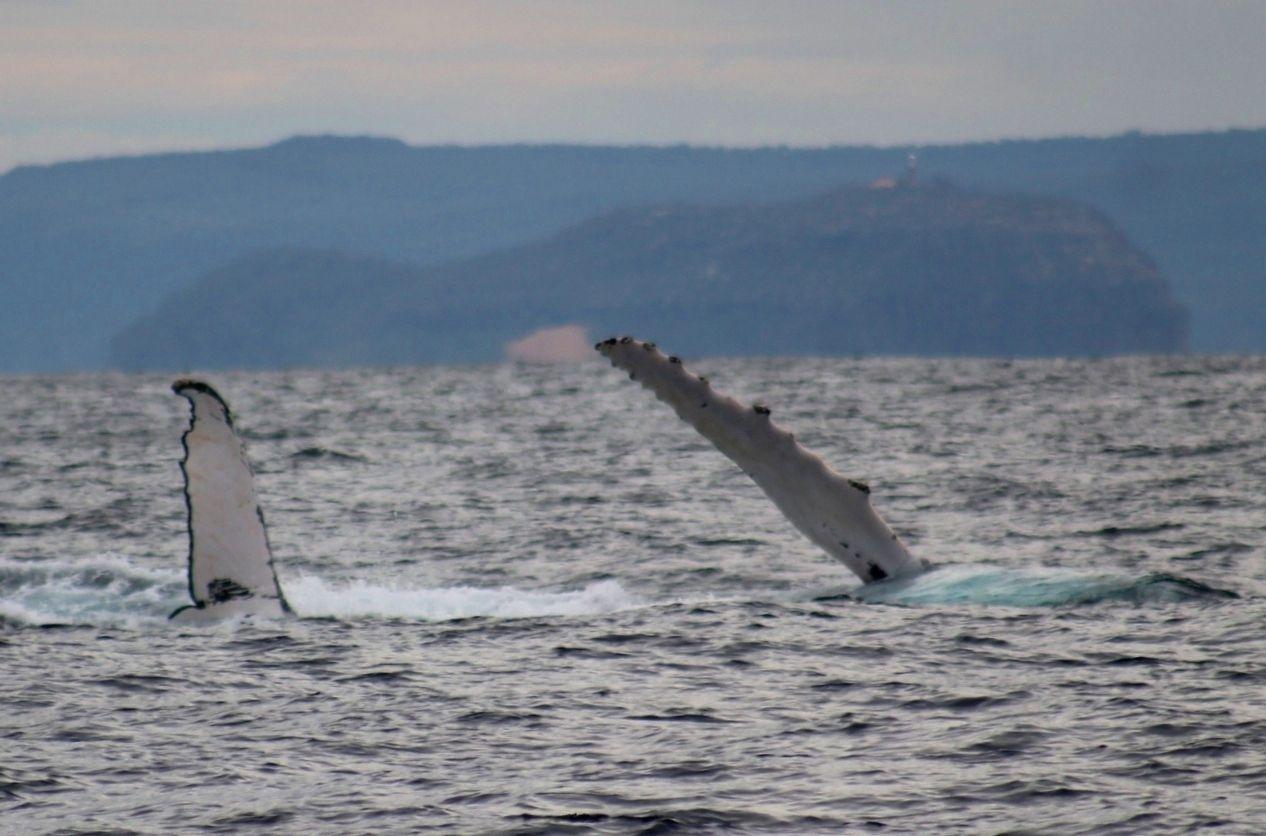
Volunteers For Barrenjoey Lighthouse Tours Needed
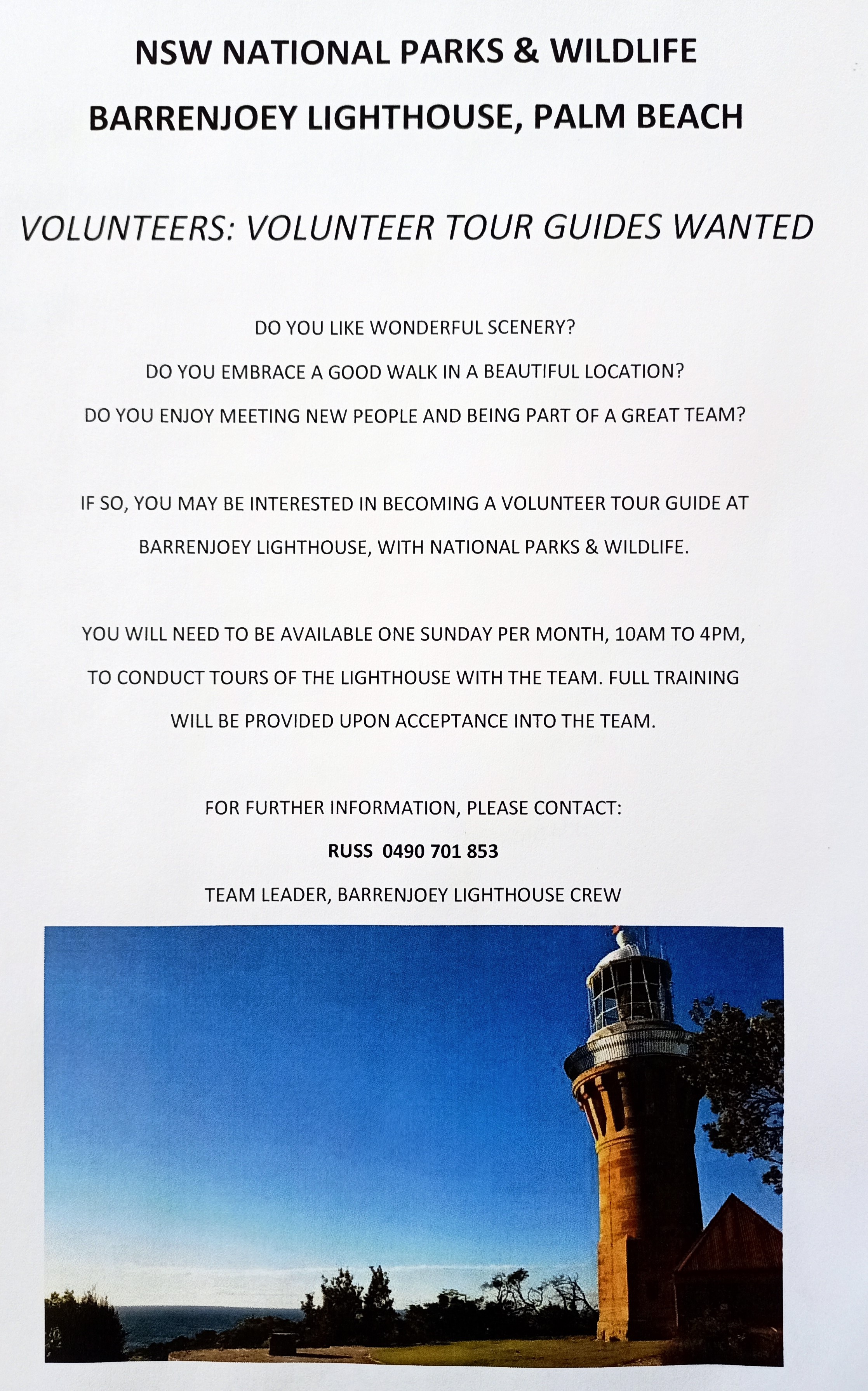
Narrabeen's 'Occy'
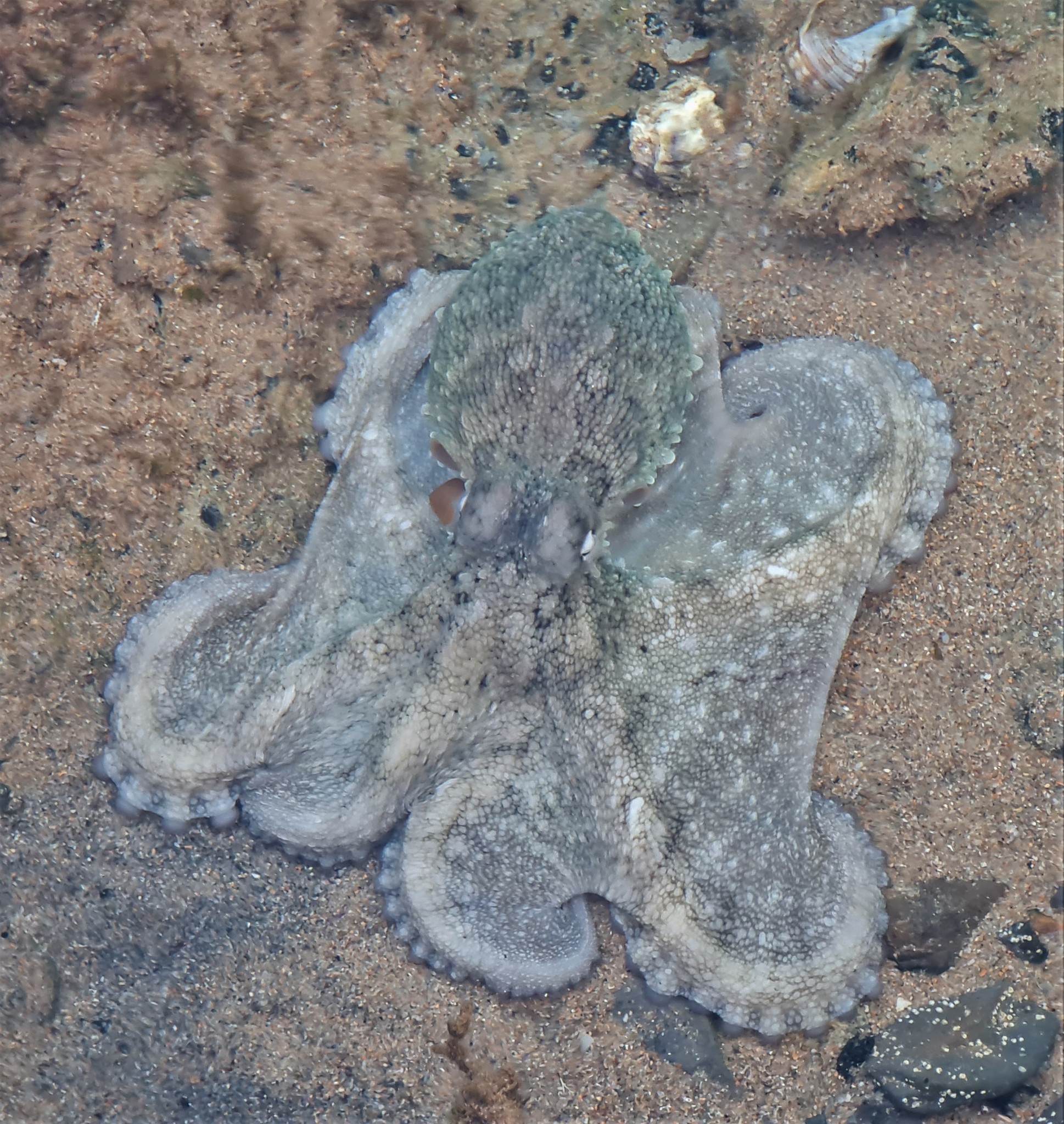
Manly Freshwater World Surfing Reserve Relaunches
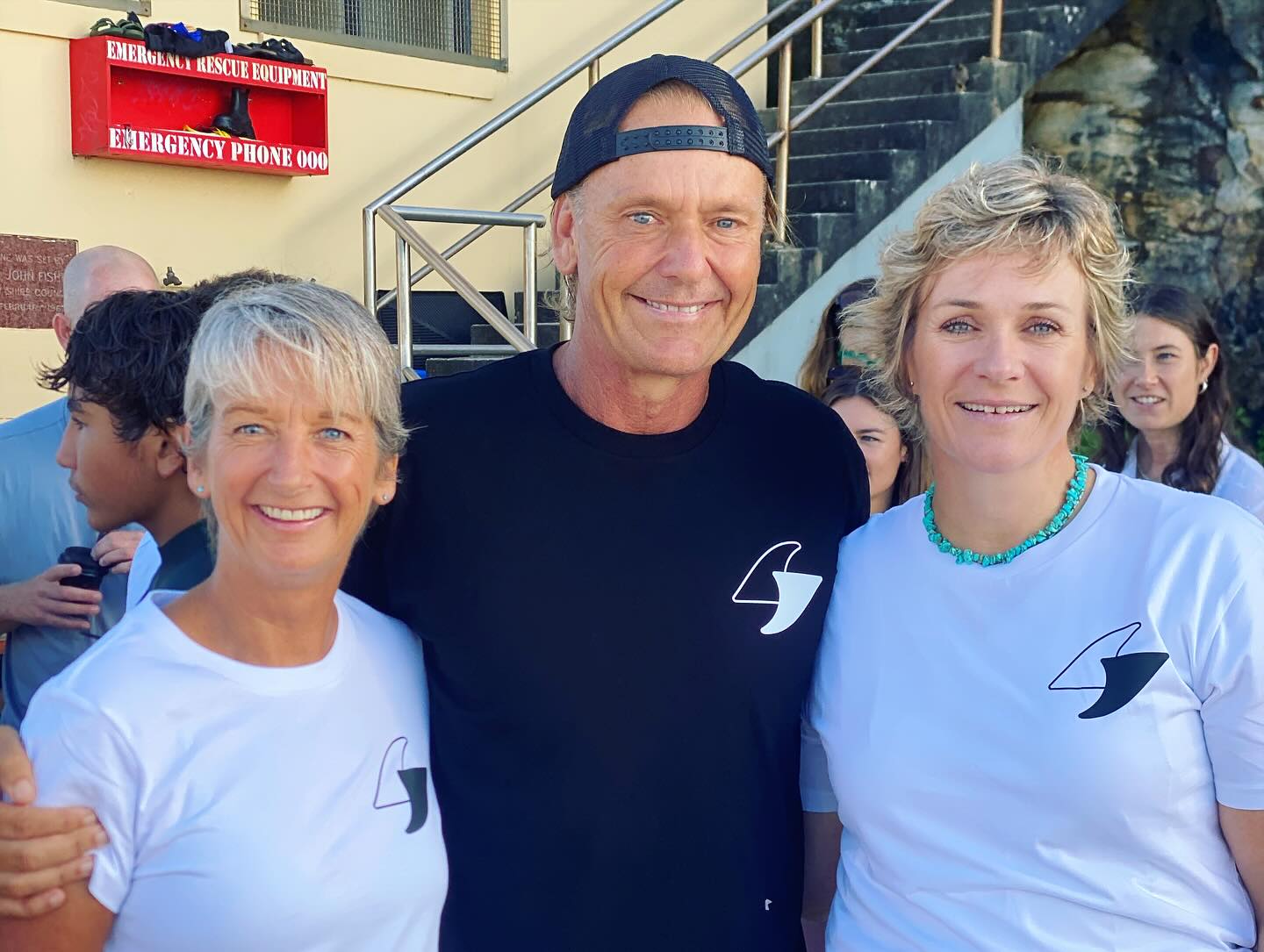

Duke Kahanamoku carrying his board up the beach at Freshwater. Photo by Frank Bell (1884-1923)

Winners Midget Farrelly and Phyllis O'Donnell with their trophies. CREDIT R.L. Stewart
- Protect marine habitats and biodiversity
- Maintain resilience of the coast
- Safeguard the local livelihoods
- But, we are under threat! The 6 major threats are-
- Coastal development - eg seawalls
- Sea levels rising
- Coral reef destruction-industrials run off and climate change
- Water degradation - fertilisers
- Plastic pollution
- Loss of access - privatisation
2024 Ocean Lovers Festival At Bondi: March 20 To 24



Environment Protection Legislation Amendment (Stronger Regulation And Penalties) Bill Introduced To NSW Parliament
- Doubling maximum penalties for Tier 1 serious offences to $10 million for companies and $2 million for individuals.
- Doubling maximum penalties for Tier 2 asbestos-related offences to $4 million for companies and $1 million for individuals.
- More than doubling on-the-spot fine amounts for certain Tier 3 offences to $30,000 for companies for a first offence and $45,000 for a second offence. For individuals this will be $15,000 for a first offence and $22,500 for a second offence.
- Doubling on-the-spot fines for general littering of small items to $160 for individuals and corporations in public places.
- Cracking down on small-scale illegal dumping with maximum penalties of $50,000 for companies and $25,000 for individuals. On-the-spot fines of $5,000 for companies and $1,000 for individuals will be able to be issued by public land managers, including councils, NSW Police and the National Parks and Wildlife Service.
- Implementing a specific, higher penalty for small scale illegal dumping on sensitive land such as childcare centres, hospitals, schools, national parks and beaches.
- Increasing maximum penalties for breaching resource recovery orders and exemptions from $44,000 to $2 million, or $4 million for offences by corporations involving asbestos waste.
- Introducing new product recall powers for materials that may be contaminated with harmful substances across an entire supply chain, to quickly safeguard human health and the environment and warn the public.
- Establishing a public ‘name and shame’ process to issue public warnings about poor environmental performers and sub-standard practices.
- Strengthening investigation powers, introducing investigation notices, and improving and expanding clean-up notice controls.
- Allowing the Land and Environment Court to ban serial and serious offenders from applying for an environment protection licence.
- Providing a framework to establish a new waste accreditation scheme to ensure accurate assessment, classification and disposal of waste. This will protect the integrity of recycling streams by targeting the source of contamination. Regulatory effort will be focused upstream towards the waste generator, providing greater visibility and control over supply chains.
- Tier 1 offences – wilful
- Wilful harm to environment from disposal of waste, or causing any substance to leak, spill or otherwise escape
- Tier 1 offences – negligent
- Negligent harm to environment from disposal of waste, or causing any substance to leak, spill or otherwise escape
- Tier 2 offences with higher penalties – asbestos waste and other serious offences
- For example, pollution of land where offence involves asbestos waste
- Other Tier 2 offences
- For example, failure to comply with licence condition or a clean-up notice
- Tier 3 offences
- Environmental offences which are dealt with via penalty notices (on-the-spot fines)
Increase Tree Vandalism Penalties: NSW Parliamentary Petition
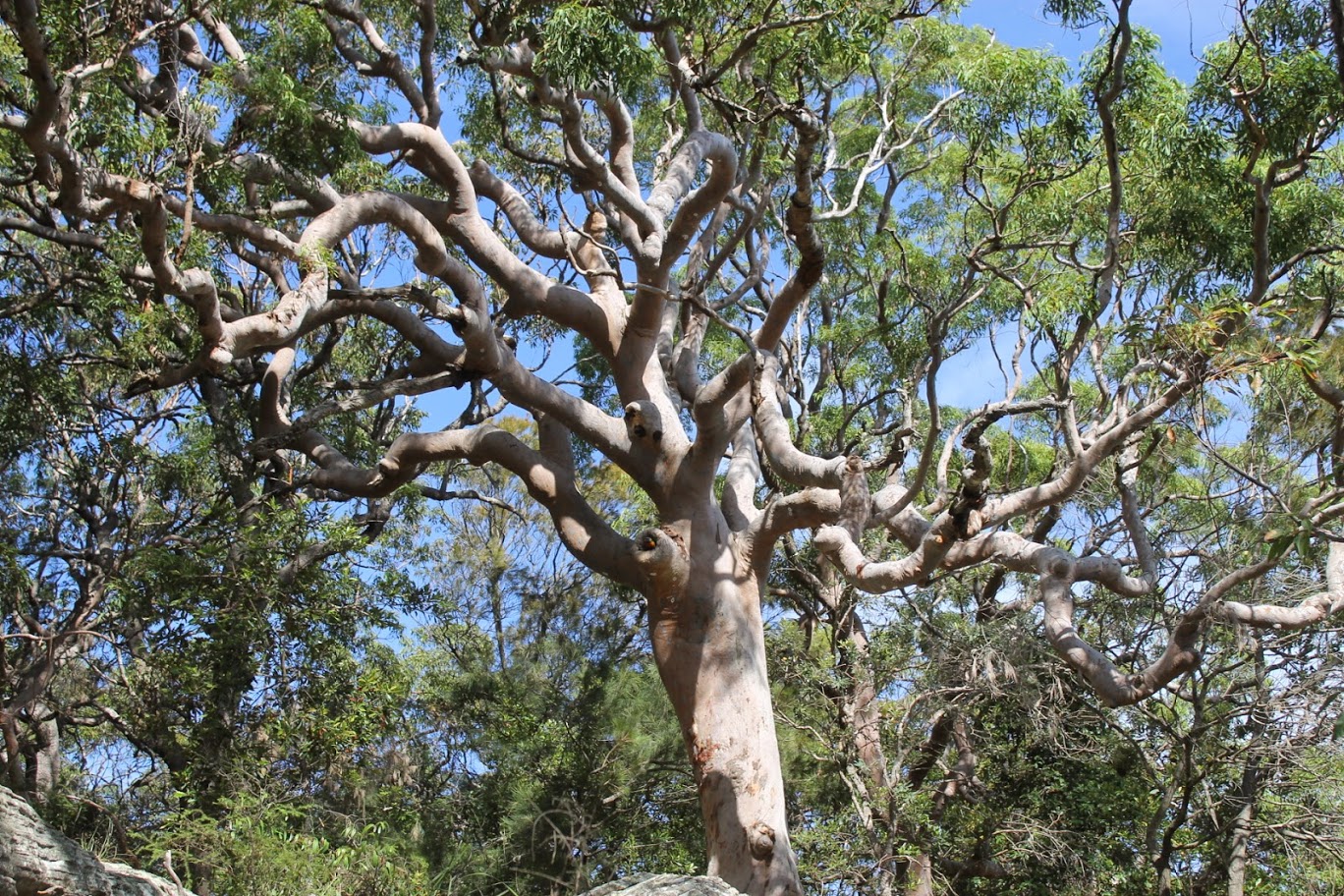
.jpg?timestamp=1708790130470)
EPA Fines Forestry Corporation $45K
Newcastle Company Fined $15,000 Over Harbour Coal Spill
Eastern Blue Groper Changes: Have Your Say
Iconic Blue Groper Now Protected In NSW
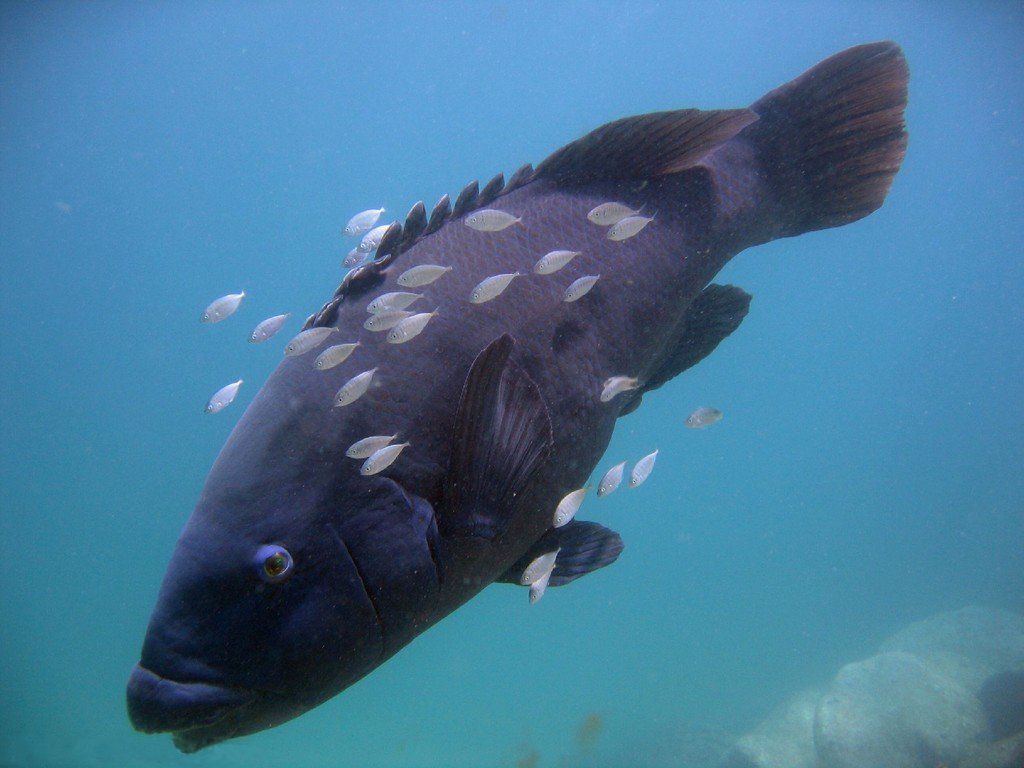
Driving A Cleaner Future: Vehicle Emissions Star Ratings Website Launched
New International Report Records Australia's Coal Mine Methane Emissions Are Underreported
Removal Works On All Macquarie River Rafts To Begin Soon
Harvest Seeds & Native Plants: Education Sessions 2024 - "The Harvest Huddle"
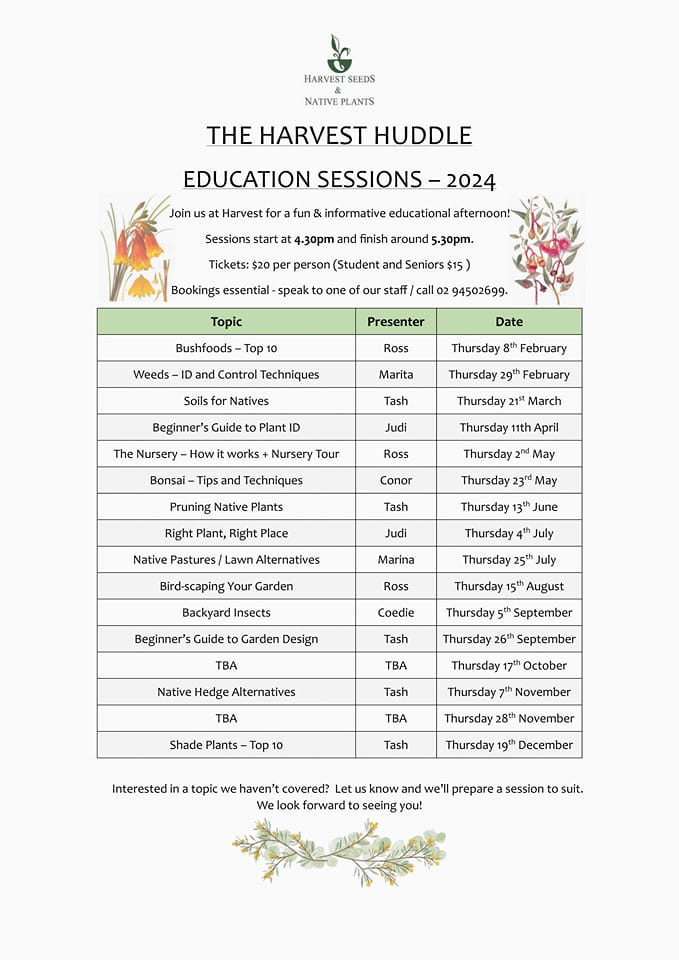
Notice Of 1080 Baiting: February 1 - July 31 2024
Please note the following notification of continuous and ongoing fox control using 1080 POISON with ground baits and canid pest ejectors (CPE’s) in Sydney Harbour National Park, Garigal National Park, Ku-ring-gai Chase National Park, and Lane Cove National Park. As part of this program, baiting also occurs on North Head Sanctuary managed by Sydney Harbour Federation Trust and the Australian Institute of Police Management facility at North Head.
This provides notification for the 6 monthly period of 1 February 2024 – 31 July 2024.
Warning signs are displayed at park entrances and other entrances to the baiting location to inform the public of 1080 baiting.
1080 Poison for fox control is used in these reserves in a continuous and ongoing manner. This means that baits and ejectors (CPE’s) remain in the reserves and are checked/replaced every 6 – 8 weeks.
1080 use at these locations is in accordance with NSW pesticides legislation, relevant 1080 Pesticide Control Orders and the NPWS Vertebrate Pesticides Standard Operating Procedures.
A series of public notifications occur on a 6 monthly basis including; alerts on the NPWS website, public notices in local papers, Area pesticide use notification registers and to the NPWS call centre.
If you have any further general enquiries about 1080, or for specific program enquiries please contact the local NPWS Area office:
For further information please call the local NPWS office on:
NPWS Sydney North (Middle Head) Area office: 9960 6266
NPWS Sydney North (Forestville) Area office: 9451 3479
NPWS North West Sydney (Lane Cove NP) Area office: 8448 0400
NPWS after-hours Duty officer service: 1300 056 294
Sydney Harbour Federation Trust: 8969 2128
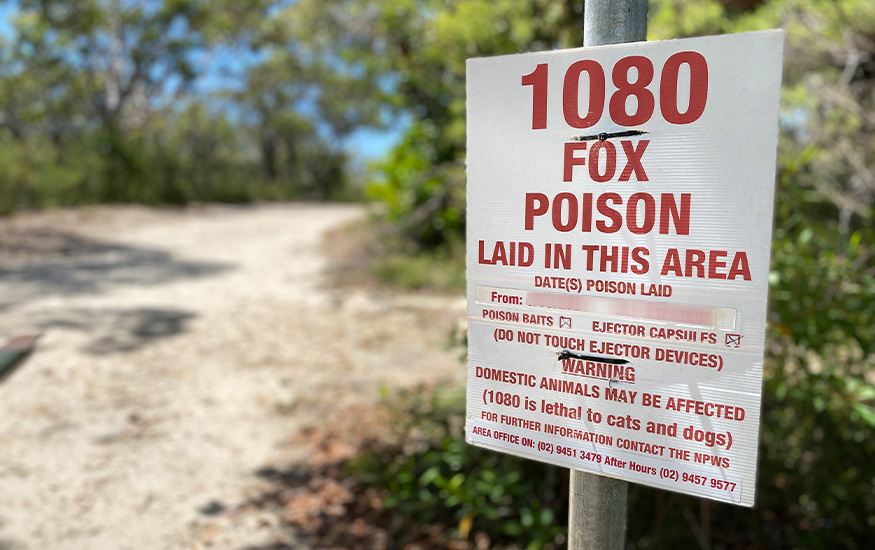
Pittwater Natural Heritage Association: Second PNHA Nature Event 2024
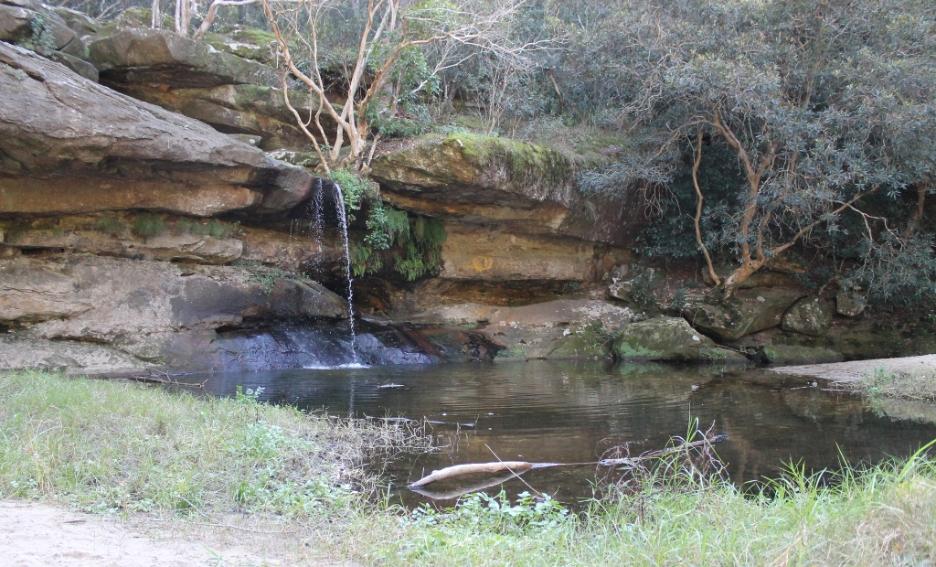
Upcoming Events At Permaculture Northern Beaches
 Saving Our Seeds is a crucial part of our own food chain and it enables us to grow our own food and plants with no additional costs! The strongest seeds are locally grown over many generations and well adapted to local conditions - so your plants will thrive while you save on costs. Join us with seed-saving guest speakers Mylene Turban, and Elle Sheather to have an overview and to inspire you to get seed-saving!
Saving Our Seeds is a crucial part of our own food chain and it enables us to grow our own food and plants with no additional costs! The strongest seeds are locally grown over many generations and well adapted to local conditions - so your plants will thrive while you save on costs. Join us with seed-saving guest speakers Mylene Turban, and Elle Sheather to have an overview and to inspire you to get seed-saving!About

Stony Range Nursery
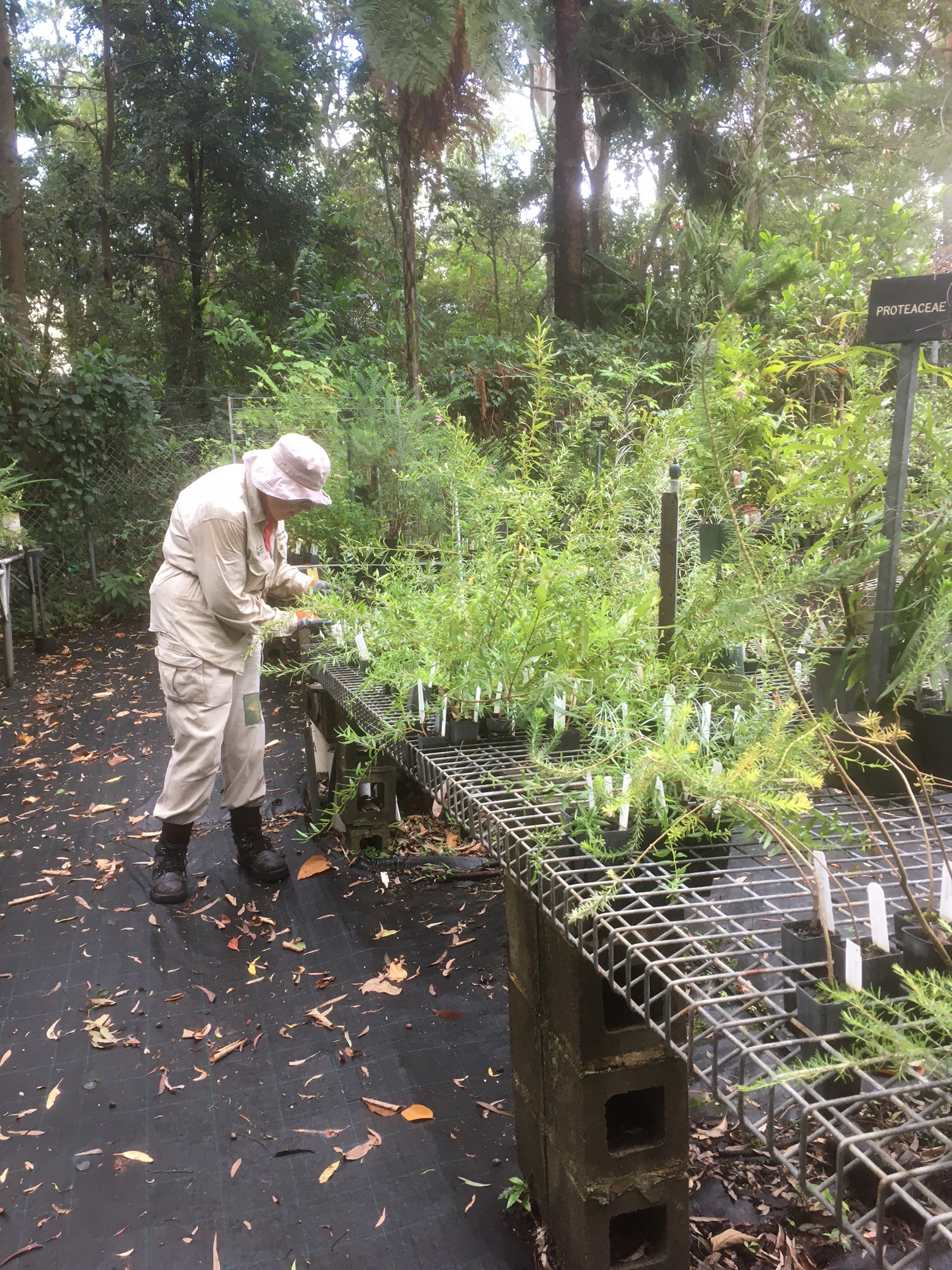
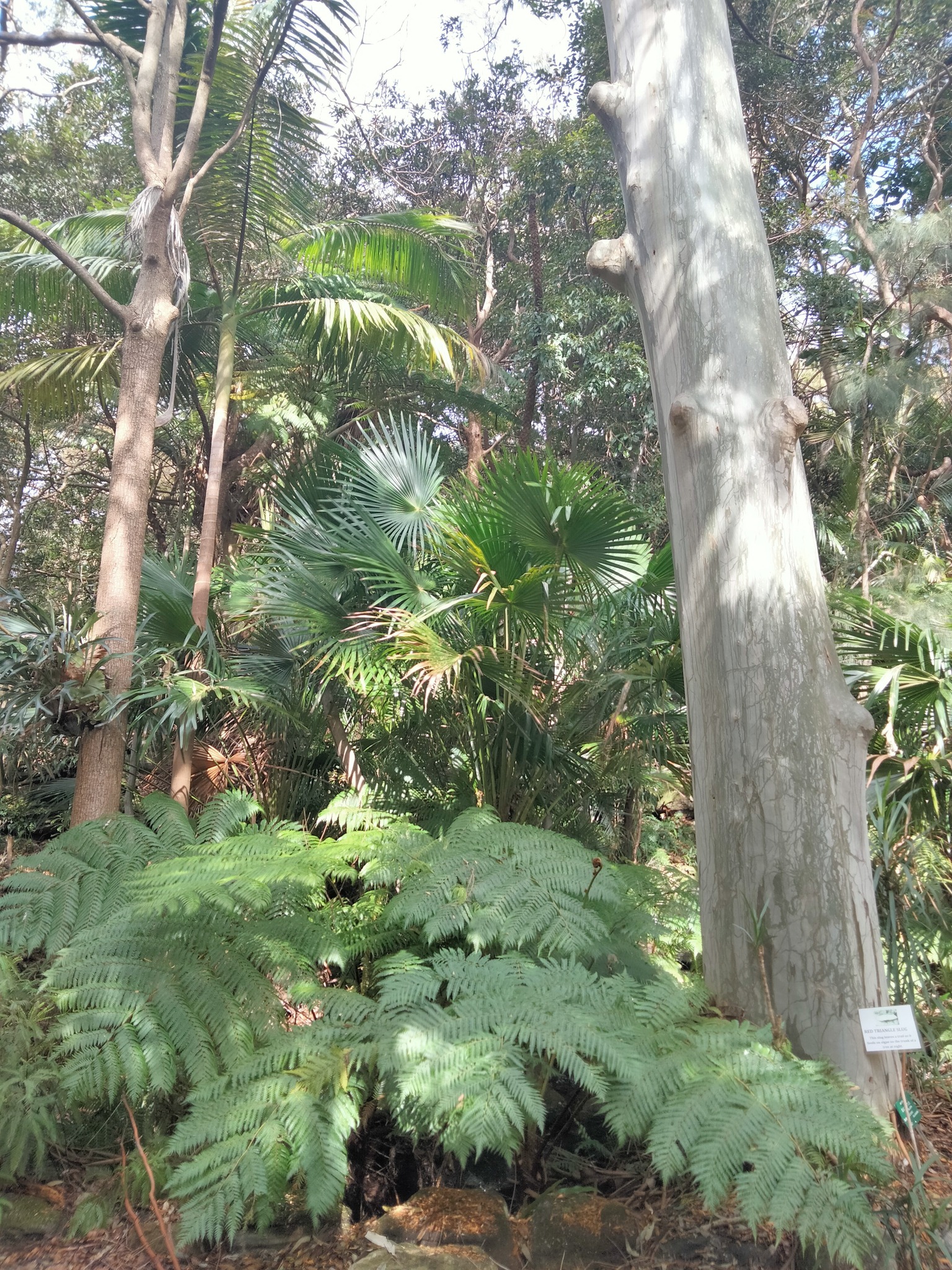
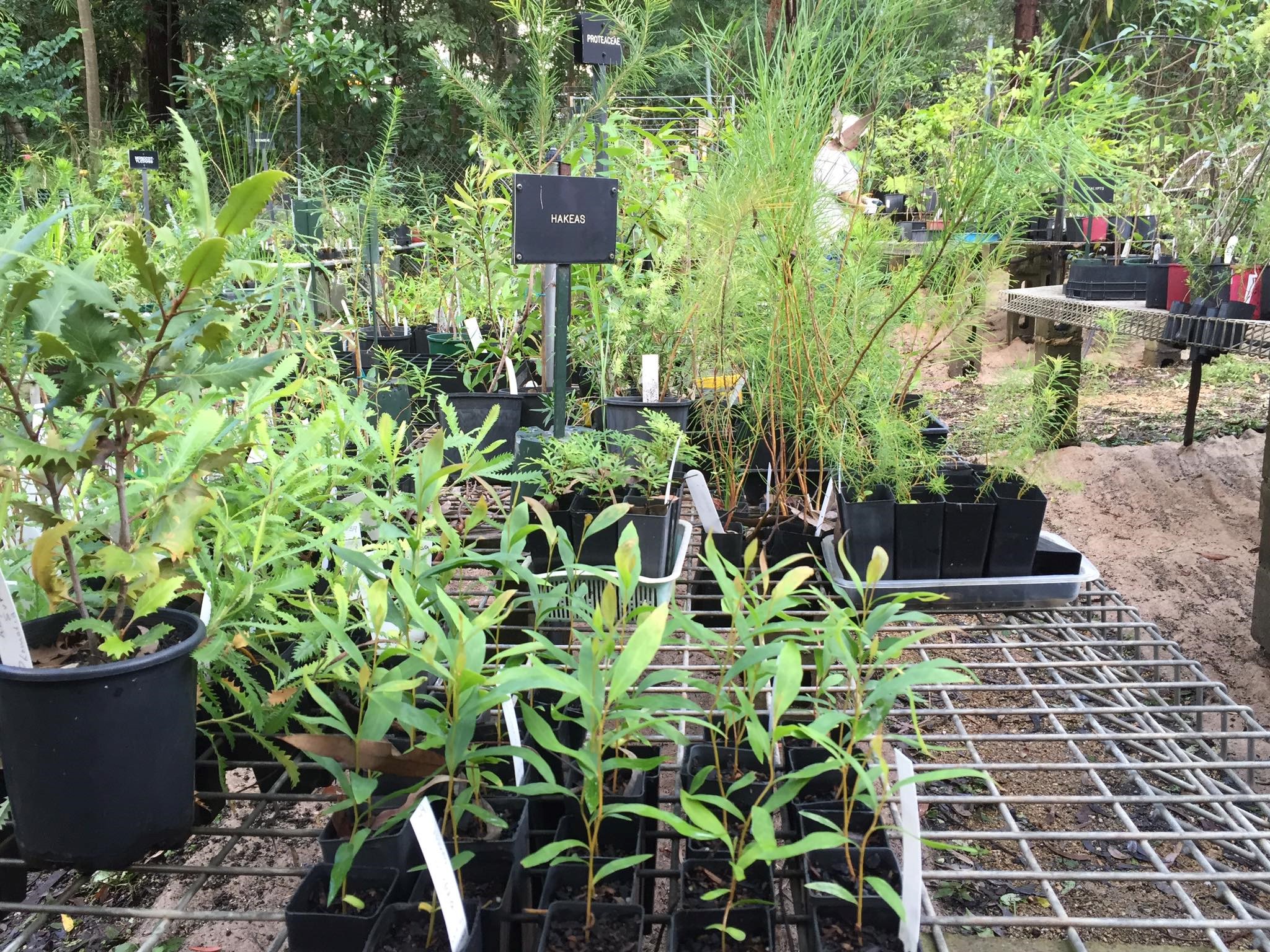
Stay Safe From Mosquitoes
- Applying repellent to exposed skin. Use repellents that contain DEET, picaridin, or oil of lemon eucalyptus. Check the label for reapplication times.
- Re-applying repellent regularly, particularly after swimming. Be sure to apply sunscreen first and then apply repellent.
- Wearing light, loose-fitting long-sleeve shirts, long pants and covered footwear and socks.
- Avoiding going outdoors during peak mosquito times, especially at dawn and dusk.
- Using insecticide sprays, vapour dispensing units and mosquito coils to repel mosquitoes (mosquito coils should only be used outdoors in well-ventilated areas)
- Covering windows and doors with insect screens and checking there are no gaps.
- Removing items that may collect water such as old tyres and empty pots from around your home to reduce the places where mosquitoes can breed.
- Using repellents that are safe for children. Most skin repellents are safe for use on children aged three months and older. Always check the label for instructions. Protecting infants aged less than three months by using an infant carrier draped with mosquito netting, secured along the edges.
- While camping, use a tent that has fly screens to prevent mosquitoes entering or sleep under a mosquito net.
Mountain Bike Incidents On Public Land: Survey
- Mountain Bike Incidents On Public Land: Survey Launched To Gather Data On What's Happening To Public Parks - Community Land - Bush Reserves In Pittwater
- Mother Brushtail Killed On Barrenjoey Road: Baby Cried All Night - Powerful Owl Struck At Same Time At Careel Bay During Owlet Fledgling Season: calls for mitigation measures - The List of 'What You can Do' as requested
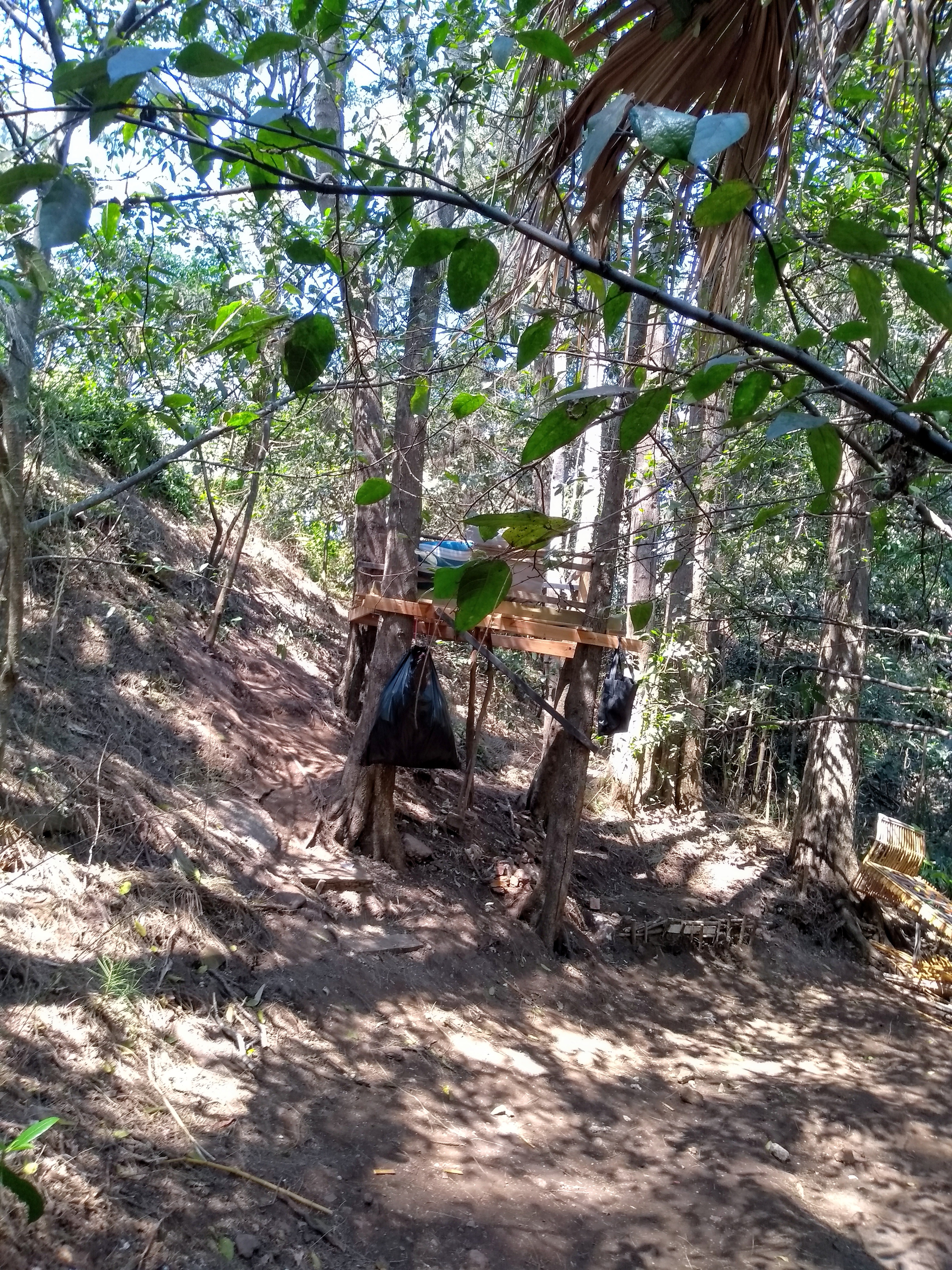
Please Look Out For Wildlife During Heatwave Events

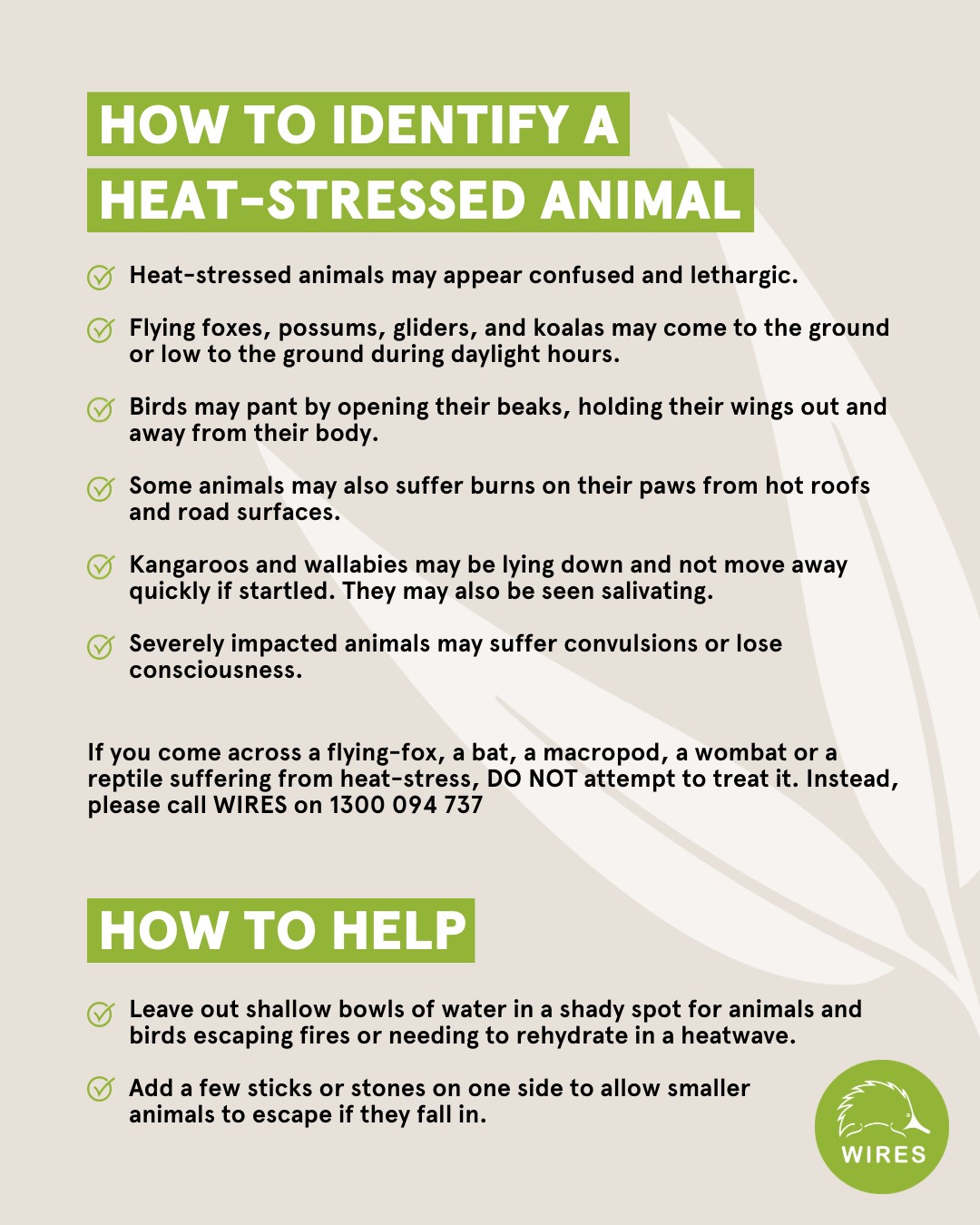
Palmgrove Park Avalon: New Bushcare Group
 Palmgrove Park Avalon is a remnant of the Spotted Gum forest that was once widespread on the lower slopes of the Pittwater peninsula. This bushland’s official name and forest type is Pittwater and Wagstaffe Endangered Ecological Community, endangered because so much has been cleared for suburban development. Canopy trees, smaller trees and shrubs, and ground layer plants make up this community. Though scattered remnant Spotted Gums remain on private land, there is little chance of seedlings surviving in gardens and lawns. More information HERE
Palmgrove Park Avalon is a remnant of the Spotted Gum forest that was once widespread on the lower slopes of the Pittwater peninsula. This bushland’s official name and forest type is Pittwater and Wagstaffe Endangered Ecological Community, endangered because so much has been cleared for suburban development. Canopy trees, smaller trees and shrubs, and ground layer plants make up this community. Though scattered remnant Spotted Gums remain on private land, there is little chance of seedlings surviving in gardens and lawns. More information HERE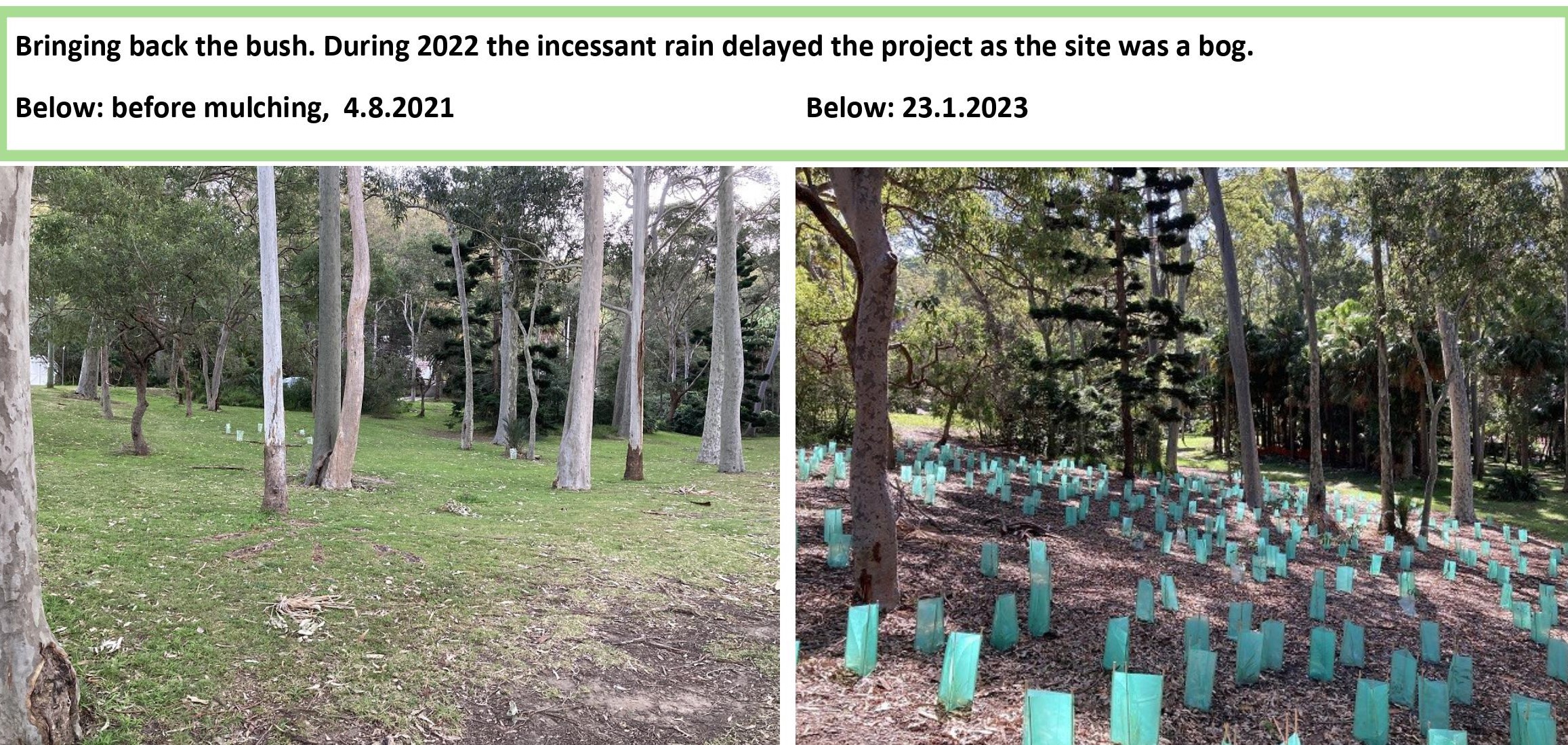
Report Fox Sightings
%20(1).jpg?timestamp=1675893929686)
Marine Wildlife Rescue Group On The Central Coast
A new wildlife group was launched on the Central Coast on Saturday, December 10, 2022.
Marine Wildlife Rescue Central Coast (MWRCC) had its official launch at The Entrance Boat Shed at 10am.
The group comprises current and former members of ASTR, ORRCA, Sea Shepherd, Greenpeace, WIRES and Wildlife ARC, as well as vets, academics, and people from all walks of life.
Well known marine wildlife advocate and activist Cathy Gilmore is spearheading the organisation.
“We believe that it is time the Central Coast looked after its own marine wildlife, and not be under the control or directed by groups that aren’t based locally,” Gilmore said.
“We have the local knowledge and are set up to respond and help injured animals more quickly.
“This also means that donations and money fundraised will go directly into helping our local marine creatures, and not get tied up elsewhere in the state.”
The organisation plans to have rehabilitation facilities and rescue kits placed in strategic locations around the region.
MWRCC will also be in touch with Indigenous groups to learn the traditional importance of the local marine environment and its inhabitants.
“We want to work with these groups and share knowledge between us,” Gilmore said.
“This is an opportunity to help save and protect our local marine wildlife, so if you have passion and commitment, then you are more than welcome to join us.”
Marine Wildlife Rescue Central Coast has a Facebook page where you may contact members. Visit: https://www.facebook.com/profile.php?id=100076317431064
- Ph: 0478 439 965
- Email: marinewildlifecc@gmail.com
- Instagram: marinewildliferescuecc

Watch Out - Shorebirds About
.JPG.opt1460x973o0,0s1460x973.jpg?timestamp=1663629195339)
Possums In Your Roof?: Do The Right Thing

Aviaries + Possum Release Sites Needed

Bushcare In Pittwater: Where + When
Where we work Which day What time
Avalon
Angophora Reserve 3rd Sunday 8:30 - 11:30am
Avalon Dunes 1st Sunday 8:30 - 11:30am
Avalon Golf Course 2nd Wednesday 3 - 5:30pm
Careel Creek 4th Saturday 8:30 - 11:30am
Toongari Reserve 3rd Saturday 9 - 12noon (8 - 11am in summer)
Bangalley Headland 2nd Sunday 9 to 12noon
Bayview
Winnererremy Bay 4th Sunday 9 to 12noon
Bilgola
North Bilgola Beach 3rd Monday 9 - 12noon
Algona Reserve 1st Saturday 9 - 12noon
Plateau Park 1st Friday 8:30 - 11:30am
Church Point
Browns Bay Reserve 1st Tuesday 9 - 12noon
McCarrs Creek Reserve Contact Bushcare Officer To be confirmed
Clareville
Old Wharf Reserve 3rd Saturday 8 - 11am
Elanora
Kundibah Reserve 4th Sunday 8:30 - 11:30am
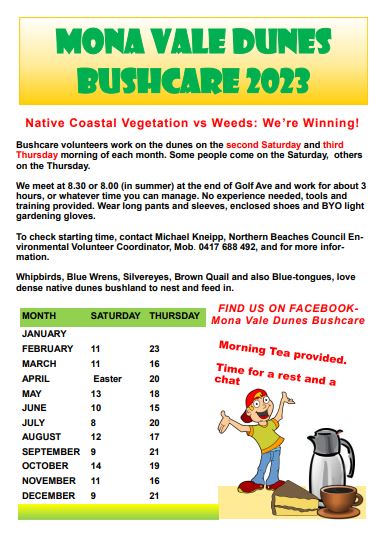 Mona Vale
Mona Vale Mona Vale Beach Basin 1st Saturday 8 - 11am
Mona Vale Dunes 2nd Saturday +3rd Thursday 8:30 - 11:30am
Newport
Bungan Beach 4th Sunday 9 - 12noon
Crescent Reserve 3rd Sunday 9 - 12noon
North Newport Beach 4th Saturday 8:30 - 11:30am
Porter Reserve 2nd Saturday 8 - 11am
North Narrabeen
Irrawong Reserve 2nd Saturday 2 - 5pm
Palm Beach
North Palm Beach Dunes 3rd Saturday 9 - 12noon
Scotland Island
Catherine Park 2nd Sunday 10 - 12:30pm
Elizabeth Park 1st Saturday 9 - 12noon
Pathilda Reserve 3rd Saturday 9 - 12noon
Warriewood
Warriewood Wetlands 1st Sunday 8:30 - 11:30am
Whale Beach
Norma Park 1st Friday 9 - 12noon
Western Foreshores
Coopers Point, Elvina Bay 2nd Sunday 10 - 1pm
Rocky Point, Elvina Bay 1st Monday 9 - 12noon
Friends Of Narrabeen Lagoon Catchment Activities

Gardens And Environment Groups And Organisations In Pittwater
- Ringtail Posse: 1 – February 2023; Anna Maria Monticelli: King Parrots/Water Dragons - Jacqui Scruby: Loggerhead Turtle - Lyn Millett OAM: Flying-Foxes - Kevin Murray: Our Backyard Frogs - Miranda Korzy: Brushtail Possums
- Ringtail Posse: 2 - March 2023; Kevin Murray: Tawny Frogmouth - Kayleigh Greig: Red-Bellied Black Snake - Bec Woods: Australian Water Dragon - Margaret Woods: Owlet-Nightjar - Hilary Green: Butcher Bird - Susan Sorensen: Wallaby
- Ringtail Posse 3 - April 2023: Jeffrey Quinn: Kookaburra, Tom Borg McGee: Kookaburra, Stephanie Galloway-Brown: Bandicoot, Joe Mills: Noisy Miner
- Ringtail Posse 4 May 2023 - Andrew Gregory: Powerful Owl, Marita Macrae: Pale-Lipped Or Gully Shadeskink, Jools Farrell: Whales & Seals, Nicole Romain: Yellow-Tailed Black Cockatoo
- Ringtail Posse 5: June 2023 - Lynleigh Greig OAM: Snakes, Dick Clarke: Diamond Python, Selena Griffith: Glossy Black-Cockatoo, Eric Gumley: Bandicoot
- Ringtail Posse 6: July 2023 - Sonja Elwood: Long-Nosed Bandicoot, Dr. Conny Harris: Swamp Wallaby, Neil Evers: Bandicoot, Bill Goddard: Bandicoot
- Ringtail Posse 7: August 2023 - Geoff Searl OAM: Tawny Frogmouth, Peter Macinnis: Echidna, Peter Carter: Ringtail Possum, Nathan Wellings; Kookaburra
- Ringtail Posse 8: September 2023 - Saving Sydney's Last Koalas; Logging Now Stopped In Future Koala Park By Minns Government - ''Is There Time To Save Sydney's Last Koalas Too?'' Asks: John Illingsworth, WIRES, Sydney Wildlife Rescue, Save Sydney Koalas, The Sydney Basin Koala Network, The Help Save The Wildlife & Bushlands In Campbelltown Group, Appin Koalas Animal Rescue Service, Patricia and Barry Durham, Sue Gay, Save Mt. Gilead, Paola Torti Of The International Koala Intervention Group
- Ringtail Posse 9: October 2023 - David Palmer OAM: Bandicoots, Helen Pearce: Brushtail Possum, Amina Kitching: Goanna, David Goudie: Ringtails Possums + Bandicoots + Owls
- Mother Brushtail Killed On Barrenjoey Road: Baby Cried All Night - Powerful Owl Struck At Same Time At Careel Bay During Owlet Fledgling Season: calls for mitigation measures - The List of what you can do for those who ask 'What You I Do' as requested
- Ringtail Posse 10: November 2023 - Stop Wildlife Roadkill Group: You Can Help By Using The Wildlife Incident Mapping Website
More Green Space To Enhance Liveability In NSW Communities: Metropolitan Greenspace Program + Community Gardens Program Grants Now Open
- Metropolitan Greenspace Program. All councils in the Greater Sydney region and Central Coast Council are eligible and encouraged to apply by 29 April 2024. Successful applicants will be announced in June 2024.
- Places to Roam Community Gardens program. Applications close on 29 March 2024.
Wongkumara People – Native Title Act: Have Your Say
- Informal submission
- Mailout
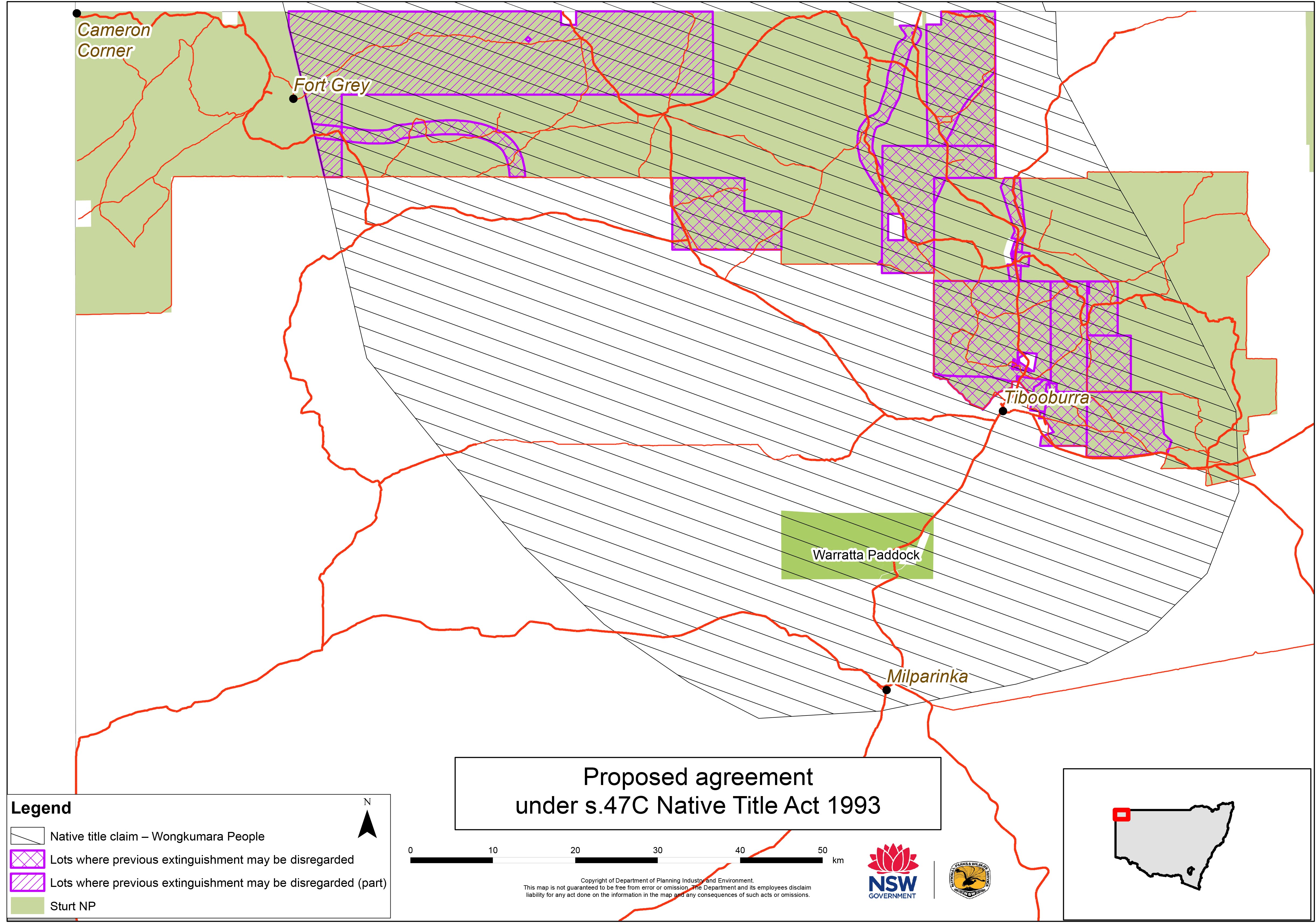
Widjabul Wia-Bal People – Notice Under The Native Title Act: Have Your Say
- Boatharbour Nature Reserve
- Tuckean Nature Reserve
- Muckleewee Mountain Nature Reserve
- Goonengerry National Park
- Victoria Park Nature Reserve
- Mount Jerusalem National Park
- Nightcap National Park
- Davis Scrub Nature Reserve
- Snows Gully Nature Reserve
- Tucki Tucki Nature Reserve
- Andrew Johnson Big Scrub Nature Reserve
- Whian Whian State Conservation Area.
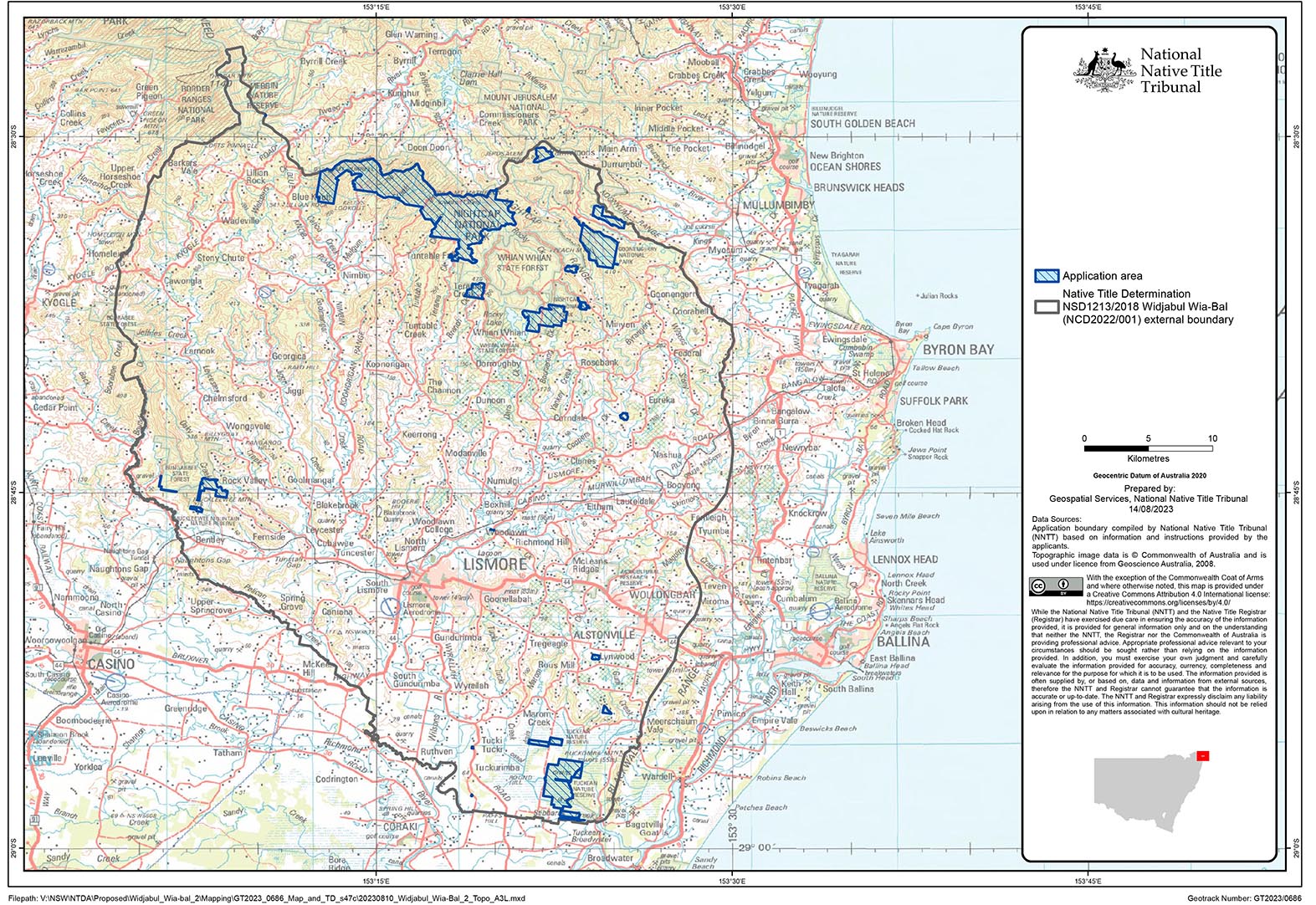
Environmental Grants Connect To Country: Applications Close 2 April 2024
Crown Land Management Act 2016 Review: Have Your Say
.jpg?timestamp=1708537972385)
Coastal Floodplain Drainage Project: Have Your Say
- addressing the complexity, time and costs associated with the approvals process
- reducing the impact of these works and activities on downstream water quality, aquatic ecosystems, communities and industries.
- Option 1: One-stop shop webpage - A single source of information on the various approvals that may be required by government agencies for coastal floodplain drainage works.
- Option 2: Drainage applications coordinator - A central officer(s) to guide the applicant through the approvals processes for all NSW government agencies (Department of Planning and Environment’s Water Group, Planning, Crown Lands, and the Department of Primary Industries — Fisheries) and answer the applicant’s questions about their individual location and proposed works. The drainage applications coordinator would complement both Option 1 and Option 3.
- Option 3: Concurrent assessment - Concurrent assessment of applications by relevant government agencies.
- Option 4: Risk-based approach - NSW Government agencies would use a standardised risk matrix to compare the type and extent of the drainage works against the acidic water and blackwater potential of the drainage area to identify the level of risk associated with the proposed works. The identified level of risk could then be used to determine the level of information required from applicants, the level of assessment required by the approval authority, and the types of conditions applied to any approvals.
- Option 5: Drainage work approvals under the Water Management Act 2000 - Switch on drainage work approvals under the Water Management Act 2000. Two different methods of implementation are possible:
i. a drainage work approval would be required only when works are proposed and for the area of works onlyii. a drainage work approval could apply to existing and new drainage works across the entire drainage network.
Within either of these two methods, one of three different approaches for public authorities could be applied:
a. require public authorities to hold a drainage work approvalb. allow for public authorities to hold a conditional exemption from requiring approvalsc. exempt public authorities from requiring a drainage work approval.
- Option 6: Streamlining of Fisheries and Crown Land approvals through the use of drainage work approvals - Drainage work approvals, particularly under Option 5(ii), have the potential to deliver a catchment-wide consideration of the drainage network. This would provide greater certainty to other agencies such as Fisheries and Crown Land that environmental impacts have been considered and appropriate conditions applied, supporting them to assess and issue approvals more quickly.
- Tuesday 5 March 2024 - Register to attend
- Friday 8 March 2024 - Register to attend
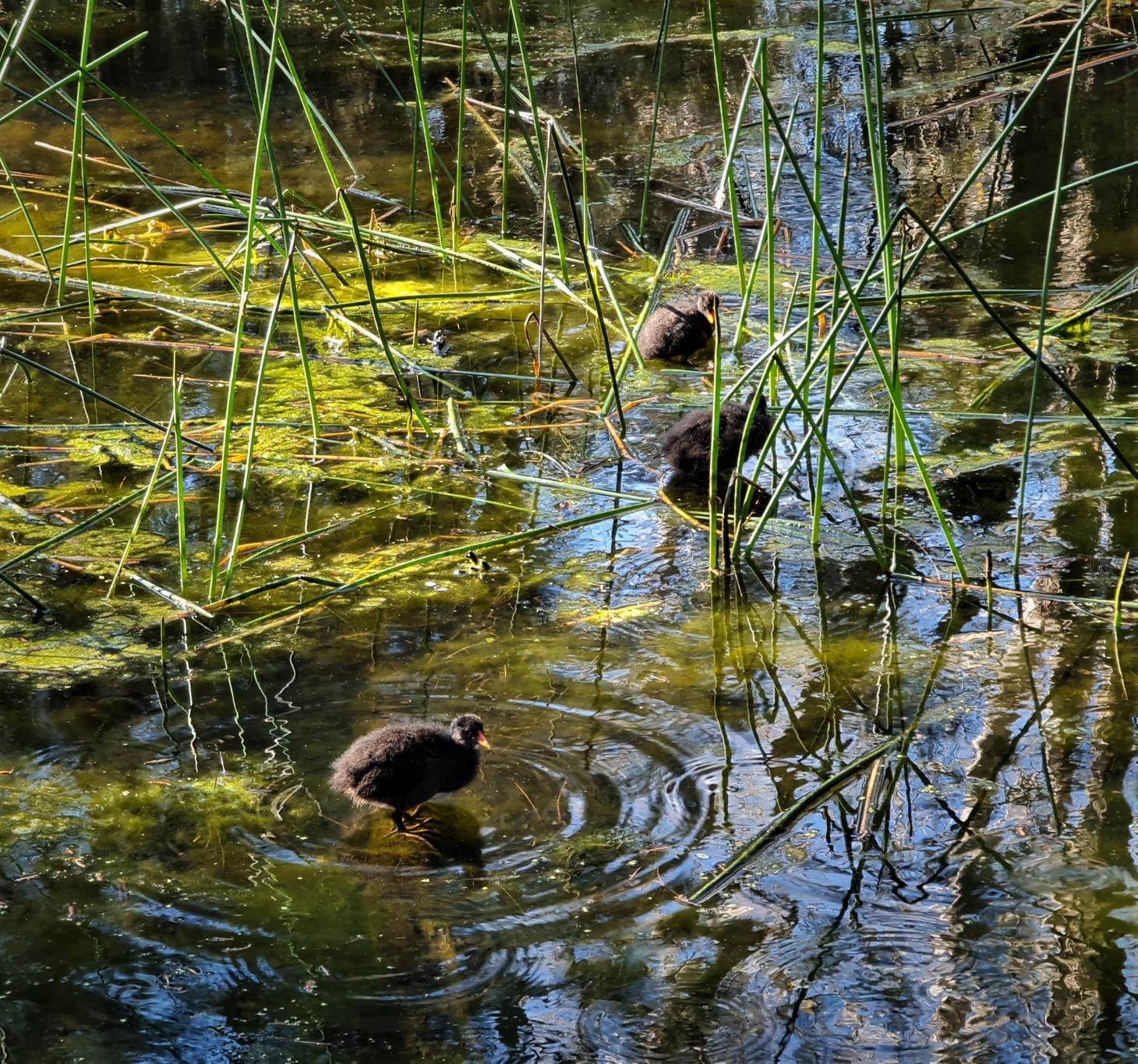
Australia’s Eucalypt Of The Year Voting Opens Today In Your Backyard!
- Dwarf Apple Angophora hispida
- Ghost Gum Corymbia aparrerinja
- Red-flowering Gum Corymbia ficifolia
- Silver Princess Eucalyptus caesia
- Argyle Apple Eucalyptus cinerea
- Yellow Gum Eucalyptus leucoxylon
- Risdon Peppermint Eucalyptus risdonii
- Coral Gum Eucalyptus torquata
- Heart-leaved Mallee Eucalyptus websteriana
- Lemon-flowered Gum Eucalyptus woodwardii
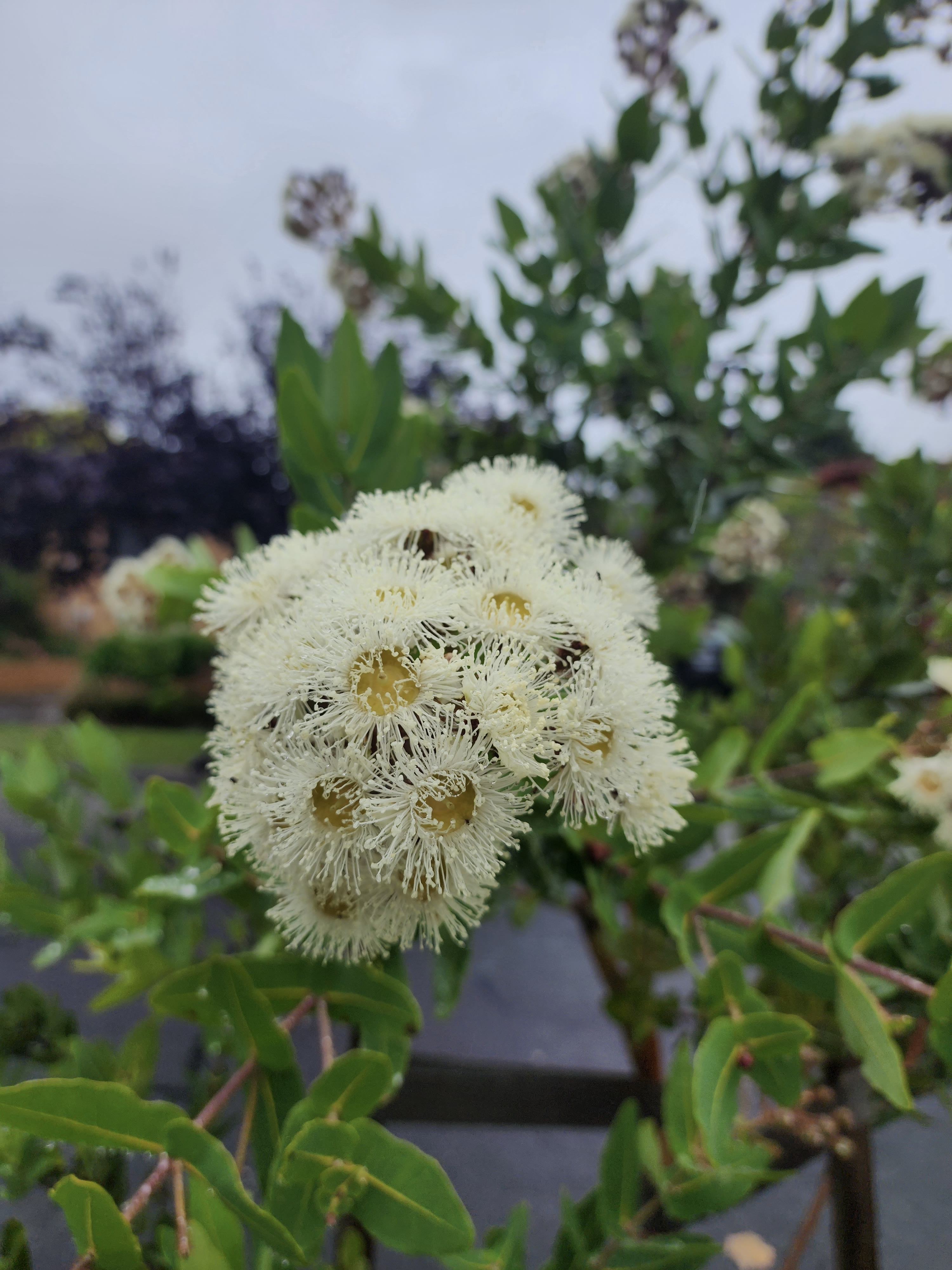
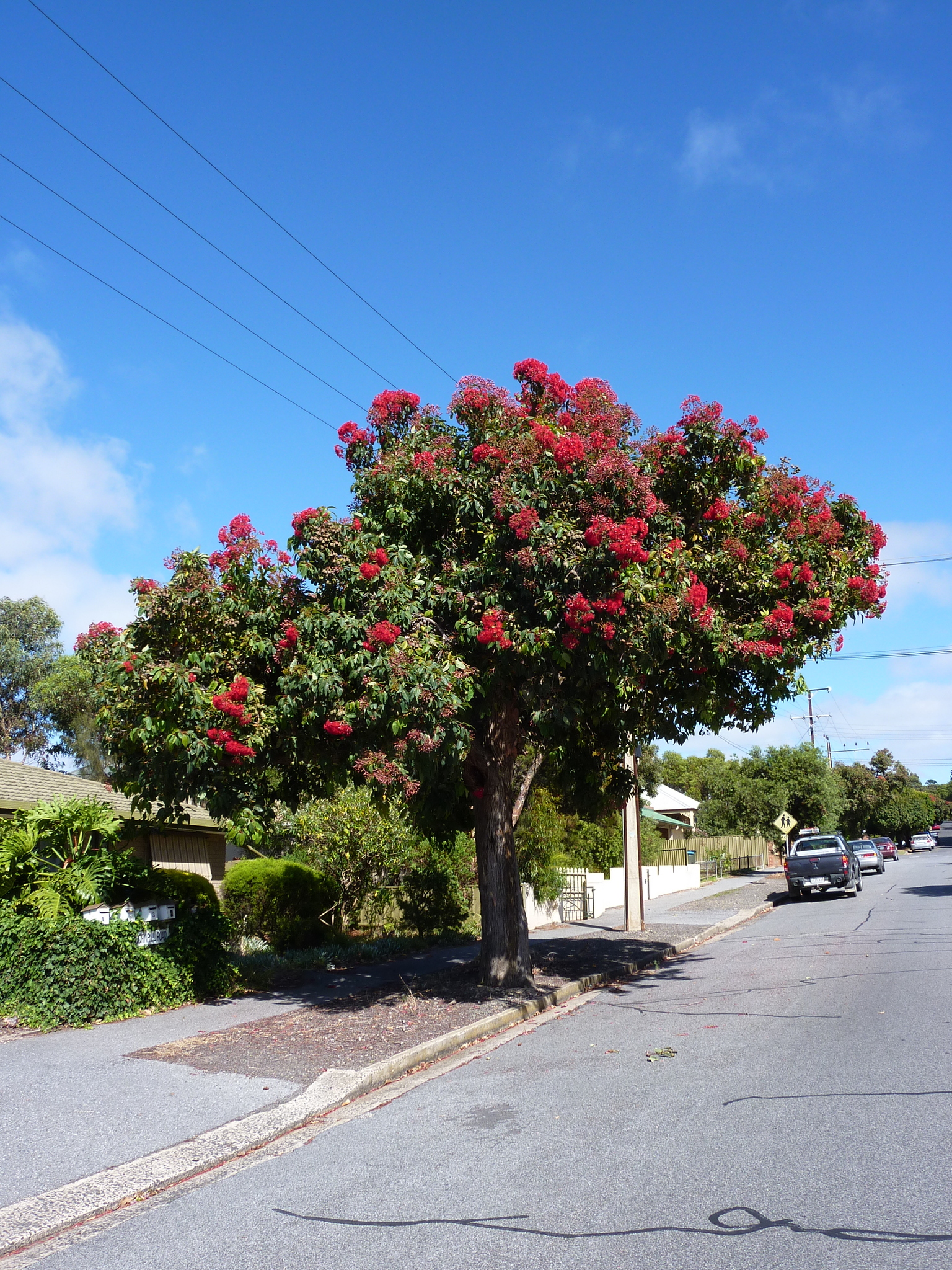
Meet the kowari: a pint-sized predator on the fast track to extinction
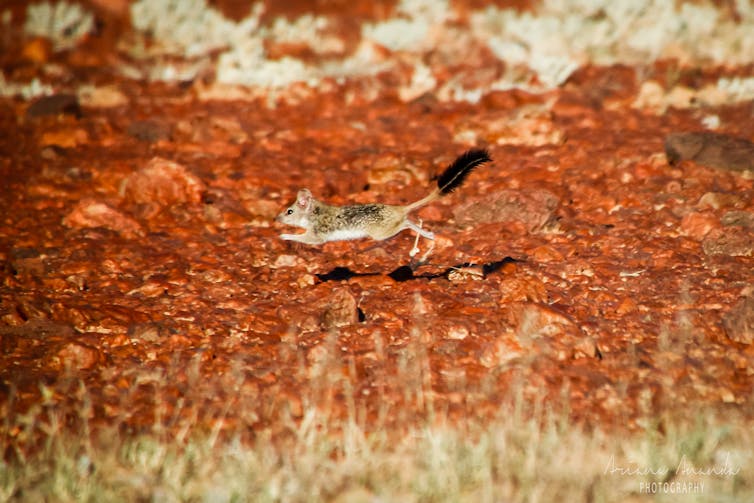
Australia is home to more than 350 species of native mammals, 87% of which are found nowhere else on Earth. But with 39 of these species already extinct and a further 110 listed as threatened, there’s every chance many will vanish before you even knew they existed. So here’s one we think you simply must know (and save), before it’s too late.
The charismatic kowari is a small carnivorous marsupial. It was once common inland but is now found only in the remote deserts of southwest Queensland and northeastern South Australia, in less than 20% of its former range.
This pint-sized predator fits in the palm of your hand. Its bright eyes, bushy tail and big personality make it the perfect poster child for the Australian outback. But with just 1,200 kowari left in the wild, the federal government upgraded its conservation status in November from vulnerable to endangered.
Reversing the decline of the kowari is within our grasp. But we need public support and political will to achieve this. It requires limiting grazing of cattle and sheep, while keeping feral cat numbers under control.
Meet The Kowari
The kowari (Dasyuroides byrnei) is a skilled hunter that stalks mice, tarantulas, moths, scorpions and even birds. Alert and efficient, they attack their prey voraciously.
Formerly known as the brushy-tailed marsupial rat, or Byrne’s crest-tailed marsupial rat, the kowari is more closely related to Tasmanian Devil and quolls.
The Wangkangurru Yarluyandi People use the name kowari, while the Dieri and Ngameni peoples use the similar-sounding name kariri.
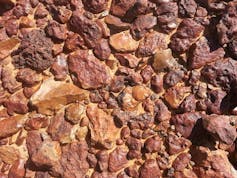
Kowaris live in stony deserts. They mainly inhabit remote treeless “gibber” plains. These areas of flat, interlocking red pebbles form vast pavements that could be mistaken for the surface of Mars.
In the outback, where temperatures can exceed 50°C, kowaris beat the heat by sheltering in burrows dug into sand mounds. At night they emerge to race across the plains, their head and distinctive brushy tail held high, pausing regularly to scan for predators and prey.
During chilly winter days, kowaris slow their metabolism to conserve energy. They go into a state of torpor, which is a daily version of hibernation.
At the two main South Australian sites, the number of animals captured in trapping surveys declined by 85% between 2000 and 2015. At this rate, the species could disappear from the area within two decades.
The entire population is estimated to number as few as 1,200 individuals scattered over just 350 square kilometres. That’s a combined area of less than 20km x 20km.
Based on this evidence, the conservation status of kowaris was upgraded from vulnerable to endangered in November last year.
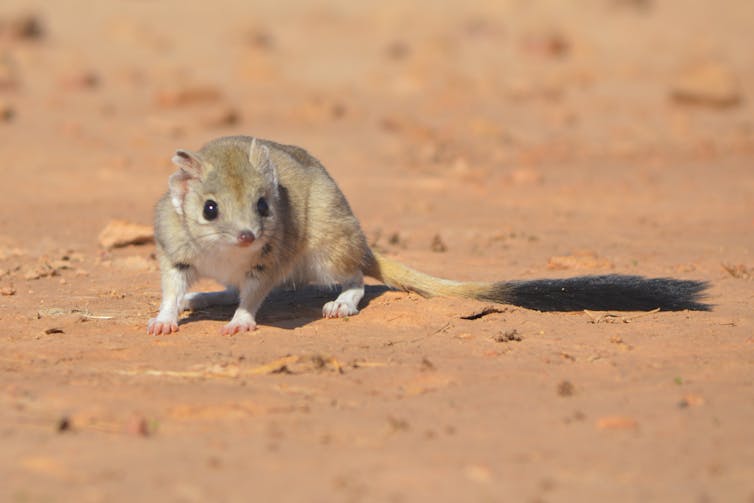
Shrinking Populations In The Stony Desert
Kowaris have been declining for a while but are suddenly on the fast track to extinction. How can that be, when they live in one of the most vast and remote parts of Australia?
Threats include land degradation from pastoralism, and predation from introduced feral cats and foxes.
But it’s complicated. Threats can combine, having a synergistic effect (greater than the sum of their parts). And then there are climate influences.
Heavy rain in the desert triggers a cascade of events that culminates in an explosion of feral cat numbers.
When conditions dry out again, the cats switch to eating larger or more difficult prey such as bilbies and kowaris, often causing local extinctions. In southwest Queensland, feral cats most likely wiped out one population of kowaris and decimated another.
Huge efforts to control cat plagues have saved the kowari and bilby populations in Astrebla Downs National Park from local extinction so far, but other areas have succumbed.
In SA, all the remaining kowari populations are on pastoral stations used for grazing cattle.
Cattle can trample kowari burrows. They can also compact the sand mounds, making it difficult for kowaris to build burrows in the first place. And they eat the plants on the mounds, reducing the availability of both food and shelter. This makes kowaris easy prey.
Over the past few decades, pastoralism has intensified. Nearly half of Australia (44%) is covered in pastoral leases where many threatened species occur.
Domestic stock usually graze close to watering points such as bores and troughs. More and more watering points are being established, to make more of the pastoral lease accessible to stock. So the area protected from grazing is shrinking as cattle encroach further into kowari territory.
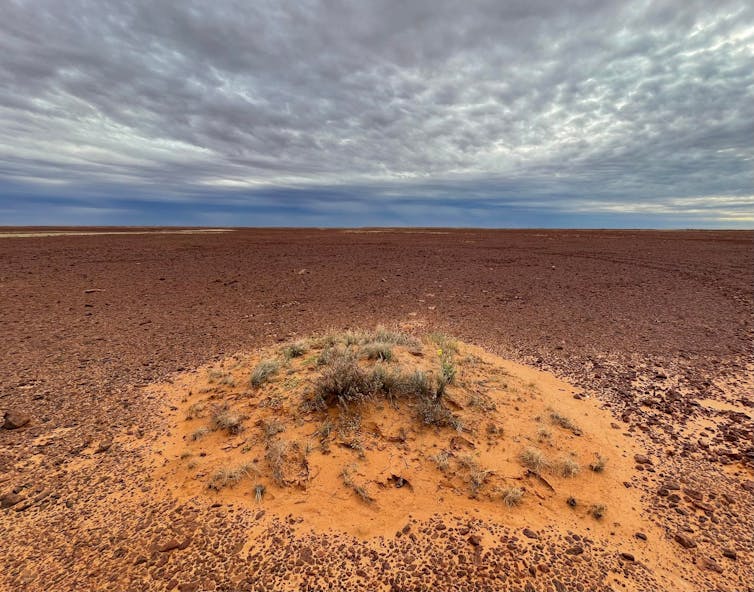
How Can We Save The Kowari?
We have the knowledge and tools required to save this species from extinction. We just need decisive leadership and sufficient funding to put these plans into action.
State governments should provide more resources for desert parks so rangers can monitor feral cat numbers and respond rapidly to plagues. We can make use of new technology such as remote camera traps checked via satellite. These measures would also protect the last remaining stronghold of the bilby in Queensland, another nationally threatened mammal.
The pastoral industry and governments must work together to review watering-point placement and reduce grazing pressure in known kowari habitat.
By closing some pastoral watering points and ensuring a portion of each lease (possibly 20%) is away from waters, we can reduce the harm of stock and provide refuges for threatened species. Pastoral companies could show leadership and implement these actions themselves rather than waiting for governments to act.
In the meantime, reintroductions into safe havens is one stopgap measure helping to prevent imminent kowari extinction. In 2022, 12 kowaris were successfully reintroduced to the 123 square km fenced Arid Recovery Reserve in northern SA. The population has expanded since release. Removing cats, foxes and domestic stock from the reserve has given kowaris a chance to reclaim a small portion of their former range.
But safe havens are small and we need to act on a larger scale. If we don’t, the kowari may become yet another Australian species lost before you’ve even seen it.
Thanks to Genevieve Hayes, former ecologist at Arid Recovery, for coordinating the reintroduction of the kowari at Arid Recovery and commenting on the draft of this article.![]()
Katherine Moseby, Associate Professor, UNSW Sydney and Katherine Tuft, Visiting Research Fellow, University of Adelaide
This article is republished from The Conversation under a Creative Commons license. Read the original article.
Large old trees are vital for Australian birds. Their long branches and hollows can’t be replaced by saplings
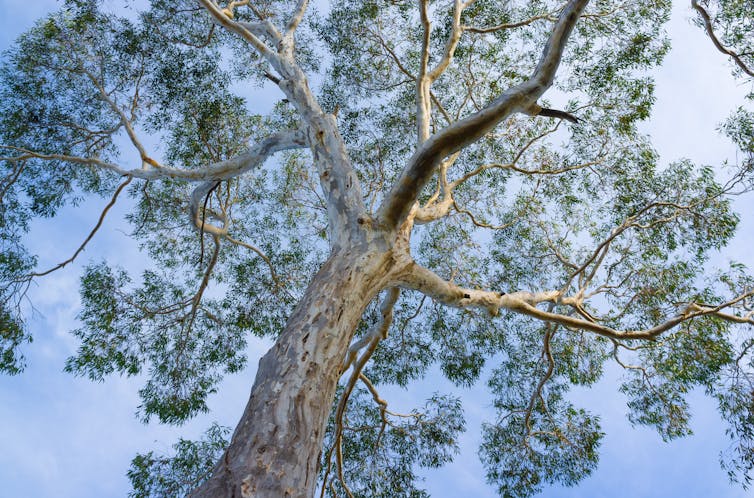
When we make roads, houses or farmland, we often find large old trees in the way. Our response is often to lop off offending branches or even cut the tree down.
This is a bad idea. The more we learn about large old trees, the more we realise their fundamental importance to birds, mammals, insects, plants and other inhabitants. More than 300 species of Australian birds and mammals need large old trees to live.
Why focus on mature trees? It’s because they have many features that younger trees simply don’t have: cracks, hollows, dead branches, peeling bark and large quantities of nectar and seeds. The limbs and leaves that fall on the ground make excellent homes for many small creatures.
Our new research sheds light on the importance of such grand old trees for birds. We used lidar (scanning using lasers) to map small, medium and large tree crowns in unprecedented detail. On average, we found large old trees had 383 metres of the horizontal or dead branches preferred by birds, while medium trees had very little and young trees none. Some old trees had almost 2 kilometres of branches.
Why Are Branches So Important?
If we think of long, overhanging branches, chances are we may think “threat”. Some large trees can drop limbs without warning, although some arborists have pointed out the threat is overstated. To reduce the risk, councils and land managers may remove the limbs of large old trees.
But if you cut down a 300-year-old river red gum, you can’t simply replace it with a sapling of the same species. It will take centuries for the sapling to take up the same ecological role as its predecessor.
In our research, we mapped more than 100,000 branches from many millions of laser samples and recorded how birds use branches through years of field observations.
When we spot a bird using a branch, we can safely infer the bird has chosen it for a reason, whether resting, socialising, feeding, hunting or nesting.
What our data shows is that not all branches are equal. Birds find it easier to perch on horizontal or slightly inclined branches. Branches with few or no leaves offer clear vantage points for birds to land, hunt or see predators. You may have noticed crows and currawongs choosing dead branches for these reasons.
As trees mature, their branches begin to grow horizontally. Some branches may die due to lightning strikes, fire, wind damage, or attacks by insects or fungi, while the rest of the tree continues living. These long-term patterns of growth, decay and random events are necessary to produce the horizontal and dead branches prized by birds. For a large eucalypt, that process can take up to 200 years.
Mapping The Canopy With Lasers
Until recently, it’s been hard to map the tree canopy. Traditional methods rely on researchers visually assessing this vital habitat. But we know eye observations don’t do well at capturing parts of trees such as branches.
That’s where lidar comes in. Lidar sends out laser pulses, which bounce back when they hit objects. By recording the time taken for the light to return, we can build very detailed three-dimensional models. It’s a little like echolocation, but using light rather than sound.
This laser-scanning technology has been used in the jungles of Central America to find the ruins of lost Mayan cities. But it can do much more.
In forests, lidar is now increasingly used to estimate how dense the tree cover is, and how variable. This useful data feeds into how we assess a forest’s ability to store carbon, how much timber is present, and the current fire risk. We can even use it to spot animal pathways.
To get the canopy detail we wanted, we used lidar on the ground rather than from the air, and processed the data with algorithms that can recognise and describe about 90% of branches in even the largest trees.
We mapped trees in an area near Canberra. We chose this area because it represents the plight of temperate eucalypt woodlands, which have shrunk by up to 99% since European colonisation.
What Should We Do?
The very things that make branches good real estate for birds can make them seem dangerous or aesthetically displeasing to us. We tend to cut dead or long, horizontal branches and leave the living or more upright ones. But for birds, this is a disaster as many cannot live without such branches.
Young trees are no substitutes for their older counterparts. Planting saplings or installing nest boxes cannot replicate the ecological value of large, mature trees.
We can live alongside large old trees. To reduce the chance of injury or worse from falling limbs, we could use exclusion zones, add artificial supports for branches, and install devices to catch or redirect falling limbs. We can also look at emergency solutions such as prosthetic hollows on younger trees or even artificial replicas of old trees.
We should preserve these trees wherever we can and aim to keep them intact with their complex crowns and dead branches. We should also make sure there is a pipeline of young and medium trees to make sure there will be old trees in the future. ![]()
Alex Holland, Researcher at Deep Design Lab and PhD Candidate at Melbourne School of Design, The University of Melbourne; Jason Thompson, Associate Professor, Faculty of Medicine and Melbourne School of Design, The University of Melbourne; Philip Gibbons, Professor, Australian National University, and Stanislav Roudavski, Founder of Deep Design Lab and Senior Lecturer in Digital Architectural Design, The University of Melbourne
This article is republished from The Conversation under a Creative Commons license. Read the original article.
The Great Barrier Reef’s latest bout of bleaching is the fifth in eight summers – the corals now have almost no reprieve
Terry Hughes, James Cook UniversityFor the fifth time in just the past eight summers – 2016, 2017, 2020, 2022 and now 2024 - huge swathes of the Great Barrier Reef are experiencing extreme heat stress that has triggered yet another episode of mass coral bleaching.
Including two earlier heating episodes – in 1998 (which was at the time the hottest year globally on record) and 2002 – this brings the tally to seven such extreme events in the past 26 years.
The most conspicuous impact of unusually high temperatures on tropical and subtropical reefs is wide-scale coral bleaching and death. Sharp spikes in temperature can destroy coral tissue directly even before bleaching unfolds. Consequently, if temperatures exceed 2°C above the normal summer maximum, heat-sensitive corals die very quickly.
What Is Coral Bleaching?
Bleaching happens when marine heatwaves disrupt the relationship between corals and their “photosynthetic symbionts” – tiny organisms that live inside the corals’ tissues and help power their metabolism.
Severe bleaching is often fatal, whereas corals that are mildly bleached can slowly regain their symbionts and normal colour after the end of summer, and survive.
Before 1998, coral bleaching on the Great Barrier Reef was infrequent and localised. But over the past four decades, bleaching has increased in frequency, severity and sptial scale, as a result of human-induced climate heating.
“Mass coral bleaching” refers to bleaching that is severe and widespread, affecting reefs at a regional scale or even throughout the tropics triggered by rising global sea temperatures.
The Great Barrier Reef consists of more than 3,000 individual coral reefs. It’s the same size as Japan or Italy, and extends for 2,300km along the coast of Queensland. Widespread coral deaths during extreme heatwaves, affecting hundreds of millions of coral colonies, far exceed the damage typically caused by a severe cyclone.
How Bad Is 2024?
Heat stress this week is reaching record levels on large parts of the Great Barrier Reef.
Climate scientists can measure the accumulation of heat stress throughout the summer by using a metric called “degree heating weeks” (DHW), which factors in both the duration and intensity of extreme heat exposure. This measures how far the temperature is above the threshold that triggers mild bleaching (1°C hotter than the normal summer maximum), and how long it stays above that threshold.
The same DHW exposure can result either from a long, moderate heatwave or from a short, intense peak in temperatures. The 2023–24 summer has been a slow burner on the Great Barrier Reef – sea temperatures have not been as extreme as during previous bleaching events, but they have persisted for longer.
As a general rule of thumb, 2–4 DHW units can trigger the onset of bleaching, and heat-sensitive species of coral begin to die at 6–8 DHW units. So far this summer, according to the US National Oceanographic and Atmospheric Administration, heat stress on the Great Barrier Reef has climbed to 10–12 DHW units on many individual reefs, and has been north and south compared to the central region. Heat stress will likely peak in the next week or two at levels above all previous mass bleaching and mortality events since 1998, before falling as temperatures drop.
Coral bleaching is typically very patchy at the enormous scale of the Great Barrier Reef. In each of the previous events since 1998, 20–55% of individual reefs experienced severe bleaching and coral deaths, whereas 14–48% of reefs were unharmed.
Given the near-record levels of heat stress this summer, we can expect heavy losses of corals to occur on hundreds of individual reefs over the next few months.
What’s The Longer-Term Outlook?
This latest, still-unfolding event was entirely predictable, as ocean temperatures continue to rise due to global heating.
Three of the seven mass bleaching events so far on the Great Barrier Reef coincided with El Niño conditions (1998, 2016 and this summer), and the remaining four did not. Increasingly, climate-driven coral bleaching and death is happening regardless of whether we are in an El Niño or La Niña phase. Average tropical sea surface temperatures are already warmer today under La Niña conditions than they were during El Niño events only three or four decades ago.
The Great Barrier Reef is now a chequerboard of reefs with different recent histories of coral bleaching. Reefs that bleached in 2017 or 2016 have had only five or six years to recover before being hit again this summer – assuming they escaped bleaching during the 2020 and 2022 episodes.
Clearly, the gap between consecutive heat extremes is shrinking – we are vanishingly unlikely to see another 14-year reprieve like 2002 to 2016 again in our lifetimes, until global temperatures stabilise.
Ironically, the corals that are now prevalent on many reefs are young colonies of fast-growing, heat-sensitive species of branching and table-shaped corals – analogous to the rapid recovery of flammable grasses after a forest fire. These species can restore coral cover quickly, but they also make the Great Barrier Reef more vulnerable to future heatwaves.
Attempts to restore depleted coral cover through coral gardening, assisted migration (by harvesting larvae) and assisted evolution (rearing corals in an aquarium) are prohibitively expensive and unworkable at any meaningful scale. In Florida, coral nurseries suffered mass deaths due to record sea temperatures last summer.
The only long-term way to protect corals on the Great Barrier Reef and elsewhere is to rapidly reduce global greenhouse emissions.![]()
Terry Hughes, Distinguished Professor, James Cook University
This article is republished from The Conversation under a Creative Commons license. Read the original article.
The Lows And Lows Of Antarctic Sea Ice
ANTARCTIC SEA ICE IN CRISIS
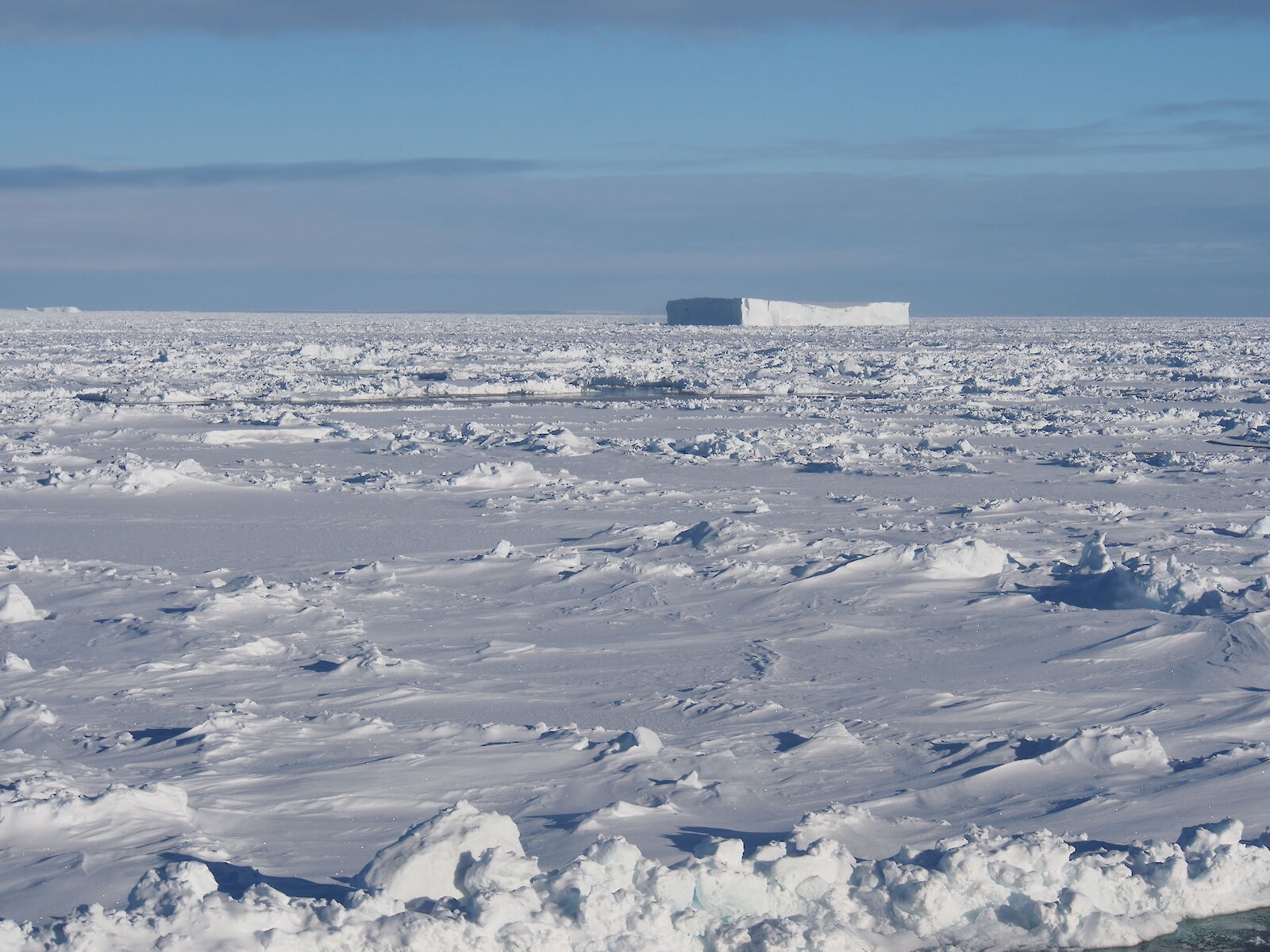
Tennis anyone? Bad news for skiers as snow season could shrink by 78% this century
Adrian McCallum, University of the Sunshine CoastAs the days shorten, many of us, particularly in Australia’s south-east, are looking forward to cooler times, and perhaps the allure of snow on the horizon. In the past week many in this region experienced their warmest days for over a century. What does this bode for times to come?
Research released overnight suggests ski areas in Australia and Aotearoa New Zealand will soon have much less snow due to climate change. German researcher Veronika Mitterwallner and her colleagues show average annual snow-cover days may decline by 78% in the Australian Alps and 51% in the Southern Alps of Aotearoa New Zealand (under a high-emissions scenario) by 2071–2100. Worldwide, they found 13% of ski areas will lose all natural snow cover by the end of the century.
It’s often said Australia gets more snow than Switzerland, though the evidence says otherwise. The fact remains that the Australian Alps cover a large area, more than 12,000km, with a third or more covered in snow at peak times. So these changes will have a broad impact on local economies and threaten fragile alpine ecosystems.
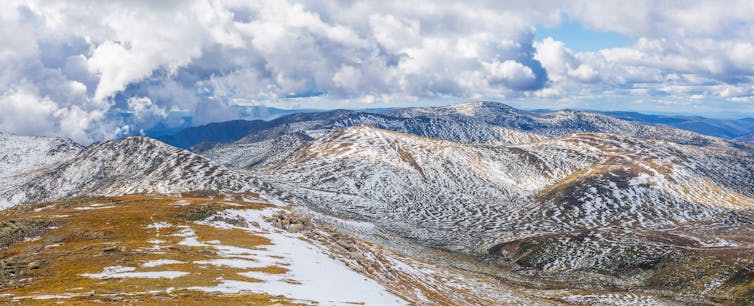
How Did The Study Make These Findings?
Mitterwallner’s team used a high-resolution climate data set for the global land surface area to identify the annual number of natural snow-cover days. Then, they projected those data under three emissions scenarios, and looked at historical (1950-2010), present (2011-2040), immediate future (2041-2070) and near future (2071-2100) data to examine changes over time.
Under most modelled emission scenarios, they found the annual number of snow-cover days will greatly decrease worldwide. For Australia and Aotearoa New Zealand, in particular, they found the average number will decrease by 78% and 51% respectively. These were the two regions with the greatest losses of snow.
However, under a low-emissions scenario, the good news is no regions will fall below an average of 100 snow-cover days a year. This is historically the minimum number of days a ski resort needs in seven out of ten winters to remain viable (cover must be at least 30–50cm).
How Will We Adapt To The Loss Of Snow?
Will the way we use our alpine areas have to change permanently? Many resorts have already pivoted to activities such as mountain biking that don’t rely on snow. Skiing may be off the agenda – tennis anyone?
The prognosis of such research has driven the formation of groups such as Protect Our Winters. The mission of the Australian section is to help Australia’s outdoor community protect the integrity of our unique alpine environment and lifestyle from climate change.
Beyond Australia, New York recently had its highest snowfall in two years. Across the United States in general, though, they just experienced the warmest winter ever.
What is going on? And what might this new research mean, particularly for Australia and Aotearoa New Zealand?
These predictions, for almost all emissions scenarios, do not bode well for the skiers among us. More importantly, as many communities in the Himalaya are finding out, snow is not just a recreational “nice to have”. It’s a life-source for alpine communities, both human and non-human, and all those that depend on rivers sustained by snow melt around the globe.
Perhaps a greater concern in our region is the potential for ecological damage as resorts seek to increase ski slope metreage in areas that remain snow-covered. Expanding resort footprints is not a sustainable approach to a problem that probably won’t be going away.

Is Artificial Snow An Option?
So how might we support the goals of Protect Our Winters? What alternatives do we have? How about artificial snow, would that work?
As part of my PhD studies many years ago, at the University of Cambridge’s Scott Polar Research Institute, I made masses of “polar snow” in a cold room (while effectively destroying the air-conditioning units at the same time). Artificial snow can be created quite readily, assuming enough water is at hand.
Artificial snow will have a different form and its density and microstructure will differ, potentially affecting longevity. (You can read more about snow mechanics here.)
But once on the ground, artificial snow, like natural snow, is subject to the vagaries of our weather. If the sun is shining and the day is hot, snow won’t last long, regardless of whether it’s natural or artificial.
There’s a lot to think on here as we contemplate what our world and our region might look like when skiing and snow-covered ground become no more than a memory in some areas. Yes, our recreational activities might change as we wonder whether it’s worth waxing up the skis this year – or is it time to break out the racquets? The ongoing survival of many communities might be jeopardised as a result.![]()
Adrian McCallum, Discipline Lead - Engineering, University of the Sunshine Coast
This article is republished from The Conversation under a Creative Commons license. Read the original article.
Who Knew That Eating Poo Was So Vital For Birds’ Survival?
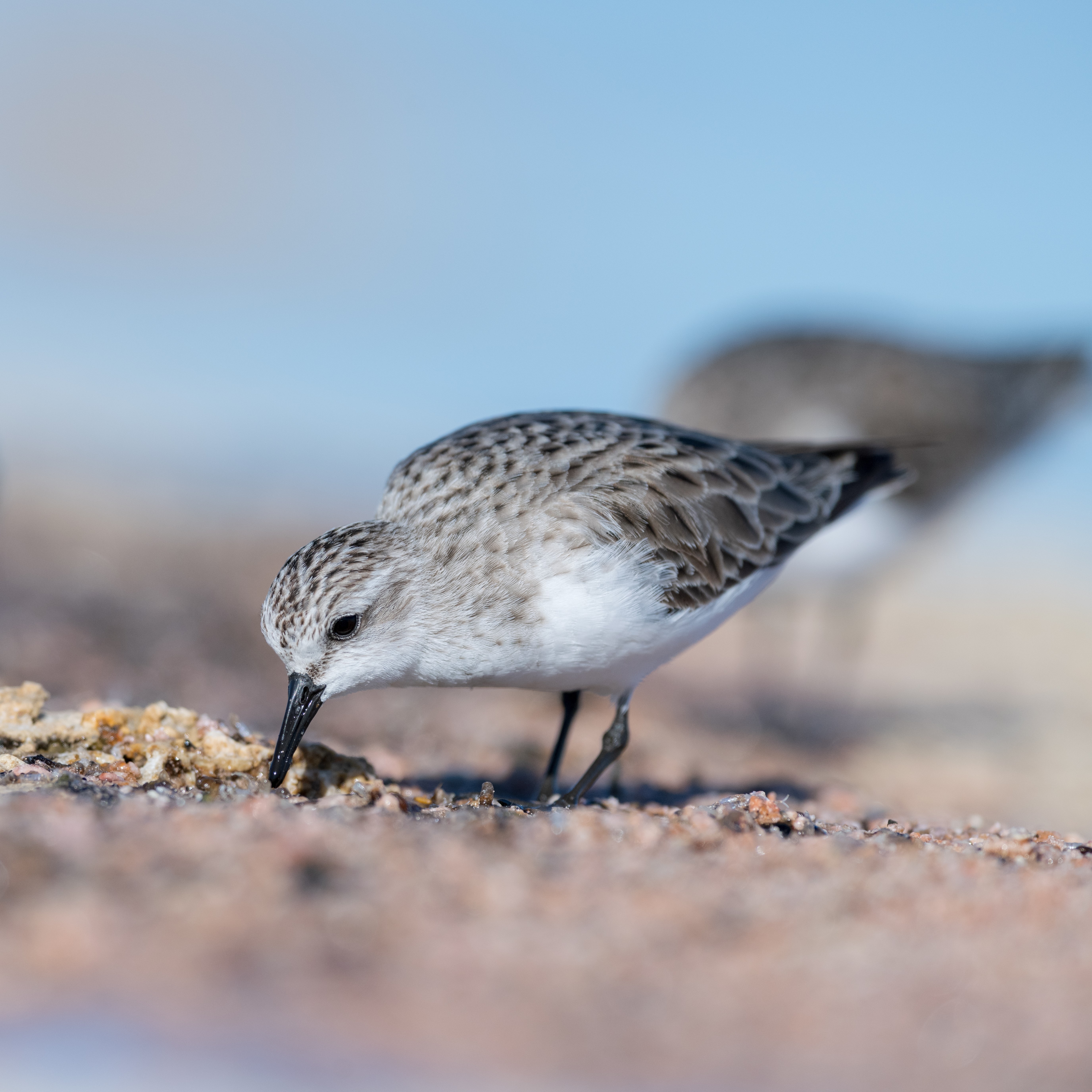
The surprising key to magpie intelligence: it’s not genetic
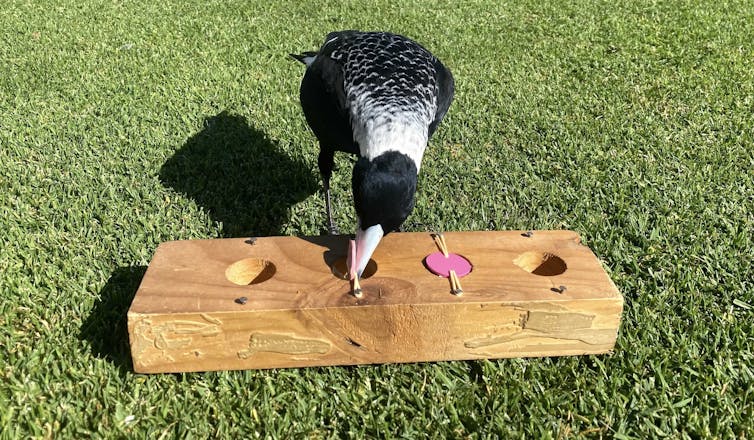
If you’ve ever had the pleasure of encountering Australia’s iconic magpies, you know these birds are intelligent creatures. With their striking black and white plumage, loud warbling voices and complex social behaviours, magpies possess a level of avian brilliance that fascinates birders and scientists alike.
But what enables these clever birds to thrive? Are their sharp cognitive abilities innate – something coded into their genetic makeup? Or are magpie smarts more a product of their environment and social experiences?
In a new study, we shed light on the “nature versus nurture” debate – at least when it comes to avian intelligence.
Bigger Social Groups, Smarter Birds
Our study focused on Western Australian magpies, which unlike their eastern counterparts live in large, cooperative social groups all year round. We put young fledglings – and their mothers – through a test of their learning abilities.
We made wooden “puzzle boards” with holes covered by different-coloured lids. For each bird, we hid a tasty food reward under the lid of one particular colour. We also tested each bird alone, so it couldn’t copy the answer from its friends.
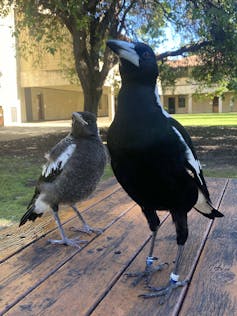
Through trial and error, the magpies had to figure out which colour was associated with the food prize. We knew the birds had mastered the puzzle when they picked the rewarded colour in 10 out of 12 consecutive attempts.
We tested fledglings at 100, 200 and 300 days after leaving the nest. While they improved at solving the puzzle as they developed, the cognitive performance of the young magpies showed little connection to the problem-solving prowess of their mothers.
Instead, the key factor influencing how quickly the fledglings learned to pick the correct colour was the size of their social group. Birds raised in larger groups solved the test significantly faster than those growing up in smaller social groups.
Fledglings living in groups of ten or more birds needed only about a dozen tries to consistently pick the rewarded colour. But a youngster growing up in a group of three took more than 30 attempts to learn the link between colour and food.
How The Social Environment Shapes Cognition
Why would living in a larger social group boost cognitive abilities? We think it probably comes down to the mental demands that social animals face on a daily basis, such as recognising and remembering group members, and keeping track of different relationships within a complex group.
Magpies can learn to recognise and remember humans, too. The bird populations we work with live in the wild, but they recognise us by our appearance and a specific whistle we make.

A young magpie living in a group gets plenty of mental exercise recognising and remembering numerous individuals and relationships. Working to make sense of this stream of social information may boost their ability to learn and solve problems.
Our findings go against the idea that intelligence is something innately “set” within an animal at birth, based solely on genetic inheritance. Instead, we show how cognition can be shaped by the environment, especially in the first year after leaving the nest when young magpies’ minds are still developing.
While we focused specifically on Australian magpies, the implications of our research could extend to other highly social and intelligent species.![]()
Lizzie Speechley, Behavioural Ecologist, The University of Western Australia
This article is republished from The Conversation under a Creative Commons license. Read the original article.
China’s green steel push could crush Australia’s dirty iron ore exports
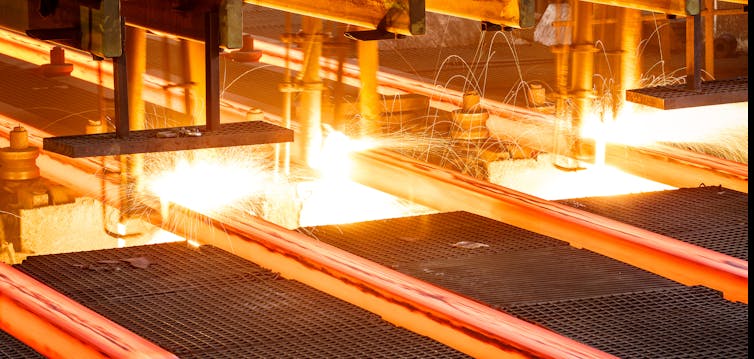
Australia’s largest export, iron ore, has long been a powerhouse of economic growth. Over the past two decades, its contribution to our national income has surged from just A$8 billion in 2005 to over A$124 billion today.
But the Australian iron ore industry faces a major challenge as its biggest customers – China’s steel mills – move to drastically reduce their carbon footprint.
The issue lies in the purity of our product. Most of Australia’s current iron ore exports are not classed as high grade. Typically, the lower the iron content of an ore is, the more energy is required to refine it.
Our competitors – countries such as Brazil and Guinea with higher-grade ores in relative abundance – are positioned to become the steel industry’s suppliers of choice.
Australia could adapt its production to meet this change in demand. But if it doesn’t do so quickly, it may find itself left behind in the new green economy.
Iron Ore’s Biggest Customer Cleans Up Its Act
China is the largest importer of Australian iron by a hefty margin. Australia shipped 736 million tonnes – more than 80% of iron ore exports – to China in 2022.
Last year, China’s steel mills made up the majority of global steel production. But they were also a major polluter, accounting for about 15% of China’s total greenhouse gas emissions.
They’re now facing a double whammy of decarbonisation pressures.
At home, the Chinese government has mandated the steel industry reduce its emissions as part of China’s wider “dual carbon” goals. These will require emissions to peak before 2030 and for the country to become carbon neutral by 2060.
And internationally, upcoming tariffs on carbon-intensive steel imports are set to make producing “dirty” steel much costlier.
Australian Ore Doesn’t Make The Grade
Making steel with low-grade iron ore isn’t at all carbon friendly.
For one, it consumes vastly more energy in the traditional steelmaking process. My analysis shows that using one tonne of low-grade ore can emit over 200 kilograms more carbon dioxide in a blast furnace than high-grade.
A high level of impurities in low-grade ore also significantly reduces the efficiency of the process.
Reducing the use of low-grade ore has become a priority for Chinese steel mills, significantly affecting iron ore’s demand profile.
Much of the iron ore exported by competing nations like Brazil and Guinea is high-grade, containing more than 65% iron. But most of Australia’s current exports fall below that threshold, between 56% and 62%.
New Technologies
A number of new and emerging steelmaking technologies offer the promise of significantly lower emissions.
But common to all of them is a need for higher-grade iron ore than Australia produces.
There are four new steelmaking technologies in use or under construction by a number of Chinese steel corporations, including the world’s biggest steelmaker – China Baowu Group. These include:
hydrogen-enriched carbon recycling and oxygen furnace (HyCROF)
hydrogen reduction and electric smelting process (HyRESP)
green hydrogen zero carbon fluidized bed iron making technology.
Here’s how these technologies could help China reduce its carbon emissions:
Increased Use Of Steel Scraps
Global demand for steel is forecast to increase to 2.2 billion tonnes by 2050.
But that won’t all translate into greater demand for our iron ore.
Overall demand for iron ore could be reduced by the increasing availability and use of steel scraps or “recycled steel”, such as scrapped vehicles, white goods and machinery.
Using one tonne of recycled steel for steelmaking saves 1.4 tonnes of iron ore and avoids about 1.5 tonnes of carbon dioxide emissions.
New Tariffs On Carbon
A number of legislative measures are on the horizon for the global steel industry, which produced about 7% of global greenhouse gas emissions in 2022.
One such international measure, the European Union’s Cross-Border Adjustment Mechanism (CBAM), has further accelerated a global drive toward sustainable steelmaking.
This legislation acts as a carbon tariff on imports to the EU, initially aimed at carbon-intensive products such as steel. It will be fully in force by 2026.
EU importers of steel products will be required to pay an import carbon tax, at a price set by the EU, based on the differences in carbon emissions between traditional steel mills and the EU’s emission benchmarks.
Being forced to charge higher prices for carbon-intensive steel products will incentivise non-European steel mills to accelerate their transition to green steel.
What Lies Ahead
The global transition to green steelmaking is bound to shape the future of Australia’s iron ore industry. Reduced demand for Australia’s low-grade iron ore could put pressure on its producers’ revenue, or even force some smaller iron ore miners to shut down.
But it also presents opportunities. Here are two ways Australia could ride the wave:
1. Substantially increase production and export of magnetite.
Australia is abundant in magnetite, an ore type which differs in composition from hematite or “direct shipping ore” (DSO). Magnetite has a low iron content (between 30 and 40%), but can be processed to a higher grade through a process of removing impurities known as “beneficiation”. This process is energy intensive, but could become economically viable if we continue to see rapid uptake of renewable energy.
2. Build direct reduction plants here in Australia.
Unlike the traditional blast furnace process, which uses coal as a source of energy, the direct reduction process uses hydrogen to reduce iron ore into iron without melting it.
There has been much hype around Australia’s potential to produce cheap hydrogen with renewable energy. But if we pull it off, we could stand at the forefront of the green steel revolution as a global production hub of direct reduced iron.
Decisions made by Australia’s major iron ore producers and political leaders will shape the outcome of this global shift. Rather than fear the transition, Australia could take on a leading role. ![]()
Charlie Huang, Co-leader, Sustainable Global Business Operations and Development Research Group, School of Management, RMIT University
This article is republished from The Conversation under a Creative Commons license. Read the original article.
Surviving fishing gear entanglement isn’t enough for endangered right whales – females still don’t breed afterward

It sounds like a crime show episode at sea: In late January 2024, federal regulators learned that a dead female North Atlantic right whale had been sighted near Martha’s Vineyard, Massachusetts. The whale was towed to shore, where more than 20 U.S. and Canadian scientists converged to perform a necropsy, or animal autopsy.
On Feb. 14, the U.S. National Oceanic and Atmospheric Administration announced that the whale was #5120 in a catalog that tracks individual right whales. Further, the agency said, rope that had been deeply embedded in the whale’s tail had likely come from lobster fishing gear in Maine.
Entanglement in fishing gear is a deadly threat to these critically endangered animals. Scientists estimate that before commercial whaling scaled up in the 18th and 19th centuries, there may have been as many as 10,000 North Atlantic right whales. Today, fewer than 360 individuals remain. Almost 90% of them have been entangled at least once.
When whales become entangled in fishing gear, they use extra energy dragging it as they swim. If the rope is caught around their mouths, they may struggle to feed and slowly starve. Ropes wrapped around whales’ bodies, flippers or tails can cut into the animals’ skin and become deeply embedded in their flesh, as happened to whale #5120. This can cause infections, chronic emaciation and damage to whales’ blubber, muscle, bone and baleen – the bristly structures in their mouths that they use to filter prey from the water.
North Atlantic right whales are legally protected, both internationally and in U.S. waters, including policies that seek to reduce deaths or serious injuries resulting from entanglements. However, even when entanglement does not kill a whale, it can affect individuals’ ability to reproduce, which is critically important for a species with such low numbers.
In a newly published study, we show that even entanglements scientists classify as minor have devastating impacts on female right whales and that, surprisingly, potential mothers who suffer “minor” entanglements have the lowest chance of starting to breed. As researchers with expertise in marine biology, ecology and statistics, we believe our findings underline the urgent need for ropeless fishing gear that can reduce threats to the survival of this species.
Smaller Females Are Having Fewer Young
Understanding reproductive patterns is essential for supporting species that are critically endangered. North Atlantic right whales historically started breeding by around 9 years of age and gave birth to a single calf every three to four years thereafter for several decades.
Today, however, many females have yet to reproduce at all. Moreover, those that have successfully produced calves now don’t produce another calf for more than seven years on average.
As we showed in a 2022 study, after an encouraging North Atlantic right whale population recovery from the 1970s through the early 2000s, the number of reproductively mature female right whales declined from 2014 onward. By 2018 there were only about 73 breeding females left, representing roughly half of all females and a sixth of the entire species.
Other research has shown that poor health and physical condition are making it harder for these females to even start breeding. Since the early 1980s, North Atlantic right whales have literally shrunk: Adults have shorter bodies than they did several decades ago. This trend is associated with entanglements in fishing gear. As is true for all mammals, decreasing female body size reduces the likelihood of reproducing. Smaller whales have fewer calves.
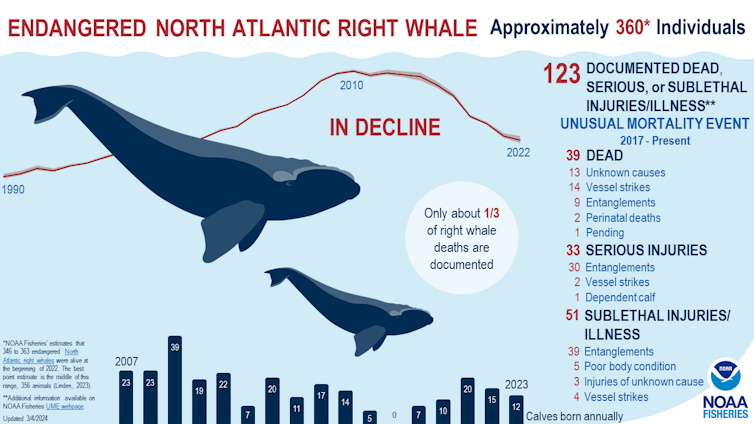
Low calving rates are a significant factor in North Atlantic right whales’ decline, so it is important to understand what causes them. Many organizations are involved in tracking North Atlantic right whales, including government agencies, aquariums and conservation groups. Photos taken from the air enable researchers to identify individuals and so monitor whale population trends, births and deaths, ocean habitat use patterns, health and rates of scarring from entanglements and collisions with ships.
Our new study found that female right whales who have experienced even a minor entanglement before reaching sexual maturity may not ever start to breed. Even females who have previously reproduced are less likely to breed again following an entanglement event.
We determined this by using a mathematical model to incorporate information on the identity of individual whales, derived from photographs of natural markings known as callosities on the whales’ heads. By identifying and photographing whales repeatedly over time, scientists can estimate different stages of their life, such as when females give birth.
Weakness Of Current Regulations
Researchers categorize the severity of injuries that result from entanglements as minor, moderate or severe. The scientists who manage the right whale catalog classify scars or injuries on the skin as minor if they are smaller than 0.8 inches (2 centimeters) without entering the blubber. If they are larger and enter the blubber, they are classified as moderate. Injuries that extend deep into the muscle or bone are categorized as severe.
Our research makes it clear that such value-laden terms are potentially misleading because even minor entanglements can threaten whales’ successful reproduction.
Multiple laws ostensibly protect North Atlantic right whales, including the U.S. Endangered Species Act and Marine Mammal Protection Act, and Canada’s Species at Risk Act. In our view, these measures do not give enough weight to preventing all types of entanglements, regardless of severity.
Under the Marine Mammal Protection Act, the NOAA develops and implements conservation plans and so-called Take Reduction Plans, which are designed to minimize wildlife deaths and serious injury resulting from commercial fishing gear.
The Atlantic Large Whale Take Reduction Plan, developed in 1997, requires fishers to use weak links, with a maximum breaking strength of 1,700 pounds (771 kilograms), to connect lobster and crab pots to buoys on the surface. These links are intended to break when whales swim into them, so that the whales do not become entangled and weighted down by ropes and traps.
The plan also requires fishers to use heavy ground lines to connect multiple traps or pots. These lines are designed to sink to the bottom rather than floating in the water column. And the plan closes trap fishing areas seasonally when whales are known to be present in those zones.
Coming Back From The Brink
Current population estimates suggest that the numbers of North Atlantic right whales could be stabilizing, meaning that the number of deaths is approximately equal to the number being born. While these estimates seem promising, females need to start and continue producing calves to increase whales’ numbers.
From our work, it is very clear that both lethal and sublethal impacts of entanglements are of grave concern for these whales. As we see it, eliminating entanglement, not mitigating it, is the only way to avoid the extinction of this species. Every entanglement, whatever its severity, is bad news for the whales.![]()
Joshua Reed, Research Associate in Biology, Macquarie University; Leslie New, Assistant Professor of Statistics, Ursinus College; Peter Corkeron, Adjunct Senior Research Fellow, Centre for Planetary Health and Food Security, Griffith University, and Rob Harcourt, Professor of Marine Ecology, Macquarie University
This article is republished from The Conversation under a Creative Commons license. Read the original article.
Petrol, pricing and parking: why so many outer suburban residents are opting for EVs

Until now, you might have thought of electric vehicles as inner suburban toys. Teslas and Polestars are expensive, leaving them as playthings for wealthier Australians and out of reach for the mortgage belt.
But that’s no longer the case. As residents in the outer suburbs reel from price rises seemingly everywhere, more and more are turning to electric vehicles (EVs) to slash their fuel bill.
Last year, EV orders for outer suburban residents (43%) overtook inner suburban residents (39%) for the first time. Rural and regional residents accounted for 18% of orders.
Avoiding petrol costs is one reason. But there are other good reasons, from easier parking and charging, to lower maintenance. And as our research into why people buy EVs has shown, there’s an even more fundamental reason – car buyers now know more about EVs and feel more familiar with the technology.
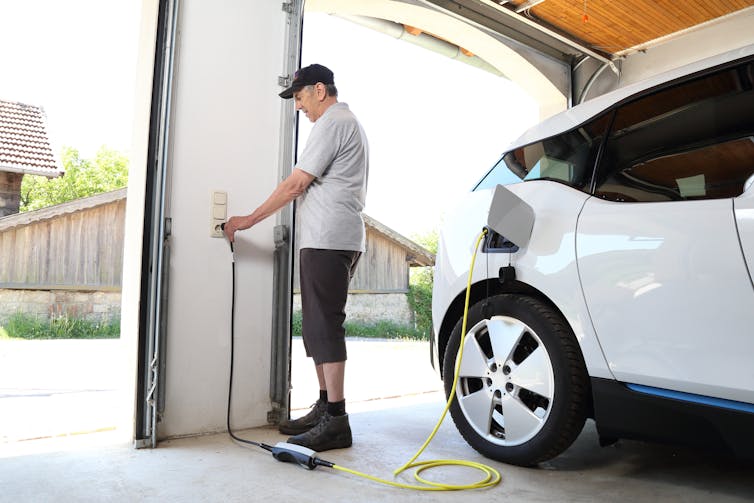
Outer Suburbs Rely On Cars
The further you get from the city centre, the more likely you are to have to drive. Distances are longer and public transport drops off. Research from 2020 shows most outer suburban residents who commute have to travel between 10 and 30 kilometres. Every workday return commute costs these workers about A$36 in car running costs, or $180 a week – and this figure will likely have risen since.
So while the initial upfront cost of an EV may put some people off, others run the numbers on how much they spend on petrol – and how much they would save by going electric.
Petrol prices have surged in recent years due to armed conflict in Europe and the Middle East. This affects outer suburban, rural and regional residents the most, given they cover the most distance.
This is a major reason why more outer suburbanites are going electric. Electricity is much cheaper than petrol, especially if you make it yourself with solar. Outer suburban residents are more likely to have solar on their rooftops than inner suburban residents in Sydney and Melbourne.
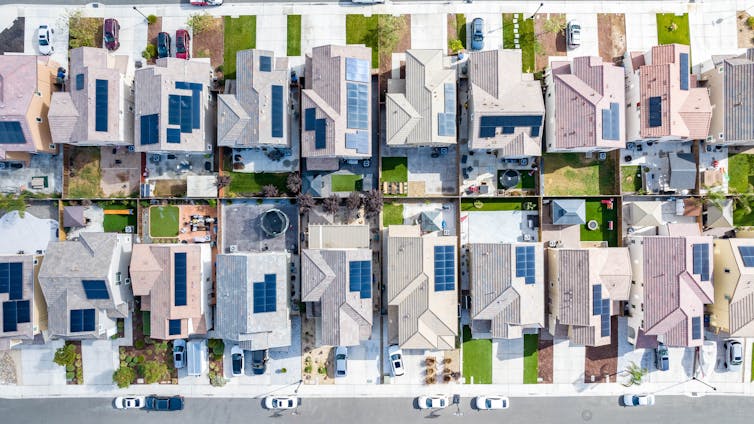
Data from the Australian Bureau of Statistics shows the majority of electric vehicle owners live 20 to 60km away from their city’s CBD.
The most popular EVs in Australia last year (Tesla Model Y, Model 3 and BYD’s Atto) can drive between 400 and 500km before needing a recharge. The all-important range has grown substantially in recent years, and now mean suburban residents can commute, shop and go out without worrying about finding a place to charge.
In fact, the outer suburbs are better placed than inner suburbs in terms of charging cheaply. In the inner suburbs, space is at a premium and many houses do not have off-street parking. That makes it hard to recharge your car from your home. But outer suburban homes tend to have off street parking or a garage, which means you can charge cheaply at home.
This is to say nothing of the environmental benefits by avoiding what comes out of the tailpipe of an internal combustion car: carbon dioxide, PM2.5 particles dangerous to our health, and many other nasties.
EVs Versus The Cost Of Living
At present, many of us are reining in expenses, cutting back on extracurricular activities and putting off holidays to cope with the surging cost of everything – especially mortgages.
It would make financial sense for many of us to switch to EVs to take advantage of much cheaper running and maintenance costs. But the higher up-front cost of EVs has long been a disincentive.
What’s changing now is that cheaper EVs are arriving from the likes of the world’s second-largest EV manufacturer, China’s BYD and other Chinese brands such as MG. Tesla has cut its prices, too.
In Australia, the cheapest EVs now start from A$40,000, though most still cost $60,000–$90,000.
The secondhand market is growing too, as government fleet EVs come up for sale and as early adopters buy new cars and sell their old.
What Are Governments Doing?
Subsidies, tax credits, and local charging infrastructure are making it easier for residents on the outskirts to transition towards greener transport.
Some state governments are trying to accelerate adoption with a range of incentives for EV owners, from subsidies to cheaper registration. The interest was so strong in Victoria and South Australia that these governments have wound back some subsidies. By contrast, Queensland is offering a generous $6,000 rebate for new EV owners.
At a federal level, the proposed new vehicle efficiency standards will encourage carmakers to sell more fuel-efficient vehicles. If these standards come in, they will likely penalise fuel-guzzling cars and make fuel misers cheaper. They will also likely increase the number of EVs and other zero-emissions vehicles in the Australian market.
What’s Next?
Outer suburban residents are buying electric vehicles for very good reasons: financial prudence, practicality and a cleaner future.
Petrol is a substantial expense for many who live in car-dependent suburbs. If you can stop buying it and get the same thing you want – transport – with far cheaper running costs, why wouldn’t you? ![]()
Park Thaichon, Associate Professor of Marketing, University of Southern Queensland
This article is republished from The Conversation under a Creative Commons license. Read the original article.
Ultra-fast fashion is a disturbing trend undermining efforts to make the whole industry more sustainable

Since the 1990s, fast fashion has enabled everyday people to buy the latest catwalk trends. But the sheer volume of garments being whipped up, sold and soon discarded is contributing to a global sustainability crisis.
Now, just when the fashion industry should be waking up and breaking free of this vicious cycle, it’s heading in the opposite direction. We’re on a downward spiral, from fast fashion to ultra-fast fashion. The amount of natural resources consumed and waste produced is snowballing.
Ultra-fast fashion is marked by even faster production cycles, blink-and-you’ll-miss-it trends, and poor labour practices. Brands like Shein, Boohoo and Cider are liberated from the concept of seasonal collections. Instead they are producing garments at breakneck speeds and self-generating microtrends such as balletcore, Barbiecore and even mermaidcore. At the same time there is limited transparency or accountability around clothing supply chains.
The overproduction and consumption of clothing cannot be allowed to continue. Without change, the industry will account for 26% of the world’s carbon budget for limiting global warming to 2°C by 2050. The fashion industry must take responsibility for its actions. Policymakers also have an important role to play in enabling the necessary shift towards a more responsible and circular fashion economy. And let’s not forget the power of consumers.
Cheap Clothing At What Cost?
It was once thought the pandemic would trigger a transition to a more sustainable fashion industry. Unfortunately in reality the industry is getting worse, not better.
Most ultra-fast fashion brands emerged in the late 2010s following the most well known, Shein, founded in 2008. These online, direct-to-consumer brands exploded in popularity during lockdowns, with Shein holding the title of the world’s most popular brand in 2020.
Established brands such as Gap introduce 12,000 new items a year and H&M 25,000. But Shein leaves them in the dust, listing 1.3 million items in the same amount of time. How is this even possible?
The ultra-fast fashion model thrives on data and addictive social media marketing to create insatiable consumer demand.
But Shein’s incredibly low prices (its website has thousands of items under A$5) come at a human cost. The company’s own 2021 Sustainability and Social Impact Report (later removed from the site) found only 2% of its factories and warehouses met its own worker safety standards, with the rest requiring corrective action.
The brand has also forgone in-house designers. Instead it works with independent suppliers who can design and manufacture a garment in two weeks.
The result is an incredibly profitable business model. Shein filed for an initial public offering (IPO) last year to value the brand at US$136 billion, up from US$2.5 billion in 2018.
Shifting from fast to ultra-fast fashion has serious environmental and social consequences. This includes even more exploitative labour practices. Shein garment workers reportedly work 75-hour weeks and warehouses operate 24/7.
Ignoring this shift isn’t just a fashion faux pas. Doing so jeopardises national efforts for a more sustainable fashion industry.
A Seamless Transition To Sustainability
The Australian Fashion Council is leading a national product stewardship scheme called Seamless that promises to transform the fashion industry by 2030.
The idea is to bring fashion into the circular economy. Ultimately that means zero waste, but in the meantime raw materials would be kept in the supply chain for as long as possible by designing out and minimising waste.
Members will contribute a four-cent levy for every clothing item they produce or import.
These funds go into clothing collection, research, recycling projects and education campaigns.
BIG W, David Jones, Lorna Jane, Rip Curl, R.M. Williams, THE ICONIC, Sussan Group and Cotton On are Seamless Foundation Members. Each has contributed A$100,000 to the development of the scheme.
As one of the world’s first industry-led collective product stewardship initiatives for clothing textiles, Seamless presents a unique opportunity to drive change towards a more sustainable and circular fashion industry.
But there is a risk ultra-fast fashion brands may act as freeriders in Seamless, benefiting from the investment and initiatives without making meaningful contributions. Shein and others will continue putting more and more product on the market, which will need to be dealt with at the end of its short life. But if they fail to commit to the scheme, they won’t be the ones paying for that.
The government-funded consortium must also recognise ultra-fast fashion in tackling the industry’s environmental and social sustainability challenges. At the moment they’re only talking about fast fashion and ignoring the rise of ultra-fast fashion. Their global scan, for example, includes a discussion of fast fashion and no mention of ultra-fast fashion.
This also points to a lack of data more broadly in the industry but in the case of Seamless, it could have a big impact if this growing market segment is ignored.
Shein and Temu are estimated to earn a combined $2 billion in sales in 2024, with customers from all walks of life.
The Critical Crackdown
Some brands are actively engaged and working towards a more sustainable future. But others such as Temu are learning from Shein and looking to emulate their business model.
The transition to a more sustainable and responsible fashion industry requires a greater understanding of ultra-fast fashion, urgent systemic changes and collective efforts.
The Institute for Sustainable Futures, where I work, is a founding member of an international academic research network aimed at tackling the complexities of ultra-fast fashion. That includes how ultra-fast fashion is affecting the livelihoods of garment workers, how it’s fuelling textile waste and underscoring the industry’s struggle to embrace circular economy principles. We’re also investigating how to reshape consumer behaviour, away from social media-fuelled hauls towards more sustainable consumption particularly among Gen-Z consumers.
Last month, Federal Environment Minister Tanya Plibersek announced a potential intervention, perhaps by introducing minimum environmental standards or a clothing levy by July.
The clock is ticking. It is time to lay the foundation for a more sustainable and just fashion industry. Australia has a rich fashion history and is home to many leading local brands – many of whom have gone global. These brands show us what is possible when good design, sustainability and innovation drive an industry.
Ultimately, our collective choices wield immense power. By understanding the consequences of our fashion habits and advocating for change, we can all be catalysts for a more sustainable and just fashion industry.![]()
Taylor Brydges, Research Principal, University of Technology Sydney
This article is republished from The Conversation under a Creative Commons license. Read the original article.
Sweden has vast ‘old growth’ forests – but they are being chopped down faster than the Amazon
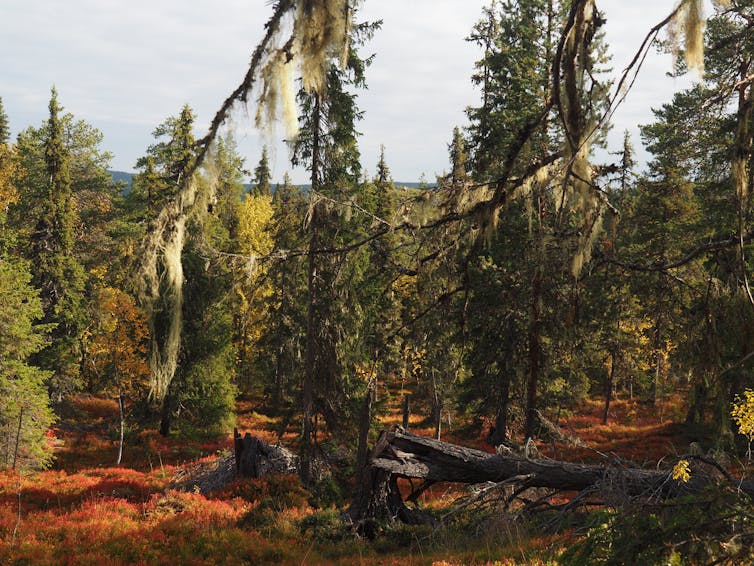
Most of Europe’s natural ecosystems have been lost over the centuries. However, a sizeable amount of natural old forest still exists, especially in the north. These “old-growth” forests are exceptionally valuable as they tend to host more species, store more carbon, and are more resilient to environmental change.
Many of these forests are found in Sweden, part of the belt of boreal forests that circle the world through Canada, Scandinavia and Russia. But after researching these last relics of natural forest we have found they are being cleared rapidly – at a rate faster even than the Amazon rainforest.
There is no direct monitoring of these forests, no thorough environmental impact assessments and most of the public don’t seem to be aware this is even happening. Other evidence suggests something similar is happening right across the world’s boreal forests.
It can be tricky to know exactly how much old-growth forest there is, since the distinction might not always be clear. However, there is a clear difference between forests that have been “clear-cut” (entirely chopped down) sometime in the past and those that never have.
Clear-cutting started appearing in Sweden in the early 1900s and has been the dominant type of forestry in the country since the 1950s. The uncut forests that predate this time have therefore most likely not been clear-cut and since they are old they can be classified as old-growth forests.
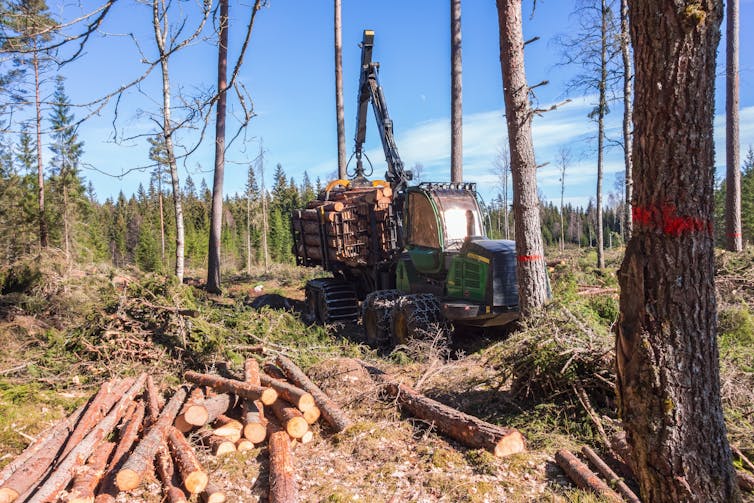
In our study, we looked specifically at forests in unprotected areas where the trees predated 1880 on average. That’s long before the large-scale adoption of clear-cutting in Sweden and means those forests have likely never been clear-cut.
These unprotected old-growth forests constitute around 8% of the productive forest land in Sweden, that is, the area that is generally favourable for forestry (omitting forests close to the Scandinavian mountain range tree line). This amounts to about 1.8 million hectares of old-growth forest, more than the total wooded area in many European countries.
This area of unprotected old-growth forest, with the remaining protected old-growth and primary forests, constitutes a large share of the last known ecosystems of “high naturalness” in the EU.
What Is Happening To These Old-Growth Forests?
Between 2003 and 2019, 20% of all the clear-cut forest in Sweden was old-growth. This means a sizeable share of forest products, such as timber, paper and bioenergy, comes from old trees. The losses to unprotected old-growth forests amount to 1.4% per year, which means they will be lost completely by the 2070s if the trend continues.
To put this in perspective, Sweden’s old-growth forests have been cleared six to seven times faster than the Brazilian Amazon forest between 2008 and 2023. (Of course, given the size of the Amazon, the total amount of cleared forest is much larger there).
While our study, shockingly enough, appears to be the only of its kind across the boreal region, there is some research showing that old-growth forests are also harvested in Canada. Additional anecdotal evidence further suggests the unchecked loss of old-growth forests to forestry operations in other boreal regions .
What’s Next?
The European Commission has drafted guidelines for all countries to map and protect all remaining old-growth and primary forests. This would be a good start.
But ultimately, we’ll need a coordinated system to map and monitor the entire boreal forest simply to learn the rate at which it is being lost. This would also help us understand the implications for carbon storage, for other plants and animals that live in these forests, and the humans that use them.
Unfortunately, this is a large and difficult task. Yet this might be one of our last chances to protect and recover large areas of natural forests. Logging old-growth forests now will delay their recovery for centuries.![]()
Anders Ahlström, Associate Professor, Department of Physical Geography and Ecosystem Science, Lund University and Pep Canadell, Chief Research Scientist, CSIRO Environment; Executive Director, Global Carbon Project, CSIRO
This article is republished from The Conversation under a Creative Commons license. Read the original article.
Can earth-covered houses protect us from bushfires? Even if they’re a solution, it’s not risk-free
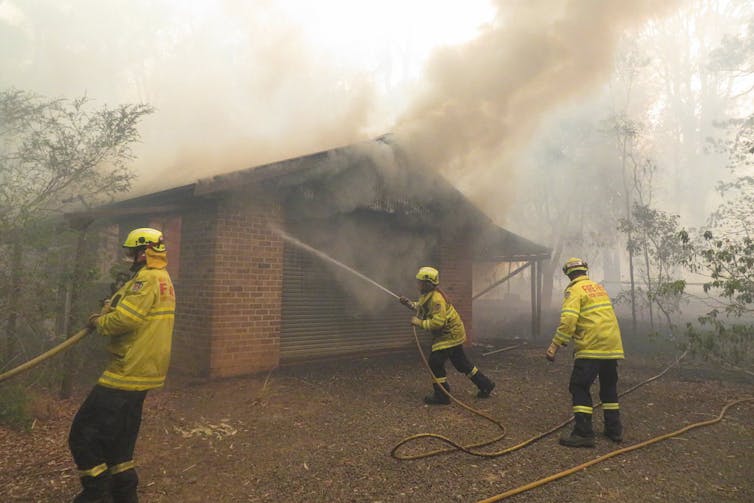
As extreme fire weather becomes more common across ever larger areas of Australia, we need new options for living with the risk of bushfire. Underground or earth-sheltered housing is one possibility. While still unusual, these homes are being built in bushfire-prone areas.
But before we embrace this form of housing as a widespread solution to increasing bushfire risks, we need to consider its complexities. Things to weigh up include the challenges of designing and building these homes, their costs and occupants’ behaviour. We also have limited real-world evidence of how such homes perform in bushfires.
A broader question is whether we should allow more people to live in bushfire-prone areas. If we let that happen it will lead to more deaths and injuries.
What Does Building Such Homes Involve?
Earth-sheltered houses are often built into slopes, but can be built on flat ground, either by excavating or by mounding earth over the building. In Australia, concrete is generally used for the building structure to provide enough strength to allow soil to cover the roof and walls. The earth-covered areas can be vegetated.
Because of the amount of earth in contact with the exterior, care is needed to ensure the building is watertight and structurally sound.
The house usually has one main wall of windows facing away from the earth-covered side to provide natural light. To meet building regulations for ventilation, these buildings include rear windows in light wells or vents.
One advantage of earth-sheltered buildings is that their internal temperature remains quite stable. They use much less energy – up to 84% less for cooling and up to 48% less for heating – to maintain comfortable temperatures. (These figures are for all climates, compared to buildings with black roofs.)
These buildings can also offer greater opportunities for improved aesthetics (as the home blends into the landscape), landscaping, productive gardens and recreation. These benefits can offset having limited windows and constraints on building layouts.
What About Bushfire Resistance?
Bushfires present complex risks. Earth-sheltered buildings are likely to be a useful but somewhat expensive and limited niche solution on challenging legacy sites where housing already exists.
Few such buildings have been subjected to fires so we have limited evidence of their efficacy. However, it is clear they can be engineered to resist the main ways bushfires attack buildings: heat, flames and embers.
Since earth largely covers the building, the most vulnerable parts are windows and other openings. These can be designed to resist heat and flame, depending on the modelled levels.
Bushfire-resistant measures are estimated to add costs of between $53,000 and $273,000 (2020 values) compared to a typical home construction, depending on the site. Glass is often a key component. Because they are highly susceptible to heat, the cost of windows that can withstand a worst-case fire is often prohibitive.
An earth-shelter build usually costs much more than standard once one adds up the engineering, excavation, concrete and construction costs.
Most earth-sheltered structures rely on one side of the building having large windows to admit enough natural light inside. This window side is typically oriented downhill towards views, with the rear built into the slope. Bushfires increase speed and intensity when moving uphill, so the window side usually receives the most intense bushfire attack.
On sites with limited space, this challenge is often difficult to resolve. Sometimes the only solution is to remove large amounts of natural vegetation. This is done at the expense of ecological goals. The loss of plants whose roots bind the soil could also increase landslip risks.
Should People Even Be In High-Risk Places?
While it is possible to engineer a bushfire-resistant structure with a low risk of destruction, that doesn’t eliminate the risks created by people themselves.
Human factors greatly increase risks, even in well-designed bushfire-resistant structures. Poor maintenance or later modification can put a property at risk. Examples include unsafe storage of gas bottles and fuel, woodpiles, and modification of or failure to secure doors, windows or shutters.
Residents may also modify vegetation around an earth-covered home in ways that increase risks. They might, for example, plant highly flammable species, or allow fuel loads to build up, including mulch they might have laid down.
Despite education campaigns, warnings and alerts, people continue to put themselves in many risky situations before and during bushfires. Reasons include alert fatigue, expenses of evacuation, dangers while driving, being in unfamiliar locations such as holiday houses, retrieving children, protecting livestock and pets, or protecting underinsured or uninsured property. If more people live in bushfire-prone areas, there will be more bushfire-related deaths and injuries among both residents and bushfire responders.
The psychological impacts on people affected by extreme fires are significant. Nearly three-quarters suffered anxiety for two years after Australia’s 2019-20 Black Summer bushfires. Even if a structure survives, the emotional burdens of isolation while under duress, loss of communications and the heat, smoke, darkness and noise of extreme fires are powerful and underestimated.
Yet people’s differing levels of awareness and ability are often ignored as a factor in bushfire risk.
There’s A Wider Context To Consider
It makes little sense to put more people in bushfire-prone locations that will likely become riskier over time. Solutions such as earth-sheltered buildings may be part of a suite of ways to reduce risks in existing bushfire-prone residential areas.
However, at a wider scale, building low-density housing in bushfire-prone areas is unnecessarily risky. It also conflicts with the compelling need to build at much higher densities in existing areas to house Australia’s growing population. Higher-density housing will allow better and more affordable access (because of economies of scale) to services, infrastructure, jobs and public transport.![]()
Alan March, Professor of Urban Planning, Faculty of Architecture, Building and Planning, The University of Melbourne
This article is republished from The Conversation under a Creative Commons license. Read the original article.
Redwood trees are growing almost as fast in the UK as their Californian cousins – new study

What can live for over 3,000 years, weigh over 150 tonnes and could be sitting almost unnoticed in your local park? Giant sequoias (known as giant redwoods in the UK) are among the tallest and heaviest organisms that have ever lived on Earth, not to mention they have the potential to live longer than other species.
My team’s new study is the first to look at the growth of giant sequoias in the UK – and they seem to be doing remarkably well. Trees at two of the three sites we studied matched the average growth rates of their counterparts in the US, where they come from. These remarkable trees are being planted in an effort to help absorb carbon, but perhaps more importantly they are becoming a striking and much-admired part of the UK landscape.
To live so long, giant sequoias have evolved to be extraordinarily resilient. In their native northern California, they occupy an ecological niche in mountainous terrain 1400 – 2100 metres above sea level.
Their thick spongy bark insulates against fire and disease and they can survive severe winters and arid summers. Despite these challenges these trees absorb and store CO₂ faster and in greater quantities than almost any other in the world, storing up to five times more carbon per hectare than even tropical rainforests. However, the changing climate means Californian giant sequoias are under threat from more frequent and extreme droughts and fires. More than 10% of the remaining population of around 80,000 wild trees were killed in a single fire in 2020 alone.
Tree Giants From The US
What is much less well-known is that there are an estimated half a million sequoias (wild and planted) in England, dotted across the landscape. So how well are the UK giant sequoias doing? To try and answer this, my team used a technique called terrestrial laser scanning to measure the size and volume of giant sequoias.
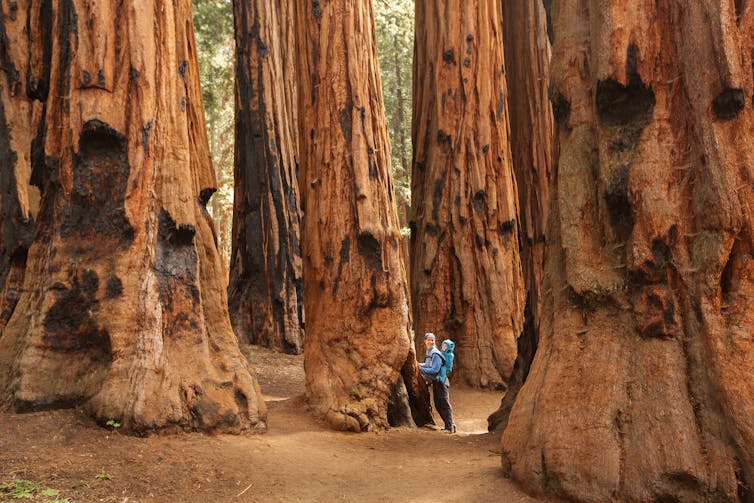
The laser sends out half a million pulses a second and if a pulse hits a tree, the 3D location of each “hit” is recorded precisely. This gives us a map of tree structure in unprecedented detail, which we can use to estimate volume and mass, effectively allowing us to estimate the tree’s weight. If we know how old the trees are, we can estimate how fast they are growing and accumulating carbon.
As part of a Master’s project with former student Ross Holland, and along with colleagues at Kew Royal Botanical Gardens, we measured giant sequoias across three sites - Benmore botanical gardens in Scotland, Kew Wakehurst in Sussex and Havering Country Park in Essex. These sites span the wettest (Benmore) and driest (Havering) climates in the UK, enabling us to assess how rainfall affects growth.
The fastest-growing trees we measured are growing almost as fast as they do in California, adding 70cm of height and storing 160kg of carbon per year, about twice that of a native UK oak. The trees at Benmore are already among the tallest trees in the UK at 55 metres, the current record-holder being a 66 metre Douglas Fir in Scotland. The redwoods, being faster growing, are likely to take that title in the next decade or two. And these trees are “only” around 170 years old. No native tree in the UK is taller than about 47 metres. We also found significant differences in growth rates across the UK. They grow fastest in the north where the climate is wetter.
So how did these trees get here? Exotic plant collecting was big business in the 18th and 19th centuries, in large part as a display of wealth and taste. Giant sequoias were first introduced in 1853 by Scottish grain merchant and keen amateur collector Patrick Matthew, who gave them to friends. Later that same year commercial nurseryman William Lobb brought many more from California, along with accounts of the giant trees from which they came.
Giant sequoias quickly became a sensation and were planted to create imposing avenues, at the entrances of grand houses and estates, in churchyards, parks and botanic gardens. The letters about these trees helps us to accurately age planted trees, enabling us to calculate their growth rates.
Normally, you need to take samples from a tree’s core to get an accurate age estimate but that can damage the tree.
Imagine Their Potential
UK sequoias are unlikely to grow as tall as their Californian counterparts, which tend to grow in forests, due to lightning strikes and high winds – always a risk when you’re the tallest thing in the landscape rather than one among many. More recently, there has been a resurgence in planting giant sequoias in the UK, particularly in urban settings. This is because of their carbon storage potential and perhaps because people seem to really like them.
We urgently need to understand how UK trees will fare in the face of much hotter, drier summers, stormier winters and with increased risks of fire. Global trade is also increasing the spread of disease among plantlife. More work is needed to consider the impact of planting non-native species like giant sequoias on native habitats and biodiversity but our work has shown that they are apparently very happy with our climate, so far.
More importantly, we have to remember that trees are more than just stores of carbon. If we value trees only as carbon sticks we will end up with thousands of hectares of monoculture, which isn’t good for nature.
But these giant sequoias are here to stay and are becoming a beautiful and resilient part of our landscape.

Don’t have time to read about climate change as much as you’d like?
Get a weekly roundup in your inbox instead. Every Wednesday, The Conversation’s environment editor writes Imagine, a short email that goes a little deeper into just one climate issue. Join the 30,000+ readers who’ve subscribed so far.![]()
Mathias Disney, Reader in Remote Sensing, Department of Geography, UCL
This article is republished from The Conversation under a Creative Commons license. Read the original article.
Vinegar and baking soda: a cleaning hack or just a bunch of fizz?
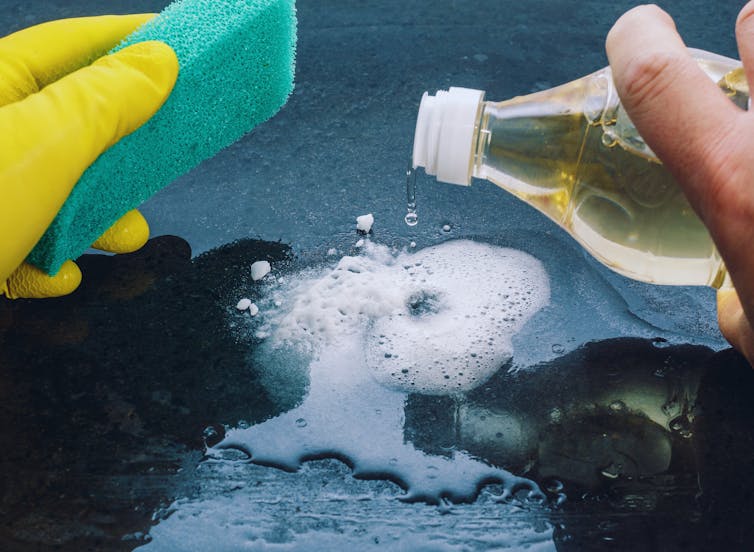
Vinegar and baking soda are staples in the kitchen. Many of us have combined them in childhood scientific experiments: think fizzy volcanoes and geysers.
But people also frequently mix vinegar and baking soda to produce a reportedly effective household cleaner. Unfortunately, the chemistry behind the bubbly reaction doesn’t support the cleaning hype. The fizzy action is essentially a visual “placebo”, formed by the combination of an acid and a base.
So, how does it work, and is it worth using these chemicals for cleaning? To understand all this, it helps to know a little more about chemistry.
What’s An Acid?
Foods with a sour taste typically contain acids. These include citric acid in lemon juice, malic acid in apples, lactic acid in yoghurt and phosphoric acids in soft drinks. Most vinegars contain around 4–10% acetic acid, the rest is water and small amounts of flavour chemicals.
There are other naturally occurring acids, such as formic acid in ant bites and hydrochloric acid in our stomachs. Industrially, sulfuric acid is used in mineral processing, nitric acid for fertiliser manufacturing and the highly potent hydrofluoric acid is used to etch glass.
All of these acids share similar properties. They can all release hydrogen ions (positively charged atoms) into water. Depending on their potency, acids can also dissolve minerals and metals through various chemical reactions.
This is why vinegar is an excellent cleaner for showers or kettles – it can react with and dissolve mineral deposits like limescale.
Other common acidic cleaning ingredients are oxalic acid, used for revitalising timber decks, hydrochloric acid in concrete and masonry cleaners, and sulfamic acid in potent toilet cleaners.

What’s A Base?
In chemistry, bases – the opposite of acids in many ways – can bind, rather than release hydrogen ions. This can help lift and dissolve insoluble grime into water. Bases can also break apart fat molecules.
Baking soda (also known as sodium hydrogen carbonate, sodium bicarbonate, or bicarb) is a relatively weak base. Stronger common bases include sodium carbonate (washing soda), sodium hydroxide (lye) and ammonia.
Sodium hydroxide is a potent drain cleaner – its strong base properties can dissolve fats and hair. This allows blockages to be broken down and easily flushed away.
Mixing A Base And An Acid
Mixing vinegar and baking soda causes an immediate chemical reaction. This reaction forms water, sodium acetate (a salt) and carbon dioxide – the fizzy part.
The amount of carbon dioxide gas that is produced from baking soda is remarkable – one tablespoon (around 18 grams) can release over five litres of gas! But only if you add enough acid.
Reactions in chemistry often use equal quantities of chemical reagents. A perfect balance of acetic acid and baking soda would give you just water, carbon dioxide and sodium acetate.
But the majority of vinegar and bicarb cleaner recipes use a large excess of one or the other components. An example from TikTok for a DIY oven cleaner calls for one and a half cups of baking soda and one quarter cup of vinegar.
Crunching the numbers behind the chemical reaction shows that after the fizz subsides, over 99% of the added baking soda remains. So the active cleaning agent here is actually the baking soda (and the “elbow grease” of scrubbing).
Ovens can be cleaned much more rigorously with stronger, sodium hydroxide based cleaners (although these are also more caustic). Many modern ovens also have a self-cleaning feature, so read your product manual before reaching for a chemical cleaner of any sort.
What About The Sodium Acetate?
Devotees of vinegar and baking soda mixtures might be wondering if the product of the fizzy reaction, sodium acetate, is the undercover cleaning agent.
Unfortunately, sodium acetate is an even weaker base than baking soda, so it doesn’t do much to clean the surface you’re trying to scrub.
Sodium acetate is used in crystallisation-based heating packs and as a concrete sealant, but not typically as a cleaner.
Fun fact: sodium acetate can be combined with acetic acid to make a crystalline food additive called sodium diacetate. These crystals give the vinegar flavour to salt and vinegar chips without making them soggy.
Sorry To Burst Your Bubbles
There are a few rare cases where mixing vinegar and baking soda may be useful for cleaning. This is where the bubbling has a mechanical effect, such as in a blocked drain.
But in most cases you’ll want to use either vinegar or baking soda by itself, depending on what you’re trying to clean. It will be less visually exciting, but it should get the job done.
Lastly, remember that mixing cleaning chemicals at home can be risky. Always carefully read the product label and directions before engaging in DIY concoctions. And, to be extra sure, you can find out more safety information by reading the product’s safety data sheet.![]()
Nathan Kilah, Senior Lecturer in Chemistry, University of Tasmania
This article is republished from The Conversation under a Creative Commons license. Read the original article.
New evidence for an unexpected player in Earth’s multimillion-year climate cycles: the planet Mars
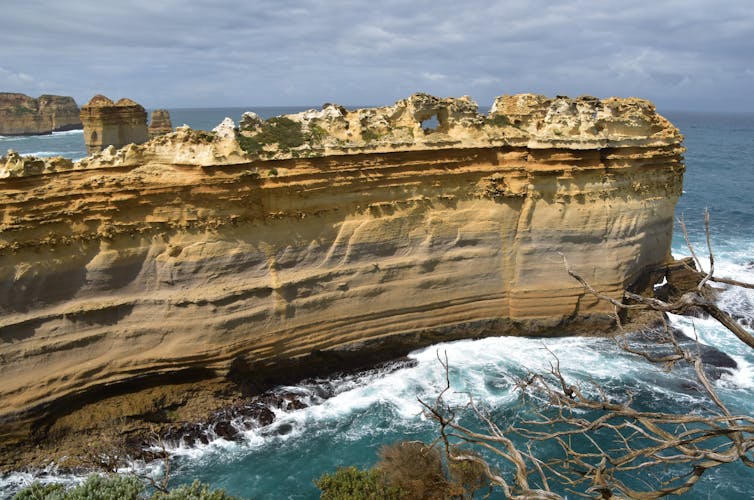
Our existence is governed by natural cycles, from the daily rhythms of sleeping and eating, to longer patterns such as the turn of the seasons and the quadrennial round of leap years.
After looking at seabed sediment stretching back 65 million years, we have found a previously undetected cycle to add to the list: an ebb and flow in deep sea currents, tied to a 2.4-million-year swell of global warming and cooling driven by a gravitational tug of war between Earth and Mars. Our research is published in Nature Communications.
Milankovitch Cycles And Ice Ages
Most of the natural cycles we know are determined one way or another by Earth’s movement around the Sun.
As the German astronomer Johannes Kepler first realised four centuries ago, the orbits of Earth and the other planets are not quite circular, but rather slightly squashed ellipses. And over time, the gravitational jostling of the planets changes the shape of these orbits in a predictable pattern.
These alterations affect our long-term climate, influencing the coming and going of ice ages. In 1941, Serbian astrophysicist Milutin Milankovitch recognised that changes in the shape of Earth’s orbit, the tilt of its axis, and the wobbling of its poles all affect the amount of sunlight we receive.
Known as “Milankovitch cycles”, these patterns occur with periods of 405,000, 100,000, 41,000 and 23,000 years. Geologists have found traces of them throughout Earth’s deep past, even in 2.5-billion-year old rocks.

Earth And Mars
There are also slower rhythms, called astronomical “grand cycles”, which cause fluctuations over millions of years. One such cycle, related to the slow rotation of the orbits of Earth and Mars, recurs every 2.4 million years.
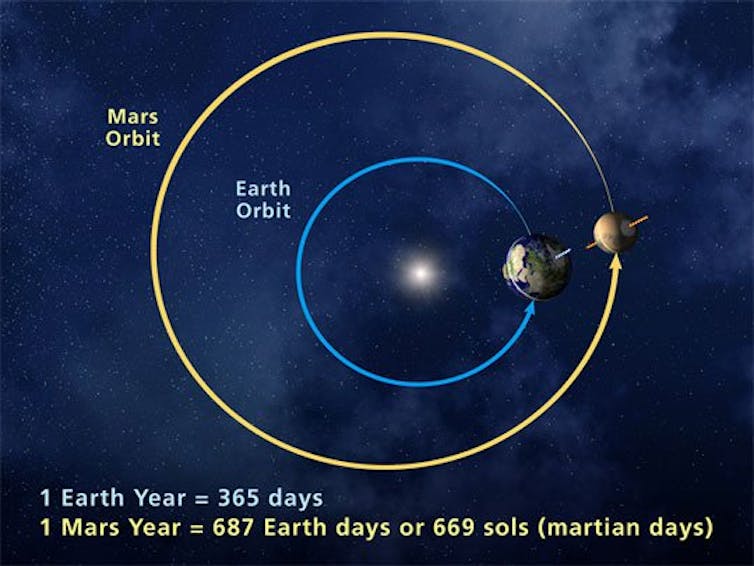
The cycle is predicted by astronomical models, but is rarely detected in geological records. The easiest way to find it would be in sediment samples that continuously cover a period of many millions of years, but these are rare.
Much like the shorter Milankovitch cycles, this grand cycle affects the amount of sunlight Earth receives and has an impact on climate.
Gaps In The Record
When we went hunting for signs of these multimillion-year climate cycles in the rock record, we used a “big data” approach. Scientific ocean drilling data collected since the 1960s have generated a treasure trove of information on deep-sea sediments through time across the global ocean.
In our study, published in Nature Communications, we used sedimentary sequences from more than 200 drill sites to discover a previously unknown connection between the changing orbits of Earth and Mars, past global warming cycles, and the speeding up of deep-ocean currents.
Most studies focus on complete, high-resolution records to detect climate cycles. Instead, we concentrated on the parts of the sedimentary record that are missing — breaks in sedimentation called hiatuses.
A deep-sea hiatus indicates the action of vigorous bottom currents that eroded seafloor sediment. In contrast, continuous sediment accumulation indicates calmer conditions.
Analysing the timing of hiatus periods across the global ocean, we identified hiatus cycles over the past 65 million years. The results show that the vigour of deep-sea currents waxes and wanes in 2.4 million year cycles coinciding with changes in the shape of Earth’s orbit.
Astronomical models suggest the interaction of Earth and Mars drives a 2.4 million year cycle of more sunlight and warmer climate alternating with less sunlight and cooler climate. The warmer periods correlate with more deep-sea hiatuses, related to more vigorous deep-ocean currents.
Warming And Deep Currents
Our results fit with recent satellite data and ocean models mapping short-term ocean circulation changes. Some of these suggest that ocean mixing has become more intense over the last decades of global warming.
Deep-ocean eddies are predicted to intensify in a warming, more energetic climate system, particularly at high latitudes, as major storms become more frequent. This makes deep ocean mixing more vigorous.
Deep-ocean eddies are like giant wind-driven whirlpools and often reach the deep sea floor. They result in seafloor erosion and large sediment accumulations called contourite drifts, akin to snowdrifts.
Can Mars Keep The Oceans Alive?
Our findings extend these insights over much longer timescales. Our deep-sea data spanning 65 million years suggest that warmer oceans have more vigorous eddy-driven circulation.
This process may play an important role in a warmer future. In a warming world the difference in temperature between the equator and poles diminishes. This leads to a weakening of the world’s ocean conveyor belt.
In such a scenario, oxygen-rich surface waters would no longer mix well with deeper waters, potentially resulting in a stagnant ocean. Our results and analyses of deep ocean mixing suggest that more intense deep-ocean eddies may counteract such ocean stagnation.
How the Earth-Mars astronomical influence will interact with shorter Milankovitch cycles and current human-driven global warming will largely depend on the future trajectory of our greenhouse gas emissions.![]()
Adriana Dutkiewicz, ARC Future Fellow, University of Sydney; Dietmar Müller, Professor of Geophysics, University of Sydney, and Slah Boulila, Associate lecturer, Sorbonne Université
This article is republished from The Conversation under a Creative Commons license. Read the original article.
Rock Weathering And Climate: Low-Relief Mountain Ranges Are Largest Carbon Sinks
Some Narrabeen Nature Things From & By Joe Mills
Joe Mills is a lovely gentleman who takes lots of photos to keep us all up-to-date on what's been happening around Narrabeen, Turimetta, Warriewood and Mona Vale. He also goes on bus and ferry trips into town. Last week he went to a great concert put on for Seniors (grandmothers and grandfathers - nannas and pops) as there's been some celebrations, that are still going this week, for our older aunts and uncles and nans and pops. It's about celebrating how great and special they are and happens once a year.Joe took some photos while he was in town for the concert too!
Our favourites are the ones he gets when he is recording what he calls the 'mood' of a day, whatever time of the day or year it is, whatever the season is. Joe knows that every single day is different - different colours at sunrise, different breezes and smells and flowers out, even the birds you see everyday can be acting a bit different than they were yesterday when they were fishing because today they're collecting twigs to build a nest and lay eggs that will hatch as baby birds.
We like to remember this when we're 'having a bad day' as it reminds us that the next day will be different - a new day, with new colours, new things the birds and other wildlife are doing - in fact, things can change even over a few hours, just like the sunlight changes the shadows of tress as it moves across the skies. So, if we stub our toe and go 'no, no, no!' at lunchtime, by after school time we might be ready to do some handstands and cartwheels again, because even we are changing our moods.
That's why we take a deep breath too sometimes - just to slow down a little and let a pesky mood, that's bothering us, leave or fade away.
Joe always send in some great information about what he has been photographing - and here is some of what he has seen and said last week.
Joe says: ''this is an unusual shot of our regular friend the octopus who we find in the tidal flats alongside the Narrabeen Rock Pool wall. Most locals call him 'Occy'. He is curled up here and displaying his light colours to disguise as a rock. In the middle of the pic, the two little white patches are his eyes.
To give you a bit of size, his head would fit in the palm of your hand, and his tentacles would reach to your elbow. He has become a local attraction.''
Joe's photo:
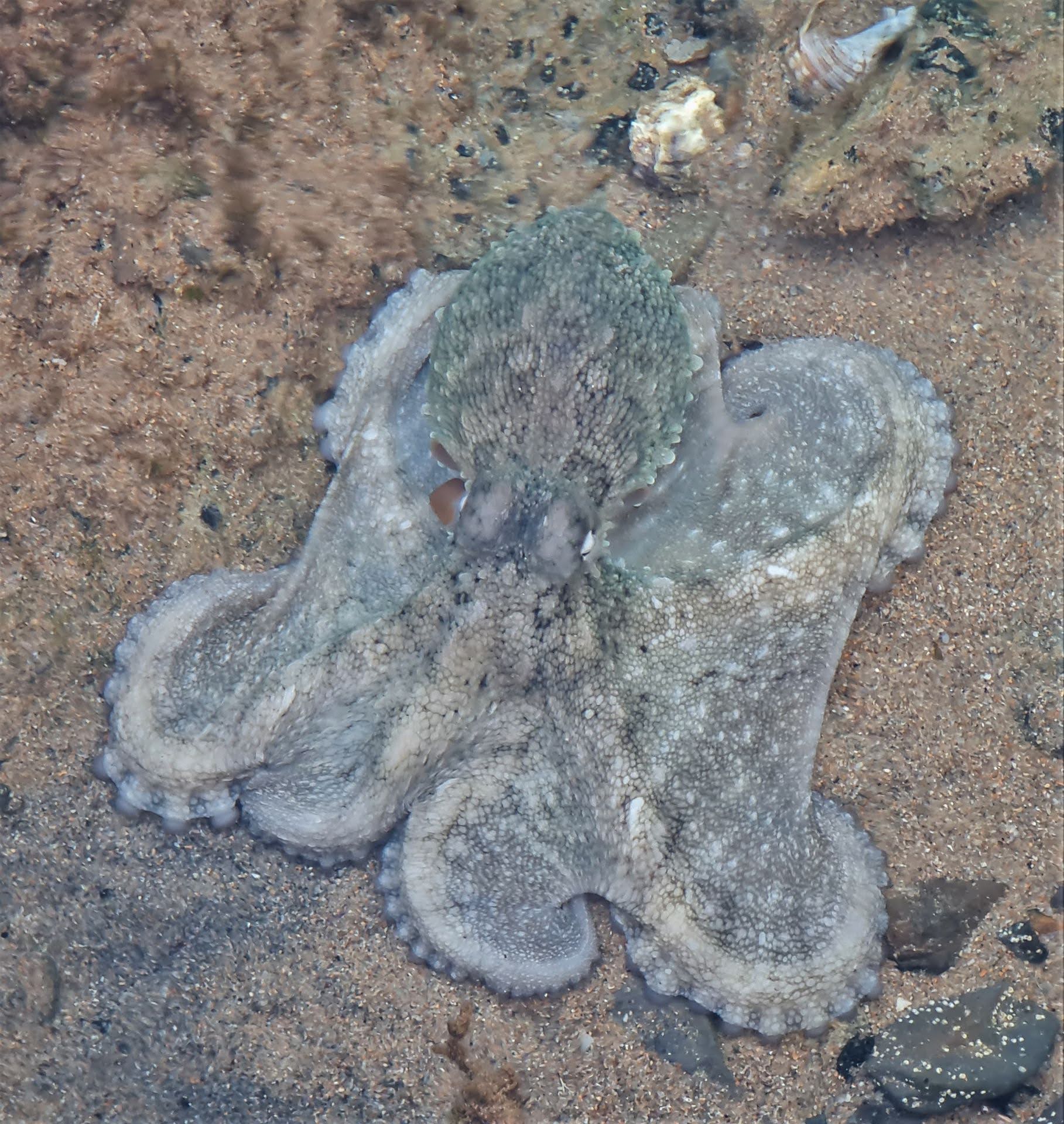
''I saw a smaller octopus nearby as well this week'':
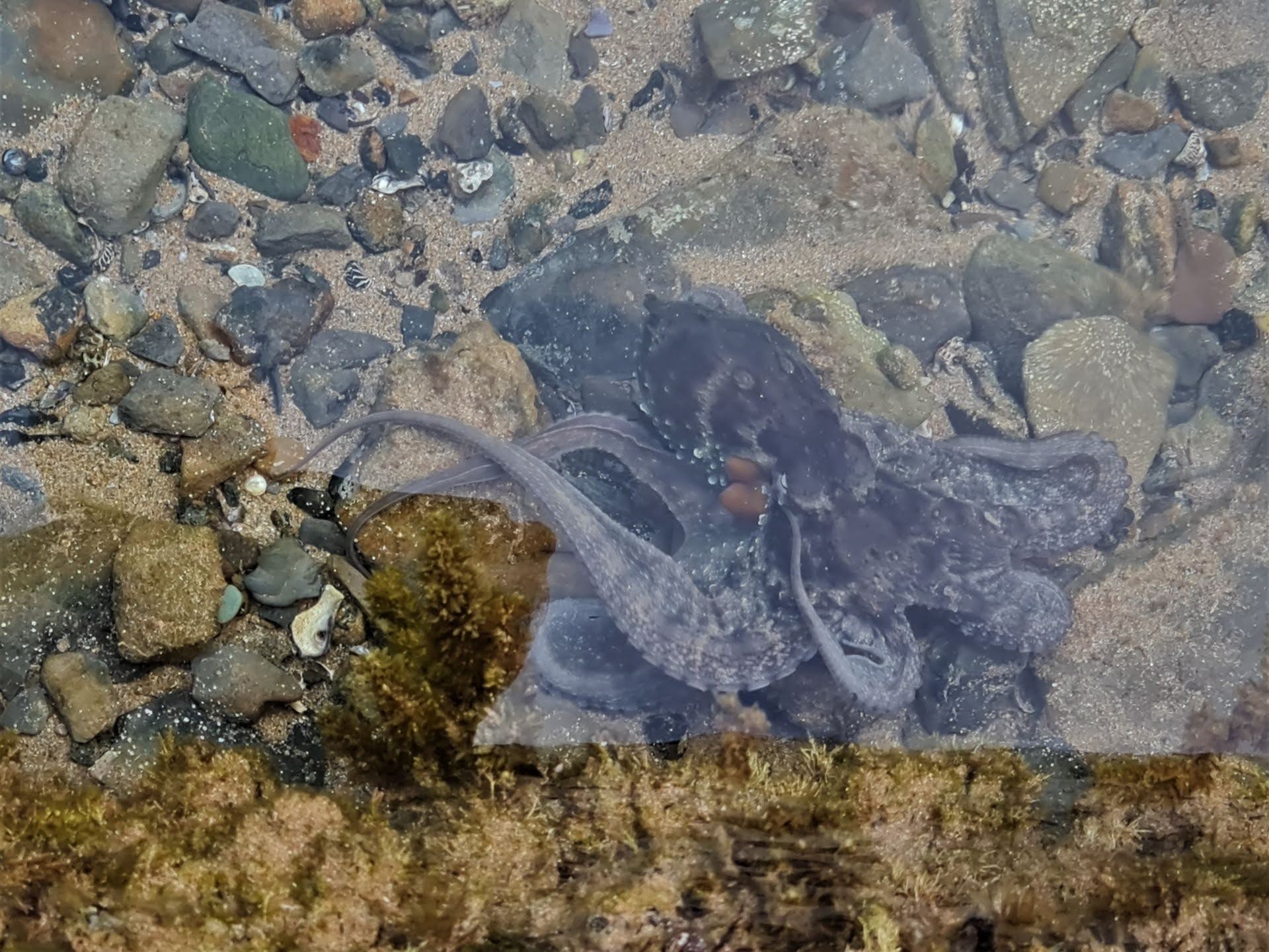
An interesting cloud sunrise from Narrabeen Rock Pool, with an interesting reflection. This was last Tuesday 13 Feb 2024. The corner of the pool is the disturbed water on the right, and the calmer water on the left is what I call the tidal flats. This area gets exposed at low tide, and where our resident octopus & other sea creatures live.
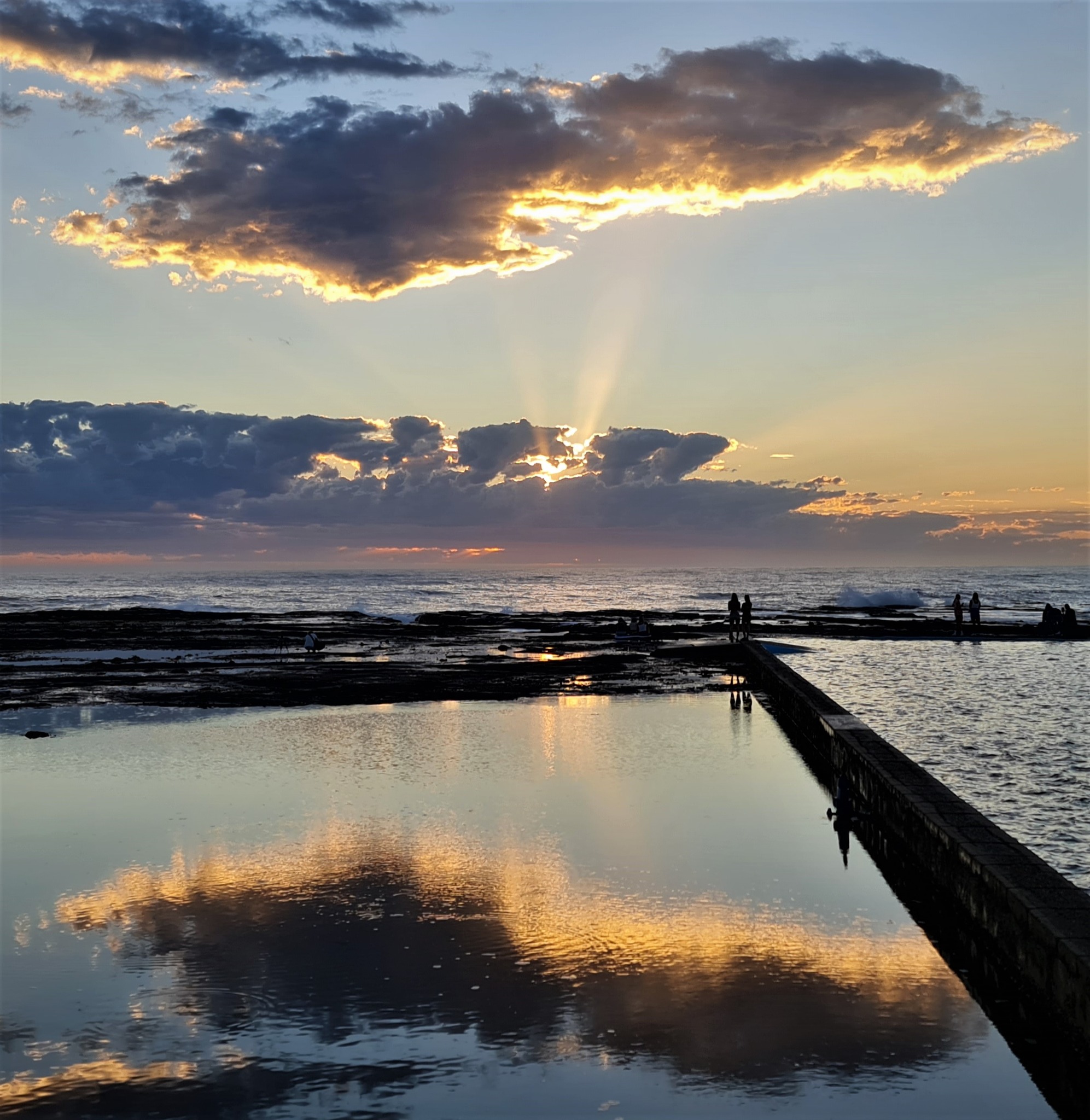
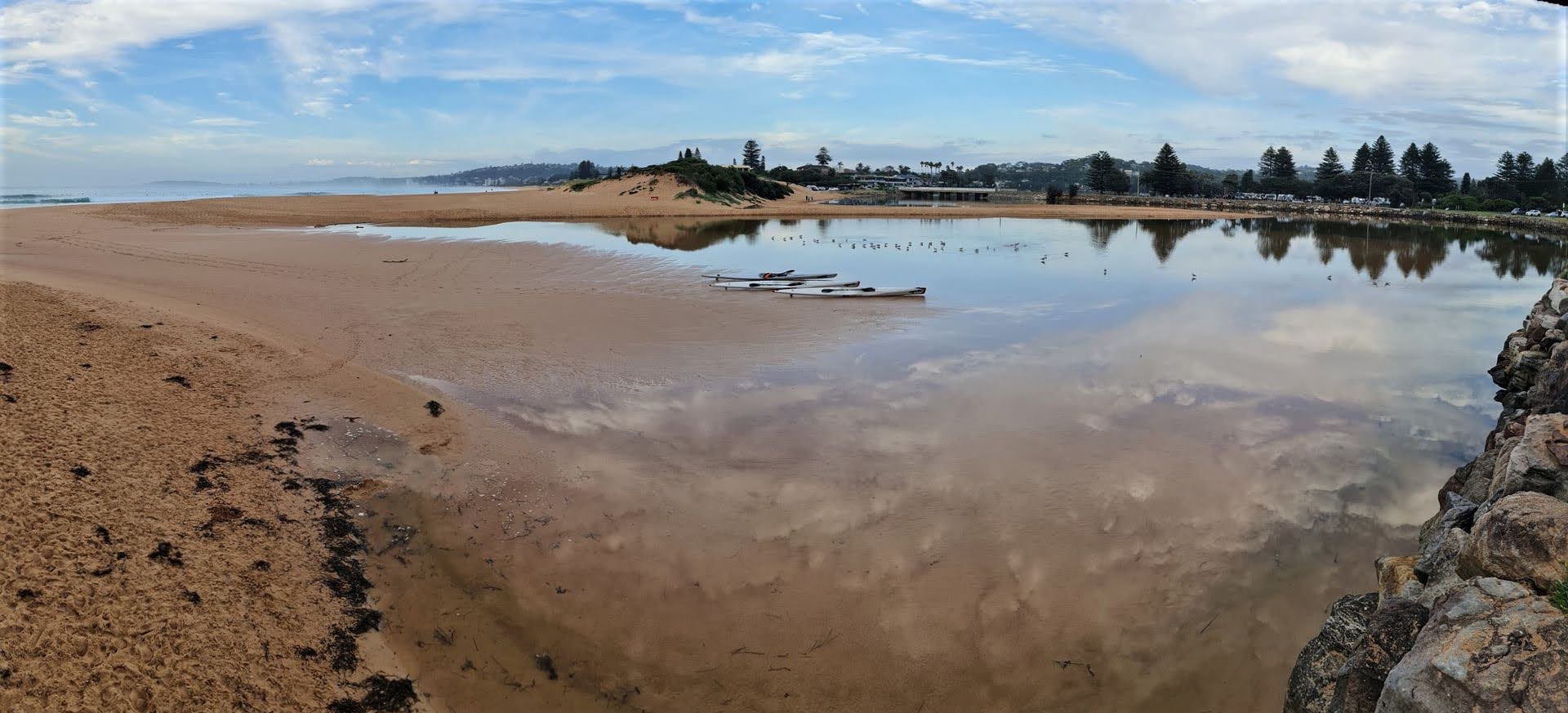
Royal Easter Show 2024
The Royal Easter Show opens this coming Friday, March 22nd, and runs through to April 2nd. Although some of you may be already dreaming about showbags, and we've run a bit on that in this week's PBP's page, there are also:
- Livestock Pavilions Daily: 9.00am—7.00pm
- Dog Pavilion Daily: 9.00am—5.00pm
- Gong cha Carnival Daily: 9.00am—9.30pm
- Farmyard Nursery Daily: 9.30am—6.30pm
- Heritage Pavilion Daily: 9.30am—6.30pm
There are also some great resources you can download to have a look into what you may see if you visit this year's Show. On a webpage set up by the people who put the Show together you can see and get a copy of:
- Colouring Book Preschool & K-2
- Home is Where the Farm Is Workbook 1-6
- Farm to Table Stage 2-3
- Career Stepping Stones 7-12
- Livestock Showing 9-10
Pretty cool - although we like all the contests and parade that happen in the Main Arena too - all those different kinds of horses and cows.
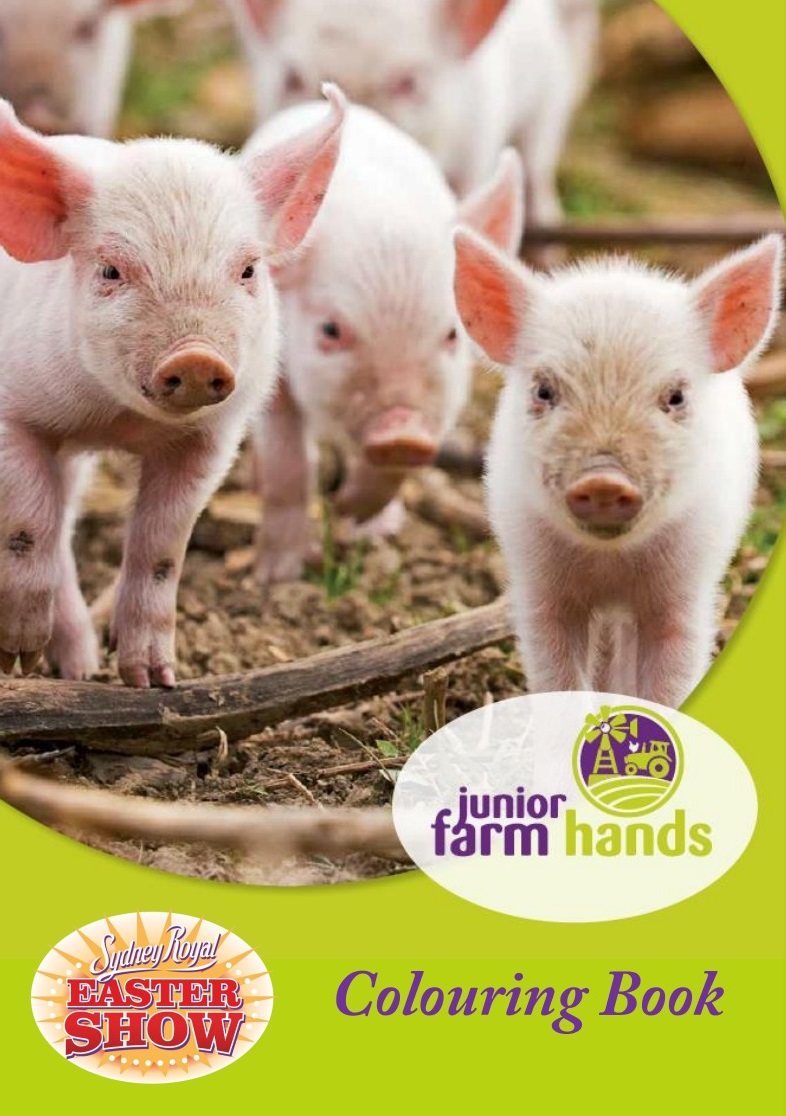
The origins of the Show date back to 1822, when the emphasis was on agriculture and food provision for the new colony. In the words of the early RAS Founders, they needed to band together, to help each other.
The aim was, just a mere 34 years years after Europeans began settling here (1788), to “improve the quality of Australia's primary production by means of contests and competitions”.
When Pittwater was all farms of every kind people from here would enter their produce and animals and win prizes. Mr. Roche, a Bayview gentleman, would win prizes for his fruit - he had some of the best citrus fruits - lemons and mandarins and others, in Sydney and the whole state. A lady, Marie Stiles, who used to live at Little Mackerel Beach, would win prizes for her excellent chickens.
Does that make you curious about what the meaning of the word 'show' is?
As a noun one of the meanings is 'a spectacle or display, typically an impressive one'.
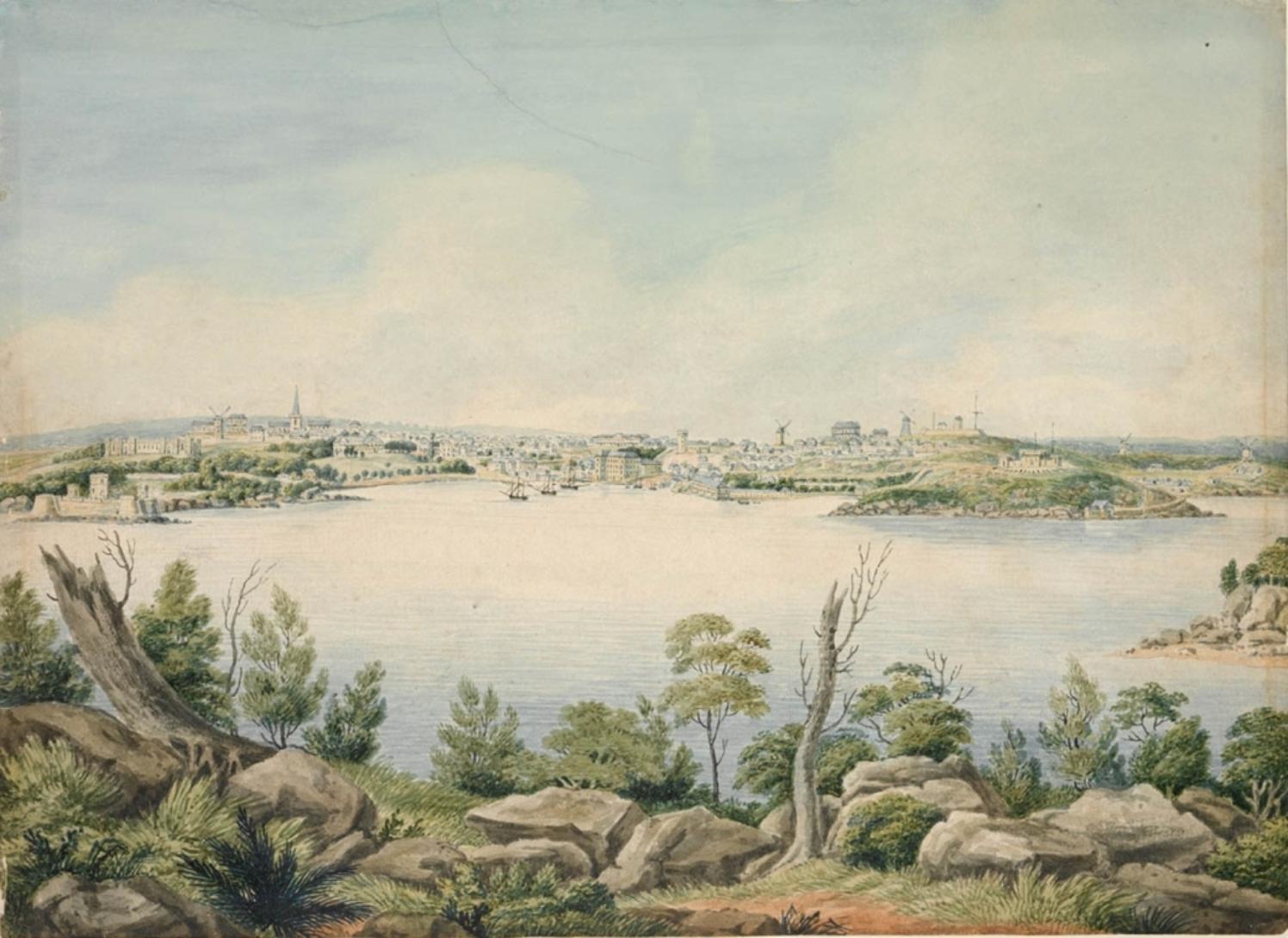
North View of Sydney New South Wales taken from the North Shore. 1822 by Joseph Lycett, ca. 1775-1828. Image No.: a928339, courtesy State Library of NSW
Home For NSW’s Rail History Opens In Sydney’s West: It's A Train Hospital Youngsters!
On Monday March 11 2024 the NSW State Government announced NSW Railway’s historic locomotives and carriages have found a new home in the heart of Western Sydney.
The $9.4 million Chullora Heritage Hub is a centralised storage facility for 50 of the state’s 220 heritage locomotives and carriages.
The historic trains have travelled by road and rail to the former Tank Annex Building at the Chullora Railway Workshops from three separate sites at Eveleigh, Thirlmere and Broadmeadow.
The building has received a thorough upgrade to ensure the protection and preservation of the historic collection with environmental, security and fire safety improvements delivered.
While the new location is not open for public viewing due to its function as a maintenance facility, it will give volunteers from Transport Heritage NSW the space they need to work on these one-of-a-kind engines.
The site at Chullora has been an important location for railway maintenance for more than a century. It was first established in 1913, and many of the buildings within the precinct date from the 1920s, with the Tank Annex building operating as part of the maintenance facility until 1994.
Among the rollingstock moving into the new building are:
- Locomotive 1219, this locomotive and its class dominated express and mail train services in the late 1800s, with many hauling branch line services right up until the 1950s.
- Locomotive 5096 was one of 280 introduced from 1890. This was the largest class of locomotives used anywhere in Australia and hauled goods trains more than two million kilometres until its retirement in 1965.
- Locomotive 2606 was one of 20 tank locomotives manufactured by Scottish company Dubs and Co. Introduced from early 1892, they were supposed to assist engines travel up the mountain from Penrith to Katoomba. Limited water tank capacity and problems negotiating the numerous curves hindered their work, so they were reassigned to hauling coal trains to Waterfall and Newcastle. Before its retirement in 1970, 2606 spent its later years shunting carriages into position at Central Station.
Another 70 locomotives and carriages will remain at the NSW Rail Museum in Thirlmere, including the famous 3801.
Locomotive 3801 was built in 1943 by Clyde Engineering and has been in preservation since its retirement from the NSW Railways in 1962. The locomotive was withdrawn from heritage service in 2007 for restoration and major boiler repairs. 3801 was officially relaunched at Sydney's Central Station on Friday 12 March 2021 by Her Excellency, the Honourable Margaret Beazley AC QC, Governor of NSW.
You can read more about the project HERE
The museum is open to the public 7 days a week, with heritage train rides operating every weekend on the newly refurbished Loop Line.
Might be worth a visit this coming Easter or Autumn school holidays.
All the historic trains are operated by Transport Heritage NSW. You can find out more by visiting the webpages at: Transport Heritage NSW. They even have Virtual Tours you can take of the trains - visit: www.thnsw.com.au/virtual-tours
NSW's Transport Minister, Jo Haylen, said:
“For the first time, the majority of our heritage rail collection will be sitting undercover and out of the elements, where they will be lovingly preserved by our dedicated volunteers.
“340 jobs were created in Western Sydney during the renovation of this historic building, which will now house our cherished railway past for the people of NSW to enjoy for generations to come.
“It’s vital we preserve our heritage fleet so the magic of being part of life on our railways isn't forgotten and continues to inspire.”
Jo Haylen also told us about this train, saying:
''This is engine 1219. This locomotive and its class dominated express and mail train services in the late 1800s, with many hauling branch line services right up until the 1950s.
Now inside the beautifully restored Tank Annex in Chullora, she's protected from the wind and rain, and ready for our hundreds of Transport Heritage volunteers to love and care for her.''
The Transport Minister also had a look around the new facility, a train hospital really, for fixing up these great old trains, and you could see some of the carriages and locomotives already there so they can be restored and spruced up and then get to the Rail Museum at Thirlmere so we can all visit them there.
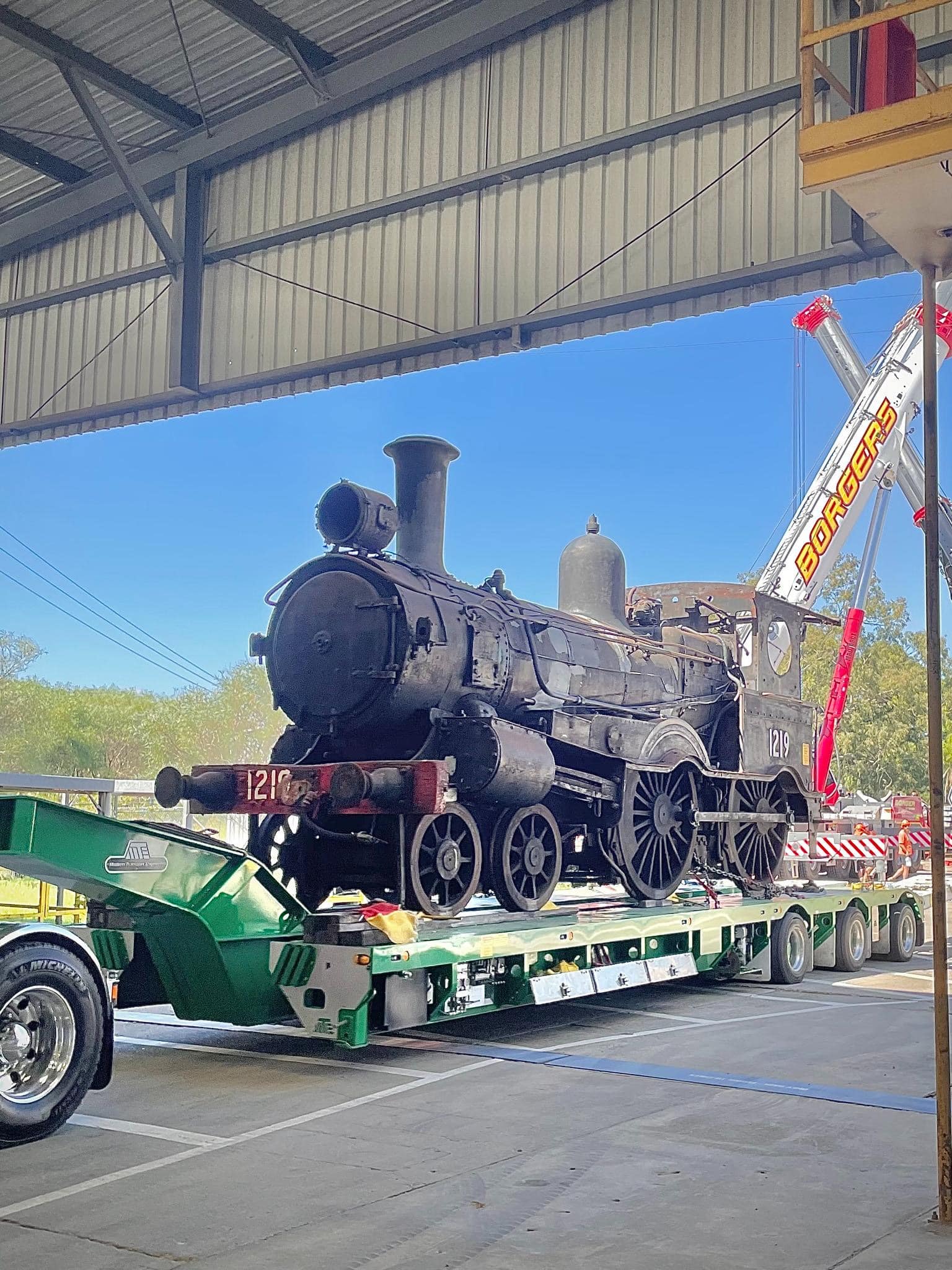
Chullora is a suburb out towards Canterbury-Bankstown and 15 kilometres west of the Sydney central area, or 'town', so not that far away, although it would take a bit of time to get there - even with a car or train!
Chullora is an industrial area with many factories and warehouses, including Tip Top Bakeries and the printing plants for Sydney newspapers and magazines.
The Chullora Railway Workshops and Electric Carriage Workshops previously serviced and repaired suburban and inter-urban trains, and the Chullora Bus Workshops serviced the bus fleet of the Urban Transit Authority and its predecessors from 1958 until 1989.
This is "The Big Bicycle" at the old Chullora Recycling Centre:
Congratulations!; RPAYC Placing At 2024 RNZYS Match Racing Cup
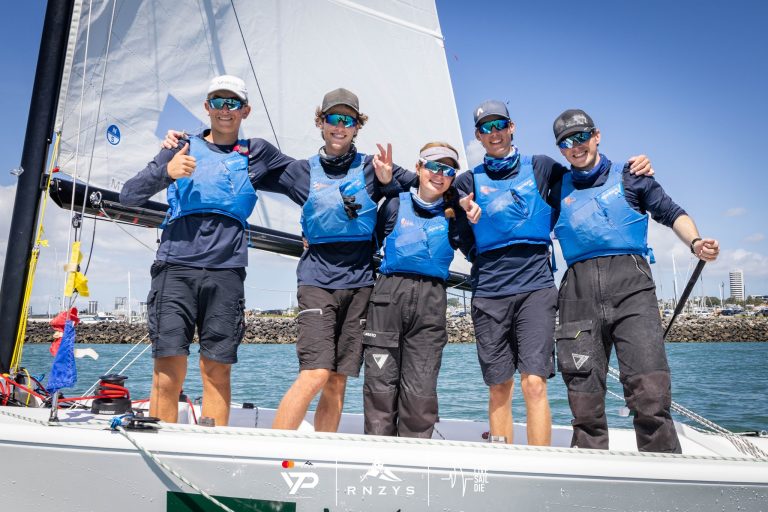



Local Australian Boardriders Battle Grand Finalists Looking Forward To Next Comps.
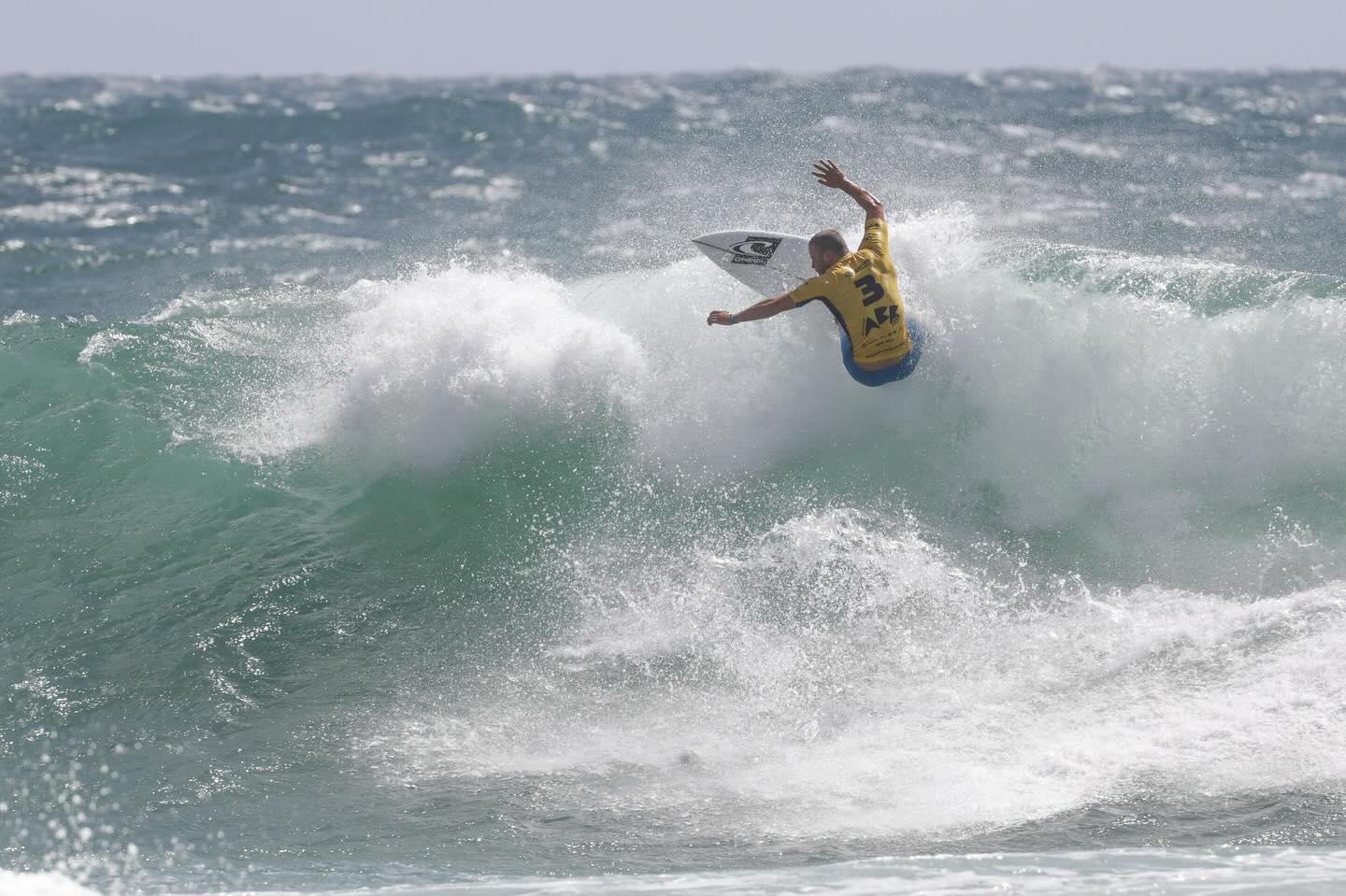

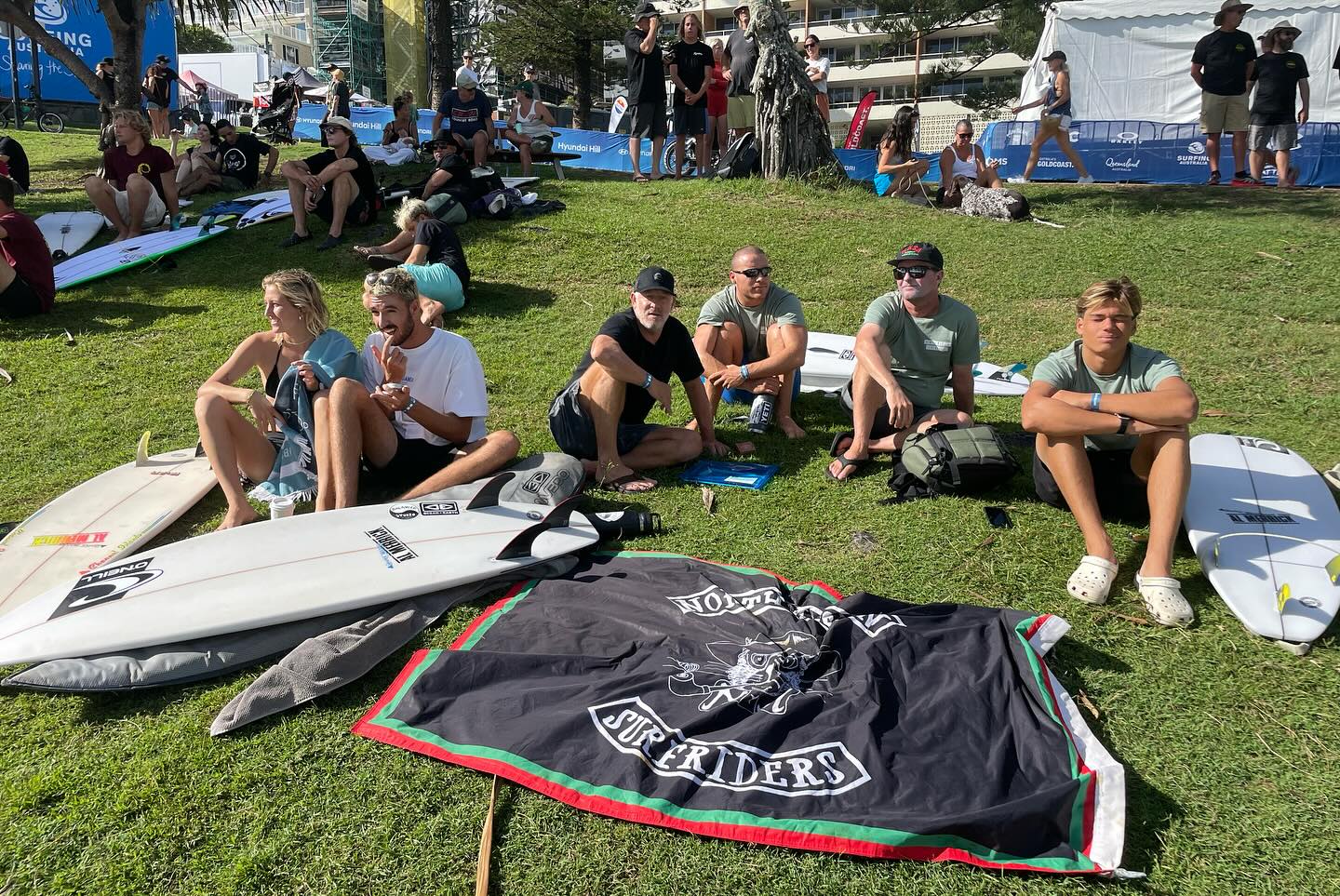

Local teams


The Royal Easter Show Began As The Royal Agricultural Society Of NSW

North View of Sydney New South Wales taken from the North Shore. 1822 by Joseph Lycett, ca. 1775-1828. Image No.: a928339, courtesy State Library of NSW
This is where what we call the Royal Easter Show really began as an idea conceived by our earliest farmers – the aim was, just a mere 34 years years after Europeans began settling here (1788), to “improve the quality of Australia's primary production by means of contests and competitions”.
There will be some who state the Royal Easter Show does not stem from these original 'shows' and everyone is entitled to think what they will. An article at the base of this page states any livestock 'shows' actually began a lot earlier in 1806. Our intention is merely to offer you an old fashioned 'pictorial' this week, reproduce these early articles so you may make up your own mind, and hopefully inspire you to wander through the Agricultural Pavilions or visit the main arena and wonder about the food on your plate and where it comes from.
What did they do? They held a meeting and made some decisions. If you read through the list of names of people at this first meeting you may recognize surnames and people now quite famous in our Australian history who have had whole districts and suburbs named for them:
1. Resolved,-That it is highly expedient for the best Interests of the Colony, that the present Meeting do form itself into a Society, to be denominated "The Agricultural Society of New South Wales"
2. That Sir JOHN JAMISON, Kt. & K. G. V. be appointed the President of this Society.
3. That the Honorable Mr. Justice FIELD, the Reverend Mr. MARSDEN, J. P. WILLIAM Cox, Esq. J. P. and Dr. TOWNSON, L. L. D. be appointed the Vice Presidents of this Society.
4. That G. T. PALMER, J. P. and ALEXANDER BERRY, Esquires, J. P. be the joint Secretaries of this Society.
5. That Messrs. RILEY and WALKER be the Treasurers of this Society.
6. That the following Gentlemen, jointly with the President and Vice-Presidents, be appointed the Committee, for conducting the Affairs of this Society, seven of whom shall form a Quorum :-
{ J. T. CAMPBELL, Esquire, J. P;
{JOHN PIPER, Esquire, J. P;
Sydney;
{EDWARD WOLLSTONECRAFT, Esquire, J. P;
{NICHOLAS BAYLY, Esquire.
{JOHN PALMER, Esquire, J. P;
{JOHN BLAXLAND, Esquire, JP;
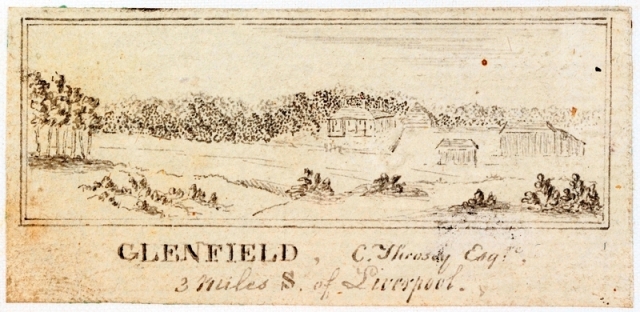 Parramatta;
Parramatta;{H. G. DOUGLASS, Esquire, J. P;
{Reverend T. HASSALL.
{WILLIAM HOWE, Esquire, J. P;
{ROBERT LOWE, Esquire, J. P ;
{JOHN OXLEY, Esquire, J. P ;
{CHARLES THROSBY, Esquire, J. P;
{THOMAS MOORE, Esquire, J. P;
{RICHARD BROOKS, Esquire, J. P ;
Airds;
{Captain BRABYN, J.P;
{ JOHN HARRIS, Esquire, J. P ;
Bringelly;
{ARCHIBALD BELL, Esquire, J. P
{H. C. ANTILL, Esquire, J. P ;
& Windsor;
{ JOHN McHENRY, Esquire, J. P ;
{WILLIAM LAWSON, Esquire, J. P;
{JOHN WOOD, Esquire;
{ANDREW ALLAN, Esquire ;
{JOHN HORSLEY, Esquire ;
{JOHN CAMPBELL, Esquire;
{GEORGE COX, Esquire.
Correspondent Members of Committee at Newcastle,
Reverend Mr. MIDDLETON;J. P. WEBBER, Esquire ; WILLIAM DUNN, Esquire; EDWARD CLOSE, Esquire.
Resolved,-That the President, Vice-presidents, and Secretaries, be requested to wait upon His EXCELLENCY the GOVERNOR, to solicit his Acceptance of the Office of Patron to this Society ; and to FREDERICK GOULBURN, Esquire, to accept the Vice Patronage thereof.
Resolved,-That the Committee do meet at the House of Charles Walker, at Parramatta, on Tuesday the 16th Instant, at Ten, A. M. for the Purpose of preparing a Series of Rules and Regulations for the Government of the Society.
Resolved,-That an Annual Subscription of Five Guineas be paid by each Member into the Hands of the Treasurers, for the general Purposes of the Association.
Resolved,-That many Members of the Society, having expressed their Intention of forming a Subscription Fund, in Shares of £25 each, for the Purpose of introducing from the Mother Country, and elsewhere, a more important Breed of Cattle, Horses, Sheep, &c ; that such other Members, as may desire to participate in the Advantages expected to accrue from those Importations, will communicate the same to the Secretaries at an early Day.
Resolved,-That it be particularly requested, that such Gentlemen as have been unable to attend the present Meeting, should they desire to become Members of the Society, will express their Intention, by Letter, to the Secretaries, or to the Committee at their next Meeting.
Resolved,-That the Proceedings of the present Meeting be inserted in the next, and three subsequent Sydney Gazettes.
The Thanks of the Meeting were unanimously voted to Sir John Jamison, for his Attention and Abilities as Chairman on this Occasion.
The Thanks of the Meeting were also unanimously voted to E. Wollstonecraft, Esq. for his able Assistance in forwarding the present Association.
JOHN JAMISON, President.
AGRICULTURAL SOCIETY OF NEW SOUTH WALES. (1822, August 2). The Sydney Gazette and New South Wales Advertiser (NSW : 1803 - 1842), p. 2. Retrieved from http://nla.gov.au/nla.news-article2181211
The second meeting, as given above, took place at Walker's Inn, Parramatta. The Society staged its first show in Parramatta in 1823.
AGRICULTURAL SOCIETY. THE AGRICULTURAL SOCIETY OF NEW SOUTH WALES hereby offer the following. PREMIUMS; to be adjudged at their Quarterly Meeting, in the first Thursday in October next; viz.
1. 2.-For the best Australian Merino two-toothed Rams and Ewes, not less than five of each description-A Piece of Plate, value 40 Dollars, for each description.
3.-For the best Australian Merino Ewe Limbs, not less than ten in number-A Piece of Plate, value40 Dollars.
4, 5.-For the second best Australian Merino two toothed Rams and Ewes, not less than five of each description-A Piece of Plate, value 20 dollars, for each description.
6.-For the second best Australian Merino Lambs, not less than ten in number-A Piece of Plate, value 50 Dollars.
7. 8.-For the third best Australian Merino two toothed Rams and Ewes, not less than five of each description-A Piece of Plate, value 12 Dollars, for each description.
9. For the third best Australian Merino Ewe Lambs, not less than ten in number- A piece of Plate, value 12 Dollars.
10.,-For the best Colonial-bred Bull, not more than three years old-A Piece of Plate, value 40 Dollars.11.-For the second best Colonial-bred Bull, not more than three years old-A Piece of Plate, value 20
Dollars.
12.-Tor the best two-year old Heifer, Colonial-bred- A Piece of Plate, value 20 Dollars. 13.-For the best Colonial-bred Stallion, not exceeding three years old-A Piece of Plate, value 16 Dollars.
SERVANTS.
1.-To the Shepherd, who produces from his Master a Certificate, on Oath before a Magistrate, of his having "weaned the greatest Number of Lambs, in Proportion to the Number of Ewes in his Charge, for the Year, not having less than 300 Ewes in his- Flock-A Premium of 32 Dollars.
2.-To the Shepherd, who produces a like Certificate, of having weaned the next greatest Number of Lambs-A Premium of 16 Dollars.
3.-To the Man-Servant, employed in Husbandry or , Grazing, or the Management of the Dairy, who brings satisfactory Certificates of good Conduct during his Servitude, and has been the-longest Period in one Service-not less than seven years A Premium of 20 Dollars.
4.-To the Man-Servant, employed as above, who may produce the second best Certificate to the same Effect-A Premium of 12 Dollars.
5.-To the Man-Servant, employed as above, who who may produce the third best Certificate to the same Effect-A Premium of 8 Dollars.
Parramatta, April 11, 1823.
G. T. PALMER }secretaries
ALEX. BERRY, }
Classified Advertising. (1823, April 24). The Sydney Gazette and New South Wales Advertiser (NSW : 1803 - 1842), p. 4. Retrieved from http://nla.gov.au/nla.news-article2181822
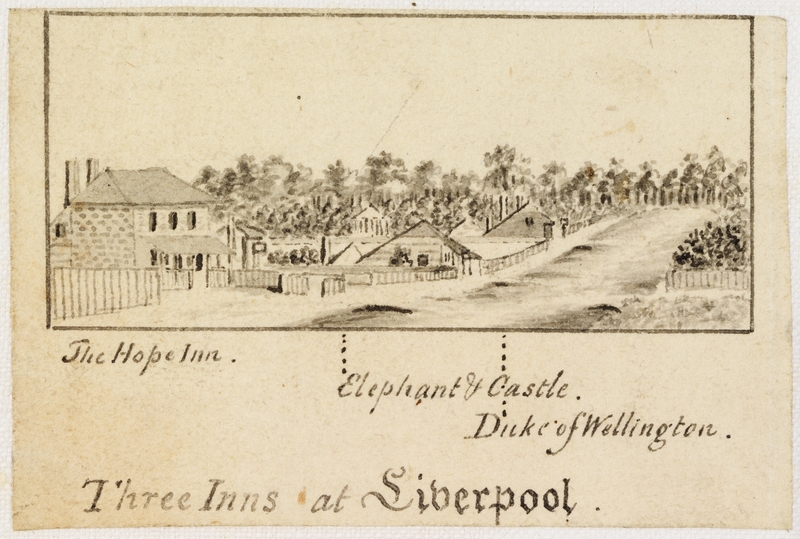
The half-yearly Fair at Parramatta, on Thursday last, was well attended with visitors. The show of cattle was far inferior to former season, but there were some good woolled rams, as well as other stock. There were very few buyers.
On Thursday last, a very numerous Meeting of the Agricultural Society assembled at Parramatta. It being the day of the public fair, the Society's prize cattle and sheep were exhibited, and the premiums adjudged. So many meritorious horses were shewn, that a second prize was voted. The first was awarded to Mr. Samuel Terry (though not a Member of the Society), and the second to Captain Piper, for their respective three-year old stallions; but Mr. H. McArthur's two-year old colt Canon, seemed to he the public favorite. They were all three got by Model, and the two prize horses were bred by the late Mr. Bayly. Mr. H. McArthur obtained the prize for the best rams; Mr. Howe for the best ewes; and Mr. Oxley for the best lambs. The judges of the stock were, Mr. Cox, Mr. J. Campbell, and Mr.
G. T. Palmer.
The servants' rewards were adjudged as follow:— To Maurice Roche, shepherd to Mr. Oxley, for having weaned 297 lambs from a flock of 316 ewes—thirty two dollars. To Henry Ashford, shepherd to Rev. S. Marsden, for good conduct during a service of 16 years— twenty dollars. To William Bull, servant to James Davison, for good conduct, during a service of 11 years— twelve dollars. And to Walter McTaggart, servant to Hugh Kelly, for good conduct during a service of 8 years—eight dollars. The men were called before the
Meeting, and immediately presented with the money by the President.
In short, in the present depressed state of agriculture, the public spirit for breeding and grazing appeared this day to be practically influenced by the encouragement and example of the Agricultural Society.
At this Meeting, Mr. Wollstonecraft presented the Society with a Model, and read an explanation, of General Beatson's Cultivator; and the Building Committee laid before them a very pretty plan and elevation of the Society's intended house in Parramatta. His EXCELLENCY the PATRON communicated a handsome letter from Lord Bathurst, in answer to the Society's Petition for the Repeal of the Wool-duty. This Body now consists of 112 Members; and 11 new names were this day proposed.—Five and forty Gentlemen sat down in the evening to dinner at Walker's Inn; after which, among other loyal and appropriate toasts, the health of Mr. Buxton, who has accepted the office of Parliamentary Protector of the Society, was drank with 3-times-3.Captain Piper kindly brought his Band, and the night was spent in social harmony. Thus concluded perhaps the most useful and interesting Meeting the Society has yet held. MAGISTRATE FOR THE ENSUING WEEK, ALEXANDER BERRY, ESQUIRE. (1823, October 9). The Sydney Gazette and New South Wales Advertiser (NSW : 1803 - 1842), p. 2. Retrieved from http://nla.gov.au/nla.news-article2182286
Despite its initial success the Society was forced to disband in 1836 due to poor economic conditions and lack of support. In 1857 it reformed. From 1868, the Journal of the Agricultural Society of NSW was published, the first of its kind in Australia, containing practical information and latest agricultural developments for those on the land.
The annual Shows moved from Parramatta to Sydney’s Prince Alfred Park after 1868, and then to a new site at Moore Park in 1882. Little more than scrubland at the time, it was here that the Society built a showground which would be home to the Show for the next 116 years. The 1919 Bubonic Plague and World War II prevented the Show going ahead during those times - the showgrounds actually being put to use for war work during WWII. The Society was renamed the ‘Royal’ Agricultural Society of NSW in 1891, by special permission of Queen Victoria, and the first 'Royal' Easter Show was held the same year.
The Show’s competitive displays showcased the best animals and rural produce – from prize-winning cattle, sheep and pigs to fruit and vegetables exhibits, as well as displays of wood chopping, show jumping, and even ploughing demonstrations, as they do today. These annual 'shows' were also an opportunity for the exchange of ideas and practices, an opportunity for farmers to gain first-hand knowledge of farming trends and technological advances.
By the mid 1930s, as the grip of the Depression in Australia began to lift, the Show’s attendance figures increased and there was a growing optimism in Australia’s agricultural future. The 1935 Royal Easter Show was the biggest to date, with the largest attendances, prize-money and competitive entries.
You may access more about the Royal Easter Show and it’s early years in an online exhibition the State Library of NSW has at: www.sl.nsw.gov.au/discover_collections/history_nation/agriculture/communities/royal_agricultural_society/.
Perhaps seeing these images will encourage you to explore the great online images available at our State Library if you get a rainy day these holidays and see not only beautiful and interesting pictures and photos but find out a bit more about them and your own history.
Photography of course did not exist then, although people were trying out the techniques as early as 1800. People of these times made sketches and drawings and did landscape paintings, portraits were painted of people, not photographs taken. One of the early sketchers of farms and homes in New South Wales was Edward Mason and the sketches, some of which are shared below, are attributed to him and come from NSW State Library albums titled “Views of Sydney and Surrounding District” ca. 1821-1823; 1892. The coloured paintings are from Collection of views predominantly of Sydney, Liverpool, and the Sunda Straits, and portraits, ca 1807, 1829-1847, 1887] / owned by A.W.F. Fuller and the ones we've chosen are by Joseph Lycett.
It is from these collections that we can see what the farms and lands around the above mentioned gentlemen were like. You will see at the bottom of some sketches ‘so many miles from’ – this means so many miles from Sydney.
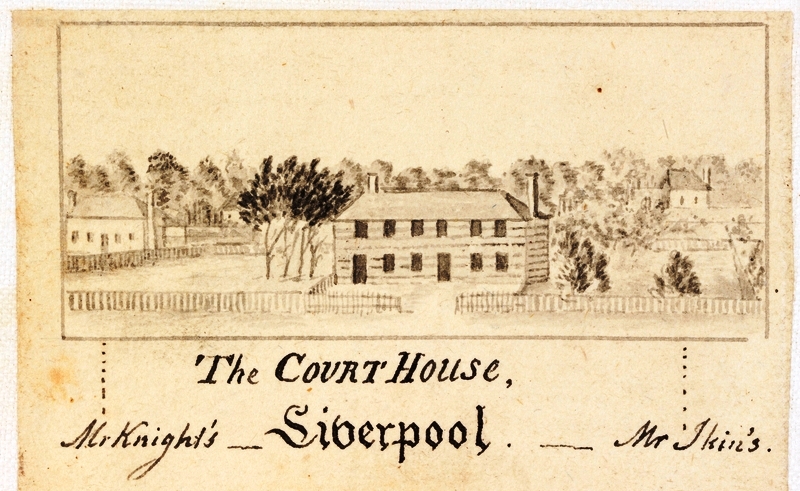
The State Library of NSW has a great source of online materials you may access so you can see a wealth of all things Australian. The National Library of Australia also stores many images and texts you may access online. We found a few there too.
The Biographies included as smaller extracts stem mostly from another great online resource The Australian Dictionary of Biography, although some researchers, and even members of the families whose relatives are listed, have told us there are inaccuracies in these texts, possibly due to literature that was not available when they were originally created. This great resource may be accessed at: http://adb.anu.edu.au/ and will be invaluable should you want to investigate those we haven't listed something about on this page.
We hope sharing a little of these images and some information about a few of these initiators of what we now call the Royal Easter Show will inspire you to have a look at the Agriculture Displays should you go to the show this year and wonder about more about where your milk, eggs, fruit and vegetables all come from.
In what is said about these early promoters of agricultural industry in New South Wales it is important to remember when reading about their lives that some came from padded salons and green fields to what, to them, was a virtual wilderness with no roads and they had little or no knowledge of the abundance of foods already here while others were simply determined to make better opportunities for themselves. They all had a willingness to undertake a big adventure.
When you look at these images and read about these people bear in mind that they had to grow the wheat, then mill it, then make bread. If they wanted to spread some butter on their slice, they had to buy and house and feed a cow - then milk it, then churn it into butter. Jam for your bread? - plant the fruit, tend it so it grows, pick it in season and turn it into jam - now you may have a jam sandwich!
Of the purported sketcher, Edward Mason, there is little recorded. It is now thought (2006) the drawings are not copies and possibly(?) the work of Edward Mason, clerk to magistrates, Liverpool; merchant and landholder. Reference: Colonial Secretary Index, 1788-1825, State Records NSW, although some sources state the Edward Mason who compiled these sketches did not come to Australia until 1853 and these must be copies of earlier drawings.
What we could find around the same time of a gentleman of the same name (investigations can often bring up as many questions as answers!):
THE LATE MR. EDWARD MASON. GENTLEMAN.
(FROM A CORRESPONDENT.)
Such a misrepresentation of the circumstances relative to the premature death of the late unfortunate Gentleman, Mr. EDWARD MASON, as might tend to darken his urn, has appeared in one of the public Newspapers. As an intimate acquaintance of the deceased, from the period of his first arriving in the Colony, I should not do justice either to his memory, or the family to which he was allied, were I not to confer this small tribute on his high talents and acquirements; which, though long shaded, and almost obscured, are now set in oblivion. He was interred yesterday, the 14th, from this lodgings, in Hunter-street, Sydney.
Mr. Mason had attained the climacteric of human life, being about 56. He descended from a family of high respectability, now in England. His classical and accomplished education was well displayed in that prodigy of genius he possessed, and he had, for a series of years, formed a close intimacy with characters of the first literary fame in England; but the accession of less favorable vicissitude, to which human nature is ever liable, doubtless operated so power-fully and variously on his mind, during his latter years, as ultimately to extinguish the radiance of his evening sun; yet, to the last few days, those who had the pleasure of access to him, with refined corresponding views, the intervals were such as will tender his loss to be, to them, a source of lasting regret. To such only were his qualifications and his virtues known; and though, at the last, none were ready by him, to " Wipe the cold dew, or stay the sinking head-' to avert the shaft of reproach on his memory-“ "Let him that is without a fault cast the first stone.” Sydney, 15th Sept. 1828. UMBROSUS. THE LATE MR. EDWARD MASON[?] GENT[?]. (1828, September 17). The Sydney Gazette and New South Wales Advertiser (NSW : 1803 - 1842), p. 2. Retrieved from http://nla.gov.au/nla.news-article2191060
From State Records of New South Wales - Colonial Secretary Index, 1788-1825 - Liverpool, Magistrates (Apr 1822) to Lloyd, B:
1822 Apr 15 Edward Mason wanting to know "how far the Governor's Order 'recalling the servants allowed to overseer with a substitution of salary'" applied to his situation (Reel 6054; 4/1757 p.152)
Of the artist Joseph Lycett there is a little more. You can read about him in The Lycett Album - National Library of Australia 1990 HERE (PDF 5.5MB) or this extract from Wikipedia states his was transported for forgery and spent only seven years in the colony:
Joseph Lycett (c.1774 – c.1825) was a portrait and miniature painter, active in Australia. He specialised in topographical views of the major towns of Australia, and some of its more dramatic landscapes. He was convicted of forgery on 10 August 1811 and was transported to Australia, sailing aboard the General Hewitt, arriving in 1814. In May 1815 while Lycett was employed in the police office, Sydney was flooded by hundreds of skillfully forged 5 shilling bills drawn on the postmaster. They were traced to Lycett, who was found in possession of a small copper-plate press. Lycett was sent to Newcastle, where he came to the attention of the commandant of the settlement, Captain James Wallis. There Joseph drew up the plans for a church which Wallis projected and, when it was built in 1818, he painted the altar piece and is said to have also produced the three-light window which still survives in the bishop's vestry of Newcastle Cathedral. On the recommendation of Captain Wallis, Lycett was given a conditional pardon. He returned to Sydney and was allowed to practice his art, and in 1820 Governor Macquarie sent three of his paintings including a large view of Sydney to Earl Bathurst. It is generally believed that the absolute pardon which the Lycett received on 28 November 1821 was a reward for these. Many of his patrons seem to have been drawn from the military and public service elite, and included Commissioner John Thomas Bigge (who described Lycett's 'habits of intoxication' were 'fixed and incurable'), his secretary Thomas Hobbes Scott, and Macquarie's aide-de-camp John Watts. Lycett had possibly married in the colony, for in June 1822 he advertised that he intended to leave accompanied by his two daughters. They sailed together in the Shipley in September. Although his later publication Views in Australia suggests Lycett also visited Tasmania, there is no evidence of his actually travelling there.
He returned to England in September 1822, having been granted an absolute pardon. With publisher John Souter, between July 1824 and June 1825 he issued Views in Australia, or New South Wales and Van Diemens Land in 12 parts published monthly, each with two aquatint views of New South Wales and two of Van Diemen's Land, with descriptive letterpress, and a supplement with maps of both colonies. By permission the series was dedicated to Bathurst. The parts began to appear in July 1824 at 7s. plain and 10s. 6d. coloured. With its complicated publishing history, the extent of Lycett's involvement in the entire production is unclear, and it does seem that the book was not successful. These views were reissued in a volume in 1825. The 50 plates are coloured in some copies and plain in others. Joseph Lycett. (2014, March 18). In Wikipedia, The Free Encyclopaedia.
You can see more of his works in both the State Library of NSW and the National Library of Australia online resources.
And before the glorious pictures, the piece we found that points to 1806 as the first 'show' of an agricultural kind:
Royal Agricultural Society of N.S.W. FIRST SHOW HELD IN 1806 (By Frank McCaffrey.)
To get to the beginning of our agricultural shows in New South Wales we have to go back to 1806 when the first cattle show was held at Parrarnatta on Sunday, 13th July of that year. Those present included Governor King, Major George Johnston, Rev. Samuel Marsden, together with the owners of 3000 head of cattle. As this show was not held under strict Sabbatarian rules a little trading in flock was indulged in, but to display their charitable hearts a present of seventeen cows was given to the Female Orphan Institution of Parrarnatta. This institution, according to Major Moodie, gave us the mothers of many of the leading families of Australia. (Mr. Moodie's book is in. the Mitchell Library. F.McC.)
Those meetings were generally termed "mustres," and doubtless led to the formation of the Royal Agricultural Society of N.S.W. in 1821, of which we have read much in the press during the early part of the year 1822, owing to the great effort put forth to prove that the present R.A.S. is a continuation of the show established in Parrarnatta in 1821.
If the present R.A. Society can be connected in a continuous line from the year 1855 I do think it is as far back as it can be honestly traced. A move was made to establish the metropolitan show in Prince Alfred Park in 1868, and a show on a large scale was held there in 1870, and a few years later it was established in Moore Park. The title of Royal A.S. came into use in 1891.
When I began to compile the "First Century a Dairying in N.S.W.," which was published in 1906, a friend of mine sent me a sheet of paper, the writing on which was, my friend said, "that of the late Mr. Alexander Berry, M.L.C." It contained a list of subscribers to a stock fund to import stock for stud purposes from England. The following is a list of the subscribers to the stock fund-1823: -
James Atkinson. Esq £25 Alexander Berry. Esq 50 John Blaxland. Esq 25 Richard Brooks, Esq 25 John T. Campbell, Esq 25James Chandler, Esq 50William Cox. Senr., Esq 25 William Cox. junr.. Esq 25 Robert Crawford. Esq .. 25 Prosper de Mestre, Esq 25 John Dixon, Esq 25 Major Goulburn ..100 William Howe, Esq 25 Sir John Jamison ....100 Captain King, R.N 25 William Lawson, Esq 25 Robert Lowe. Esq 25 Hannibal Macarthur, Esq. .... 25Thomas McVitie. Esq 25 Rev. Samuel Marsden ... 25 William H. Morris, Esq. -.... 25 James Norton, Esq 25 Nathaniel Norton, Esq 25 John Oxley, Esq. 25 John Palmer, Esq 25 George T. Palmer, Esq 25 John Piper, Esq 25 Edward Riley, Esq 25 Charles Throsby, Esq 25 Dr. Robert Townson, LL.D. .... 25 William Walker, Esq. .. ..... 50 Thomas Walker, Esq. 25D'Arcy Wentworth, Esq 25Major West : - 25Edward Wolstoncraft, Esq. ... 50
Allan Cunningham, Esq., Corresponding Secretary. Royal Agricultural Society of N.S.W. (1926, March 26). The Land(Sydney, NSW : 1911 - 1954), p. 2 Supplement: Supplement to "THE LAND.". Retrieved from http://nla.gov.au/nla.news-article116262665
* The Agricultural Society of NSW did hold a 3 day show, with prizes, at Prince Alfred Park as part of the Inter-Colonial Exhibition in 1869 - another instance of many minds making up their ways differently or these gentlemen being unable to access reports that detail these events when this article was first written:
AGRICULTURAL SOCIETY'S PRIZE FOR CHEAP SUGAR MACHINERY. SIR,-You have doubtless ere this examined the Schedule of Prizes advertised by the Agricultural Society of New South Wales, for competition at the Intercolonial Exhibition to take place in Prince Alfred Park, Sydney, on 31st March and two following two days... I. am, Sir, Yours, &c., O. O. DANGAR, Kempsey, November 10th. AGRICULTURAL SOCIETY'S PRIZE FOR CHEAP SUGAR MACHINERY. (1868, December 1). Clarence and Richmond Examiner and New England Advertiser (Grafton, NSW : 1859 - 1889), p. 4. Retrieved from http://nla.gov.au/nla.news-article61889671
It was moved and carried,-"That the schedule of prizes for the Metropolitan Intercolonial Exhibition, to be held in the Prince Alfred Park, Sydney, on the 31st of March, 1st and 2nd of April, 1869, now read, be adopted.-1st, wool: live stock-2nd, cattle; 3rd, horses ; 4th, sheep; 5th, pigs; 6th, poultry ; 7th, dogs : 8th, wine ; 9th, farm produce; 10th, fruits, vegetables, and flowers ; 11th, manures ; 12th, sugars; 13th, agricultural implements ; 14th, manufactured articles; 15th, works of art; 16th, field trials of agricultural implements. AGRICULTURAL SOCIETY OF NEW SOUTH WALES. (1868, October 9). The Sydney Morning Herald (NSW : 1842 - 1954), p. 2. Retrieved from http://nla.gov.au/nla.news-article13173949
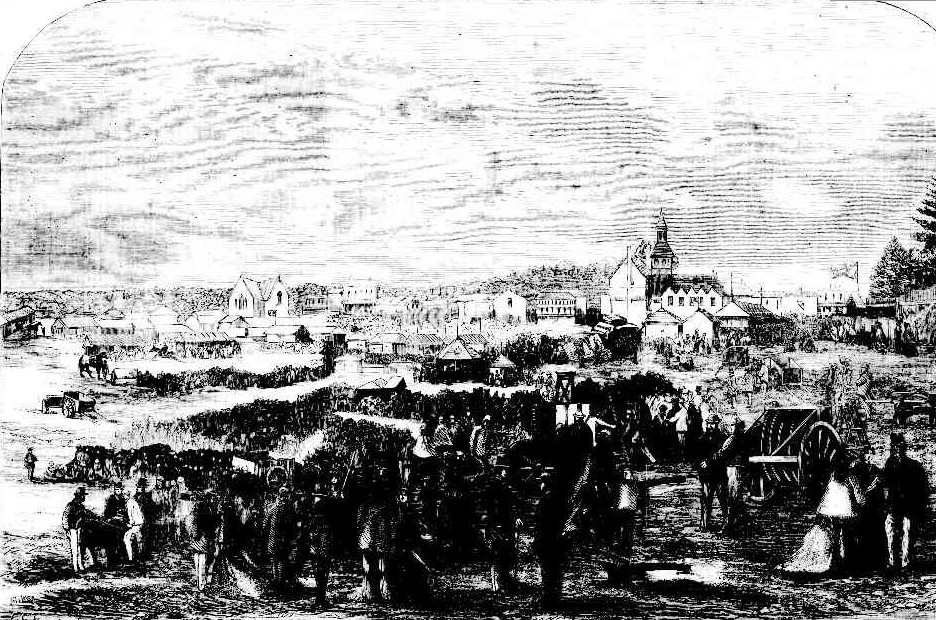
VIEW OF THE METROPOLITAN INTERCOLONIAL EXHIBITION HELD IN PRINCE ALFRED PARK, SYDNEY, OPENED ON MAY 4TH. (1869, May 13). Illustrated Sydney News (NSW : 1853 - 1872), p. 13. Retrieved from http://nla.gov.au/nla.news-article63514513
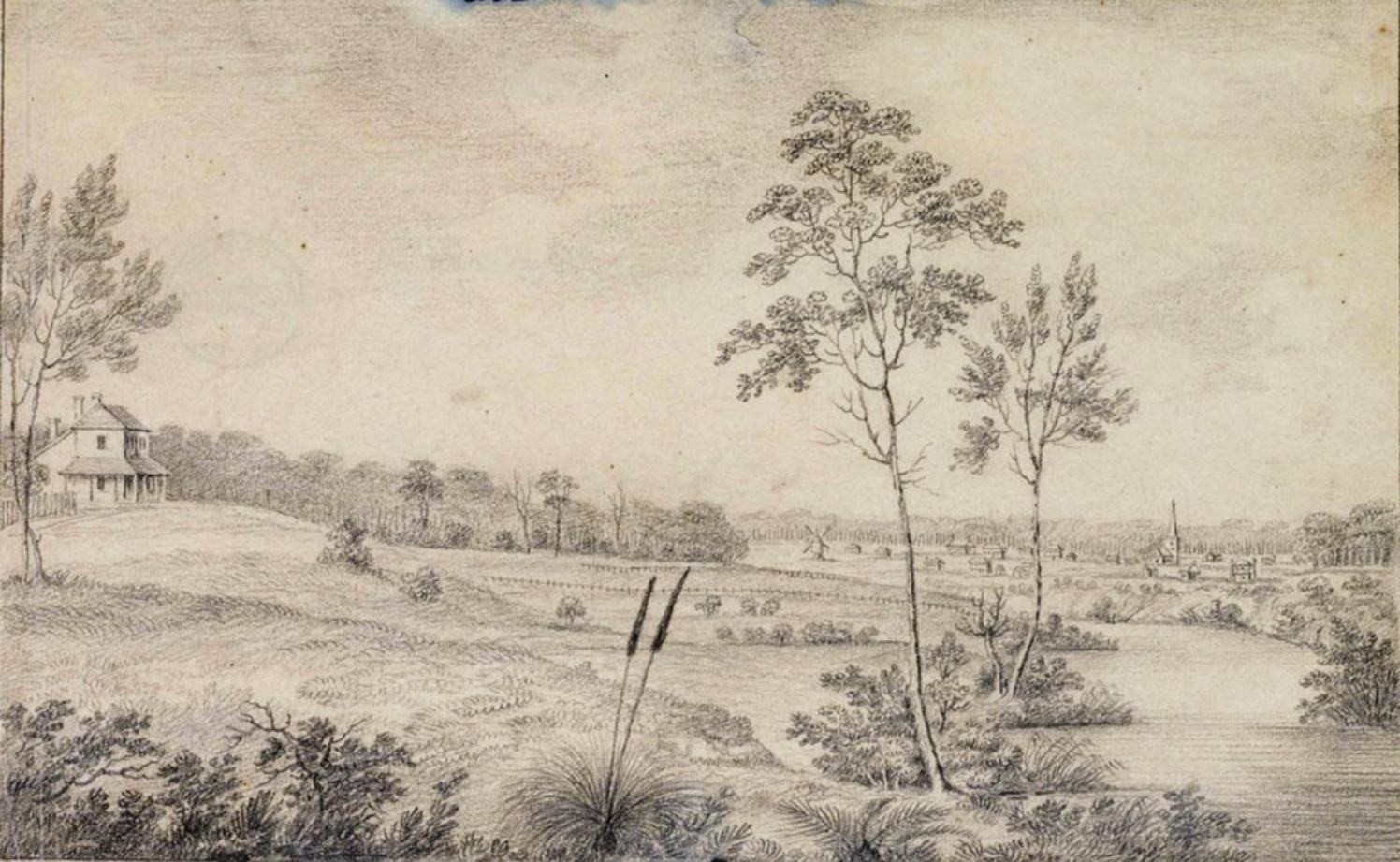
Moorebank, near Liverpool - The Residence of Thos. Moore Esq. Image No.: a1120006, courtesy State Library of NSW.
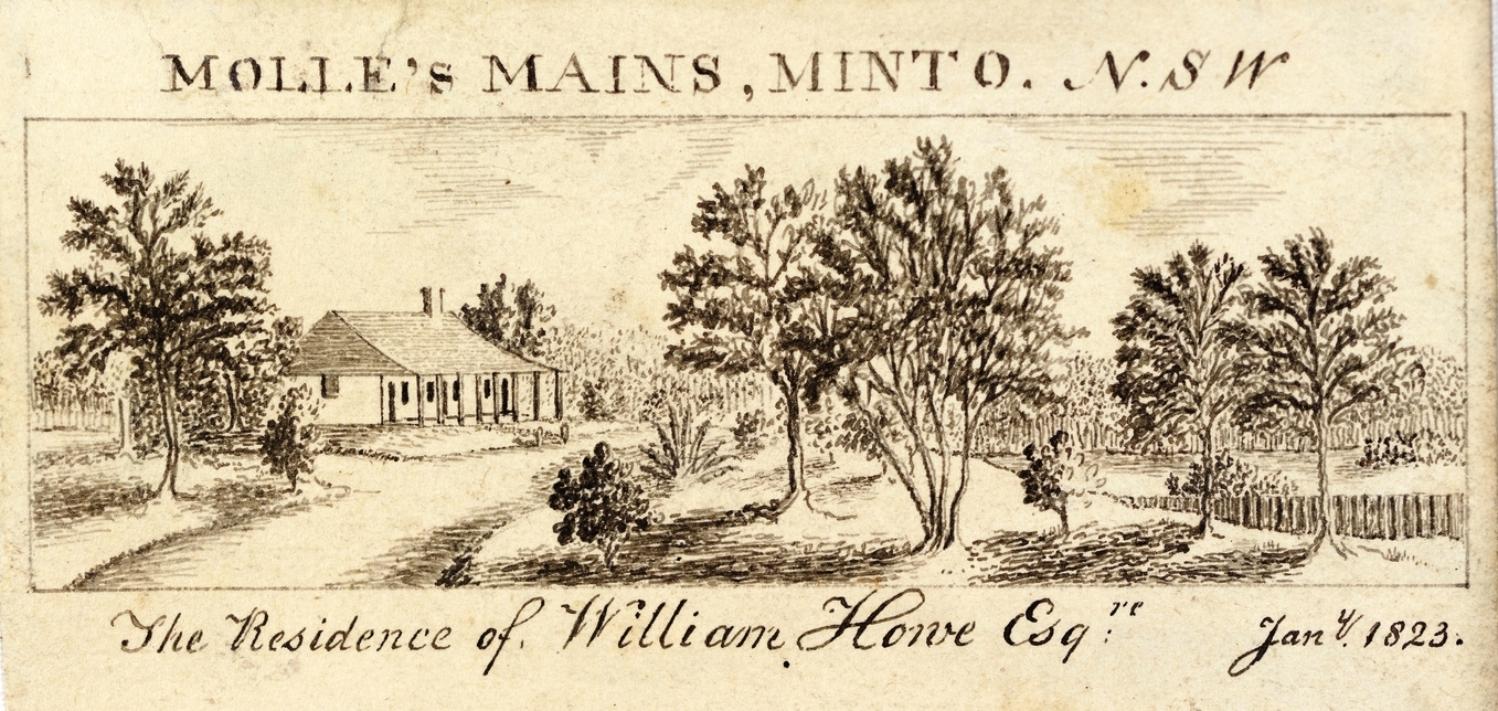
Molle's Mains from the N.E. - Views of Sydney and Surrounding District by Edward Mason, Image No.: a1080009, courtesy State Library of NSW
Sir JOHN JAMISON
 Sir John Jamison (1776 – 29 June 1844) was an Australian physician, pastoralist, banker, politician, constitutional reformer and public figure. He was the son of Thomas Jamison (1752/53-1811) and Rebecca (1746-1838). Thomas Jamison was a Northern Irishman, who arrived in New South Wales, Australia, with the First Fleet in 1788, aboard HMS Sirius, as a surgeon's mate. Soon afterwards, Thomas was sent to the auxiliary British colony of Norfolk Island, where he served as principal medical officer during the 1790s - while accumulating wealth on the side as a maritime trader. Then, in 1801, after taking leave in England, Thomas was promoted to the position of Surgeon-General of New South Wales due to his intelligence, administrative competence, driving ambition and gift for cultivating useful patrons in London. While serving with the Royal Navy's Baltic Fleet in 1807 - aboard the hospital ship Gorgon - he was successful in treating an outbreak of scurvy in the allied Swedish Navy, and was made a knight of the Order of Vasa by a grateful Swedish king. He was also knighted by Britain's Prince Regent (afterwards King George IV) in May 1813, and subsequently appointed Inspector of Naval Hospitals and Fleets.
Sir John Jamison (1776 – 29 June 1844) was an Australian physician, pastoralist, banker, politician, constitutional reformer and public figure. He was the son of Thomas Jamison (1752/53-1811) and Rebecca (1746-1838). Thomas Jamison was a Northern Irishman, who arrived in New South Wales, Australia, with the First Fleet in 1788, aboard HMS Sirius, as a surgeon's mate. Soon afterwards, Thomas was sent to the auxiliary British colony of Norfolk Island, where he served as principal medical officer during the 1790s - while accumulating wealth on the side as a maritime trader. Then, in 1801, after taking leave in England, Thomas was promoted to the position of Surgeon-General of New South Wales due to his intelligence, administrative competence, driving ambition and gift for cultivating useful patrons in London. While serving with the Royal Navy's Baltic Fleet in 1807 - aboard the hospital ship Gorgon - he was successful in treating an outbreak of scurvy in the allied Swedish Navy, and was made a knight of the Order of Vasa by a grateful Swedish king. He was also knighted by Britain's Prince Regent (afterwards King George IV) in May 1813, and subsequently appointed Inspector of Naval Hospitals and Fleets.
Meanwhile, Thomas Jamison had died in London in 1811. Jamison succeeded to his father's property, which included land at Jamisontown on the Nepean River, west of Sydney. He arrived in Sydney on 28 July 1814, aboard the Broxbornebury, to take up his patrimony. The following year, he accompanied Governor Lachlan Macquarie on his official visitation to the Bathurst Plains, and had the Jamison Valley in the Blue Mountains named in his honour by Macquarie. But two and a half years later, he fell out of favour with the governor, who described him in a private dispatch as being "intriguing and discontented".
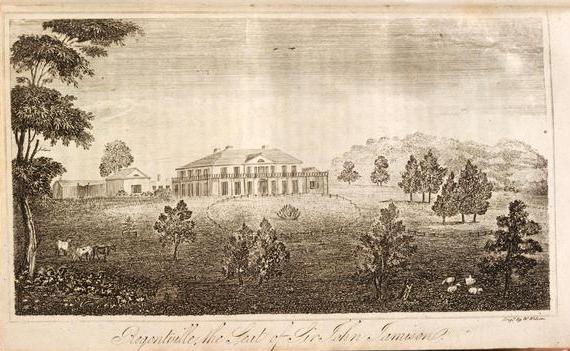 Jamison was Australia's first titled free settler and thus head of the fledgling country's social pecking order. He acquired allotments in the heart of Sydney, and accumulated vast tracts of land in the central-western and northern parts of New South Wales between 1814 and 1840. He was a founder of the Bank of New South Wales in 1817, and established himself as one of the most prominent (and wealthiest) men in Australia, enjoying a reputation for lavish entertaining and hospitality at Regentville, his magnificent rural estate near the town of Penrith.
Jamison was Australia's first titled free settler and thus head of the fledgling country's social pecking order. He acquired allotments in the heart of Sydney, and accumulated vast tracts of land in the central-western and northern parts of New South Wales between 1814 and 1840. He was a founder of the Bank of New South Wales in 1817, and established himself as one of the most prominent (and wealthiest) men in Australia, enjoying a reputation for lavish entertaining and hospitality at Regentville, his magnificent rural estate near the town of Penrith.
Governor Darling in 1829 mentioned that Jamison was then President of the New South Wales Agricultural Society, "holding perhaps the largest stake in the country". In 1830, London's Society for the Encouragement of Arts, Manufactures and Commerce awarded him the large gold medal "for his successful method of extirpating the stumps of trees". He also won various awards for his wine and other agricultural produce and took a keen, scientific interest in the natural history of the Sydney region. He was a committed Freemason and a founding father of the New South Wales thoroughbred racing industry. Benevolent organisations benefited from his generosity, and in 1830 he helped establish Sydney College - an important educational facility which gave rise to both Sydney Grammar School and the University of Sydney. During the mid-1830s, he held office as founder-president of the Australian Patriotic Association, which strove to liberalise the colony's political and legal institutions as Sydney evolved from a penal settlement into a thriving, mercantile port.
Jamison High School at Penrith was named after Sir John Jamison
John Jamison. (2013, November 8). In Wikipedia, The Free Encyclopedia.
Picture: Regentville, the seat of Sir John Jamison [picture] [Sydney : J. Maclehose, 1838] nla.pic-an8421815 courtesy National Library of Australia
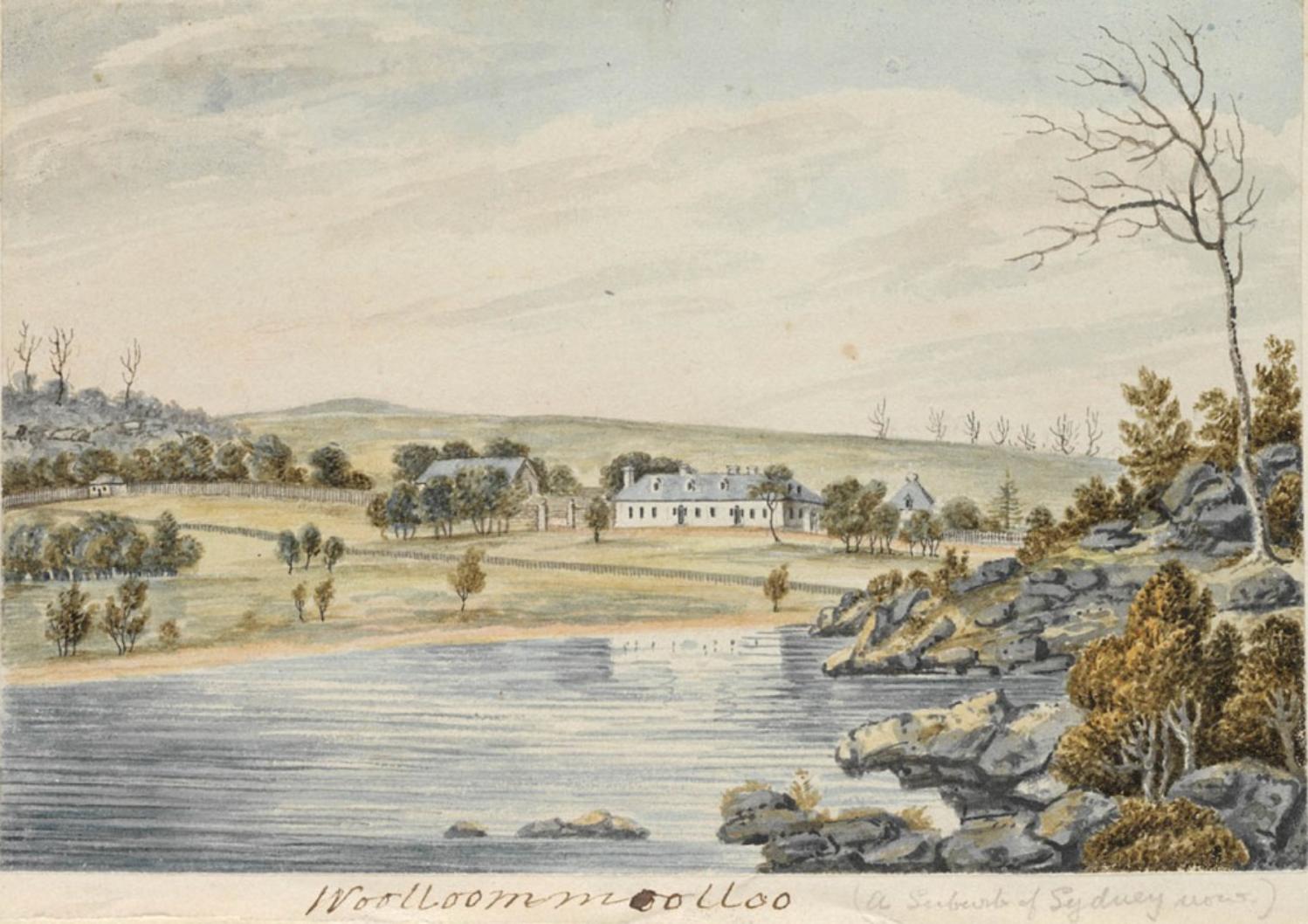
East View of Wooloomooloo near Sydney, Iamge No.: a1120003, courtesy State Library of NSW
JOHN PALMER, Esquire
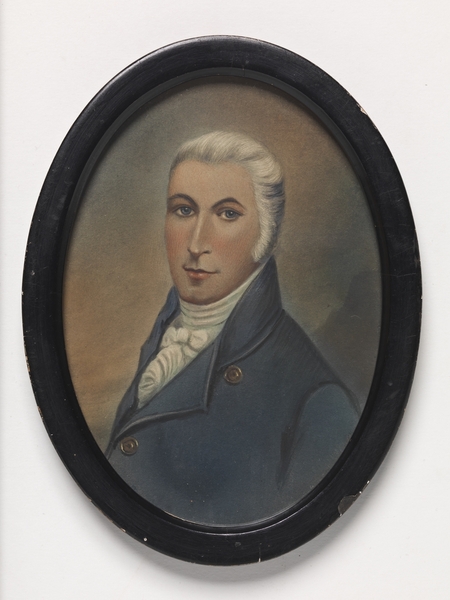 John Palmer (1760-1833), commissary, was born in England. He entered the navy as a captain's servant at 9, and appears to have been educated entirely in the navy, which maintained schoolmasters for such recruits. During the American war of independence he was serving in H.M.S. Richmond which was captured off Chesapeake Bay by a French squadron on 11 September 1781. In 1783, after his release as a prisoner of war, the dark, handsome officer married Susan Stilwell (1761-1832), daughter of an American loyalist family.
John Palmer (1760-1833), commissary, was born in England. He entered the navy as a captain's servant at 9, and appears to have been educated entirely in the navy, which maintained schoolmasters for such recruits. During the American war of independence he was serving in H.M.S. Richmond which was captured off Chesapeake Bay by a French squadron on 11 September 1781. In 1783, after his release as a prisoner of war, the dark, handsome officer married Susan Stilwell (1761-1832), daughter of an American loyalist family.
Palmer arrived in New South Wales with the First Fleet in 1788 as purser of Governor Arthur Phillip's flagship Sirius. The first Commissary, Andrew Miller, resigned in 1790 on account of ill health, and when the Sirius was wrecked off Norfolk Island Palmer was appointed commissary on 2 June 1791. In this post he was responsible for the reception and issue of all government stores, virtually the only supplies in the colony, and their supplement by purchase from private merchants. He negotiated payment for official business and was empowered to draw bills on the British Treasury. In effect he kept the public accounts and funds of the colony and was at once official supplier, contractor and banker to the settlement.
By 1793 Palmer had decided to settle in New South Wales, though he had to wait three years before his application for leave was granted. In September 1796 he left for England in the Britannia, returning in November 1800 in the Porpoise with his wife and children, two sisters, Sophia (1777-1833) and Sarah (b.1774), and a naval brother, Christopher (1767-1821). In February 1793 Lieutenant-Governor Francis Grose had granted Palmer 100 acres (40 ha) at the head of Garden Island Cove, then known as Palmer's Cove. Here, set in an extensive orchard, Palmer built Woolloomooloo Farm, one of the colony's first permanent residences, where the Palmers lived and elegantly entertained the first rank of colonial society.
'Little Jack' Palmer was one of the most enterprising of the early settlers and acquired much knowledge of all aspects of the colony through his private speculations. Active and adventurous, he had early explored the interior of the colony, most of which he believed capable of cultivation. In 1795 Captain Henry Waterhouse described him as one of the three principal farmers and stockholders in the colony and in 1803 Palmer was hailed as the first exponent of improved farming methods when he reduced the men employed on his 300-acre (121 ha) Hawkesbury farm from a hundred to fifteen. When giving evidence before the select committee on transportation in 1812 Palmer claimed, 'I had more ground than anybody else; I farmed more than any other person did'.
By 1803 he owned several small colonial-built craft. Two, the George and the John, were employed sealing in Bass Strait and another, the Edwin, plied up the Hawkesbury River and along the coast with grain, timber and coals. In 1803 one of his employees discovered a new coal-mine at Hunter's River.
On 17 September 1801 Palmer's sister Sophia had married Robert Campbell, and during Campbell's absence in England in 1805 and 1806 Palmer acted as his agent. Palmer also owned a windmill on the margin of the Domain and a bakery near the present Conservatorium of Music. It is claimed that during the disastrous floods of 1806, when scarcity of grain inflated flour prices, Palmer ordered bread to be sold to the needy at lower prices than were then common.
.jpg?timestamp=1395970083371)
Wooloomoolloo, [i.e. Woolloomooloo] / with the buying place of the "Palmers". Image No: 1080065h, courtesy State Library of NSW
The estate of Woolloomooloo, mortgaged for over £13,000, was eventually sold to Edward Riley for £2290 in May 1822, though the stock and furnishings were auctioned in 1816. In January 1818 Palmer was granted 1500 acres (607 ha) at Bathurst, which he named Hambledon, but he ran only a handful of stock. In the 1820s the family fortunes recovered. Palmer received a grant in the Limestone Plains known as Jerrabombera, while at Waddon, near Parramatta, he farmed 3000 acres (1214 ha), one-third of which was cleared. By the 1830s he was running more than 3000 sheep and nearly 500 cattle. From August 1803 to January 1824 he had been a member of the committee of the Female Orphan Institution. As a magistrate he sat frequently on the bench at Parramatta until dismissed by Governor Sir Thomas Brisbane in the quarrel over the case of Henry Grattan Douglass in 1822; he was restored to the magistracy on 3 November 1825 and continued to sit until within a year or two of his death. His reputation for discreet benevolence was enhanced by a friendly manner and cheerful nature. He was an adherent of the Church of England. When he died at Waddon on 27 September 1833, he was 'the last surviving officer of the first fleet that arrived in this part of His Majesty's Dominions'. His wife died in September 1832; she was survived by three sons, George Thomas, John (1797-1839) and Edwin Campbell (b.1802), and a daughter, Sophia Susannah (b.1803), who had married Edward Close.
Margaret Steven, 'Palmer, John (1760–1833)', Australian Dictionary of Biography, National Centre of Biography, Australian National University, http://adb.anu.edu.au/biography/palmer-john-2533/text3437, published in hardcopy 1967
John Palmer, R.N. – portrait - Presented by Mrs. J.C. Close, April 1966 - A label pasted onto the back of frame reads, "Copy of portrait of:- / John Palmer, R.N. / (Purser of H.M.S. "Sirius" / with the "First Fleet"; / and afterwards. / Principal Comissary / of the Colony of N.S. Wales; / finally / Assist.-Commissary-General of N.S.W.) / Relationship to Edward C. Close (Senr.) / Father-in-law". This image is thought to be based on a locket miniature. Image No.: a5460001
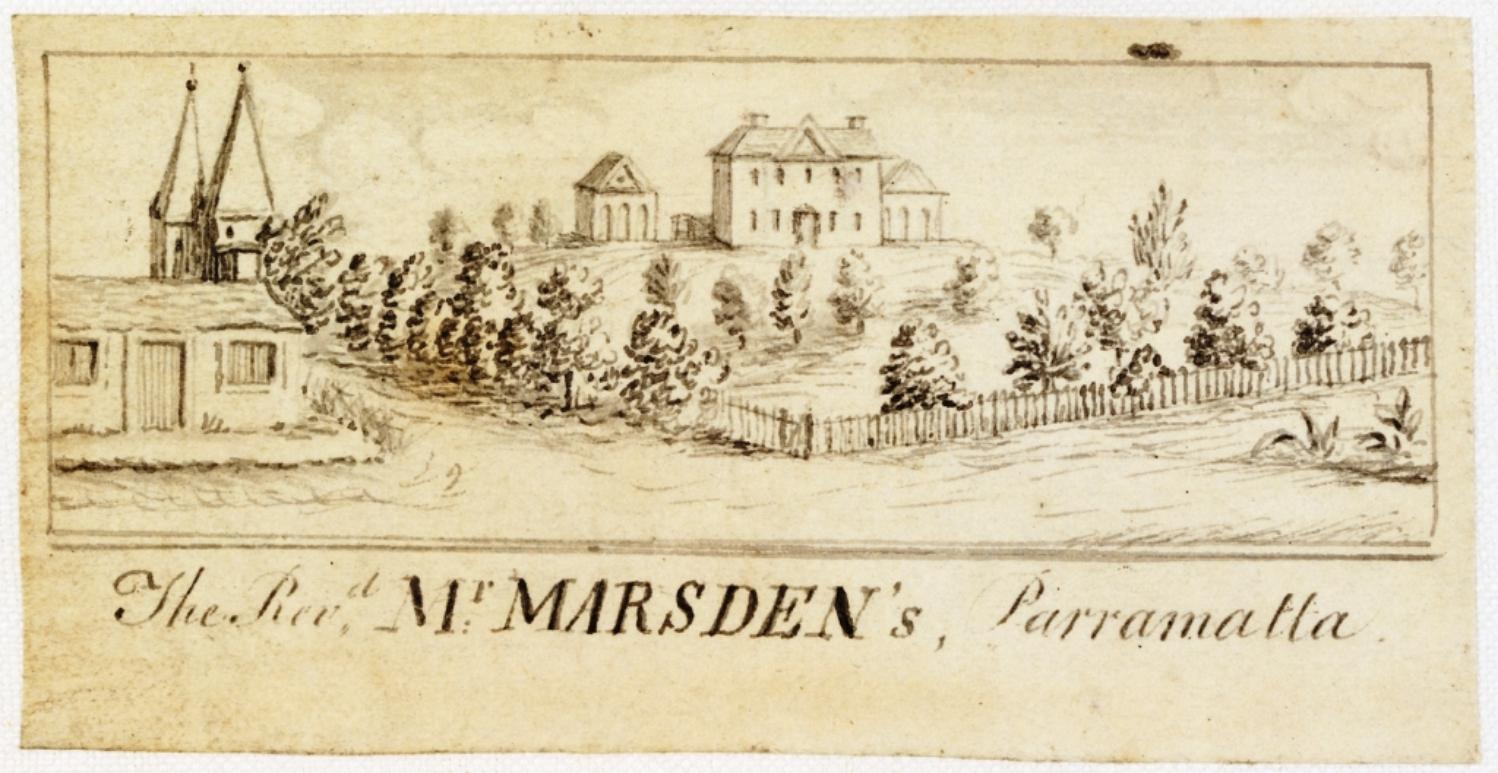
Reverend Mr. MARSDEN, J. P.
 Samuel Marsden (1765-1838), chaplain, missionary and farmer, was born on 24 June 1765 at Farsley, Yorkshire, England, the son of Thomas Marsden, a blacksmith. He attended the village school, was then apprenticed to his father and grew up in an area and amongst a class much influenced by the Methodist religious revival. Well known locally as a lay preacher, Samuel gained the interest of the Elland Society, an Evangelical group within the Church of England which sponsored the education for the ministry of promising but ill connected youths. Aged about 24, he went to Hull Grammar School, where he met the Milners, members of the Clapham sect, and through them William Wilberforce, doyen of humanitarian and missionary projects, who was to influence decisively the course of Marsden's life.
Samuel Marsden (1765-1838), chaplain, missionary and farmer, was born on 24 June 1765 at Farsley, Yorkshire, England, the son of Thomas Marsden, a blacksmith. He attended the village school, was then apprenticed to his father and grew up in an area and amongst a class much influenced by the Methodist religious revival. Well known locally as a lay preacher, Samuel gained the interest of the Elland Society, an Evangelical group within the Church of England which sponsored the education for the ministry of promising but ill connected youths. Aged about 24, he went to Hull Grammar School, where he met the Milners, members of the Clapham sect, and through them William Wilberforce, doyen of humanitarian and missionary projects, who was to influence decisively the course of Marsden's life.
A proposal in March 1793 invited Elizabeth, daughter of Thomas Fristan of Hull, to take up the cross and share life's travails and pleasures with him across the seas. The couple were wed on 21 April; Samuel was ordained deacon on 17 March at Bristol and priest in May; on 1 July they left for New South Wales in the William. After a journey made memorable by Samuel's clashes with the captain and by the accouchement of Elizabeth as the ship was buffeted by a storm off Van Diemen's Land, they arrived in Sydney Cove on 10 March 1794.
In some significant ways the pattern of Marsden's life was set during his first year in New South Wales. As assistant to Rev. Richard Johnson, after a brief visit to Norfolk Island in 1795, he was stationed at Parramatta. It was an important centre in the colony and Marsden remained there after Johnson's departure, although for some years he was the only Anglican clergyman on the mainland. He was promised the position of senior chaplain in 1802, but was much vexed at receiving only part of its stipend, and was not formally promoted until after his return from England in 1810. Governor Lachlan Macquarie allowed him to live at Parramatta 'as being more convenient and centrical for the execution of his general superintending duties', and in September directed that Marsden should be regarded 'as the resident chaplain in that district'.
Marsden had quickly and deeply committed himself to farming, although he was inexperienced in it. By 1802 he had received 201 acres (81 ha) in grants, and had purchased 239 (97 ha) from other settlers; he had 200 acres (81 ha) cleared and grazed 480 sheep. Three years later he had over 1000 sheep, 44 cattle and 100 pigs on his farm which by then had increased to 1730 acres (700 ha) seven miles (11 km) from Parramatta. In 1798, with Surgeon Thomas Arndell, he had made a valuable report on the colony's agriculture; in 1803-05 he made several reports to Governor Philip Gidley King and to Sir Joseph Banks on the prospects of sheep-breeding and wool-growing. King thought Marsden 'the best practical farmer in the colony', and when he visited England on leave in February 1807 he was recommended by Governor William Bligh as one who had made the 'nature and soil' of the colony 'his particular study'. He concentrated on the development of strong heavy-framed sheep such as the Suffolk breed, which had a more immediate value in the colony than the fine-fleeced Spanish merinos imported by John Macarthur. In 1808 he had his own wool made up into a suit by the Thompsons of Horsforth in Yorkshire, and so impressed George III that he was given a present of merinos from the Windsor stud. Four years later more than 4000 lbs (1814 kg) of his wool was sold in England at 45d. a lb. Marsden was an important promoter of the wool staple, even though his contribution to technology, breeding and marketing was far eclipsed by that of Macarthur.
Samuel Marsden (1765-1838), by Joseph Backler, Alexander Turnbull Library, Wellington, National Library of New Zealand, ATL ref. G-620. A. T. Yarwood, 'Marsden, Samuel (1765–1838)', Australian Dictionary of Biography, National Centre of Biography, Australian National University, http://adb.anu.edu.au/biography/marsden-samuel-2433/text3237, published in hardcopy 1967
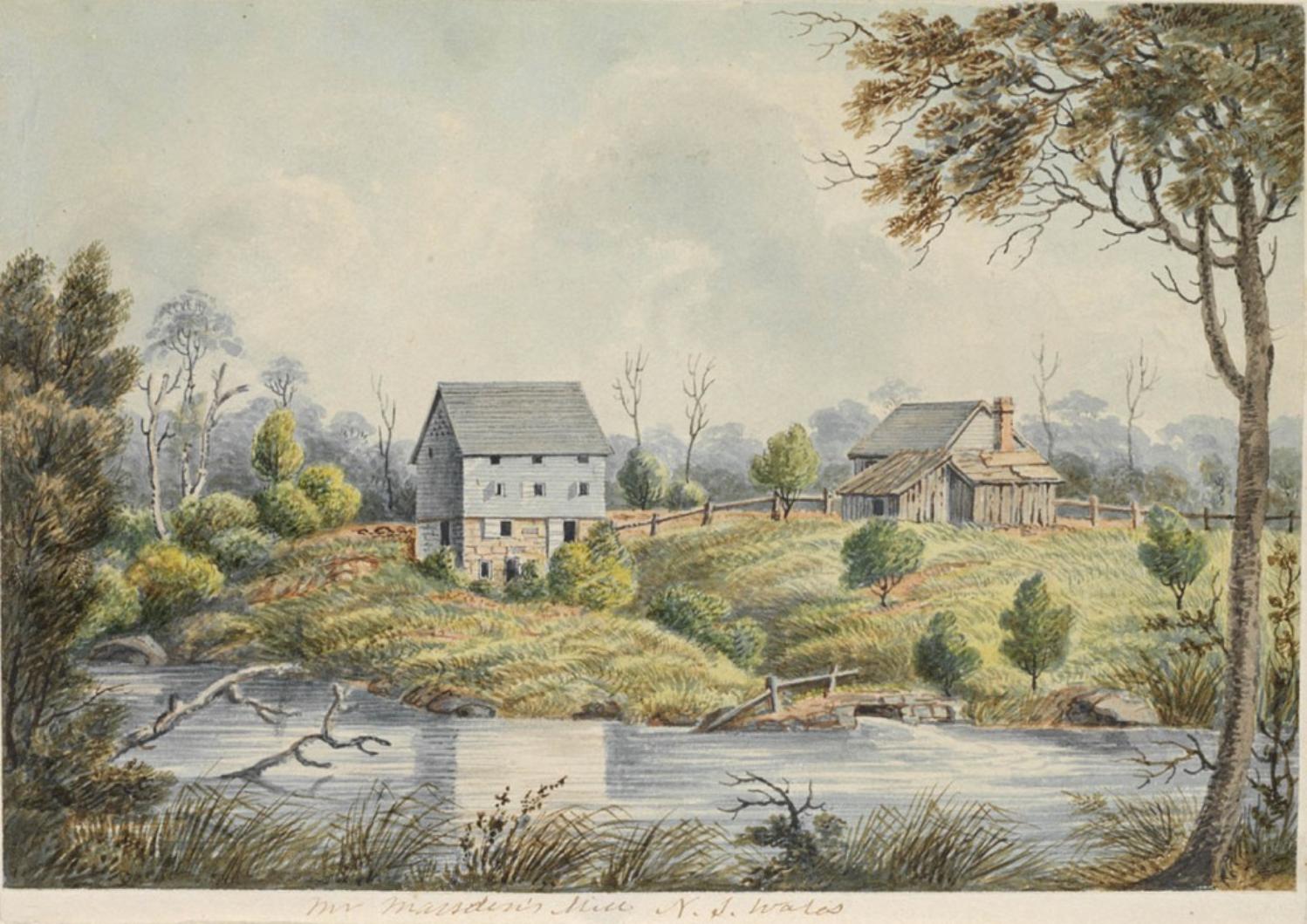
Mr Marsden's Mill N.S.Wales, near Parramatta, Imae. No.: a1120001, courtesy State Library of NSW.
J. T. CAMPBELL, Esquire, J. P;
John Thomas Campbell (1770?-1830), vice-regal secretary, was the eldest son of William Campbell, vicar of Newry, County Armagh, Ireland, and his wife Mary, née M'Cammon. Apparently Campbell and his brothers were educated at home by their father. Campbell's brother was curate at Caledon, County Tyrone, and Campbell himself seems to have enjoyed the patronage of the earl of Caledon, governor at the Cape, who recommended him to Macquarie when the latter called there in 1809. He joined the governor-designate's party, with an understanding that something would be done for him in New South Wales. Captain Henry Colden Antill noted that he 'had the appearance of being a gentlemanly well-informed man'. After they arrived in Sydney, on 1 January 1810 Macquarie appointed Campbell his secretary; Ellis Bent considered him 'very fit for the situation, which is very troublesome'. His salary was £282 10s., paid by the British government, to which Macquarie added £82 10s. from the colonial revenue as soon as authorized to do so in 1816. For eleven years he was Macquarie's chief assistant in the administration of the colony, his intimate friend and loyal supporter.
Campbell took a leading part in the founding of the Bank of New South Wales in 1816-17. As the first president of its board of directors he gave thorough attention daily to every detail of its organization and operations until it was well established. Although Macquarie, in his eagerness to present the bank's prospects in the best light, may have exaggerated the president's earlier experience as a banker, Campbell was obviously enthusiastic and competent.
Campbell was a large landholder and a most efficient farmer and breeder of cattle and horses. In 1811 Macquarie granted him 1550 acres (627 ha) at Bringelly, and later he received a grant near Rooty Hill, which to Marsden's indignation he named Mount Philo. He was also a large stock-holder in southern New South Wales. Reserved, frugal, and with a genuine dislike of ostentation, Campbell was not a popular politician, but his reputation for high principles and integrity was acknowledged by nearly all of his contemporaries. He reserved his strongest indignation for what he conceived to be hypocrisy and self-seeking, as in the case of his attacks on Marsden, Barron Field and his sycophants, and John Macarthur. As became a nephew of Samuel Johnson's 'Irish Dr Campbell', he had literary tastes, and his large collection of books was bequeathed to the Australian Subscription Library. Campbell died at Sydney on 7 January 1830.
R. F. Holder, 'Campbell, John Thomas (1770–1830)', Australian Dictionary of Biography, National Centre of Biography, Australian National University, http://adb.anu.edu.au/biography/campbell-john-thomas-1873/text2191, published in hardcopy 1966
MAJOR-GENERAL MACQUARIE, AND THE FIRST LANDING.-On Friday last JOHN THOMAS CAMPBELL, Esq. Provost Marshal for the Territory of New South Wales, upon the gratifying return of the day, gave a most superb Dinner to a large Party of the Officers (Civil, Military, and Naval) of the Colony, and other Gentlemen : His Honor Colonel ERSKINE (Lieutenant Governor), and Major GOULBURN (Colonial Secretary), were among the number of distinguished guests. A more splendid entertainment has not been given; and we somewhat regret that no faithful description of this development of princely liberality has not been handed to us. Affectionate remembrances, however, are not to pass altogether unheeded.
On Friday last an excellent Dinner was prepared at Hill's Tavern, Hyde Park, in commemoration of the First Landing in this Colony; as also, in honor of the Birthday of, our late worthy and respected Governor, Major General MACQUARIE. At half past 5 o'clock, a numerous and respectable body of the Inhabitants of Sydney, sat down to the sumptuous fare provided for the auspicious occasion; the arrangements of which did every credit to Mrs. Hill. SIMEON LORD, Esq. was in the chair. After the cloth became removed, several loyal and appropriate toasts were drank, amongst which, the Chairman gave the following:-"THE KING !" "THE ROYAL FAMILY OF GREAT BRITAIN !""Our worthy Governor, Sir THOMAS BRISBANE !" “Major General MACQUARIE-our late worthy GOVERNOR !" "The LIEUTENANT GOVERNOR !" " LADY BRISBANE, and the LADIES of the COLONY !" "Success to the Agricultural, Commercial, and Manufacturing Interests of the Colony !" The evening was spent in much harmony and conviviality, and with all that urbanity and good humour so desirable in such assemblies.
Mr. Samuel Terry, of Pitt-street, upon the same occasion, also gave a Dinner, no way inferior to the above, to a select party. The donor of this feast manifested that he could deal well a liberal hand, for the festive board actually groaned under its ponderous weight of true British hospitality. We understand that Dinners were given at several of the Taverns in the interior, in honor of the day.
On Thursday last the Agricultural Society held the General Quarterly Meeting at Nash's Inn, Parramatta, and afterwards dined together. Mr. Nash provided an excellent Dinner, at a very moderate charge ; and the desert was contributed from the gardens of Dr. Townson and Captain Piper. It consisted of no fewer than 18 kinds of fresh fruit, and 4 of dried; among which were the banana, the Orlean plum, the green gage, the real peach, the cathead apple, and a peculiarly fine sort of musk melon. We understand that the Meetings are to be held at Walker's, and Nash's alternately. A Horticultural Subscription, of 8 dollars, is set on foot, and a Committee chosen. The future Agricultural Subscription was altered to 20 dollars.-At this Meeting three new Members were selected, and twelve proposed for the next Meeting.
Mr Jonas Bradley, to whom the silver tankard was voted for his specimen of tobacco, laid before the Society a statement of his mode and cure, a copy of which we are promised for publication. The President presented him with the piece of plate, suitably inscribed (the workmanship by Mr. Robertson), and informed him, with a view to encourage the colonial growth of tobacco, the legislature had now authorized the Governor, at discretion, to lay a duty of 4 shillings per lb. upon the importation of foreign tobacco. This meritorious marine settler acquainted the Society that, although Governor MACQUARIE had never given him more than 50 acres of land, yet he had acquired up-wards of 100 head of cattle and 800 sheep. One of his sons was among the number of proposed new Members.
Sunday ae'nnight being the 36th Anniversary of the First Landing in Australasia, the Royal Standard was displayed upon the heights of Fort* Philip throughout the whole of the day. MAGISTRATE FOR THE WEEK—RICHARD BROOKS, Esq. (1823, February 6 - Thursday). The Sydney Gazette and New South Wales Advertiser (NSW : 1803 - 1842), p. 2. Retrieved from http://nla.gov.au/nla.news-article2181620
EDWARD WOLLSTONECRAFT, Esquire, J. P;
Edward Wollstonecraft (1783-1832), merchant and landowner, was the son of Edward Wollstonecraft, a London solicitor, who was a brother of Mary Wollstonecraft Godwin. Edward and his sister Elizabeth were therefore cousins of the ill-fated Fanny Imlay and of Mary Godwin who became the second wife of Shelley and was the author of Frankenstein. His parents died when relatively young. Wollstonecraft resented the notoriety of his aunt and sought escape and fortune for himself and his sister in travel and trade.
Wollstonecraft arrived in Sydney in September 1819 in the Canada. Wollstonecraft was permitted to locate some 500 (202 ha) of his 2000 acres (809 ha) on the north side of Sydney Harbour, and his tenure was made official in June 1825. In spite of ill health he became a magistrate and a central figure in the Sydney commerce of the 1820s. As a director of the Bank of New South Wales and of the Bank of Australia, and as chairman of the Chamber of Commerce, he appears to have been chiefly concerned with maintaining the general financial liquidity of the colony's economy. He argued that the introduction of the Spanish dollar had depreciated colonial values and embarrassed external trade, and he urged the government to make loans to the colonial banks in the financial crises of 1826 and 1828.
A wide variety of merchandise passed through the warehouse of Berry and Wollstonecraft in George Street. In 1820, while Berry was still in London, Wollstonecraft advised him to concentrate on obtaining the solid necessities of a young colony and to beware of fripperies 'and the other female trash by which we are likely to lose so much already'.
Berry returned to Sydney in 1821, chartering the Royal George and bringing with him Governor Sir Thomas Brisbane and his party as passengers. With Wollstonecraft he successfully applied for a further 10,000 acres (4047 ha) on their undertaking to maintain 100 convicts. The grant was taken on the Shoalhaven River on the initiative of Berry, who explored the area, liked it and assured it of safe access from the sea by cutting a canal between the Crookhaven and Shoalhaven Rivers. On this foundation Wollstonecraft's relentless business energy worked, for he believed that the colony's greatest economic need was a reliable export staple. Finding the Shoalhaven region climatically unsuited for sheep, his long term plan at Coolangatta (Cullingatta and Coolungatta), as the property came to be called, was to clear the hillsides and drain the swamps for agriculture. Meanwhile the forests of cedar and blue gum could be put to use. Teams of sawyers, both assigned convicts and freemen, were organized, and by July 1823 thirty-six men were employed in getting and preparing timber for which Wollstonecraft was assiduous in seeking markets. The bulk of it was exported and thus provided a desirable balance to the imports demanded by the diverse trade still carried on by the partners in Sydney. While timber proved an immediate and sure source of wealth, experiments were made at Shoalhaven with other crops of similar economic potential, the chief being tobacco which was normally retailed at enormous profit to the importer. The partners generally arranged that one was at Shoalhaven and the other at the North Shore. The bond between them was strengthened by Berry's marriage in September 1827 to Elizabeth, Wollstonecraft's sister.
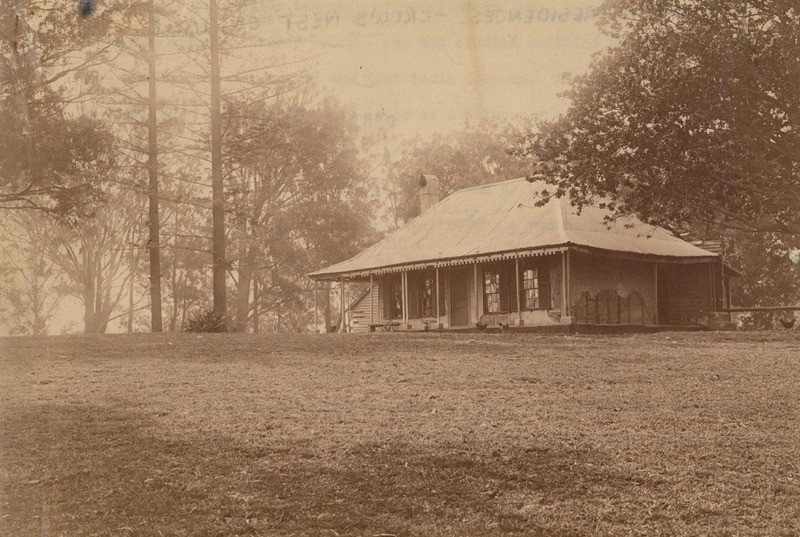
Both Wollstonecraft and Berry had the eighteenth-century Englishman's view of the social importance of land, and they saw at Shoalhaven the beginning of a great estate over which eventually they might rule as patriarchs. In pursuit of their object Wollstonecraft was almost morbidly jealous of encroaching settlers. His aim was to exclude them altogether or, failing that, so to encircle their holdings as to make them unworkable. This the partners were increasingly able to do, both by manipulating the location of their own grants before survey, and by buying the promises of grants from other settlers and locating them as strategy required.
Wollstonecraft died on 7 December 1832. His life in Australia depended largely on Berry's enterprise, yet Berry could rightly claim that he had 'a naturally defective temper', and that his conduct in his last years was 'such as to render my existence hardly tolerable'. His letters leave an impression of sardonic bitterness which may, however, have been the product of ill health. His business acumen and integrity were beyond question, yet it is doubtful that they would have found any important employment without the wider vision and more civilized instincts of Berry.
Wollstonecraft never married. A suburb of Sydney was named after him and another after his cottage, Crow's Nest, on the North Shore. In March 1846 his remains were removed from the Sydney burial ground and placed with those of his sister, who died on 11 April 1845, in a magnificent tomb erected by Berry in the cemetery near St Thomas's Church of England, North Sydney.
M. D. Stephen, 'Wollstonecraft, Edward (1783–1832)', Australian Dictionary of Biography, National Centre of Biography, Australian National University, http://adb.anu.edu.au/biography/wollstonecraft-edward-2812/text4025, published in hardcopy 1967
Crows Nest Cottage Date of Work undated [ca. 1880-1890s] Image No.: a089387 courtesy State Library of NSW
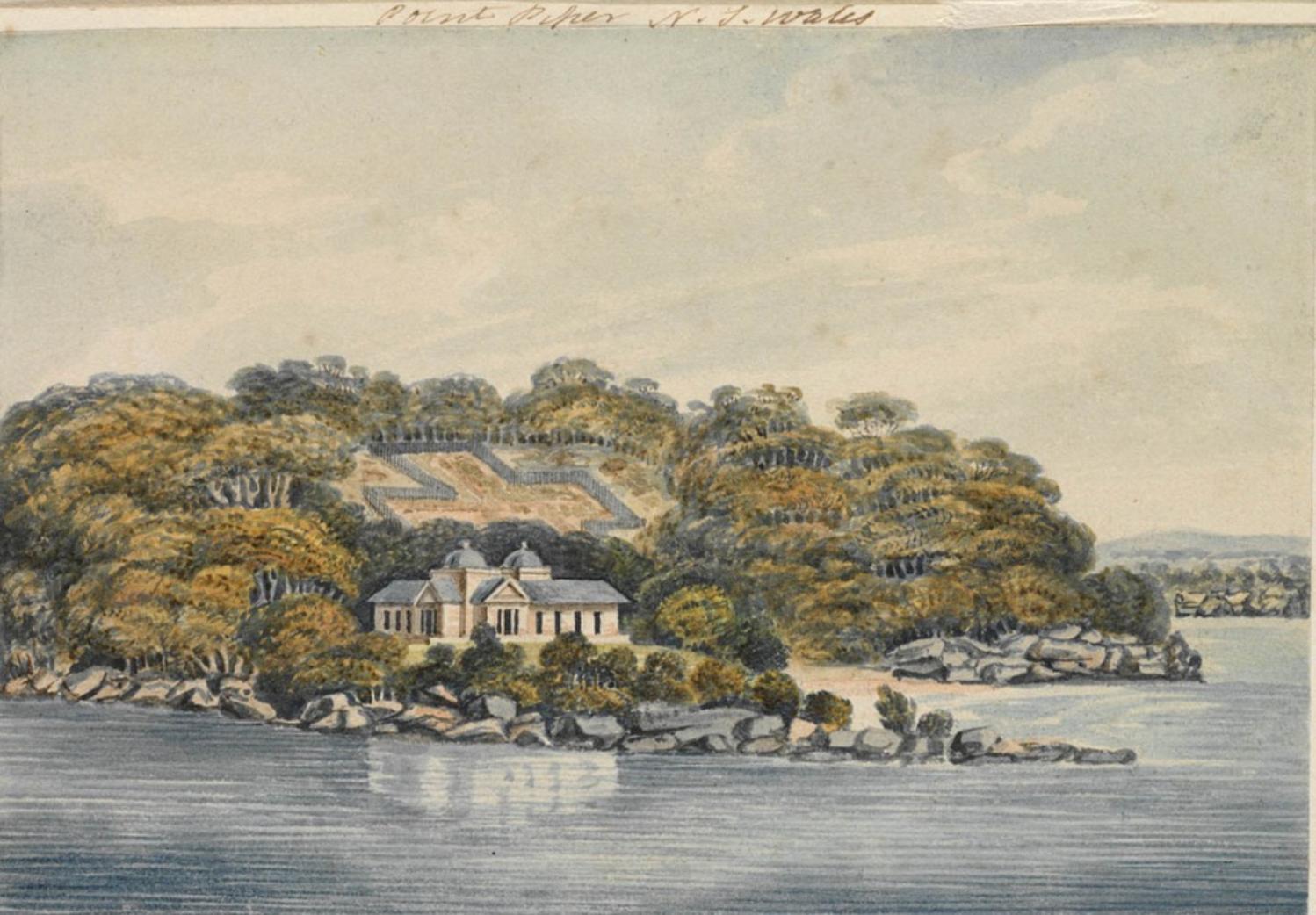
Eliza Point, near Sydney New South Wales Digital Order Number: a1120004, courtesy State Library of NSW
JOHN PIPER, Esquire, J. P
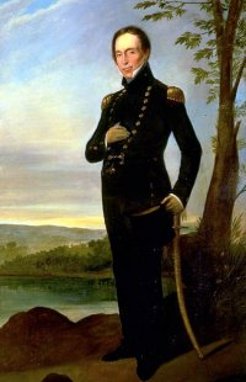 John Piper (1773-1851), military officer, public servant and landowner, was born on 20 April 1773 at Maybole, Ayrshire, Scotland, the son of Hugh Piper, a doctor. The Pipers were in the main an army family, and Scots only by adoption, having come from Cornwall and before that from Germany. Through the influence of his uncle, Captain John Piper, young John received a commission as ensign in the newly formed New South Wales Corps in April 1791, as his younger brother Hugh was to do in 1799.
John Piper (1773-1851), military officer, public servant and landowner, was born on 20 April 1773 at Maybole, Ayrshire, Scotland, the son of Hugh Piper, a doctor. The Pipers were in the main an army family, and Scots only by adoption, having come from Cornwall and before that from Germany. Through the influence of his uncle, Captain John Piper, young John received a commission as ensign in the newly formed New South Wales Corps in April 1791, as his younger brother Hugh was to do in 1799.
John sailed in the Pitt and arrived in Sydney in February 1792 when the infant settlement was still fighting for its life in the face of starvation. Piper was an immediate social success and became a close family friend of John Macarthur.
John resigned his commission and decided to seek civilian employment in the colony. In 1813 he was appointed Naval Officer in Sydney and arrived back in February 1814. On 10 February 1816 he married Mary Ann, by special licence. She had borne him two more sons while they were away and in due course they had nine more.
His duties included the collection of customs duties, excise on spirits and harbour dues, control of lighthouses and work which is now the province of the water police. The post was very much to Piper's taste and proved very remunerative: with a percentage on all monies collected, his income from it rose to more than £4000 a year. He bought the property now known as Vaucluse House.
In 1816 he was granted 190 acres (77 ha) of land on Eliza Point, now Point Piper, for the site of his official residence. Here he built Henrietta Villa (also called the Naval Pavilion) at the cost of £10,000 and furnished it in the most luxurious style.
It was completed in 1822 and became the scene of many sumptuous entertainments.

Point Piper Image No: 1080063h, courtesy State Library of NSW
Piper was a close friend of Governor Lachlan Macquarie, who in 1819 made him a magistrate. In 1825 he was chairman of directors of the Bank of New South Wales. He sat on the local committee of the Australian Agricultural Co., was president of the Scots Church committee and took part in many social and sporting activities. He owned much property, acquired by grant or purchase. Besides Point Piper he had 475 acres (192 ha) at Vaucluse, 1130 (457 ha) at Woollahra and Rose Bay, a farm of 295 acres (119 ha) at Petersham, 700 (283 ha) at Neutral Bay, 80 (32 ha) at Botany Bay, 2000 (809 ha) at Bathurst, 300 (121 ha) in Van Diemen's Land with various smaller farms, and an acre (0.4 ha) of city land in George Street. He was, however, not as solvent as he appeared and in 1826 he raised a mortgage of £20,000.
John Piper was a man of his times. He personified the colonial dream. In his sixty years in the colony he adapted himself to its development. During the military regime he was an officer; when Macquarie created a civil state he became a civil servant; when the race was to the pioneer he became one. He was honourable, generous, gay and so well loved that he was forgiven things which would have wrecked a stronger man. He was no business man, completely lacking the shrewdness which enriched so many of his brother officers.
John Piper (1773-1851), by Augustus Earle State Library of New South Wales, Original : ML 6
Marjorie Barnard, 'Piper, John (1773–1851)', Australian Dictionary of Biography, National Centre of Biography, Australian National University, http://adb.anu.edu.au/biography/piper-john-2552/text3449, published in hardcopy 1967
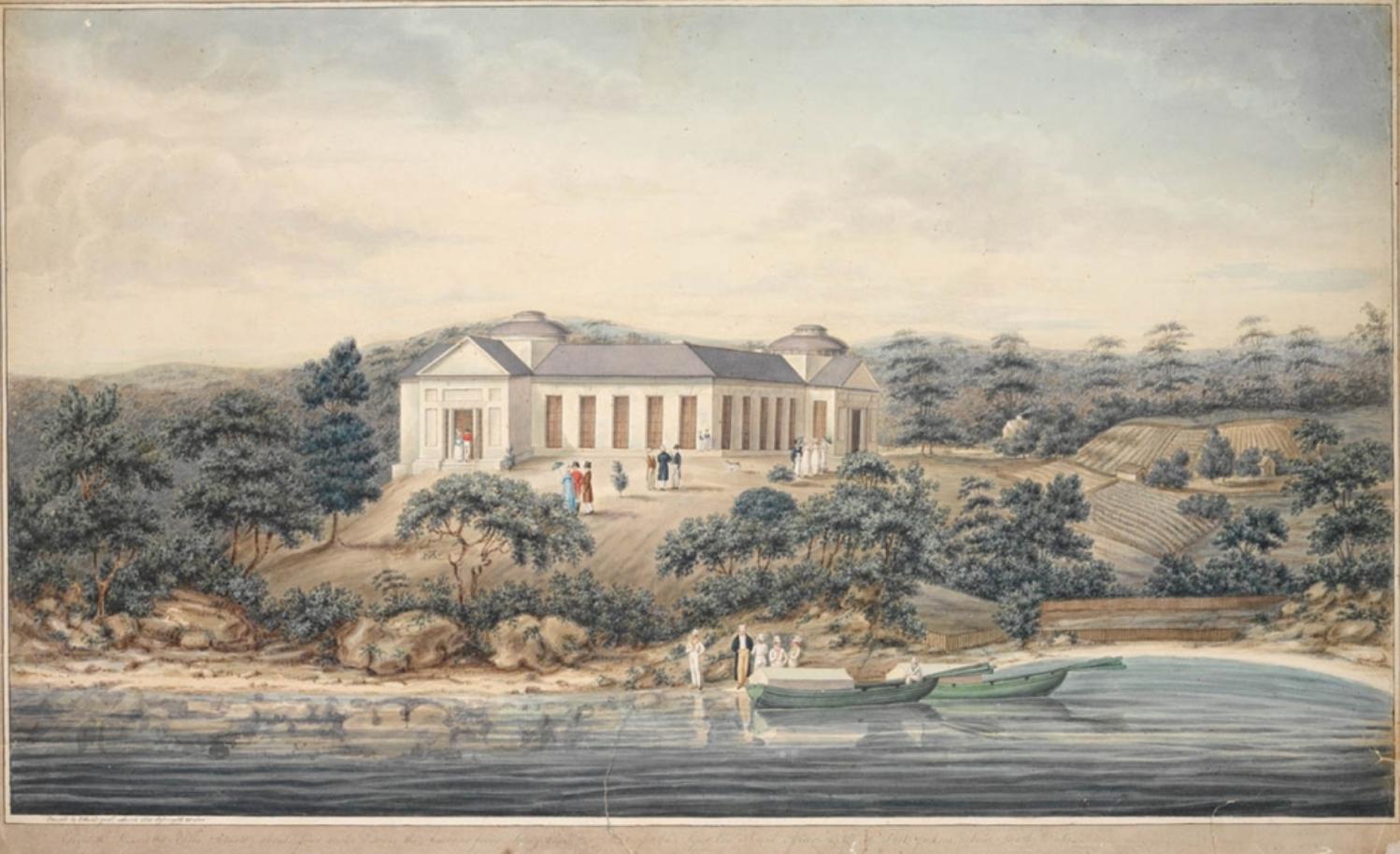
Henrietta Villa, built between 1816 and 1822, was the property of Captain Piper and most likely designed by Henry Kitchen. The house was named after Mrs Macquarie and became a symbol of progress in the colony. When this drawing was executed, the building was not finished as the verandah covering the long windows are absent. -- Reference: The Artist and the patron : aspects of colonial art in New South Wales / [compiled by] Patricia R. McDonald and Barry Pearce. [Sydney] : Art Gallery of New South Wales, 1988.
Signed and dated at lower left in black ink, "Painted by R. Read junr. March 1820 Sydney N.S. Wales".
Inscribed, probably in the artist's hand, beneath frame lines in pencil "Elizabeth Heneretta [i.e. Henrietta] Villa situate about four miles Down the Harbour from Sydney Cove the seat of John Piper Esqr. Naval Officer etc. etc. of Port Jackson New South Wales". Image No: a128862, courtesy State Library of NSW.
WILLIAM Cox, Esq. J. P.
 William Cox (1764-1837), military officer, roadmaker and builder, was born at Wimborne, Dorset, England, and educated at the local grammar school. He later moved to Devizes, Wiltshire, where he married Rebecca Upjohn of Bristol. He joined the army in 1797 and was commissioned a lieutenant in the New South Wales Corps; next year he was appointed paymaster. In 1799, accompanied by his wife and four of his six small sons, he sailed for New South Wales in the Minerva by way of Cork, where the ship picked up a consignment of Irish convicts who had taken part in the rebellion the previous year. Soon after he arrived in the colony on 11 January 1800, Cox acquired Brush Farm at Dundas from John Macarthur whom he had succeeded as paymaster, several adjoining farms and much stock. He overstrained his credit and in 1803 facing a deficiency of £7900 in his regimental accounts he was suspended from office. The sum of £2000 was secured, and to pay the remainder his estate was assigned to trustees and sold for the benefit of his creditors, including the army agents. By 1806 they had been paid in full, but by then Cox had been ordered to England under arrest 'to answer such charges as may be brought against him'. He sailed in February 1807 but appears never to have been brought to trial. In 1809 he resigned his commission and devoted the rest of his life to civilian pursuits. Through this enforced absence he was away from the colony during the William Bligh rebellion, and was never called upon to reveal where his sympathies lay; however, his wife and son signed an address of loyalty to Bligh organized by the settlers on the Hawkesbury, where Cox had gone to live after the sale of Brush Farm, and during the King period had been strongly criticized by Macarthur and the corps. Cox received the first grant of land west of the mountains, 2000 acres (809 ha) across the river from Bathurst which he called Hereford. Although neither he nor his sons made it their home, they ran sheep there for some time. About 1810 they had taken up land in the Mulgoa valley where three of his sons lived for many years. Later in the Mudgee district his sons and grandsons formed studs from William's flocks which became famous for the fine quality of their wool. His large estate at Clarendon near Windsor had all the appearance of a self-contained village. Over fifty convict servants acted as smiths, tanners, harness makers, wool sorters, weavers, butchers, tailors and herdsmen. Cox had steadily improved his flocks, which Commissioner Bigge described in 1820 as among the six best in the colony. He explored the source of the Lachlan River and organized provisions for John Oxley's expedition. He was the first president of the Windsor Benevolent Society, chairman of the local Macquarie Memorial fund, and a vice-president of the Agricultural Society. Politically he was always a radical, signing many petitions for such reforms as representative government, repeal of taxes, and trial by jury, being 'firmly of the opinion' that 'Respectable Emancipists' would be worthy jurors. In 1824 Brisbane submitted his name for the proposed new Legislative Council, but he was not appointed. He died on 15 March 1837, and was buried, with his first wife, at St Matthew's, Windsor. A window to his memory was erected in St Andrew's Cathedral by the sons of his first marriage.
William Cox (1764-1837), military officer, roadmaker and builder, was born at Wimborne, Dorset, England, and educated at the local grammar school. He later moved to Devizes, Wiltshire, where he married Rebecca Upjohn of Bristol. He joined the army in 1797 and was commissioned a lieutenant in the New South Wales Corps; next year he was appointed paymaster. In 1799, accompanied by his wife and four of his six small sons, he sailed for New South Wales in the Minerva by way of Cork, where the ship picked up a consignment of Irish convicts who had taken part in the rebellion the previous year. Soon after he arrived in the colony on 11 January 1800, Cox acquired Brush Farm at Dundas from John Macarthur whom he had succeeded as paymaster, several adjoining farms and much stock. He overstrained his credit and in 1803 facing a deficiency of £7900 in his regimental accounts he was suspended from office. The sum of £2000 was secured, and to pay the remainder his estate was assigned to trustees and sold for the benefit of his creditors, including the army agents. By 1806 they had been paid in full, but by then Cox had been ordered to England under arrest 'to answer such charges as may be brought against him'. He sailed in February 1807 but appears never to have been brought to trial. In 1809 he resigned his commission and devoted the rest of his life to civilian pursuits. Through this enforced absence he was away from the colony during the William Bligh rebellion, and was never called upon to reveal where his sympathies lay; however, his wife and son signed an address of loyalty to Bligh organized by the settlers on the Hawkesbury, where Cox had gone to live after the sale of Brush Farm, and during the King period had been strongly criticized by Macarthur and the corps. Cox received the first grant of land west of the mountains, 2000 acres (809 ha) across the river from Bathurst which he called Hereford. Although neither he nor his sons made it their home, they ran sheep there for some time. About 1810 they had taken up land in the Mulgoa valley where three of his sons lived for many years. Later in the Mudgee district his sons and grandsons formed studs from William's flocks which became famous for the fine quality of their wool. His large estate at Clarendon near Windsor had all the appearance of a self-contained village. Over fifty convict servants acted as smiths, tanners, harness makers, wool sorters, weavers, butchers, tailors and herdsmen. Cox had steadily improved his flocks, which Commissioner Bigge described in 1820 as among the six best in the colony. He explored the source of the Lachlan River and organized provisions for John Oxley's expedition. He was the first president of the Windsor Benevolent Society, chairman of the local Macquarie Memorial fund, and a vice-president of the Agricultural Society. Politically he was always a radical, signing many petitions for such reforms as representative government, repeal of taxes, and trial by jury, being 'firmly of the opinion' that 'Respectable Emancipists' would be worthy jurors. In 1824 Brisbane submitted his name for the proposed new Legislative Council, but he was not appointed. He died on 15 March 1837, and was buried, with his first wife, at St Matthew's, Windsor. A window to his memory was erected in St Andrew's Cathedral by the sons of his first marriage.
William Cox (1764-1837), by Charles Rodius, State Library of New South Wales, Original : ML 1379
Edna Hickson, 'Cox, William (1764–1837)', Australian Dictionary of Biography, National Centre of Biography, Australian National University, http://adb.anu.edu.au/biography/cox-william-1934/text2309, published in hardcopy 1966
Dr. TOWNSON, L. L. D.
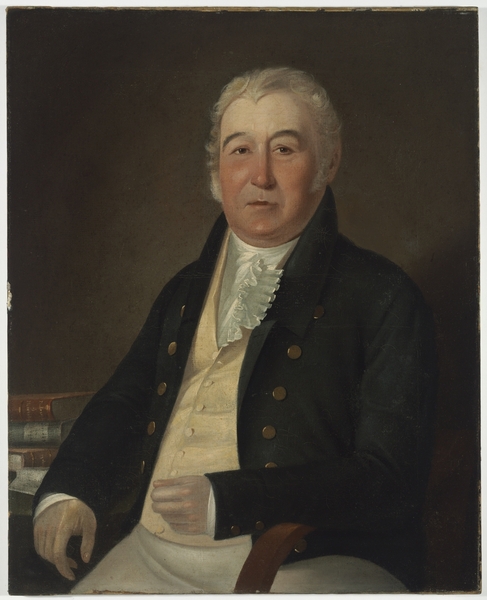 Robert Townson (1762?-1827), scholar, scientist and settler, was probably baptized on 4 April 1762 at Richmond, Surrey, England, son of John Townson, merchant. Robert's zest for natural history dictated his activities for many years. He travelled widely as a gentleman scholar, collaborating with the professors at the universities he visited. In 1791 he was elected a fellow of the Royal Society of Edinburgh. He then visited the Universities of Copenhagen and Uppsala. After contributing a paper to the Linnean Society of London in 1792 on 'The Perceptivity of Plants', he made his headquarters at Göttingen University.
Robert Townson (1762?-1827), scholar, scientist and settler, was probably baptized on 4 April 1762 at Richmond, Surrey, England, son of John Townson, merchant. Robert's zest for natural history dictated his activities for many years. He travelled widely as a gentleman scholar, collaborating with the professors at the universities he visited. In 1791 he was elected a fellow of the Royal Society of Edinburgh. He then visited the Universities of Copenhagen and Uppsala. After contributing a paper to the Linnean Society of London in 1792 on 'The Perceptivity of Plants', he made his headquarters at Göttingen University.
After plans for the study of mineralogy and geology in India fell through, Townson's thoughts turned to Australia. He was often at the home of Sir Joseph Banks and had there met William Paterson of the New South Wales Corps. His brother, Captain John Townson, also returned to England in 1800, so he had ample opportunities to learn about the new settlement. When John decided to return as a settler, Robert approached the British government. He was warmly received, informed that he was the type most urgently needed in the colony, promised land and indulgences, and allowed £100 to buy books and a laboratory for the colony. DrTownson arrived in Sydney in the Young William on 7 July 1807. Proficient in all branches of natural science and also in Latin, Greek, German, French, he was the most eminent scholar in the young colony.
Governor Lachlan Macquarie in 1811 he granted him 1680 acres (680 ha) at Botany and added 1000 acres (405 ha) near the present Minto. This became the famous Varro Ville farm, but since these grants were made on the customary condition that the land be cultivated and not sold for five years, Townson again felt aggrieved. He had been living on his capital for nearly four years and was afraid of penury. He sought permission to sell his land and return to England. In the end he remained but developed a psychopathic personality. He subordinated everything to the development of his farms, shut himself off from society, and apparently did no scientific work in New South Wales. He became 'singular' and eccentric, and his rigid economy became a byword. He also nursed undue hostility towards all who had contributed to his critical situation; Macquarie described him as 'discontented' and one of his leading opponents, though there is no evidence that Townson took part in intrigues against him.
After Macquarie departed Townson began to take his rightful place in the community. In 1822 he became a foundation vice-president of the Agricultural Society and a member of its Horticultural and Stock Fund Committees; Edward Wollstonecraft proposed him for membership of the Philosophical Society of Australasia in the same year, and though the society's records do not disclose whether or not he was elected, it is probable that he was. In 1822 he joined in the protest against the commissariat paying for purchases in dollars, and in 1824 in the memorials against the British duties on wool. In 1826 he was appointed a magistrate. His name appeared regularly on subscription lists, and headed the list of donations towards establishing the Sydney Dispensary to give free medical attention to the poor. His invitations to dinner called for an early arrival so that there could be at least two hours of conversation before the meal. The contents of his library offered for sale after his death reveal his wide interests. Varro Ville became a show place for its beauty, abundance and variety in orchard and garden; his vineyard was second only to that of Gregory Blaxland; his fine-woolled sheep and their clip were in great demand; his cattle were numerous and in the opinion of his contemporaries 'no single man had accomplished more in the rearing of stock'.
V. W. E. Goodin, 'Townson, Robert (1762–1827)', Australian Dictionary of Biography, National Centre of Biography, Australian National University, http://adb.anu.edu.au/biography/townson-robert-2743/text3879. Doctor Robert Townson / painted by Augustus Earle painted between 1825-1827, Image No.: a3540001, courtesy State Library of NSW.
JOHN BLAXLAND, Esquire, JP
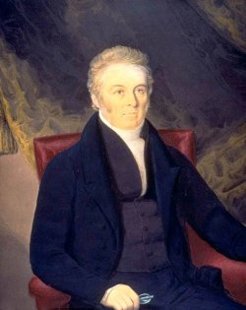 John Blaxland (1769-1845), landowner and merchant, was born on 4 January 1769, the eldest son of John Blaxland and Mary, née Parker, of Fordwich, Kent, England. After education at The King's School, Canterbury, he entered the army, rising to the rank of captain in the Duke of York's Cavalry. He resigned his commission in 1792 and lived at Newington, Kent, where he managed the family estates. Blaxland decided to emigrate because his farm resources, even when swollen by wartime prices, were inadequate for his pretensions. Moreover he became depressed at England's 'gloomy prospects'. New South Wales was fixed upon by John and his younger brother Gregory as a result of the persuasions of Sir Joseph Banks and the indulgences promised them by the Colonial Office. John agreed to invest £6000 in the colony, in return for a free passage for his family and servants, free freight for his stores and equipment, a land grant of 8000 acres (3237 ha), and eighty convicts, to be clothed and fed for eighteen months by the government. Castlereagh, writing to Governor Philip Gidley King, stressed the 'property and Education' of the Blaxlands, who could be expected to 'set useful Examples of Industry and Cultivation … and … be fit persons to whose Authority the Convicts may be properly entrusted'.
John Blaxland (1769-1845), landowner and merchant, was born on 4 January 1769, the eldest son of John Blaxland and Mary, née Parker, of Fordwich, Kent, England. After education at The King's School, Canterbury, he entered the army, rising to the rank of captain in the Duke of York's Cavalry. He resigned his commission in 1792 and lived at Newington, Kent, where he managed the family estates. Blaxland decided to emigrate because his farm resources, even when swollen by wartime prices, were inadequate for his pretensions. Moreover he became depressed at England's 'gloomy prospects'. New South Wales was fixed upon by John and his younger brother Gregory as a result of the persuasions of Sir Joseph Banks and the indulgences promised them by the Colonial Office. John agreed to invest £6000 in the colony, in return for a free passage for his family and servants, free freight for his stores and equipment, a land grant of 8000 acres (3237 ha), and eighty convicts, to be clothed and fed for eighteen months by the government. Castlereagh, writing to Governor Philip Gidley King, stressed the 'property and Education' of the Blaxlands, who could be expected to 'set useful Examples of Industry and Cultivation … and … be fit persons to whose Authority the Convicts may be properly entrusted'.
Although the British government, by sponsoring the Blaxlands, had taken a step which directly fostered private enterprise, there was no attempt to alter the colonial judicial and administrative structures to encompass a broadening of economic activity. Thus when John arrived in the colony in April 1807, he found that his capital and proposed activities were regarded with suspicion by officer-entrepreneurs of the colonial government and the New South Wales Corps. His first mistake in the eyes of the government was to ignore crop cultivation, and, in partnership with Gregory, to concentrate on the cattle industry: breeding, slaughtering, salting down (for which he produced the first suitable colonial salt), and selling meat and dairy produce. His other ventures, which Governor William Bligh disparaged as 'speculative' and 'mercantile', included sealing with the ship Brothers, of which he was part-owner with a London firm. He earned the disfavour of the commercial community as well as of the governor by his association with the former convict, Simeon Lord, but his crowning indiscretion was, after applying for a distilling licence, to offer Bligh a share in the company. Accordingly, Bligh was indifferent to Blaxland's complaints that he had received only 1290 acres (522 ha) on the Parramatta River, called Newington, and a third of the convicts due to him.
John Blaxland (1769-1845), by Richard Read State Library of New South Wales, Original : ML 308
T. H. Irving, 'Blaxland, John (1769–1845)', Australian Dictionary of Biography, National Centre of Biography, Australian National University, http://adb.anu.edu.au/biography/blaxland-john-1796/text2033, published in hardcopy 1966
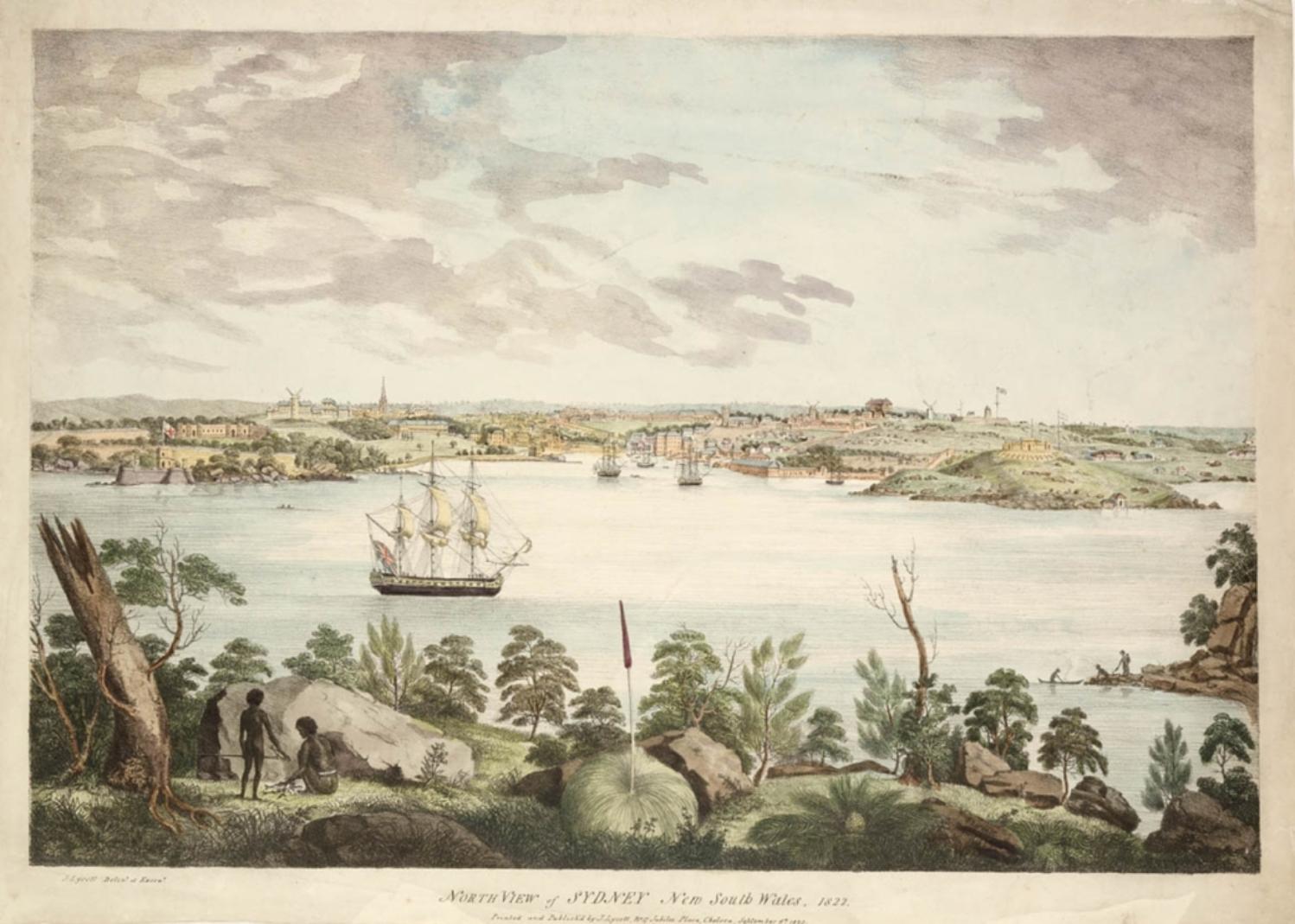
North View of Sydney New South Wales taken from the North Shore. 1822 by Joseph Lycett, ca. 1775-1828. Image No.: a128797, courtesy State Library of NSW
The Royal Easter Show Began As the Royal Agricultural Society of New South Wales - threads collected and collated by A J Guesdon
NSW Youth Week 2024: Express. Empower. Get Loud!
- share ideas
- attend live events
- have your voice heard on issues of concern to you
- showcase your talents
- celebrate your contribution to the community
- take part in competitions
- have fun!
- Express – Youth week is a chance for every young person from across NSW to be themselves! It gives young people the opportunity to showcase their talents and getting involved.
- Empower – It’s time for young people in NSW to have their voices heard on issues that matter to you. Register here to participate in the Advocate for Children and Young People’s opportunities to have your say.
- Get loud! – Get loud and celebrate together at local community events happening in your local community and across NSW.
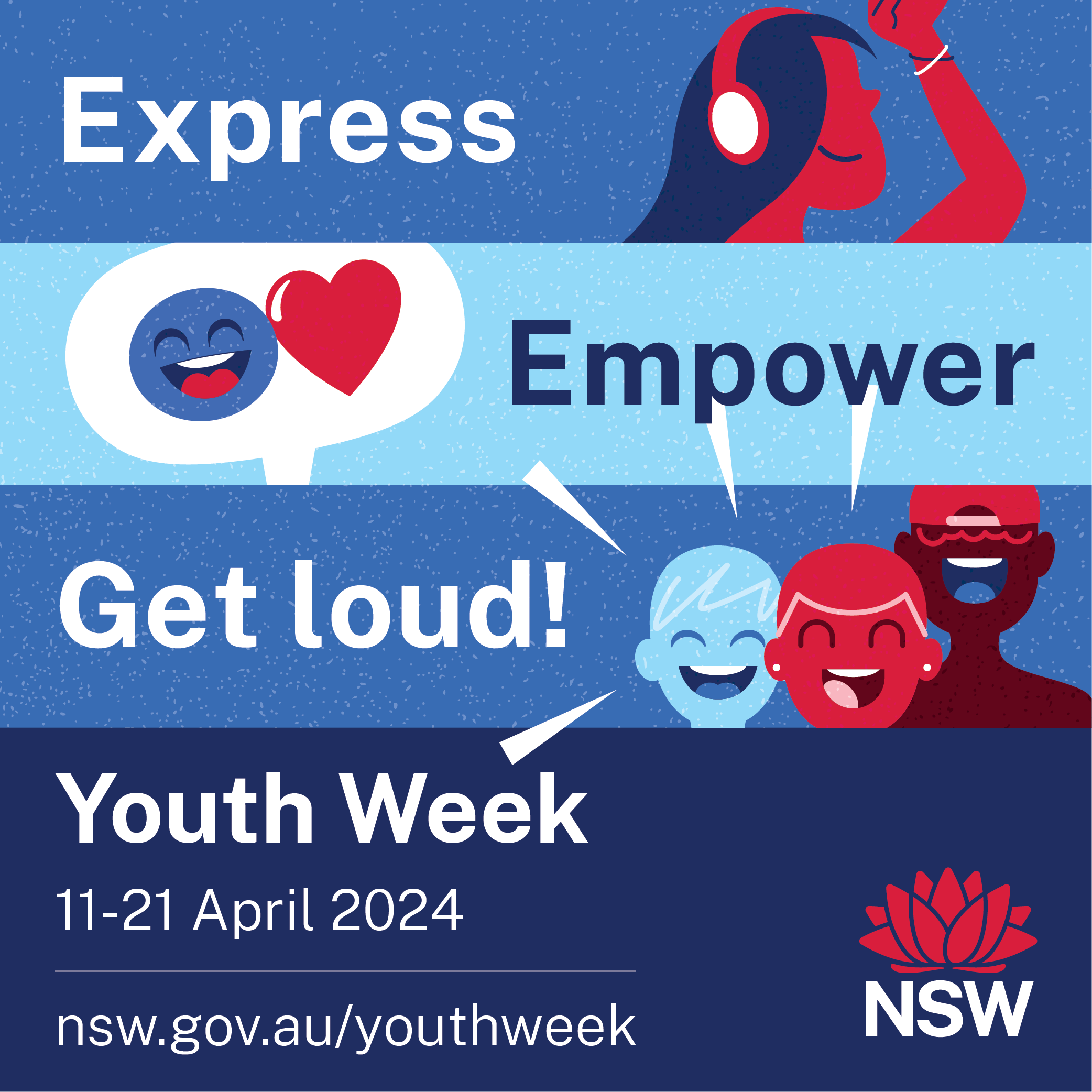
Northern Composure Band Competition: Entries Open Until March 17
- Ocean Alley
- Lime Cordiale
- Dear Seattle
- The Rions
- Crocodylus
- C.O.F.F.I.N
- Edgecliff
- A Triple J announcer plus a wide range of industry professionals
- Entries open: Thursday 22 February - Sunday 17 March
- People's choice voting open for online heats: Monday 18 March – Sunday 24 March
- Band workshop: Wednesday 20 March - Location TBC
- Semi final 1: Saturday 6 April, YoYo’s, Frenchs Forest
- Semi Final 2: Saturday 13 April, Mona Vale Memorial Hall
- Grand Final: Saturday 20 April, PCYC Dee Why
- Ensure you have read the Eligibility Criteria and all Key Information below
- Upload you video entry onto a hosting platform (eg YouTube, Vimeo)
- Fill out the registration form
- Ensure all band members are available for this year's key dates

Girls Rugby Open Day
When: Sunday, March 17th, 2-4pm
Where: Rat Park, Warriewood
Local Clubs are uniting for the ultimate girls rugby event!
We are hosting a girls' rugby union open day at Rat Park, grab your friends and head down to see what the game is all about.
Get ready to redefine what it means to be strong. It's not just about tackles and tries, it's about building unshakable confidence and making lifelong friends. We can show you that the field will be your new playground.
GUEST SPEAKERS, GAMES AND PRIZES
We've got the incredible Wallaroo, Waratah and Rat's Women joining us!
Listen to their inspiring journeys, learn from the best, and discover how rugby shaped their fearless path.
We have prize giveaways lined up, so this is your chance to score big on and off the field.
Join us for an action-packed afternoon featuring drill sessions, top Aussie female player guest speakers, and amazing prize giveaways.
Curious about the game? This is your chance to dive in and discover! Don't miss out!

Expressions Of Interest For The 2024 RPAYC Youth Development Program Are Now Available!
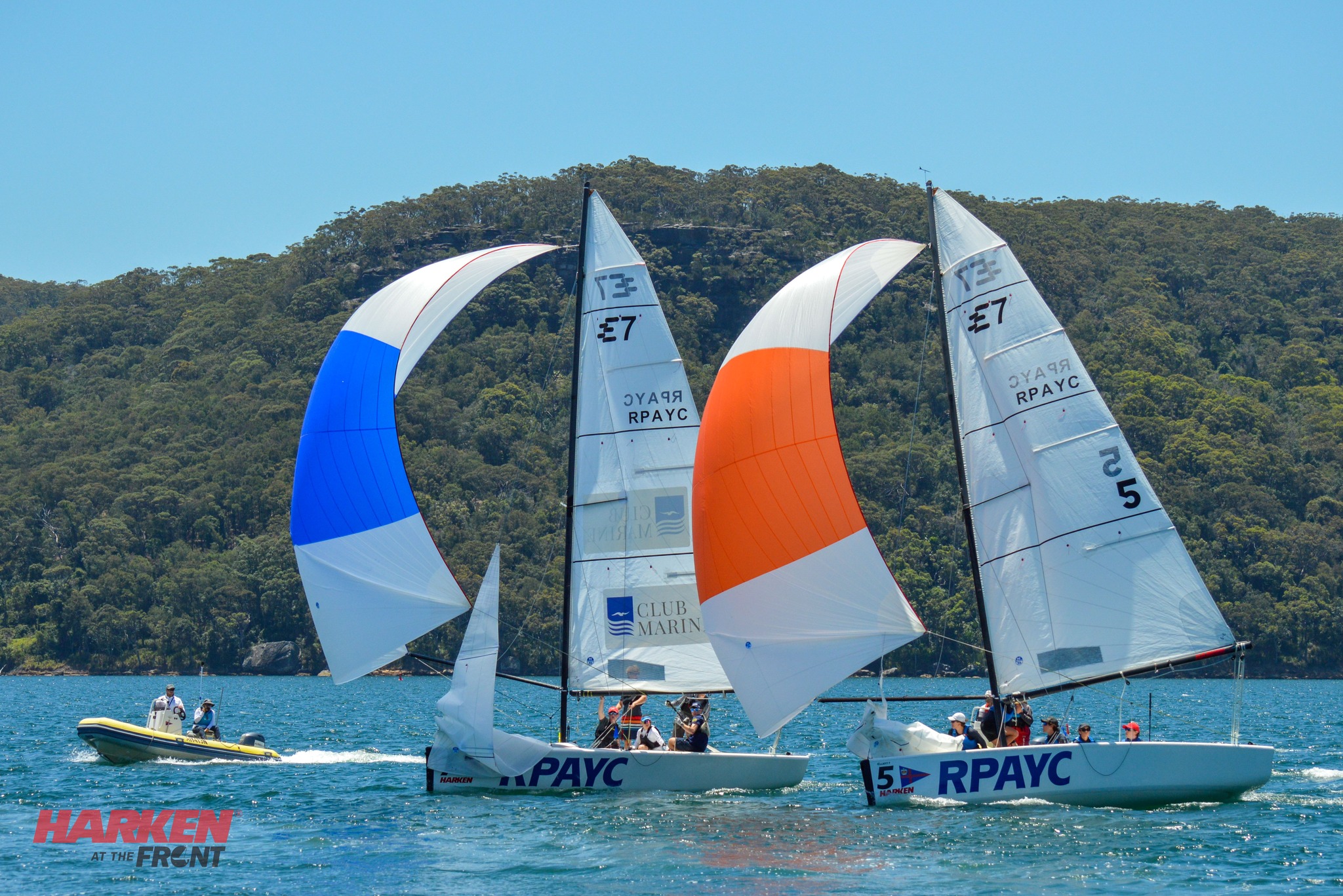
Early Childhood Workforce Given $17 Million Boost After Record Number Of Scholarship Applications
- Up to $25,000 for early childhood teaching (ECT) qualifications.
- Up to $5,000 for diploma and certificate III ECEC and OSHC qualifications.
School Leavers Support
- Download or explore the SLIK here to help guide Your Career.
- School Leavers Information Kit (PDF 5.2MB).
- School Leavers Information Kit (DOCX 0.9MB).
- The SLIK has also been translated into additional languages.
- Download our information booklets if you are rural, regional and remote, Aboriginal or Torres Strait Islander, or living with disability.
- Support for Regional, Rural and Remote School Leavers (PDF 2MB).
- Support for Regional, Rural and Remote School Leavers (DOCX 0.9MB).
- Support for Aboriginal and/or Torres Strait Islander School Leavers (PDF 2MB).
- Support for Aboriginal and/or Torres Strait Islander School Leavers (DOCX 1.1MB).
- Support for School Leavers with Disability (PDF 2MB).
- Support for School Leavers with Disability (DOCX 0.9MB).
- Download the Parents and Guardian’s Guide for School Leavers, which summarises the resources and information available to help you explore all the education, training, and work options available to your young person.
School Leavers Information Service
- navigate the School Leavers Information Kit (SLIK),
- access and use the Your Career website and tools; and
- find relevant support services if needed.
Word Of The Week: Aspire
Verb
1. direct one's hopes or ambitions towards achieving something. 2. literary; rise high; tower.
From late Middle English: from French aspirer or Latin aspirare, from ad- ‘to’ + spirare ‘breathe’.
"strive for, seek eagerly to attain, long to reach," c. 1400, aspiren, from Old French aspirer "aspire to; inspire; breathe, breathe on" (12c.), from Latin aspirare "to breathe upon, blow upon, to breathe," also, in transferred senses, "to be favorable to, assist; to climb up to, to endeavor to obtain, to reach to, to seek to reach; infuse," from ad "to" (see ad-) + spirare "to breathe".
The literal sense of "breathe, exhale" (1530s) is rare in English.
Compare suspire; to draw a long deep breath : sigh.

What we know so far about the rumoured Apple smart ring

Samsung officially announced the launch of a new smart ring-shaped wearable device, Galaxy Ring, as part of its Galaxy Unpacked event earlier this year. The ring, expected to be on sale in late summer 2024, will be able to monitor the user’s health parameters and provide insights based on the health metrics observed, which is very similar to what a smartwatch can do.
The global smart ring market is expected to grow from USD$314.52 billion (£246.3 billion) in 2023 to USD$2,570.30 billion (£2,012 billion) by 2030. So it is no surprise that Apple is now rumoured to be applying for its smart ring patents and is expected to have the product ready in time to compete with Samsung’s release.
But it might be surprising to learn that neither Samsung nor Apple are pioneers in this new wearable technology. Oura was launched in 2015 with a Kickstarter campaign for the first generation ring.
Now on its third generation, with the fourth one expected in 2024, this smart ring can measure respiratory rate, heart rate, health rate variability (HRV), blood oxygen levels, and body temperature. The ring also has an accelerator that logs the user’s activity and movement. However, the main question is: is wearable technology worth it?
What Is Wearable Technology?
Wearable devices come in many shapes and sizes, including smart watches and sports watches, fitness trackers, head-mounted displays, smart jewellery, smart clothing, and even implantable devices.
Technological advances have enabled manufacturers to access low-cost, low-power sensor technology and develop this variety of devices. At a minimum, wearable devices are equipped with sensors, software and connecting technology.
The sensors gather information from the person wearing the device, and the software gathers the data and sends it to a device with processing capacity via a wireless connection. The ecosystem on which wearable technology works is known as the Internet of Things (IoT). It is the same principle as smart technology used at home, on devices such as thermostats that can be operated from a mobile device outside the home, or smart speakers, but applied at a personal level. It is important to note that mobile devices do not process the data; it is usually sent to “the cloud” for processing, and the mobile device displays the data to the user.
What makes an IoT solution even more attractive is the interpretation of the data gathered by the sensors. For example, the Oura Ring and the Oura Membership allow users to monitor their sleep, manage stress and predict when they might get sick by monitoring body temperature and heart rate. This is all possible due to analysis of the data collected by the ring.
With advances in artificial intelligence (AI), it is expected that in 2024, there will be a boost in health tracking.

Benefits And Drawbacks
Smart rings come with sensors similar to those of a smartwatch. However, because of their proximity to large blood vessels in the fingers, smart rings can provide more accurate readings than smartwatches, because they can use the capillaries (small blood vessels) in your finger to get their readings. Another advantage of smart rings is that they have a longer battery life than smartwatches. However, smart rings are unlikely to come with GPS or a screen.
In terms of price, the cheapest version of the Oura ring starts at £299 and users must pay a membership fee of £5.99 per month, with the first month free. This is required to get all the benefits of data analysis. However, the ring will still work with the Oura mobile app. The most affordable version of the AppleWatch, the SE version, starts at £219, while the Samsung Galaxy Watch6 Bluetooth starts at £239.
Smart rings can’t and won’t be able to replicate the functionality offered by a smartwatch. However, they represent an attractive choice for users interested in health tracking, who also want a simple device with minimalistic features. Bryan Ma, the Vice President of devices research at International Data Corporation, has said: “The idea behind such rings is not so much about being cheaper than smartwatches, but instead being a much smaller and discrete device for use in cases like sleep tracking.”
The Future Of Wearable Technology?
Wearable technology will continue evolving, with a strong focus on health monitoring. For example, Microsoft has been exploring smart tattoos as the next generation of wearable tech since 2016. However, due to the labour intensive fabrication technique for gold leaf, which is used in the tattoos, researchers are now focusing on more robust, advanced, and inexpensive materials.
Researchers at the University of Washington have also developed the thermal earring. This was able to measure the user’s earlobe temperature but shows promise for other areas of monitoring, including for eating and exercise. Although not commercially available, this device demonstrates how engineers are developing new ideas for wearable devices.
Under Armour already sells running shoes embedded with Bluetooth and sensors that track run statistics such as distance and pace. The shoes also measure running from metrics such as cadence (steps per minute), ground contact time, foot strike angle and stride length.
The app provides real time audio coaching, but only focuses on cadence. In future, we can expect to see advances in smart contact lenses, smart nails, smart buttons, and many more.
Is Wearable Technology Worth It?
The expected increase in the market size of this technology shows users’ interest in monitoring their health and improving their lifestyle. Developments in the Internet of Things, in general, have improved our way of life and supported our wellbeing.
Connected devices collect, track, and store user data, which is the primary purpose of the technology. What users need to know is that many wearable devices share data with third party apps and services, and it is often unclear how this data is being used. The data can be sold to other companies or utilised for different purposes without the user’s knowledge or consent. Moreover, wearable devices can be hacked.
With this in mind, and as we have done with all new technology, users must consider the advantages of wearable technology and determine if the risks are worth taking. If security and data privacy are a concern, users are encouraged to follow all security recommendations provided by experts and manufacturers to protect their devices and research more on how their data is used and shared.![]()
Erika Sanchez-Velazquez, Deputy Head of School, Computing and Information Science, Anglia Ruskin University
This article is republished from The Conversation under a Creative Commons license. Read the original article.
TikTok claims ‘tongue scrapers’ can cure bad breath – here’s what the evidence actually says

Most of us know how important it is to brush and floss if we want a healthy smile. But some people on TikTok are suggesting that this isn’t enough – and that if you really want good oral health, you need to use a “tongue scraper”.
Tongue scraping has long been part of daily hygiene routines in many parts of the world. It involves running a hard instrument across the tongue to remove bacterial build-up and debris. Tongue scrapers come in all shapes and sizes – with some people even using their toothbrush. They remove the white coating (which contains bacteria) that builds up on the back of some people’s tongues.
Videos on social media of people advocating for the use of tongue scrapers have amassed millions of views. Many proponents claim the practice banishes bad breath. But while there’s some evidence to back these claims, the practise could also come with risks.
Everyone has communities of bacteria, fungi and even viruses living inside their mouth. This is known as your oral microbiome. These bacteria can stick to the surface of your tongue and teeth and build up in layers (known as a biofilm). Plaque is one example of a biofilm.
Poor oral health can lead to a build-up of biofilms containing certain bacterial species which cause dental decay (cavities), gum disease and bad breath. For example, a build-up of the bacteria Streptococcus mutans is associated with cavities, while a build-up of volatile sulphur compound producing bacteria (VSCs) on the tongue and gums can cause bad breath. Diets high in sugar and low in fibre can also contribute to the build-up of VSCs.
For most, brushing your teeth twice daily (for two minutes each time) and using floss or interdental brushes to clean between teeth will be enough to remove the build-up of these biofilms. These techniques are also very effective for preventing tooth decay and gum disease.
But there’s less evidence showing whether these techniques are also effective for preventing tongue biofilms and bad breath.
Tongue Scraping
A couple of reviews have shown that tongue scrapers can reduce the release of VSCs produced by the bacterial species found in the tongue’s biofilm. Tongue scrapers are also shown to be superior to a toothbrush for reducing bad breath.
So, based on the limited evidence out there, it does seem that regularly using a tongue scraper may help remove biofilms and improve bad breath. However, these reviews did find that the benefits of tongue scraping were shortlived and needed to be done using a specific technique to be effective.
Scraping your tongue once or twice a day for around 15-30 seconds is adequate. You also need to ensure you get far enough back on the tongue (where VSC-producing bacteria live), scrape back to front and keep up your regular tooth-brushing routine for the practise to be effective.
There are other caveats when it comes to tongue scraping. Bad breath isn’t only caused by VSCs. It can also be caused by cavities, tonsillitis and even stomach problems (such as acid reflux). In these instances, tongue scraping will do little to solve bad breath.

And despite their bad press, we actually need certain bacteria for good health. For example, nitrate-reducing bacterial species living on the tongue convert nitrate from the foods we eat (such as green leafy vegetables) to nitrite. This mechanism is important, since we swallow the nitrite that’s produced. The nitrite is then converted in the gut to nitric oxide, which relaxes our blood vessels and keeps blood pressure lower.
One study has suggested that tongue scraping may actually enrich the amount of nitrate-reducing bacteria on the tongue. However, this study was only conducted using a sample of 27 people, the majority of whom were dental hygiene students. It will be important for further research to be done with more participants to better determine both the potential benefits and harms of tongue scraping.
Should I Use A Tongue Scraper?
A qualified dentist would find it difficult to strongly advocate the use of tongue scrapers, due to the limited evidence supporting their use. It’s also likely that the benefits and downsides of using a tongue scraper would differ for each person. A check-up would probably be necessary before a dentist could advise – especially so they can ensure a white tongue coating isn’t due to another more serious condition, such as oral thrush or oral cancer.
Not everyone gets a tongue biofilm, either. Only around 10% of the people develop a thick tongue coating. For these people, removing this thick layer can help counter bad breath.
For others, a thick tongue biofilm may only happen at certain times – for example, during periods of illness, stress, with hormone changes, or if they change their diet. So for them, a tongue scraper may only be occasionally beneficial.
If there’s no white coating present at all, there doesn’t seem to be much point using a tongue scraper. Good oral hygiene will probably be enough to fix bad breath – and aggressive tongue scraping may actually risk making your tongue bleed. We also don’t yet fully know how tongue scraping will affect good bacteria on you tongue.
Anecdotal TikTok videos should not drive your healthcare decisions (especially if those videos haven’t been fact-checked). But in this case, TikTok may be highlighting an area where we need to do more research to better help peoples’ oral health. Producing strong evidence that tongue scrapers really do work (or don’t work), through good quality clinical studies, could lead to a change in UK guidelines in the future.
But until we know more, keep brushing your teeth twice daily for two minutes with a fluoride toothpaste and clean between your teeth with floss. Scrape your tongue, or clean your tongue with a toothbrush, with care, if you must.![]()
Zoe Brookes, Associate Professor of Dental Education and Research, University of Plymouth
This article is republished from The Conversation under a Creative Commons license. Read the original article.
From fast fashion to excessive earrings, these trends might be harmful to your health

The perilous nature of some fashion items have a long history, from the potentially hazardous heights of stilettoes to the damaging constrictions imposed by the corset. But health-harming trends aren’t a thing of the past.
Fast fashion, the making and selling of cheap clothes with short life-spans at mass volumes, has become a notorious modern-day phenomenon – so much so that in 2023, the European Union attempted to crack down on the “overproduction and overconsumption of clothes and footwear” to make clothing more sustainable and reduce worker exploitation.
Fast fashion might be cheap but its environmental costs are dear. The detrimental ecological effects of the consumer appetite for trend-driven disposable clothing – and the consequential impacts on human health – are well known. But toxic clothing is a comparatively under-reported danger of consumers’ continuing love affair with fast fashion.
Affordable, on-trend clothing is often made from synthetic materials that can irritate the skin. But throwaway fashion garments can also contain toxic chemicals including PFAS (synthetic chemicals used widely in consumer products from non-stick baking tins to clothes), azo dyes, phthalates and formaldehyde.
Approximately 8,000 synthetic chemicals are used in the fast fashion manufacturing process, with residues staying on the garments that we purchase. Alden Wicker’s 2023 book, To Dye For, reveals the unregulated use of potentially harmful chemicals and the impacts these can have on our health. Azo dyes, for example, which are restricted in the EU, can be absorbed causing a range of reported health issues.
And there are other, perhaps more surprising, potential dangers lurking in your wardrobe too.
Trainers And Sneakers
Trainers have become the most popular shoe style of the 21st-century, transcending fashion boundaries of gender, race and age. The trend for athleisure – buoyed by brand collaborations with hip-hop and pop stars such as Beyoncé, Rihanna and the pre-scandal Kanye West’s ultra-successful Adidas Yeezy line – has increased consumer demand for footwear that’s both comfortable and has cult status.
This is a trend that shows no sign of going out of fashion: according to predictions, the global sneaker industry will be worth $100 billion by 2026. But how bad can it be to value comfort as well as style?
For example, wearing trainers too much can lead to poor foot posture and the widening of feet, a condition that’s impossible to reverse. The trend for platform trainers isn’t much better: this style can be a painful strain on the feet and gait. And sock sneakers – trainers that look like thick, usually colorful socks with rubber soles attached – is the style most likely to lead to a sprained ankle.
The best bet is to opt for athletic trainers that are designed to offer a supportive fit.
Waist Trainers
Waist trainers, brought into vogue this century by Kim Kardashian, are similar to the corsets and girdles of the past. They are designed to pull the wearer’s waist in as tight as possible to achieve an eye-wateringly “snatched” look – TikTok speak for creating the illusion of a tiny, accentuated waist.
Endorsed by influential celebrities such as Nikki Minaj and Kylie Jenner, the waist trainer, if worn over a prolonged period, may help achieve a temporary hourglass figure. And like the corset, the waist trainer does seem to have some benefits – it may help improve posture, for example.
Waist trainers and similar shapewear can also give the appearance of significant weight loss. But any actual weight loss from wearing the item is most likely because of water loss through sweating and muscle atrophy – muscles in the core are used less while wearing waist-trainers, so long-term use can lead to muscle wastage.
Also, the pressure exerted on the waist and internal organs can cause appetite loss. Perhaps unsurprisingly, prolonged wearing of waist trainers can result in gastrointestinal issues such as acid reflux and, in more extreme cases, the pressure on the diaphragm can cause respiratory problems.
If that isn’t enough, wearers of waist trainers and corsets may be at risk of fainting due to reduced oxygen. There’s also a reported case of a woman who developed acute lower-limb ischemia (a serious condition usually caused by a blood clot) after wearing a waist trainer – although such extreme health outcomes are very rare.
And while the potential health risks of wearing waist trainers might seem overwhelming, a study in the International Journal of Gynaecology and Obsestrics found women who wore them following a cesarean delivery experienced less pain.
Heavy Earrings
The emergence of the “mob wife” trend, with its aesthetic signifiers of fur coats, leopard prints and chunky gold jewellery, has also popularised weighty earrings. But the regular and prolonged wearing of heavy earrings can cause elongation and thinning of the earlobe, which in extreme cases can cause the lobe to split.
To correct the damage caused by wearing excessively heavy or large earrings, lobe surgery has become one of the most common plastic surgery trends.
But it is not just heavy earrings that you may need to be wary of. Large thin hoops, although seemingly lightweight, can get caught in hair and clothes. In 2023, a TikTok video of a woman showing the tear in her earlobe caused by a large hoop earring went viral, with over 1.3 million views.
Ill-Fitting Thongs
Love them or hate them, the thong is a fashion classic. From showgirls at the World Fair in the 1930s to 2023’s whale tail trend for wearing a thong peeking out from the waistband of clothing, these notorious items have been rubbing us the wrong way for almost a century.
Renowned for being uncomfortable, it’s perhaps unsurprising that ill-fitting thongs can cause intimate irritation and chafing, especially if made from synthetic fabrics.
But it’s not all doom and gloom. Research has shown that a well-fitting thong made from natural fibres, alongside regular washing of underwear and scrupulous personal hygiene, can ensure thong-wearers enjoy their whale tails in comfort.![]()
Naomi Braithwaite, Associate Professor in Fashion Marketing and Branding, Nottingham Trent University
This article is republished from The Conversation under a Creative Commons license. Read the original article.
Want to build muscle? Why carbs could be just as important as protein

High-protein, low-carb diets have long been considered the gold standard method for gym-goers and bodybuilders aiming to gain muscle and lose fat. But one bodybuilding champion has shown that this might not necessarily be the only way of achieving a chiselled physique.
Mark Taylor, a 52-year-old bodybuilding veteran who in 2023 won the coveted “Mr Universe” title, said in a recent interview that the key to his success was actually embracing carbs.
For years, Taylor religiously stuck to a traditional high protein, low carb diet, yet he felt tired all the time. It wasn’t until Taylor abandoned this thinking and his strict diet, to prioritise carbs and more calories, that he finally achieved his dream.
While this strategy might go against the norm, what does the science say?
Building Muscle With Nutrition
To shape up and gain muscle you have to train – there’s no getting around this. Muscle gains come from progressive overload training, which means either gradually increasing the weight you lift or performing more reps or sets of an exercise.
If the training is demanding enough, muscle adaptations during the recovery period can lead to improvements over time.
More specifically, muscle growth is a balance between two processes: “muscle protein synthesis” (where new muscle tissue is made or repaired) and “muscle protein breakdown” (where muscle tissue is degraded). Because these two processes are always occurring, the rate and balance between them, will affect overall gains.
Appropriate nutrition, alongside structured training, supports these processes. Proteins are essential as they contain amino acids (such as leucine) which provide the building blocks of muscle.
Evidence highlights that daily protein intake alongside eating enough calories may be most important for overall muscle gains. Other nutrients, such as essential fats, vitamins and minerals, are also relevant to the muscle building process. Conversely, consuming fewer calories than your body needs may negatively affect your training.
After training, it has also been shown that consuming 20g-40g of “fast releasing” proteins (such as whey protein) may accelerate muscle protein synthesis in the short-term. Many gym goers also consume “slow releasing” proteins (such as casein protein) before going to sleep to reach daily protein needs or optimise recovery.
So Where Do Carbs Fit In?
While some studies show combining carbs and protein after exercise can lead to increased muscle protein synthesis, other studies show that this is not the case when compared to consuming protein alone. This is because amino acids are key to this process, and carbs simply do not provide these building blocks so cannot directly drive muscle protein synthesis.
But carbs may have an influence on the degree of muscle protein breakdown that happens. This is because carbs trigger the body to produce the hormone insulin, which has been shown to reduce protein breakdown.
However, protein also influences insulin production, creating a similar effect. So if you have sufficient protein post-exercise, you could argue there’s no need for additional carbs from a muscle building perspective. So how do we explain Taylor’s success?
Many bodybuilders tend to go through a “bulking” phase, increasing the number of calories they eat daily by around 15% or more in an attempt to increase muscle mass. This is followed by a “cutting” phase to strategically reduce body fat in order to make muscles more visible. Using a low-carb approach can promote fat loss, resulting in a lean physique. This is why many gym enthusiasts and bodybuilders opt for this method.
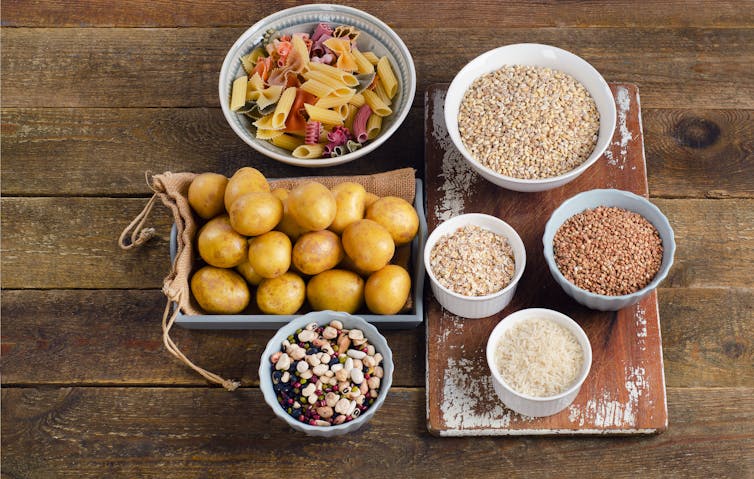
But low-carb diets also means less energy, which could lead to weakened immunity, greater fatigue and reduced performance. Low-carb diets can also disrupt menstrual function in women, and lower testosterone (needed for muscle development) – particularly in men. So these popular “cutting” strategies could be detrimental for some people.
Carbohydrates supply us with energy in the form of glucose, which is then stored in the muscle as glycogen for later use. Training in the gym can be demanding, which means we use glycogen stores to fuel us more rapidly.
This allows us to train more intensely, which indirectly influences muscle protein synthesis. If you don’t refuel with carbs and continue to train in a low-glycogen state, it may not only affect the muscle-building process, but overall training results.
Choice of carbs also makes a difference. In Taylor’s case, choosing sweet potatoes and porridge meant that his diet favoured a lower glycaemic approach.
The glycaemic index (GI) is a measure of how quickly the carbohydrates in a particular food increase blood sugar. Low GI foods (such as porridge) have a slower releasing effect. This not only affects mood, but also leads to sustained energy throughout the day – combating feelings of fatigue while benefiting other aspects of health – such as lowering blood pressure.
But while low GI foods are beneficial over the course of the day, research shows that higher GI foods (such as white pasta, bagels or granola) after hard or prolonged training support rapid recovery of glycogen. So a combination of low GI and high GI foods throughout the day could be a useful training and recovery strategy.
Athlete or not, increasing muscle mass requires work and our diet can influence this. Feeding our muscles with protein, while fuelling workouts with carbs, may well offer a more effective way to achieve your goal.
If, like Taylor, you’re not seeing the results you want, perhaps carbs are the missing piece of the puzzle.![]()
Justin Roberts, Professor of Nutritional Physiology, Anglia Ruskin University; Henry Chung, Lecturer in Sport and Exercise Science, University of Essex, and Joseph Lillis, PhD Candidate in Nutritional Physiology, Anglia Ruskin University
This article is republished from The Conversation under a Creative Commons license. Read the original article.
From malaria, to smallpox, to polio – here’s how we know life in ancient Egypt was ravaged by disease

The mention of ancient Egypt usually conjures images of colossal pyramids and precious, golden tombs.
But as with most civilisations, the invisible world of infectious disease underpinned life and death along the Nile. In fact, fear of disease was so pervasive it influenced social and religious customs. It even featured in the statues, monuments and graves of the Kingdom of the Pharaohs.
By studying ancient specimens and artefacts, scientists are uncovering how disease rocked this ancient culture.
Tutankhamun’s Malaria, And Other Examples
The most direct evidence of epidemics in ancient Egypt comes from skeletal and DNA evidence obtained from the mummies themselves.
For instance, DNA recovered from the mummy of the boy pharaoh Tutankhamun (1332–1323 BC) led to the discovery he suffered from malaria, along with several other New Kingdom mummies (circa 1800 BC).
In other examples:
- skeletal and DNA evidence found in the city of Abydos suggests one in four people may have had tuberculosis
- the mummy of Ramesses V (circa 1149–1145 BC) has scars indicating smallpox
- the wives of Mentuhotep II (circa 2000 BC) were buried hastily in a “mass grave”, suggesting a pandemic had occurred
- and the mummies of two pharaohs, Siptah (1197–1191 BC) and Khnum-Nekht (circa 1800 BC), were found with the deformed equinus foot which is characteristic of the viral disease polio.
Signs Of A Disease-Ravaged People
Amenhotep III was the ninth pharaoh of the 18th dynasty, and ruled from about 1388–1351 BC.
There are several reasons experts think his reign was marked by a devastating disease outbreak. For instance, two separate carvings from this time depict a priest and a royal couple with the polio dropped-foot.

Statues of the lion-headed goddess of disease and health, Sekhmet, also increased significantly, suggesting a reliance on divine protection.
Another sign of a potential major disease outbreak comes in the form of what may be an early case of quarantine, wherein Amenhotep III moved his palace to the more isolated site of Malqata. This is further supported by the burning of a workers’ cemetery near Thebes.
Grave goods also became less extravagant and tombs less complex during this period, which suggests more burials were needed in a shorter time frame. These burials can’t be explained by war since this was an unusually peaceful period.
Did Disease Trigger Early Monotheism?
Amenohotep’s son – “the heretic King” Akhenaten (who was also Tutankhamun’s father) – abandoned the old gods of Egypt. In one of the earliest cases of monotheism, Akhenaten made worship of the Sun the official state religion.

Some researchers think Akhenaten’s dramatic loss of faith may have been due to the devastating disease he witnessed during his childhood and into his reign, with several of his children and wives having died from disease. But we’ve yet to find clear evidence for the role of disease in shaping his theology.
There’s also no direct DNA evidence of an outbreak under his father, Amenhotep III. There are only descriptions of one in letters Amenhotep III and Akhenaten exchanged with the Babylonians.

To confirm an outbreak under Amenhotep III, we’d need to first recover pathogen DNA in human remains from this time, has been found in other Egyptian burial sites and for other pandemics.
Also, while many ancient epidemics are referred to as “plagues”, we can’t confirm whether any outbreaks in ancient Egypt were indeed caused by Yersinia pestis, the bacteria responsible for bubonic plague pandemics such as the Black Death in Europe (1347-1351).
That said, researchers have confirmed the Nile rat, which was widespread during the time of the Pharaohs, would have been able to carry the Yersinia infection.

How Were Outbreaks Managed?
Much like modern pandemics, factors such as population growth, sanitation, population density and mobilisation for war would have influenced the spread of disease in ancient Egypt.
In the case of war, it’s thought the Hittite army was weakened by disease spread when it was famously defeated by Egyptian Pharaoh Ramses the Great in the battle of Kadesh (1274 BC).
In some ways, Egyptian medicine was advanced for its time. While these outbreaks occurred long before the development of antibiotics or vaccines, there is some evidence of public health measures such as the burning of towns and quarantining people. This suggests a basic understanding of how disease spreads.
Diseases caused by microorganisms would have been viewed as supernatural, or as a corruption of the air. This is similar to other explanations held in different parts of the world, before germ theory was popularised in the 19th century.
New World, Old Problems

Many of the most widespread diseases that afflicted the ancient world are still with us.
Along with Tutankhamun, it’s thought up to 70% of the Egyptian population was infected with malaria caused by the Plasmodium falciparum parasite – spread by swarms of mosquitoes occupying the stagnant pools of the Nile delta.
Today, malaria affects about 250 million people, mostly in developing nations. Tuberculosis kills more than a million people each year. And smallpox and polio have only recently been eradicated or controlled through vaccination programs.
More work is yet to be done to detect individual pathogens in Egyptian mummies. This knowledge could shed light on how, throughout history, people much like us have grappled with these unseen organisms.![]()
Thomas Jeffries, Senior Lecturer in Microbiology, Western Sydney University
This article is republished from The Conversation under a Creative Commons license. Read the original article.
Australian music festivals are increasingly affected by climate change. But is the industry doing enough to mitigate its impact?

The Pitch Music and Arts Festival in Moyston, Victoria, was cancelled while festival-goers were already on site this weekend, after an extreme fire danger warning was issued.
Cancellations like these have become all too familiar.
The live music and festival industry is currently struggling with significant challenges, including expensive insurance premiums and the cost of living crisis impacting ticket sales.
In particular are the challenges associated with climate change, as extreme weather events becoming more frequent, severe and unpredictable.
I looked at news reports over 2022 and 2023 and found at least 22 music festivals in Australia cancelled or disrupted due to extreme weather conditions.
This trend of weather-related interruptions appears to be on the rise: over the seven years between 2013 and 2019, only ten music festivals in Australia were affected by extreme weather.
Severe weather impacts on music festivals and concerts have ranged from delays and cancellations, to the evacuation of venues and areas mid-festival or mid-performance. This will be a growing challenge for the industry.
Death, Injury And Cancellations
This is not limited to Australia, and not all extreme weather-related events result in a cancellation. In my research, I also looked at where and why events were being cancelled in the United States, finding at least 21 cancellations in 2022–23.
I also found similar cases in New Zealand, Canada, the United Kingdom, Spain and the Netherlands.
In November, we saw the tragic death of a fan due to extreme heat at Taylor Swift’s Eras Tour in Brazil.
There were more than 100 hospitalisations following a hailstorm at a Louis Tomlinson concert in Colorado last June.
At a Taylor Swift performance in Sydney, fans were temporarily evacuated and the show was delayed due to lightning strikes.
In Australia, severe weather has recently led to the postponement of major events such as the abrupt ending to Sydney’s Good Things festival due to a storm in December, and cancellation the of Strawberry Fields festival, scheduled for October 2022, due to flooding in southern NSW.
Extreme weather events are closely linked to climate change. This trend is likely going to get worse. Australia has witnessed a marked increase in the intensity, frequency and duration of heatwaves over the past 67 years, with a significant uptick observed in recent decades.
The Environmental Impact Of Festivals
There has not yet been a comprehensive carbon footprint audit of the Australian music industry, but we do know how much music can contribute to carbon emissions through research in the UK.
The UK’s live music industry produces 405,000 tonnes of greenhouse gas emissions annually.
The primary sources of these emissions are audience travel, accounting for 43%, and the operations of live music venues, contributing another 23%. This means nearly three-quarters of industry’s emissions are linked to live music performances.
The average touring DJ is responsible for 35 tonnes of CO₂ a year – more than 15 times the personal carbon budget recommended for individuals and nearly eight times the average.
In 2019 alone, 1,000 touring DJs took more than 51,000 flights around the world, generating as much CO₂ as over 20,000 households.
Music Festivals Can Make A Change
There are signs of a growing consciousness within the live music industry towards mitigating environmental impacts.
The UK’s live music sector has committed to reaching net-zero emissions by 2030.
In Australia Woodford Folk Festival and WOMADelaide have banned single-use plastics and promote recycling to minimise waste.
The live music industry can reduce its environmental impact by adopting more renewable energy, and using sustainable transport options for artists and audiences.
Engaging audiences in sustainability efforts, such as incentivising carbon offset contributions, can also amplify impact.
Other environmental concerns at festivals are less obvious but also important. Attendees often enjoy wearing glitter, not realising it is made of microplastics. Switching to biodegradable glitter is a practical solution.
Festivals also see waste from abandoned low-quality camping gear. These one-time-use tents and accessories contribute to environmental degradation and create waste management challenges. There needs to be more efforts in educating attendees on the importance of sustainable camping practices and encouraging the use of high-quality, reusable camping gear.
Tree planting has emerged as a popular strategy for music festivals and bands to offset their carbon footprint and contribute positively to the environment.
Incorporating carbon offsets into ticket pricing or offering them as voluntary options presents strategy for festivals and artists to mitigate their environmental impact.
Challenges such as rising supply chain costs and the cost of living are testing the viability of festivals. Amid these challenges, severe weather can introduce additional uncertainties.
It is important the event industry and festival-goers acknowledge their contributions to these escalating challenges, and take proactive steps towards greening music festivals.![]()
Milad Haghani, Senior Lecturer of Urban Mobility, Public Safety & Disaster Risk, UNSW Sydney
This article is republished from The Conversation under a Creative Commons license. Read the original article.
A brief guide to birdwatching in the age of dinosaurs
Abi Crane, University of SouthamptonHave you ever wondered what it would be like travel back in time to the age of dinosaurs? If you stumble upon a time machine, remember to bring your binoculars. Birdwatching is a popular hobby today, with an around 3 million participants in the UK alone, and in our modern world there are a staggering 11,000 species of birds to spot.
Despite the popularity of their modern-day descendants, we often forget about ancient birds because of their more famous dinosaur cousins.
Birds are actually a type of dinosaur. They are closely related to smaller, agile meat-eating dinosaurs such as the Velociraptor. Ancient birds came in a variety of forms, from ones with teeth and claws to species barely distinguishable from farmyard chickens.
So, if you were to point your binoculars over the heads of Triceratops and Tyrannosaurus rex, what could you spot? Here is a quick introduction to six of the most interesting ancient bird species.
Archaeopteryx
Archaeopteryx is the iconic “dino-bird” from the Jurassic period. The discovery of Archaeopteryx fossils in Germany over 150 years ago provided scientists with the first clues about the link between dinosaurs and modern birds.
At first glance, the skeleton of Archaeopteryx is just like any other meat-eating dinosaur – sharp teeth, clawed hands and a long bony tail. Surrounding the skeleton of specimens such as the Berlin Archaeopteryx (discovered between 1874 and 1876) however, are imprints of feathers which form a pair of distinctly bird-like wings.
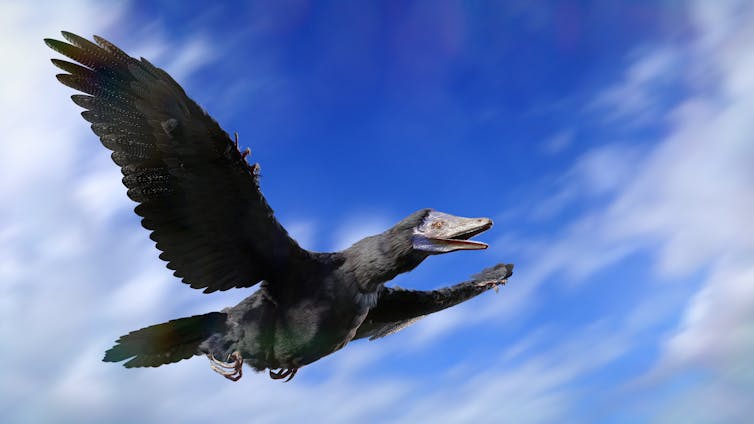
But for many years, palaeontologists debated whether Archaeopteryx could have used these wings to fly. Scientists now think it is likely that Archaeopteryx could have flown, but only in short bursts , like a pheasant. Recent technological advances have given us our first insights into dinosaur colour and studies of fossilised, pigmented cells have shown that Archaeopteryx had matt black wing feathers.
Confuciusornis
This crow-sized bird had a beak like that of modern-day birds, but still had large, dinosaur-like claws on its hands. It is thought that they lived in flocks, large numbers of which were killed by ash or gas in volcanic eruptions and preserved as fossils. Known from over 1,000 fossil specimens from China, Confuciusornis is one of the most common fossil bird species.
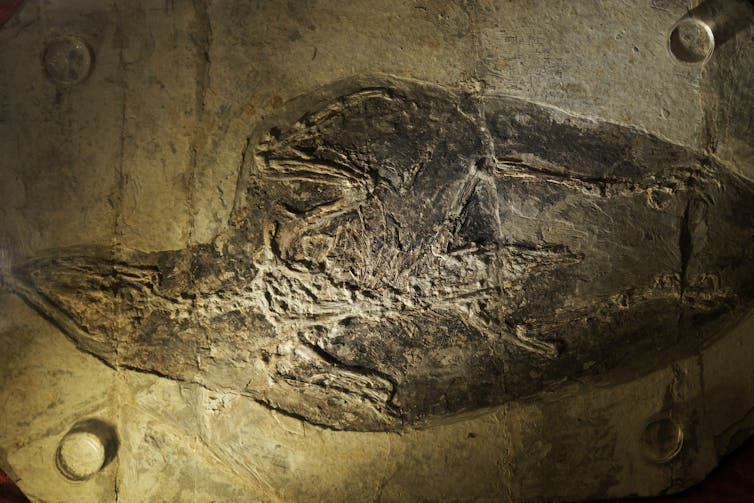
Some of these birds had a pair of tail feathers longer than their body, while others lacked these long feathers and would have looked comparatively stumpy. Scientists think these long-tailed birds were the males of the species and those with short tails were females. Like modern peacocks and peahens, the males probably used their extravagant tail feathers to woo the females.
Falcatakely
Discovered in 2020, Falcatakely, from Madagascar, would have resembled a small, buck-toothed toucan. Its oversized, banana-shaped bill only had teeth at the very tip. Although we don’t know what this buck-toothed bird would have eaten, its close relatives ate a variety of food, including fruit, fish and even larger prey.
Scientists think that birds such as Falcatakely could fly the same day they hatched from their egg, unlike birds today which spend their first weeks or months helpless in the nest.
Hesperornis
One of the weirdest birds from the age of dinosaurs, Hesperornis would have looked something like a six-foot-tall penguin with a beak full of sharp teeth. Its tiny arms would have made T rex look like a weightlifter, so it definitely couldn’t have used them to fly.
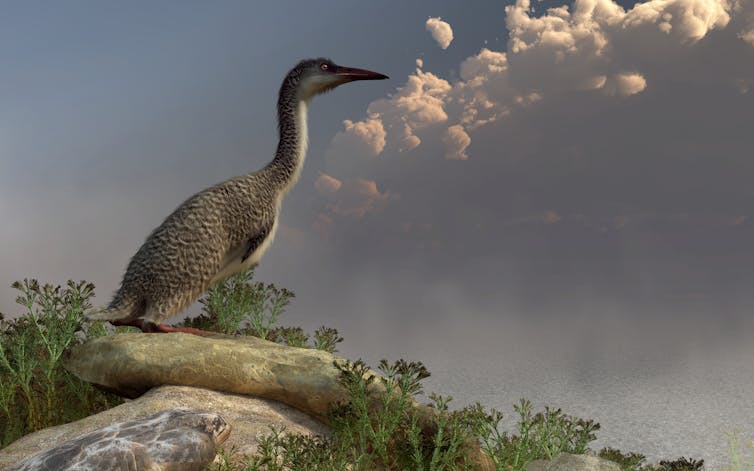
Instead, Hesperornis used its oversized feet to propel itself through the water like a modern cormorant. Out of the water, Hesperornis walked awkwardly upright and probably couldn’t travel far overland.
Vegavis And Asteriornis
Towards the end of the dinosaurs’ reign, the earliest groups of modern birds began to appear. The first of these birds to be discovered was Vegavis from Antarctica, which in the time of dinosaurs would have been covered in trees rather than ice.
It was probably an ancestor of ducks and geese and one exceptional fossil of Vegavis even has a rare preserved vocal organ. Analysis of this fossil suggested that Vegavis couldn’t make a songbird melody but could have made simple noises such as goose-like honks.
Sixty-six million years ago, not long before the asteroid impact, which caused the extinction of the non-bird dinosaurs, lived Asteriornis. This quail-sized bird from Belgium was an ancestor of modern ducks and chickens. Although it would have looked unremarkable compared to the giant swimming lizards and huge, toothed seagulls it lived alongside, this may have been to its advantage.
Scientists think that the small size of birds such as Asteriornis helped them to survive the mass extinction. Because smaller animals need less food and take less time to reproduce, these humble birds were able to survive and evolve into the birds you can see through your binoculars today.![]()
Abi Crane, Postgraduate Researcher in Palaeontology, University of Southampton
This article is republished from The Conversation under a Creative Commons license. Read the original article.
Avalon Beach Historical Society: March 2024 Meeting


Aged Care Taskforce Final Report Released
- publishing prices and services
- only allowing agreement to higher fees for agreed services to be made after a participant has entered care
- a cooling off period and regular review opportunities to ensure the resident still wants the services and can still use them.
- the recommendations outlined in this report to improve the viability of the aged care sector
- tasking the Aged Care Quality and Safety Commission with supporting innovation by identifying innovative practices and promoting these across the sector.
- a review of its pricing in rural and remote areas
- costing of the supplement for everyday living
Aged Care Taskforce Report 'Misses The Mark': NSWNMA
Aged Care Taskforce Report Released
Federal Government Must Deliver Robust Aged Care Act Without Delay
- Enforceable rights of older people that address the current power imbalance
- A robust, independent complaints system
- Transparency of timelines and funding
- Strong regulations and penalties for those found guilty of not upholding the rights of older people
- A guaranteed right to aged care visitors at all times
- Ensure the new Act delivers supports for family and friend carers
- Strengthening diversity requirements, including through the referencing to the existing Aged Care Diversity Framework.
What will aged care look like for the next generation? More of the same but higher out-of-pocket costs
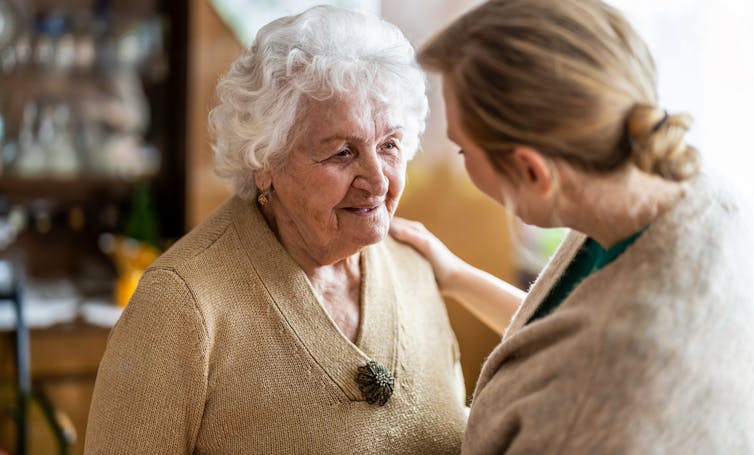
Aged care financing is a vexed problem for the Australian government. It is already underfunded for the quality the community expects, and costs will increase dramatically. There are also significant concerns about the complexity of the system.
In 2021–22 the federal government spent A$25 billion on aged services for around 1.2 million people aged 65 and over. Around 60% went to residential care (190,000 people) and one-third to home care (one million people).
The final report from the government’s Aged Care Taskforce, which has been reviewing funding options, estimates the number of people who will need services is likely to grow to more than two million over the next 20 years. Costs are therefore likely to more than double.
The taskforce has considered what aged care services are reasonable and necessary and made recommendations to the government about how they can be paid for. This includes getting aged care users to pay for more of their care.
But rather than recommending an alternative financing arrangement that will safeguard Australians’ aged care services into the future, the taskforce largely recommends tidying up existing arrangements and keeping the status quo.
No Medicare-Style Levy
The taskforce rejected the aged care royal commission’s recommendation to introduce a levy to meet aged care cost increases. A 1% levy, similar to the Medicare levy, could have raised around $8 billion a year.
The taskforce failed to consider the mix of taxation, personal contributions and social insurance which are commonly used to fund aged care systems internationally. The Japanese system, for example, is financed by long-term insurance paid by those aged 40 and over, plus general taxation and a small copayment.
Instead, the taskforce puts forward a simple, pragmatic argument that older people are becoming wealthier through superannuation, there is a cost of living crisis for younger people and therefore older people should be required to pay more of their aged care costs.
Separating Care From Other Services
In deciding what older people should pay more for, the taskforce divided services into care, everyday living and accommodation.
The taskforce thought the most important services were clinical services (including nursing and allied health) and these should be the main responsibility of government funding. Personal care, including showering and dressing were seen as a middle tier that is likely to attract some co-payment, despite these services often being necessary to maintain independence.
The task force recommended the costs for everyday living (such as food and utilities) and accommodation expenses (such as rent) should increasingly be a personal responsibility.
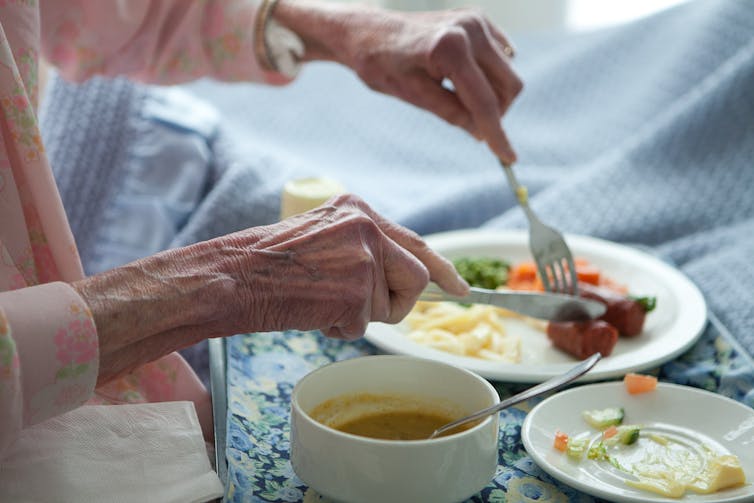
Making The System Fairer
The taskforce thought it was unfair people in residential care were making substantial contributions for their everyday living expenses (about 25%) and those receiving home care weren’t (about 5%). This is, in part, because home care has always had a muddled set of rules about user co-payments.
But the taskforce provided no analysis of accommodation costs (such as utilities and maintenance) people meet at home compared with residential care.
To address the inefficiencies of upfront daily fees for packages, the taskforce recommends means testing co-payments for home care packages and basing them on the actual level of service users receive for everyday support (for food, cleaning, and so on) and to a lesser extent for support to maintain independence.
It is unclear whether clinical and personal care costs and user contributions will be treated the same for residential and home care.
Making Residential Aged Care Sustainable
The taskforce was concerned residential care operators were losing $4 per resident day on “hotel” (accommodation services) and everyday living costs.
The taskforce recommends means tested user contributions for room services and everyday living costs be increased.
It also recommends that wealthier older people be given more choice by allowing them to pay more (per resident day) for better amenities. This would allow providers to fully meet the cost of these services.
Effectively, this means daily living charges for residents are too low and inflexible and that fees would go up, although the taskforce was clear that low-income residents should be protected.
Moving From Buying To Renting Rooms
Currently older people who need residential care have a choice of making a refundable up-front payment for their room or to pay rent to offset the loans providers take out to build facilities. Providers raise capital to build aged care facilities through equity or loan financing.
However, the taskforce did not consider the overall efficiency of the private capital market for financing aged care or alternative solutions.
Instead, it recommended capital contributions be streamlined and simplified by phasing out up-front payments and focusing on rental contributions. This echoes the royal commission, which found rent to be a more efficient and less risky method of financing capital for aged care in private capital markets.
It’s likely that in a decade or so, once the new home care arrangements are in place, there will be proportionally fewer older people in residential aged care. Those who do go are likely to be more disabled and have greater care needs. And those with more money will pay more for their accommodation and everyday living arrangements. But they may have more choice too.
Although the federal government has ruled out an aged care levy and changes to assets test on the family home, it has yet to respond to the majority of the recommendations. But given the aged care minister chaired the taskforce, it’s likely to provide a good indication of current thinking.![]()
Hal Swerissen, Emeritus Professor, La Trobe University
This article is republished from The Conversation under a Creative Commons license. Read the original article.
Could many dementia cases actually be liver disease?
Ashwin Dhanda, University of PlymouthA recent study of US veterans found that 10% of those diagnosed with dementia actually had a liver condition called hepatic encephalopathy (HE) – a treatable condition.
The liver can be damaged by several things, including alcohol, fatty deposits and hepatitis viruses. When the damage continues over several years, the liver becomes scarred (known as cirrhosis) and, at a certain point, can no longer perform one of its critical tasks: detoxifying the blood. Toxins (mainly ammonia) can build up and get into the brain, interfering with brain function. This is HE.
HE can be very mild and difficult to diagnose. Symptoms can be as subtle as changes in sleep pattern or irritability. As the condition worsens, symptoms such as forgetfulness, disorientation or confusion emerge. In its most severe form, it can cause coma and death.
Once diagnosed, it can be treated, initially with laxatives that help to remove ammonia and other toxins that accumulate in the gut. This is followed by treatment with an antibiotic (rifaximin) that kills some of the harmful ammonia-producing bacteria in the gut. If it is very severe, HE can even be a reason to have a liver transplant.
Silent Condition
HE is easier to spot and treat if we know the person has cirrhosis. The trouble is that cirrhosis is a silent condition until it reaches very late stages when the liver starts to fail. HE is much harder to diagnose in the general population. The symptoms of change of mood, behaviour, confusion and forgetfulness are also all seen in people with dementia.
Dementia is a condition caused by long-term damage to brain function. This is most commonly caused by reduced blood supply to the brain because of damage to small blood vessels through diabetes or high blood pressure (vascular dementia). Other forms of dementia include Alzheimer’s disease, where deposits damage the brain causing typical symptoms of forgetfulness and confusion.
The new US study examined medical records of former soldiers treated by the Veterans Health Administration over ten years with a diagnosis of dementia made on at least two separate occasions.
The team looked at clinical data including blood results from this group and used them to calculate an FIB-4 score (a score based on liver blood results and age), which can be used to predict liver damage. Over 175,000 people were included in the analysis. Of these, 10% (18,390 people) had a FIB-4 score of more than 3.25 (an accepted cut-off for the diagnosis of liver scarring).
The researchers found that a high FIB-4 score was more common in those with viral hepatitis and heavy alcohol users – risk factors for liver disease.
A high score was less likely in people who had diabetes, high blood pressure or kidney disease – all risk factors for dementia. This suggests that people with a high FIB-4 score may actually have liver disease with HE causing their symptoms rather than dementia.
The researchers went on to confirm these findings by looking at a separate group of people that were assessed for dementia at their hospital and found similar results, with 9% having a high FIB-4 score and potential cirrhosis.
This study suggests that around 10% of people diagnosed with dementia may instead have underlying silent liver disease with HE causing or contributing to the symptoms – an important diagnosis to make as HE is treatable.
Important New Avenue
It is the first study of its kind to analyse routinely collected health data in this way. However, we should treat these results with some caution.
First, the data is from military veterans – 97% male and 80% white ethnicity – and hence not representative of the wider population. Second, FIB-4 was used as a marker of cirrhosis. It is a useful score that is easily calculated, but accuracy depends on the cause of liver disease and is lower in older people. Finally, having a high FIB-4 score does not necessarily mean that the person has HE.
This study opens an important new avenue of research. It raises the awareness of checking for liver disease in people with general symptoms of dementia. This is likely to be a growing problem as the rates of both dementia and cirrhosis are increasing. But we still need better data to fully understand the number of people with HE incorrectly given a diagnosis of dementia and how best to identify and treat them.![]()
Ashwin Dhanda, Associate Professor of Hepatology, University of Plymouth
This article is republished from The Conversation under a Creative Commons license. Read the original article.
Helping Seniors Make Safer Transport Choices
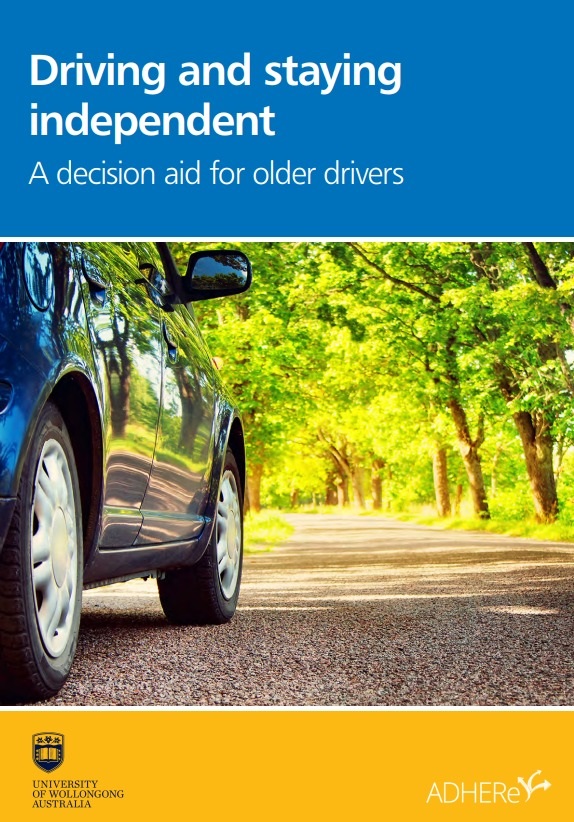
Council's Seniors Festival 2024
Avalon Beach Ladies Probus Club: April 2nd 2024 Speaker
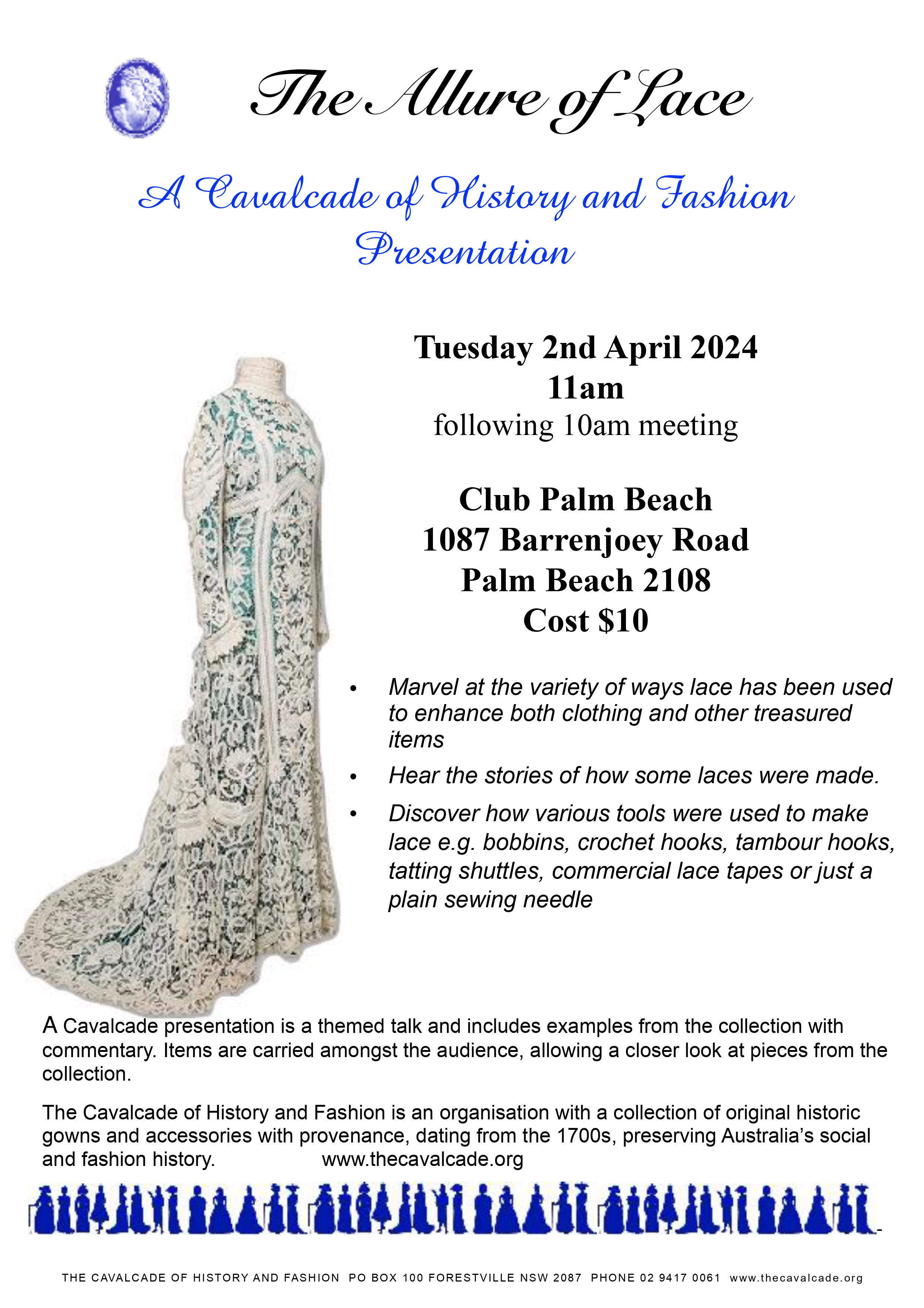
Pan Pacific Masters Games 2024

Celebrate Seniors Festival - March 11-24

Computer Pals For Seniors At Narrabeen: What Is AI?

Dr. Scamps Offering Free Anti-Scam Seminar
The ‘Bank of Mum and Dad’ is exposing older Australians to the risk of financial abuse
Julia Cook, University of Newcastle and Peta S. Cook, University of TasmaniaThis article is part of The Conversation’s series examining the housing crisis. Read the other articles in the series here.
Young Australians who would have once been locked out of home ownership are increasingly relying on the so-called Bank of Mum and Dad to get a deposit or to guarantee a bank loan.
The Bank of Mum and Dad has become so large as a home loan enabler that the Productivity Commission says if it was an actual bank it would be somewhere between the fifth and ninth biggest mortgage lender.
While not all home loan assistance from parents is in the form of gifts, the Productivity Commission says the number of children receiving them from parents has doubled in the past 20 years.
Although this is helping young Australians get into the housing market (perhaps at the expense of pushing up housing prices), it is far from clear whether such financial assistance works well for the parents providing the support.
Transfers Of $5,000 To $500,000
Financial elder abuse is the third most common form of elder abuse in Australia. The perpetrators of elder abuse are most likely to be adult children, with sons more likely to commit financial elder abuse than daughters.
Yet mortgage brokers, financial advisers and even government officials appear to be encouraging older people to provide financial help to adult children wanting to buy homes without considering whether there might be consequences for the parents.
To find out how intergenerational financial assistance works, we conducted interviews with 52 parents and adult children who have recently given or received financial assistance with home ownership.
The amounts transferred ranged from A$5,000 to $500,000. The average was $75,000. Some amounts were much higher.
The common themes in our interviews were a lack of clarity about whether the payments were gifts or loans, the mischaracterisation of loans as gifts, and undocumented agreements entered into without any documentation or legal advice.
‘Gifts’ Offered Without Legal Advice

Most lenders want older Australians to provide a “gift letter” stating the money they are providing to their adult child is a gift rather than a loan.
This is because a loan would reduce the amount the adult child could borrow from their lender, which may make it harder for them to get a mortgage.
Parents may feel obligated to provide “gift letters” even when they and their adult children regard the transfer as a loan.
There are no requirements for parents to obtain independent legal advice before signing such a letter and no cooling-off period.
Few of the parents we spoke to sought legal or financial advice.
Travis, aged 58 – who provided $50,000 to his son – told us:
No, didn’t need to. But I guess we didn’t think about it. We didn’t consider doing that, no. But it’s family, so it’s not needed, I don’t think.
Rosa, who became a guarantor to her daughter and also provided $10,000 to her son, said she “didn’t think about it too much”.
I just thought, why not, I guess. It’s no worries to me, and it really helps them along. […] I didn’t think about it too much because it was a simple process, really. And you do anything for your children.
Little Protection From The Banks
Australia’s Banking Code of Practice does little to encourage banks to support parents who provide financial assistance with home ownership to their children.
While it commits banks to “taking extra care” with customers who are experiencing elder abuse, the only documentation usually required for transfers from parents is a statutory declaration (gift letter) written by the parent to the adult child’s lending institution, which may be a different bank.
The code acknowledges that older people’s banks may only become aware of their circumstances “if you tell us about them”.
Shame, and the desire to avoid getting their adult children into trouble, make it unlikely that older people will report financial abuse to their bank.
Loans Become Unintended Gifts
Many of the parents we talked to found it difficult and uncomfortable to talk about money. As a result, the parents and adult children often had different understandings of whether the assistance was a gift or a loan, and when (if at all) it would be repaid even when it was a loan.
This ambiguity extended to the parents’ financial positions, with most of the adult children in our study having very little understanding of whether their parent(s) could afford to assist them without compromising their own financial wellbeing.
John (aged 59) told us he gave $150,000 to his daughter and her partner to help them purchase a property.
When we asked his daughter Caroline (aged 32) whether the money was a gift or a loan, she responded, “a loan, yeah, definitely a loan.” However, when asked whether she had begun repayments she responded:
Not yet. I’m not quite sure, but I think we will work it out when it comes to it.
When we asked John the same question, he responded:
Yes, that’s a good question. We said loan, but I’m never going to see that money [laughs]. Maybe a little bit of it, but not the full amount. Definitely not. But we’ll see.
John’s decision to present the assistance as a loan, despite the expectation it would not be repaid in full, was echoed by multiple participants.
Although their reasoning varied, in general, donors who framed the assistance as a loan did so to either manage their children’s feelings of entitlement, to help their children develop “good” saving habits, or to try to avoid their children feeling dependent or infantilised.
The reasoning behind differing views of whether money is a gift or a loan is less important than the more general point that financial assistance of this type is often not defined clearly from the outset.
Little Legal Protection
Legally, in the absence of evidence to the contrary, funds provided by Australian parents to their children are presumed to be gifts.
This unfortunate presumption carries the assumption older adults’ money will be “passed down” to their children, representing this as the default state of affairs in the absence of evidence otherwise.
It means older adults’ money is represented as not entirely their own, and puts the burden of proof on them to prove that what they had understood to be a loan was a loan – a task made more difficult by the existence of a “gift letter” and the potential of financial elder abuse.
Our study does not find that intergenerational financial assistance is inherently exploitative, but it does point to risks – risks made more likely by the lack of protection offered to parents by banks and the legal system, their understandable desire to help their adult children, and the presumption that financial transfers are “gifts”.![]()
Julia Cook, Senior Lecturer in Sociology, University of Newcastle and Peta S. Cook, Senior Lecturer in Sociology, University of Tasmania
This article is republished from The Conversation under a Creative Commons license. Read the original article.
Russia is about to hold another presidential election. It needn’t bother
Matthew Sussex, Australian National UniversityTime for an early announcement: Vladimir Putin has won the upcoming Russian presidential election on March 15–17. It’s hardly a spoiler. Russian elections have been performative exercises in phoney democracy for many years now, and this latest round of theatre promises to be no different.
Official state analysts peg Putin’s likely support at around 75%. His only rivals are state-permitted and largely endorse both his platform and leadership. They include the Communist Party’s ageing Nikolai Kharitonov, who is polling around 4%, and Leonid Slutsky, the comparatively spry candidate from the misnamed Liberal Democratic Party of Russia (it’s actually an ultra-nationalist party), who is polling about the same.
Perhaps the most “liberal” candidate on the ballot is Vladislav Davankov, the deputy chair of the State Duma – Russia’s lower house of parliament. Davankov has called for peace talks in Ukraine “on our terms, and with no roll-back”, and his main campaign slogan is the rather vague “Yes to changes!”. He is expected to receive perhaps 5% of the vote.
As Russians obediently line up to cast what amounts to little more than a mandatory expression of fealty, the only real questions worth asking are:
is there any semblance of opposition left?
and what kind of leader Putin will be in his fifth full term as president?
No Real Opposition Figures Left
There is increasing evidence that Putin will become even more repressive. The Kremlin has overseen the elimination or marginalisation of any charismatic individual who might serve as a hub for popular opposition, and hence pose a threat to Putin – either on the ballot, or off it.
The death of Alexei Navalny in a Siberian prison camp certainly sent that message, underscored by the arrests of several people who attended his funeral.
But throughout Putin’s tenure, plenty of other challengers, dissidents or opponents have been executed or attacked. They include:
Boris Nemtsov, the popular moderate politician assassinated in 2015
Anna Politkovskaya, the human rights journalist shot dead in her apartment in 2006
Natalya Estemirova, the anti-war activist kidnapped and killed in 2009
Sergei Magnitsky, the lawyer who uncovered evidence of massive corruption and died after being beaten and denied medical care in 2009
Aleksandr Litvinenko, the former intelligence agent poisoned with polonium in 2006
Sergei Skripal and his daughter Yulia, who were poisoned with Novichok in the United Kingdom in 2018
and the convenient plane crash that killed Wagner leader Yevgeny Prigozhin last year.
Other potential challengers have been ostracised or imprisoned. Nemtsov’s protégé, Vladimir Kara-Murza, for example, was arrested in 2022 and subsequently imprisoned for 25 years.
And so far this year, the Kremlin has jailed the elderly human rights campaigner Oleg Orlov for “discrediting the military”; issued an arrest warrant for the exiled Russian author Boris Akunin for being a “foreign agent”; and labelled the exiled Russian chess grand master Garry Kasparov an “extremist and terrorist”.
In just the last day, Navalny’s former chief of staff, Leonid Volkov, has been hospitalised in Lithuania after being sprayed in the face with tear gas and beaten repeatedly with a hammer.
Elections Mean Very Little
The Kremlin has persisted with the charade of free elections throughout Putin’s rule, but with recent changes to this year’s ballot, those who have proven too popular have found themselves disqualified.
The ex-TV journalist Yekatarina Duntsova, for example, was barred from running due to “violations” in the paperwork for her candidacy. She had been widely scorned as a Kremlin stooge, even though she planned to run on an anti-war platform.
So, too, was Boris Nadezhdin, who attracted significant attention for his pledge to end the war in Ukraine peacefully. But he also ran afoul of Russia’s Central Electoral Commission, which alleged he had failed to collect the necessary 100,000 signatures to qualify as a candidate.
In the end, the political pantomime around who gets to contest Russia’s elections really doesn’t matter.
There has been ample evidence of systemic electoral fraud in Russia for years. This includes ballot stuffing, “carouselling” (bussing voters to different booths to vote multiple times) and simple vote-rigging.
As early as 2011, United Russia – Putin’s de facto party of power in the parliament – was winning an unlikely 99% of the vote in Chechnya.
In the 2018 presidential elections, millions of votes were recorded in districts that had surprisingly precise turnout figures of 85%, 90% and 95%. Some 1.5 million votes (about 2% of the total) simply appeared as “extras” after the final day of voting.
Evidently irked by repeated findings from monitors for the Organisation for Security and Cooperation in Europe (OSCE) about the lack of freedom in Russian elections, the Kremlin simply denied them access in 2024.
Putin The Autocrat
It is often said that a marker of authoritarian governments is they generally tend to tolerate dissent. Autocratic governments, on the other hand, do not. That’s because they are the sole custodians of political power. Anyone seeking to challenge that is – by definition – an enemy.
Putin is embracing the autocratic type in his next stanza as president. That makes him incredibly dangerous. Now 71 years old, he has deliberately not anointed a successor, but has bound the fortunes of Russia’s leadership cadres to his own via political blood pacts.
He has created a polity comprised of serfs who compete for his attention, among whom he can place no trust. As the embodiment of Russia’s political gravity, his expectations of utter loyalty will increase. Every failure and setback will only serve to deepen a despotic determination to nourish his delusions of grandeur.
As Russia’s electoral circus unfolds in slow motion, we are already witnessing signs of this. In recent days, former president Dmitry Medvedev prominently displayed a future map of Ukraine. The majority of it was swallowed by Russia, with Medvedev noting that “historic parts of Russia need to come home”.
Around 40% of government spending is now going to the war in Ukraine. And alarm bells have sounded in both Europe and the US that Putin’s ultimate aim is to fracture the West, either through war or the threat of it.
The only way to respond to Putin, therefore, is to resist him as vigorously as possible. After his sham election, he will preside over a regime that may exude strength, but is both fragile and brittle. Should this edifice come down, the results will be both terrible and terrifying for Russians.
But it increasingly seems that will be Putin’s legacy: not as Russia’s champion, but its wrecker.![]()
Matthew Sussex, Associate Professor (Adj), Griffith Asia Institute; and Fellow, Strategic and Defence Studies Centre, Australian National University
This article is republished from The Conversation under a Creative Commons license. Read the original article.
What can we expect from six more years of Vladimir Putin? An increasingly weak and dysfunctional Russia
William Partlett, The University of MelbourneThere is very little drama in Russia’s upcoming presidential election this weekend. We all know Vladimir Putin will win. The only real question is whether he will receive more than 75% of the vote.
It could be tempting to see these results as a sign of the strength of the Russian system. Recent gains by the Russian army in Ukraine seem to further support this.
But my own research – soon to be published in a forthcoming book – shows the election results and Russia’s military gains in Ukraine hide a much more problematic reality for the country.
Russia’s system of government is not only undemocratic, rights abusing and unpredictable. It is also increasingly dysfunctional, trapped in a cycle of poor quality and weak governance that cannot be solved by one man, no matter how much power he has.
The Constitutional Dark Arts
The weakness stems from the hyper-centralisation of power in Russia around the president.
This centralisation is the product of an increasingly common logic that I call the “constitutional dark arts”. This logic generally holds that democracy and rights protection are best guaranteed in a constitutional system that centralises authority in one elected leader. This line of thinking is present in many populist, authoritarian countries, such as Hungary and Turkey.
The foundation of this kind of system in Russia is the 1993 Constitution. It was drafted by then-President Boris Yeltsin and his supporters (many in the West) as an expedient for dismantling communism and implementing radical economic reforms. As such, it contains a number of rights provisions and democratic guarantees, alongside provisions that centralise vast power in an elected Russian president.
Yeltsin (and his Western supporters) described this system as democratic because it made the president answerable to the people. They also argued that rights provisions would allow courts to limit any abuses by the centralised state.
These reformers hoped Yeltsin could use this concentrated power to build democracy in Russia. Thirty years later, however, we can see how this use of the “constitutional dark arts” backfired spectacularly.
Since 2000, Putin has ruthlessly deployed this centralised authority to eliminate any checks on power. He has also transformed elections, the media and the courts from sources of accountability into mechanisms to project the image of strong presidential power.
The upcoming presidential election is just the most recent example.
Poor Quality Governance In Russia
Although this centralised system has allowed Putin to dominate politics, it fosters weak and poor governance, particularly outside Moscow. At least two factors are at play.
First, centralised decision-making in Russia is often made using incomplete or false information. Russia’s full-scale invasion of Ukraine in 2022 is an example. It was based on intelligence that the operation would be over quickly and Ukrainians would likely welcome Russian forces.
Second, centralised directives are delegated to under-resourced, incompetent and weak institutions. Russia’s response to the COVID-19 pandemic was disastrous, in large part due to the poorly resourced regional authorities who were overwhelmed by a crisis of this scale.
This dysfunction has been a central message of the political movement led by the opposition leader Alexei Navalny. Before his death last month, Navalny and his team harshly criticised the corruption and weakness of the Russian regime and its inability to fix roads, provide health care and adequately pay teachers or doctors.
This message was potent, making Navalny the first opposition politician to build a broad coalition that spanned Russia’s 11 time zones.
This broad coalition frightened the Kremlin to such an extent that it led to Navalny’s poisoning in August 2020. Although it remains to be seen how his political movement responds to his death, this central criticism of the government remains one of its most potent messages.
Although it’s impossible to get independent polling on domestic issues during the Ukraine war, it does appear Putin and his administration are concerned about this weakness. In his February 29 address to parliament, Putin tacitly acknowledged these problems, promising new national projects to improve infrastructure, support families and enhance the quality of life.
These kind of promises, however, are unlikely to be implemented. Putin has traditionally promised these kinds of changes around presidential elections. But, when it comes to implementing them, Russia’s regional sub-units are often given no resources to do so.
With so much money now going to the war, it is unlikely the latest set of promises will be any different.
An Increasingly Dysfunctional Russia
With Putin soon to start his fifth presidential term, this centralisation and personalisation of power is only going to increase.
Externally, this centralisation is likely to produce an increasingly unpredictable Russia, led by a man making decisions on the basis of an increasingly paranoid world view and incorrect or manipulated information. As former German Chancellor Angela Merkel once described Putin, he is really “living in another world”.
This is likely to lead to more foreign policy adventurism and aggression. It will likely foster harsher repression of any dissenting voices inside Russia, as well.
We are also likely to see an increasingly dysfunctional Russia, one in which roads, housing, schools, health care and other infrastructure will continue to deteriorate, particularly outside of Moscow.
This extends to the military, which remains weak despite its recent battlefield gains. For instance, Russia’s overly centralised command structure has decimated the officer class and led to stunning losses of equipment. Although Russia has managed to muddle through by relying on its vast human and industrial resources, these systemic problems are taking a serious toll on its fighting capacity.
Despite escalating repression, these problems pose an opportunity for a democratic challenger, particularly when Putin is inevitably replaced by another leader.
Russia’s dysfunctional government is also an important reminder for Western media, policymakers and commentators. While it should not serve as a reason for complacency, highlighting Russia’s poor governance is an important tool in combating the Kremlin’s carefully curated image of power and control.![]()
William Partlett, Associate professor of public law, The University of Melbourne
This article is republished from The Conversation under a Creative Commons license. Read the original article.
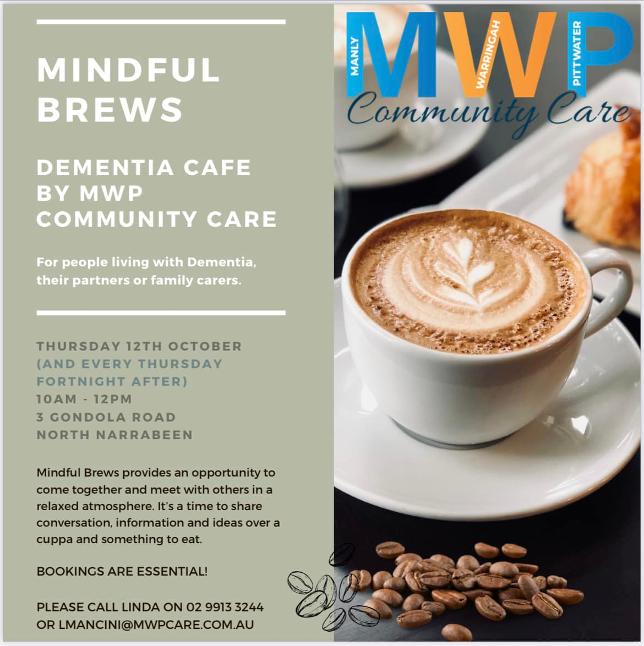
Pittwater-Narrabeen Parkinson’s Support Group
Short-Term Exposure To High Levels Of Air Pollution Kills 1 Million Globally Every Year: Monash University
 Every year, more than one million deaths globally occur because of exposure to short-term (hours to days) fine particulate matter (PM2.5) in air pollution, according to a new report, with Eastern Asia reporting more than 50 per cent of deaths attributable to short-term PM2.5 globally.
Every year, more than one million deaths globally occur because of exposure to short-term (hours to days) fine particulate matter (PM2.5) in air pollution, according to a new report, with Eastern Asia reporting more than 50 per cent of deaths attributable to short-term PM2.5 globally.- Asia accounted for approximately 65.2 per cent of global mortality due to short-term PM2.5 exposure
- Africa 17.0 per cent
- Europe 12.1 per cent
- The Americas 5.6 per cent
- Oceania 0.1 per cent
Blood-Based Marker Developed To Identify Sleep Deprivation: Monash University
Cost Of Living And Digital Economy Shape 2024-25 Compliance And Enforcement Priorities: ACCC

Fertility: Skin Cell Turned Into An Egg - Research Sheds Light On New Strategy To Treat Infertility
Indigenous fire management began more than 11,000 years ago: new research
Cassandra Rowe, James Cook University; Corey J. A. Bradshaw, Flinders University, and Michael Bird, James Cook UniversityWildfire burns between 3.94 million and 5.19 million square kilometres of land every year worldwide. If that area were a single country, it would be the seventh largest in the world.
In Australia, most fire occurs in the vast tropical savannas of the country’s north. In new research published in Nature Geoscience, we show Indigenous management of fire in these regions began at least 11,000 years ago – and possibly as long as 40,000 years ago.
Fire And Humans
In most parts of the planet, fire has always affected the carbon cycle, the distribution of plants, how ecosystems function, and biodiversity patterns more generally.
But climate change and other effects of human activity are making wildfires more common and more severe in many regions, often with catastrophic results. In Australia, fires have caused major economic, environmental and personal losses, most recently in the south of the country.
One likely reason for the increase of catastrophic fires in Australia is the end of Indigenous fire management after Europeans arrived. This change has caused a decline in biodiversity and the buildup of burnable material, or “fuel load”.
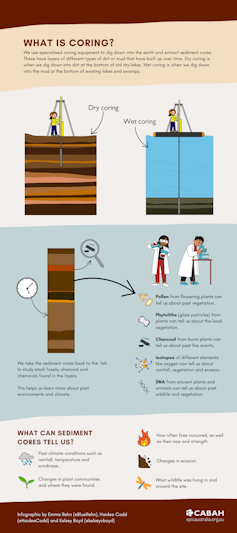
While southern fires have been particularly damaging in recent years, more than two-thirds of all Australia’s wildfires happen during the dry season in the tropical savannas of the north. These grasslands cover about 2 million square kilometres, or around a quarter of the country.
When Europeans first saw these tropical savannas, they believed they were seeing a “natural” environment. However, we now think these landscapes were maintained by Indigenous fire management (dubbed “firestick farming” in the 1960s).
Indigenous fire management is a complex process that involves strategically burning small areas throughout the dry season. In its absence, savannas have seen the kind of larger, higher-intensity fires occurring late in the dry season that likely existed before people, when lightning was the sole source of ignition.
We know fire was one of the main tools Indigenous people used to manipulate fuel loads, maintain vegetation and enhance biodiversity. We do not know the time frames over which the “natural” fire regime was transformed into one managed by humans.
A 150,000-Year Record Of Fire And Climate
To understand this transformation better, we took an 18-metre core sample from sediment at Girraween Lagoon on the outskirts of Darwin. Using this sample, we developed detailed pollen records of vegetation and charcoal, and paired them with geochemical records of climate and fire to reveal how fire patterns have changed over the past 150,000 years.
Now surrounded by suburbs, Girraween Lagoon (the “Place of Flowers”) is a significant site to the Larrakia and Wulna peoples. It is also where the crocodile-attack scene in the movie Crocodile Dundee was filmed.
The lagoon was created after a sinkhole formed, and has contained permanent water ever since. The sediment core we took contains a unique 150,000-year record of environmental change in Australia’s northern savannas.
The core records revealed a dynamic, changing environment. The vegetation around Girraween Lagoon today has a tall and relatively dense tree canopy with a thick grass understory in the wet season.
However, during the last ice age 20,000–30,000 years ago, the site where Darwin sits now was more than 300 km from the coast due to the sea level dropping as the polar ice caps expanded. At that time, the lagoon shrank into its sinkhole and it was surrounded by open, grassy savanna with fewer, shorter trees.
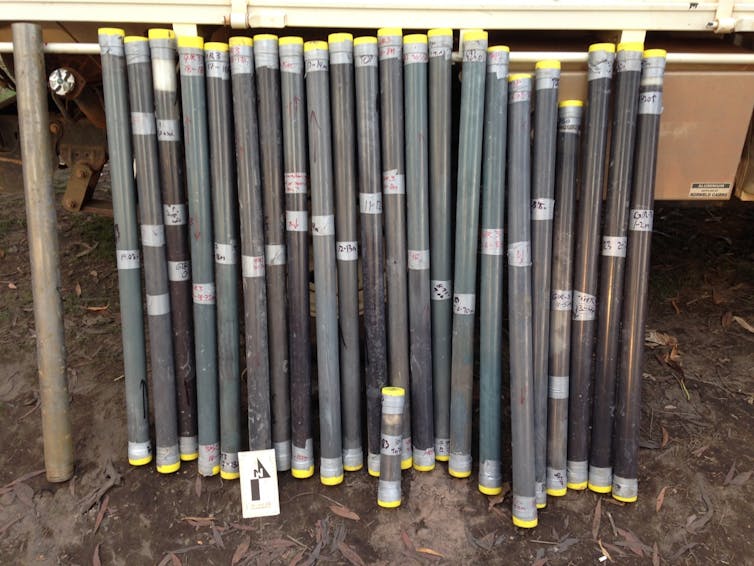
Around 115,000 years ago, and again around 90,000 years ago, Australia was dotted with gigantic inland “megalakes”. At those times, the lagoon expanded into a large, shallow depression surrounded by lush monsoon forest, with almost no grass.
When Human Fire Management Began
The Girraween record is one of the few long-term climate records that covers the period before people arrived in Australia some 65,000 years ago, as well as after. This unique coverage provides us with the hard data indicating when the natural fire regime (infrequent, high-intensity fires) switched to a human-managed one (frequent, low-intensity fires).
The data show that by at least 11,000 years ago, as the climate began to resemble the modern climate that established itself after the last ice age, fires became more frequent but less intense.
Frequent, low-intensity fire is the hallmark of Indigenous fire regimes that were observed across northern Australia at European arrival. Our data also showed tantalising indications that this change from a natural to human-dominated fire regime occurred progressively from as early as 40,000 years ago, but it certainly did not occur instantaneously.
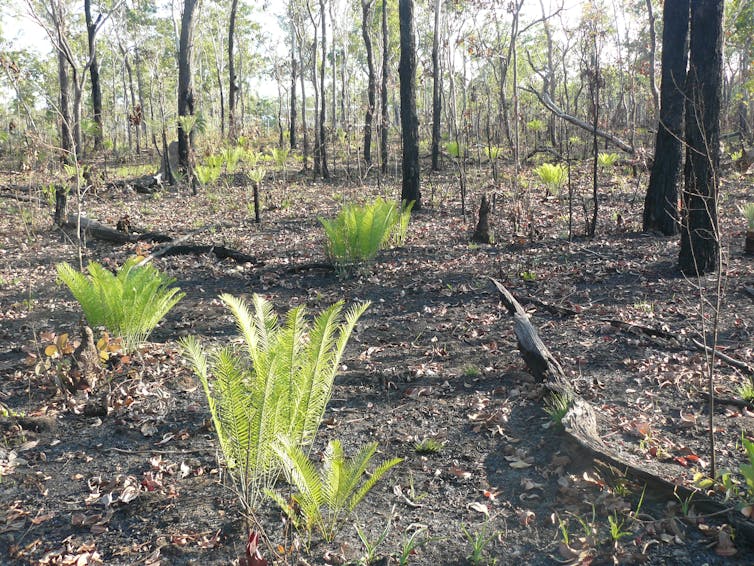
Unlocking Girraween’s secrets with modern scientific techniques has provided unprecedented insights into how the tropical savannas of Australia, and their attendant biodiversity, coevolved over millennia under this new Indigenous fire regime that reduced risk and increased resources.
The rapid change to a European fire regime – with large, intense fires occurring late in the dry season – abruptly regressed patterns to the pre-human norm. This ecosystem-scale shock altered a carefully nurtured biodiversity established over tens of thousands of years and simultaneously increased greenhouse gas emissions.
Reversing these dangerous trends in Australia’s tropical savanna requires re-establishing an Indigenous fire regime through projects such as the West Arnhem Land Fire Abatement managed by Indigenous land managers. By implication, the reintroduction of Indigenous land management in other parts of the world could help reduce the impacts of catastrophic fires and increase carbon sequestration in the future.![]()
Cassandra Rowe, Research Fellow, James Cook University; Corey J. A. Bradshaw, Matthew Flinders Professor of Global Ecology and Models Theme Leader for the ARC Centre of Excellence for Australian Biodiversity and Heritage, Flinders University, and Michael Bird, JCU Distinguished Professor, ARC Centre of Excellence for Australian Biodiversity and Heritage, James Cook University
This article is republished from The Conversation under a Creative Commons license. Read the original article.
2024 could be the year the Fair Work umpire properly values women’s work – here’s how
Lisa Heap, RMIT UniversityThis International Women’s Day, it is time to call on Australia’s workplace umpire, the Fair Work Commission, to finally close the gender pay gap.
Half a century after the commission’s predecessor granted women “equal pay for equal work” in a landmark case in 1969, the gap remains between 12% and 21%.
Amendments to the Fair Work Act by the incoming Labor government in 2022 gave it new tools to close the gap by addressing the undervaluation of work in traditionally female-dominated occupations.
If it uses these tools to their full potential, 2024 will be a landmark year in the genuine achievement of equal pay for equal work.
What We’ve Been Doing Hasn’t Much Worked
Traditionally in Australia, addressing gender-based undervaluation has relied on two approaches.
The first has been to argue the business case for gender equality – convincing employers they’ll be rewarded for “doing the right thing”.
The second has been to bring equal pay cases to tribunals.
Unfortunately, neither approach has been successful. In particular, pushing for equal remuneration through tribunals has been time-consuming and expensive.
These tribunals, historically working on models of male full-time wage earners, have struggled to understand the undervaluation of work performed predominantly by women.
The Commission’s New Tools
The commission’s act has been rewritten to require it to
promote job security and gender equality.
It also has the power to make equal remuneration orders either on its own initiative or on application in order to bring about equal pay for work of equal or comparable value.
A further new development is the establishment of expert panels to assist in gender-related cases. Advice from gender experts should assist in overcoming historical gender biases in commission decisions.
Perhaps the most promising tool is the change to the commission’s modern awards objective, which requires it to eliminate gender-based undervaluation of work and provide workplace conditions that facilitate women’s full economic participation each time it reviews an award.
Among other things, this requirement is likely to result in provisions that ensure part-time work is treated equally to full-time work and ensure a better balance between work and caring responsibilities.
Amending awards is likely to be particularly important for women given that almost three in five of the workers on awards are women. Men are mainly on negotiated agreements.
If the commission wanted to, it could hold a wide-ranging inquiry into the many factors that have contributed to gender-based undervaluation of women’s work.
It could also review entire industries and occupations that are female-dominated, upgrading multiple awards at the same time. This would avoid lengthy and costly reviews of individual awards.
What’s Likely In 2024
The Fair Work Commission’s resolve to make lasting change will be tested by several matters currently before it.
The commission is due to issue its final decision in the case lodged by the Australian Nursing and Midwifery Federation, the Health Services Union, and the United Workers Union on the value of the work done by workers in aged care.
An initial interim decision delivered in 2022 awarded some – but not all – of these workers a 15% increase, finding that work in feminised industries had been historically undervalued and the reason for that undervaluation is likely to be gender-based".
Workplace Relations Minister Tony Burke backed the decision, saying it was merely the “first step”.
Another application, for nurses and midwives outside of aged care, was lodged by the Australian Nursing and Midwifery Federation in February this year.
The commission has already started the process of grappling with gender-based undervaluation in modern awards, commissioning research that documents the segregation of women and men into different occupations and industries.
Further research documenting the history of a select group of female-dominated modern awards and identifying the extent to which common elements indicate gender-based undervaluation, is due to be released in April.
It will feed into the annual wage review due by the middle of the year.
How To Be Bold
Gender-based undervaluation of women’s work won’t be eradicated by incremental adjustments.
Here are three bold steps the commission could take:
grant a minimum interim 12% increase (one estimate of Australia’s national gender pay gap) across the board for female-dominated awards in this year’s annual wage review
develop new systems for classifying work and ascribing work value, breaking with the previous standards built around skills and qualifications in male dominated occupations
better consider the uneven bargaining power in industries such as nursing where governments fund care work and try to restrain costs.
The changes to the Fair Work Act that allow multi-employer bargaining are a start, but unlikely alone to correct the undervaluation of women’s work.
In female-dominated industries where collective bargaining is non-existent or ineffective, the commission should step in and further increase wages.
The Fair Work Commission has been given the tools. This should be the year it applies them.![]()
Lisa Heap, Doctoral Researcher RMIT University; Senior Researcher Centre for Future Work at the Australia Institute, RMIT University
This article is republished from The Conversation under a Creative Commons license. Read the original article.
Australia’s restrictive vaping and tobacco policies are fuelling a lucrative and dangerous black market
James Martin, Deakin University and David Bright, Deakin UniversityAustralia currently has the most restrictive tobacco and vaping policies in the developed world. Australian smokers are taxed at one of the highest rates among comparable nations, with taxes set to further increase at rate of 5% per year. Meanwhile, Australia is the only country to have a prescription model for accessing vaping products.
These policies have begun to attract international attention. The UK government, for example, recently announced increased taxes on tobacco and vaping products, while the Labour opposition has vowed to emulate Australia’s prescription model if it wins this year’s election.
Australia’s policies have been backed by some medical experts as a means to drive down and eventually eliminate smoking and vaping. There has been much alarm around youth vaping, in particular.
While arguably well-intentioned, the increasing taxes and restrictions on cigarettes and vaping products have resulted in an unintended and dangerous outcome – the rise of a lucrative and expanding black market for these products.
Tobacco ‘War’ Unfolding In Victoria
Emerging black markets tend to attract established organised crime groups, which have the capacity to use violence to enforce contracts, collect debts and threaten competitors.
Over the past six months, for instance, there have been more than 40 firebombings of stores selling illicit tobacco and vapes across Victoria. In October, police said the killing of Melbourne man in a drive-by shooting was also linked to the underworld war over illegal tobacco products. Reports of standover tactics and extortion targeting tobacco shop owners are also on the rise.
According to police, this serious criminal activity is being committed at the behest of rival criminal networks who are engaged in a “turf war” for control of the lucrative trade.
Since October, police have searched almost 70 stores believed to be involved in the illegal tobacco trade, seizing more than 100,000 vapes with an estimated street value of A$3.2 million, along with 3.2 million cigarettes.
While most of the violence associated with the black market appears to be taking place in Victoria, this is a national problem. Last month in Sydney, health authorities seized over 30,000 vapes and 118,000 cigarettes with a estimated street value of $1.1 million.
These numbers may sound impressive, but they represent a drop in the ocean of the total black market. Authorities estimate the size of the illicit vape market could be worth up to $500 million in Victoria alone.
The Economics Of The Black Market
The black market for illicit tobacco and vaping products has been driven by economic forces on both the supply and demand side.
On the demand side, smokers are disproportionately concentrated among lower socio-economic groups. Many are unable or unwilling to pay the ever-increasing prices for cigarettes.
People who vape are also largely rejecting the government’s prescription model, with 87% reporting they source their vapes illegally.

This demand is only likely to increase as cigarette prices increase further and prescription vapes become even less appealing with the introduction of new flavour restrictions.
On the supply side, economic models suggest traffickers of illicit products are attracted to opportunities that present the lowest risks and highest rewards.
Similar to drugs like cocaine, the importation of illicit tobacco offers attractive profits. The difference is that while importing large quantities of cocaine can lead to substantial prison sentences, the penalties for the importation of illicit tobacco are not as severe.
Vapes are similarly low risk and highly profitable. They can be purchased wholesale from China for as little as $2.50 and sold “on the street” in Australia for more than ten times that amount.
The Limits And Dangers Of Prohibition
These economic realities suggest it is unlikely law enforcement agencies will be able to effectively tackle the black market under current government settings.
The Australian Border Force is already stretched beyond capacity tackling the booming illicit drug market. So, even if eight out of ten consignments of illicit vapes are intercepted at the border (an unrealistically high proportion on the best of days), the two that make it through are sufficient for traffickers to make a profit.
And while law enforcement agencies have made inroads with arrests of black marketeers and seizures of their products, these are often quickly replaced so trafficking operations can continue unabated.
As previous examples of prohibition on alcohol and other drugs have demonstrated, the dangers of black markets extend beyond systemic violence. Other harms include the influx of inferior and adulterated products, which can pose even more health risks than legal tobacco products. Young people also have greater access to vapes as black market retailers ignore restrictions on sales to minors. (It should be noted, though, that many retailers may be doing so under duress.)
Added to this is the risk of criminalisation of consumers. A teenager in NSW was recently arrested, for example, following an altercation with police over his possession of a vape.
Then there is the lost tax revenue from tobacco goods sold under the counter, which the Taxation Office estimated at $2.3 billion in 2021-22.
The Australian public and policymakers, as well as other countries considering emulating our policies, need to be mindful of these risks and the implacable economic forces that are driving the black market.
Australia’s tobacco and vaping policies have transformed two largely legal and peaceful markets into increasingly dangerous and uncontrolled ones. The situation could even get worse in the absence of meaningful legislative reform, enhanced multi-agency cooperation, nationally consistent policy platforms and the winding back of some restrictions.
As the history of prohibition has taught us time and again, there is a “sweet spot” in restricting the sale of harmful products – one that limits access and reduces harm, but is not so onerous as to create a large black market. The violence unfolding on our streets suggests our current tobacco and vaping polices are failing to strike this balance.![]()
James Martin, Senior Lecturer in Criminology, Deakin University and David Bright, Professor of Criminology, Deakin University
This article is republished from The Conversation under a Creative Commons license. Read the original article.
Prefabricated and build-to-rent houses could help bring rents down
Ameeta Jain, Deakin UniversityThis article is part of The Conversation’s series examining the housing crisis. Read the other articles in the series here.
Australia’s rental vacancy rate has hit a historic low of close to zero. The latest estimate from SQM Research is 1.1%. The latest estimate from the property listing firm Domain is 0.7%.
As would be expected with hardly any of Australia’s rental properties vacant and available for rent, rents have soared – at first in 2022 only for newly advertised properties, and later for properties in general as measured by average rents.
The Bureau of Statistics measure of average capital city rents climbed 7.3% throughout 2023. It would have climbed by more – by 8.5% – had the bureau not taken account of the increased rent assistance in the May budget, which depressed recorded rents by 1.2%.
Demand Surged While New Supply Sank
Vacancy rates have fallen and rents have climbed because the demand for living space has surged; at first in the aftermath of lockdowns as Australians sought accommodation with fewer housemates and more home office space, and later as borders reopened and Australia’s population swelled.
At the same time, the number of dwellings completed dived in response to shortages of both labour and materials.
Before COVID about 50,000 new dwellings were completed per quarter. Since then, completions have rarely exceeded 45,000.
Tweaking Tax Concessions Would Do Little To Help
While the Australian Greens are pressing the government to wind back capital gains tax concessions and limit negative gearing in order to wind back home prices, there’s little reason to think the changes would do much to reduce rents.
Half of all Australian landlords negatively gear by making a net loss on rental income in order to profit later from concessionally taxed capital gains. Attacking these tax concessions would be likely to cause some of them to reconsider being landlords.
But if they sold, more renters would be able to buy and stop renting, leaving the balance of renters and properties for rent little changed.
Rent Assistance And Caps Won’t Much Help Either
While there is popular support for increasing rent assistance, and while it has materially cut rents paid over the past year, it won’t create more rental properties.
Very big increases in rent assistance might even lift rents further by increasing the amount renters are able to pay. However, the effect is unlikely to be big because Commonwealth rent assistance is restricted to welfare recipients.
Rent caps or freezes don’t increase supply either, and run the risk of encouraging a black market in bidding to pay rents over the legally sanctioned cap.
What’s Needed Is More Homes, In The Right Places
The government’s new Housing Australia Future Fund and associated agreements are intended to support the delivery of 20,000 new social and 20,000 new affordable homes over the next five years.
Separately, the Commonwealth and the states have agreed to an ambitious target of 1.2 million “new well-located homes” over the next five years, up from 918,200 over the past five years.
The Commonwealth has set aside A$3 billion for “performance-based funding” to the states paid at the rate of $15,000 for each new well-located home they deliver in excess of their share of 1 million new homes in five years.
If the states and territories are able to deliver 1.2 million homes over five years rather than 1 million, Grattan Institute analysis suggests rents will be 4% lower than they would have been.
NSW is displaying the sort of initiative that will be needed. The state is allowing developers of projects worth more than A$75 million to build taller buildings with more accommodation as long as they use 15% of the floor space for affordable housing.
NSW is also allowing denser development within 400 metres of 31 train stations.
Build-To-Rent Would Help
In Australia, most rental properties (even apartments) are owned by individual so-called “mum and dad” investors.
Overseas in the United States and Europe, they are more likely to be owned by corporations who build entire blocks to lease.
These corporations are more concerned about long-term returns than individual owners who want the flexibility to sell, so they tend to offer long-term leases on better terms.
In last year’s budget the government offered build-to-rent tax rules which the Property Council of Australia says could create thousands of extra homes.
On one hand, they are unlikely to be homes for low-income renters. Developers require commercial returns. On the other hand, an increasing number of renters have high incomes.
The Australian Housing and Urban Research Institute says while in 1996 households with incomes worth $140,000 a year or more in today’s dollars accounted for only 8% of renters, by 2021 they accounted for 24%.
Pre-Fabs Could Also Help, And More Apprentices
Another thing that would help is encouraging the use of prefabrication to cut construction times and costs, using locally sourced materials.
Prefabricated homes were used to house migrants after the second world war. More recently they have been used to house NSW flood victims.
They will still require skilled builders and tradespeople, who are in short supply. Only about half of enrolled apprentices complete their training, and the dropout rate has been climbing.
The government has announced an in-depth review of Australia’s system of apprenticeship support. It’s due to report later this year.
It might also help to prioritise the migration of tradespeople. It’s hard to build more homes in the right places, but that’s what we need.![]()
Ameeta Jain, Associate Professor, Deakin Business School, Deakin University
This article is republished from The Conversation under a Creative Commons license. Read the original article.
Let’s not kid ourselves that private investors or super funds will build the social housing we need
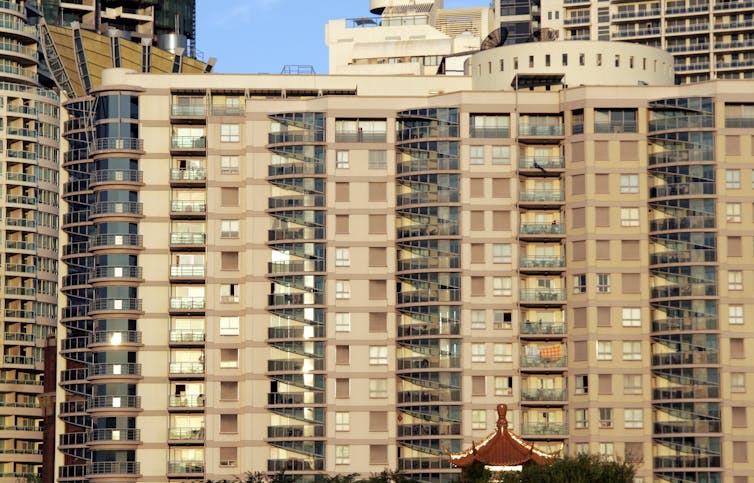
This article is part of The Conversation’s series examining the housing crisis. Read the other articles in the series here.
Treasurer Jim Chalmers is leading a push to get private investors to help build more social and affordable housing. But we shouldn’t kid ourselves about where the money will come from.
The defining feature of social and affordable housing is a big rental subsidy for the tenant, which no private investor will ever volunteer to pay. In the end, government – that is, taxpayers – will always foot the bill.
The sooner we accept this, the better. Wishful thinking that private investors will wear the cost of rental discounts risks making the limited government subsidies available for housing less effective.
We Need More Social Housing
Social housing – where rents are typically capped at 30% of tenants’ incomes – makes a big difference to the lives of many vulnerable Australians.
Yet Australia’s stock of social housing – currently about 430,000 dwellings – has barely grown in 20 years, during which time the population has increased by 33%.
A stagnant stock means there is little “flow” of available housing to catch people going through hardship, who then face prolonged, agonising waits while struggling to afford to keep a roof over their head.
But It’s Expensive
The main reason our social housing stock has stagnated is the expense.
Social housing offers a big rental discount, or subsidy, to tenants.
In Australia, the gap between the subsidised rent and the private market rent is about $15,000 per rental per year.
Because the subsidy to tenants is ongoing, the cost to governments is ongoing. That means that every extra 100,000 social housing dwellings costs an extra $1.5 billion every year.
The same goes for subsidised “affordable” housing, where rents are typically set at 20-25% below the market rate, and which are available to many low- and some middle-income earners.
If the tenant is getting a discount on the market rate, the government will pay for that somewhere along the line.
Private Investors Won’t Wear The Subsidy Gap
Australia has $3.5 trillion of superannuation savings – the fourth-largest retirement savings pool in the world – but practically none of it is invested in Australian housing. The Treasurer wants to change that.
He’s talked a big game about encouraging private capital, including super funds, to invest specifically in social and affordable housing.
But no super fund should forego returns for its members by paying the subsidy gap for social or affordable housing out of members’ pockets.
It would be incompatible with superannuation funds’ core objective – maximising returns for their members – which funds are obligated by law to prioritise.
Private Investors Prefer Affordable To Social Housing
If we make encouraging private investment in social and affordable housing the goal, we risk misallocating the scarce government subsidies we have.
Most super funds, and other investors, would typically prefer to invest in affordable, rather than social housing.
Doing so lets investors finance more homes for any given quantity of government housing subsidies that are available, while taking on less-disadvantaged tenants who are seen as less risky.
We’ve been here before: the National Rental Affordability Scheme spent $3.1 billion channelling subsidies to private investors for affordable housing.
Grattan Institute estimates suggest the scheme paid an extra $1 billion in windfall gains to investors, above and beyond the cost of the discounted rents offered to tenants, who typically weren’t the most needy.
Super Funds Could Make Social Housing More Expensive
Super funds can help finance the construction of new social housing via loans to community housing providers – as four major funds have recently agreed to do.
But these loans are likely to be on fully commercial terms.
They are deals attractive to federal and state governments worried about taking on more debt.
But they are also likely to make social housing more expensive to deliver because governments can borrow at lower rates than the returns sought by funds.
Governments Can’t Avoid Their Responsibility
Ultimately, governments have to foot the bill for social and affordable housing. And our priority should be social, rather than affordable housing, since its targeted at people at serious risk of becoming homeless.
The sooner that truth is acknowledged, the sooner we can get on with funding subsidies and the less time we will waste on trying to coax private investors into being something they’re not.
The best way to boost funding for social housing would be to double the size of the Housing Australia Future Fund from $10 billion to $20 billion
The government-owned fund uses borrowed money to invest in stocks and bonds and uses the income to cover the social housing subsidy gap.
It makes use of the higher return the government can get from investing than from retiring debt, in the same way as the government’s Future Fund.
Doubling the size of the Housing Australia Future Fund could support the building of up to an extra 30,000 social dwellings over the next five years.
Coupled with a further big boost to Commonwealth Rent Assistance, it could really help low-income renters.![]()
Brendan Coates, Program Director, Economic Policy, Grattan Institute and Joey Moloney, Deputy Program Director, Economic Policy, Grattan Institute
This article is republished from The Conversation under a Creative Commons license. Read the original article.
Hundreds of tariffs to go from July 1 in biggest unilateral tariff cut in decades
Michelle Grattan, University of CanberraThe Albanese government will abolish almost 500 so-called “nuisance” import tariffs from July 1.
Items set to become tariff-free include toothbrushes, hand tools, fridges, dishwashers, clothing, and menstrual and sanitary products. The tariff on such products is 5%. The cost to the budget has not yet been announced, partly because the plan is subject to consultations.
The decision will be the centrepiece of a speech Treasurer Jim Chalmers will make to a business audience in Sydney on Monday. Later, in another speech this week, Chalmers will set out some directions for the May budget.
The government says this is “the biggest unilateral tariff reform in at least two decades”, hailing it as a gain for productivity.
“It will cut compliance costs, reduce red tape, make it easier to do business, and boost productivity,” the government said in a statement, adding these tariffs do not protect Australian businesses.
The reforms were an important step in simplifying Australian trade, and would particularly assist small and medium-sized firms.
“After successive trade agreements, most goods are now imported duty-free. This means that businesses spend time and money proving their imports are eligible for existing tariff preferences and concessions, a compliance cost they often pass on to consumers, ” the statement said.
Cheaper Toothbrushes, Tools And Tampons
Chalmers said: “Tariff reform will also provide a small amount of extra help with the cost-of-living challenge by making everyday items such as toothbrushes, tools, fridges, dishwashers and clothing just a little bit cheaper”.
The changes will scrap 14% of Australia’s total tariffs, streamlining about $8.5 billion worth of annual trade. Businesses will save more than $30 million in compliance costs each year, on the government’s estimate.
A Productivity Commission report in 2020 defined nuisance tariffs as
tariffs that raise little revenue, have negligible benefits for producers, but impose compliance burdens
It said the administrative costs of collecting these tariffs amounted to $11 million to $20 million per year.
The government gave the following list of examples of products set to see the removal of the 5% customs duties and what revenue the tariffs currently raise annually:
Washing machines with annual imports worth over $490 million, raise less than $140,000 in revenue per year
Fridge-freezers with imports worth over $668 million – less than $28,000
Tyres for agricultural vehicles, tractors or other machines with imports worth over $102 million – less than $10,000
Protective footwear with imports worth $160 million – less than $112,000
Toothbrushes with imports worth over $84 million – less than $22,000
Menstrual and sanitary products with over $211 million worth of imports – less than $3 million
X-ray film with over $160,000 in imports – less than $200
Chamois leather with $100,000 in imports – less than $1,000
Pyjamas with almost $108 million in imports – less than $120,000
Fishing reels with over $50 million in imports – less than $140,000
Rollercoasters with over $16 million in imports – less than $40,000
Dodgem cars with over $2 million in imports – less than $15,000
Ballpoint pens with imports worth over $57 million – less than $95,000
Toasters with imports worth over $49 million – less than $1,000
Electric blankets with imports worth over $31 million – less than $5,000
Bamboo chopsticks with over $3 million in imports – less than $3,000.
Removing tariffs on menstrual and sanitary items will align tariff policy settings with changes previously made to the GST.
The government said consultation on the proposed initial reforms is underway, with submissions open on the Treasury website and closing on April 1.
“The tariffs identified have been selected because their abolition will deliver benefits for businesses without adversely impacting Australian industries or constraining Australia in sensitive FTA negotiations,” the government said in its statement.
The full list of abolished tariffs will be finalised and provided in the May budget.
Chalmers said:“This is meaningful economic reform that will deliver meaningful benefits to businesses of all sizes around Australia.
"These tariffs impose a regulatory burden on Australian businesses and raise the costs of imported goods but they do little to protect our workers and businesses because they apply to goods that are mostly already eligible for duty-free importation.
"These tariff reforms will be better for businesses, better for consumers and better for the economy.”
Trade Minister Don Farrell said: “With one in four Australian jobs trade-related, and 27% of Australia’s economic output supported by trade, the importance of trade to Australia’s national wellbeing cannot be overstated.
"Trade that is simple, fast, and cost-effective can boost Australia’s international competitiveness, help create jobs, and reduce cost of living pressures.”
The Whitlam government began the journey to cut protection by cutting tariffs 25% across-the-board. The Hawke-Keating governments in the late 1980s and early 1990s undertook comprehensive tariff reductions and the elimination of import quotas.
The Howard government cut most tariffs to no more than 5% and many to zero.![]()
Michelle Grattan, Professorial Fellow, University of Canberra
This article is republished from The Conversation under a Creative Commons license. Read the original article.
ACCC Extends Wholesale Price Controls To Superfast Fixed-Line Broadband Networks
NBN upgrade: what a free speed increase for fast broadband plans would mean for consumers and retailers
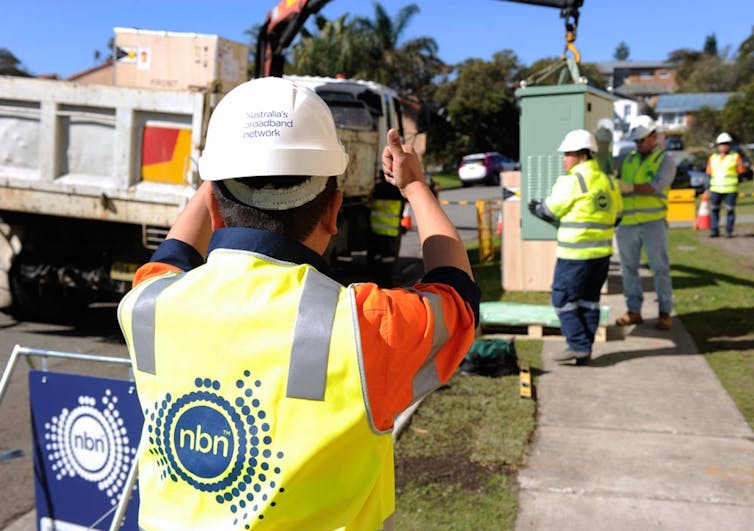
The National Broadband Network may offer a significant speed boost to many users, if a plan from NBN Co, the operator of the network, is implemented. NBN Co’s proposed upgrade would provide download speeds up to five times faster for users on its three fastest home services (Home Fast, Home Superfast and Home Ultrafast).
The speed boost would come at no extra wholesale cost to retailers. On its face, this is an exciting announcement that aims to meet consumer demand for higher speed broadband connections to the internet.
NBN Co has highlighted the rationale for this move. The average Australian household now has around 22 internet-connected devices, and this is expected to grow to 33 by 2026. Data usage per household has doubled in the past five years, and now averages 443 gigabytes per month.
Why Do People Want More Data?
Higher data usage is being driven by new applications, entertainment and online gaming. For example, game updates can be as large as 30 or more gigabytes today. If games update regularly, the amount of data used each month increases quickly.
Entertainment too is using more data. Most streaming video today is provided in a 720p format, but newer televisions can display content at the higher-resolution 4K format. With faster broadband speeds becoming more common, consumers should anticipate more 4K content becoming available.
Likewise, virtual reality and augmented reality are relatively new technologies that are slowly becoming integrated with gaming and business systems. These high data usage technologies are likely to become more present in our daily lives over the next decade.
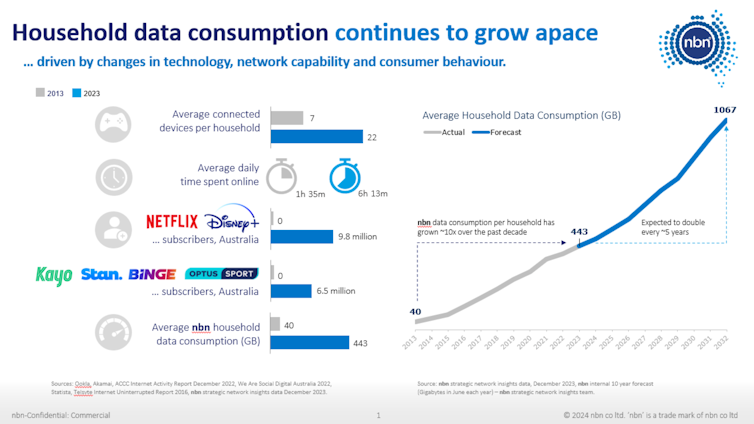
When Would The Upgrades Happen?
NBN Co has indicated it would like to start providing the new higher speed products later this year, or early next year. The upgrade would be achieved by increasing the overall capacity of the NBN, which could then be “shared out” to consumers.
The NBN Co announcement is something the service providers should have expected at some point soon.
NBN Co’s announcement, coming only months after the Australian Competition and Consumer Commission (ACCC) approved a proposal for major annual price increases, may not be welcomed by all broadband retailers.
A spokesperson for the second largest broadband retailer, TPG Telecom, told CommsDay yesterday:
It took more than two years to finalise [the new pricing approved by the ACCC] and only three months for NBN Co to undermine the certainty it was supposed to create. We will always welcome opportunities to deliver greater service and speed to our customers, but NBN’s monopolistic whims make genuine collaboration with them very difficult.
Retailers understandably want certainty in wholesale pricing. One difficulty in achieving this is the high cost of “backhaul” in Australia: this is an intermediate connection between service providers and the NBN itself. Larger retailers have their own backhaul infrastructure, but smaller retailers must pay a third party.
If the NBN offers higher speed broadband connections, smaller retailers may end up paying more for backhaul – and will be faced with a dilemma over whether to pass these extra costs to consumers.
Telstra and Optus have broadly supported the plan by NBN Co to move to new technologies that offer the higher speed capabilities.
A Faster Network May Entice Consumers
Aussie Broadband Group managing director Phillip Britt told Gizmodo Australia:
Aussie Broadband is still understanding the detail of NBN Co’s speed proposal, but on the face of it, it could represent one of the most exciting steps in technology adoption for Australian households and businesses.
For NBN Co, the boost for the higher-speed plans may entice consumers to move from basic 50 Mbps plans to the upgraded Home Fast plan (which will offer download speeds of 500 Mbps, up from the current 100 Mbps).
NBN Co may also hope this encourages the remaining consumers with copper “fibre to the node” connections to move to “fibre to the premises” by taking advantage of one of the low or no cost upgrade offers available through retailers.
NBN Co has issued a consultation paper to retailers, asking for their feedback on the proposed changes to the high speed products by April 19 2024.![]()
Mark A Gregory, Associate Professor, School of Engineering, RMIT University
This article is republished from The Conversation under a Creative Commons license. Read the original article.
Disclaimer: These articles are not intended to provide medical advice, diagnosis or treatment. Views expressed here do not necessarily reflect those of Pittwater Online News or its staff.